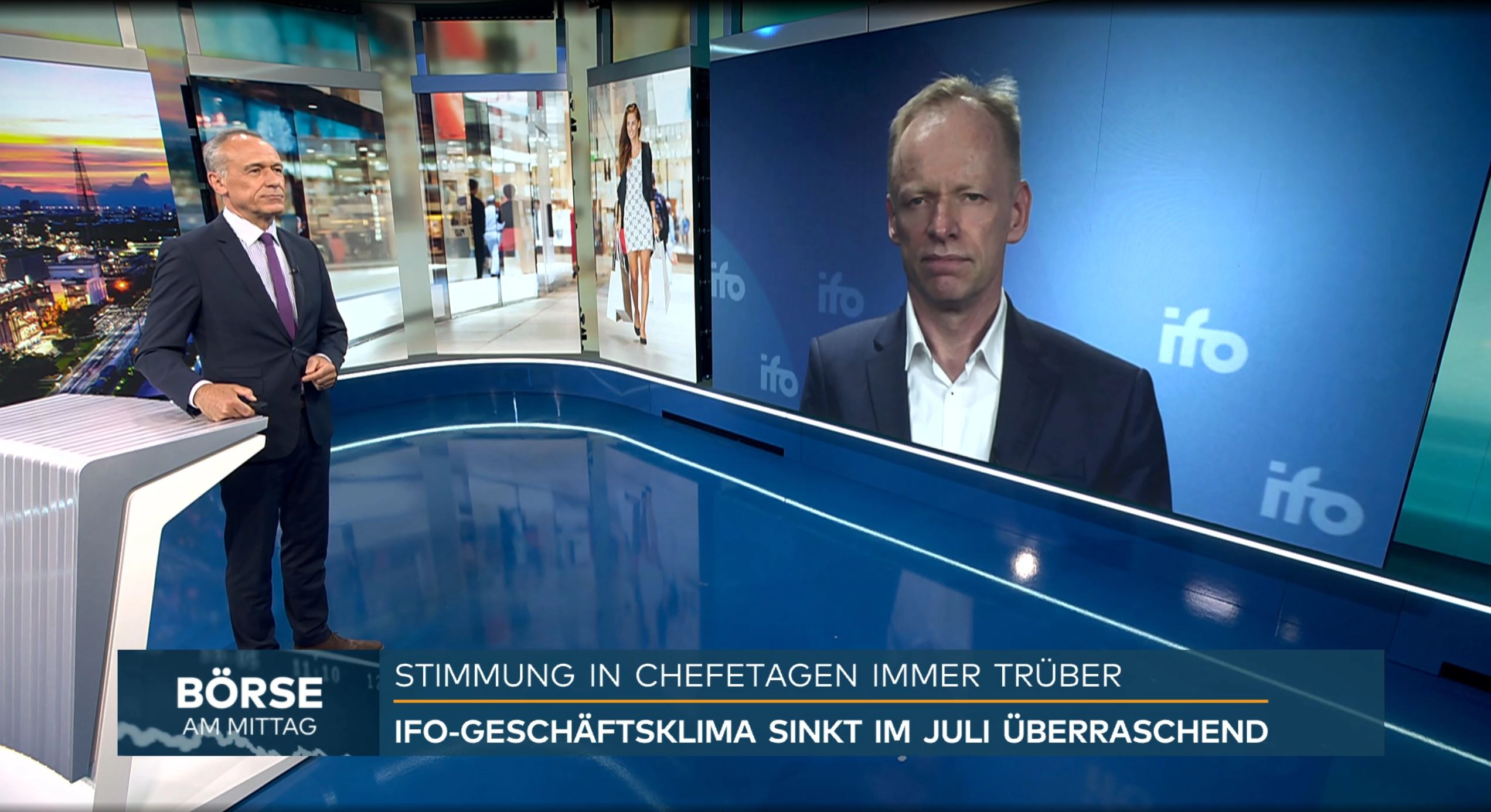Overview
People
Places
Times
Adolf Weber: Pioneering Influence at the ifo Institute
Adolf Weber was one of the most influential German economists of the 20th century and a prominent figure, not only within the Faculty of Political Economy but also across the entire University of Munich. His legacy is honored at the ifo Institute in Munich, where since 1999, the main office building at Poschingerstrasse 5 has been named in his honor.
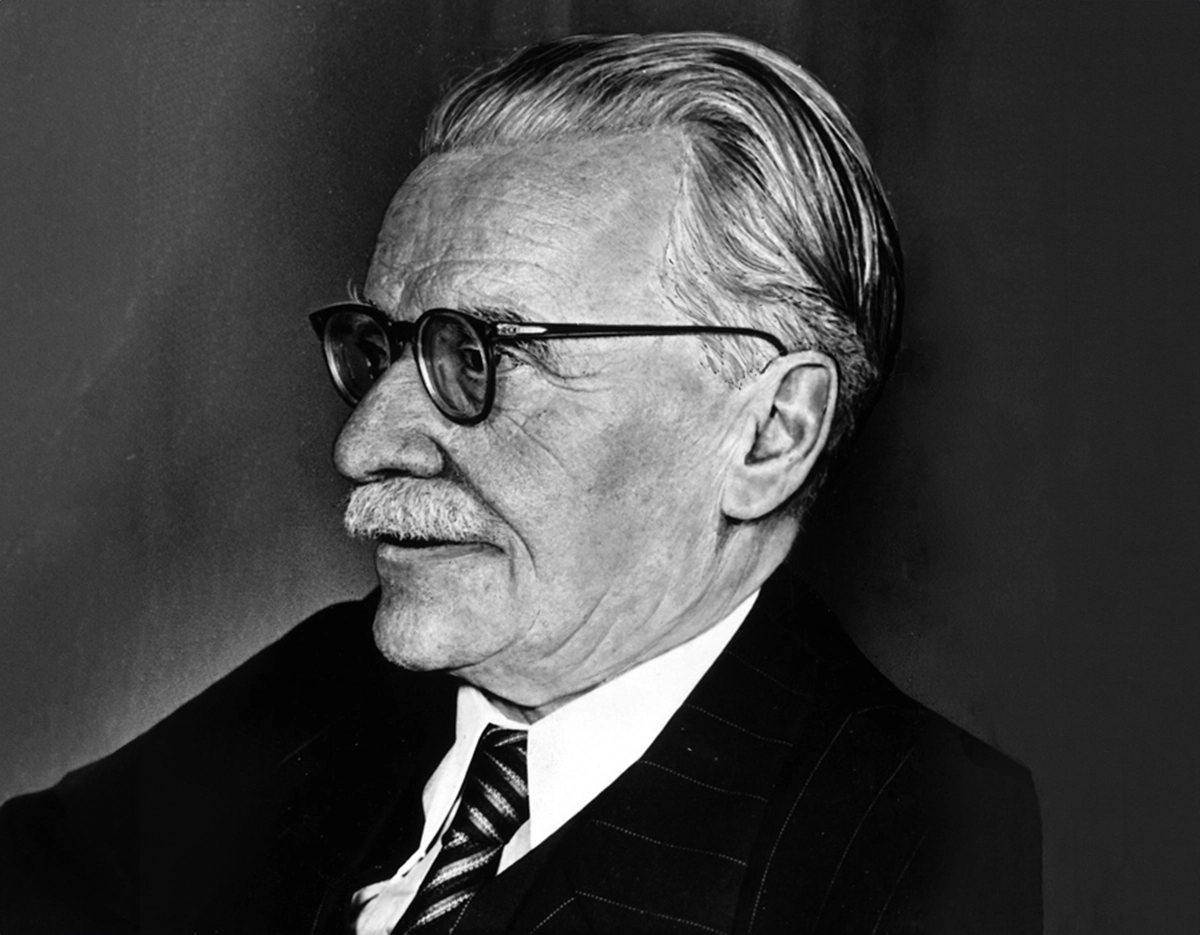
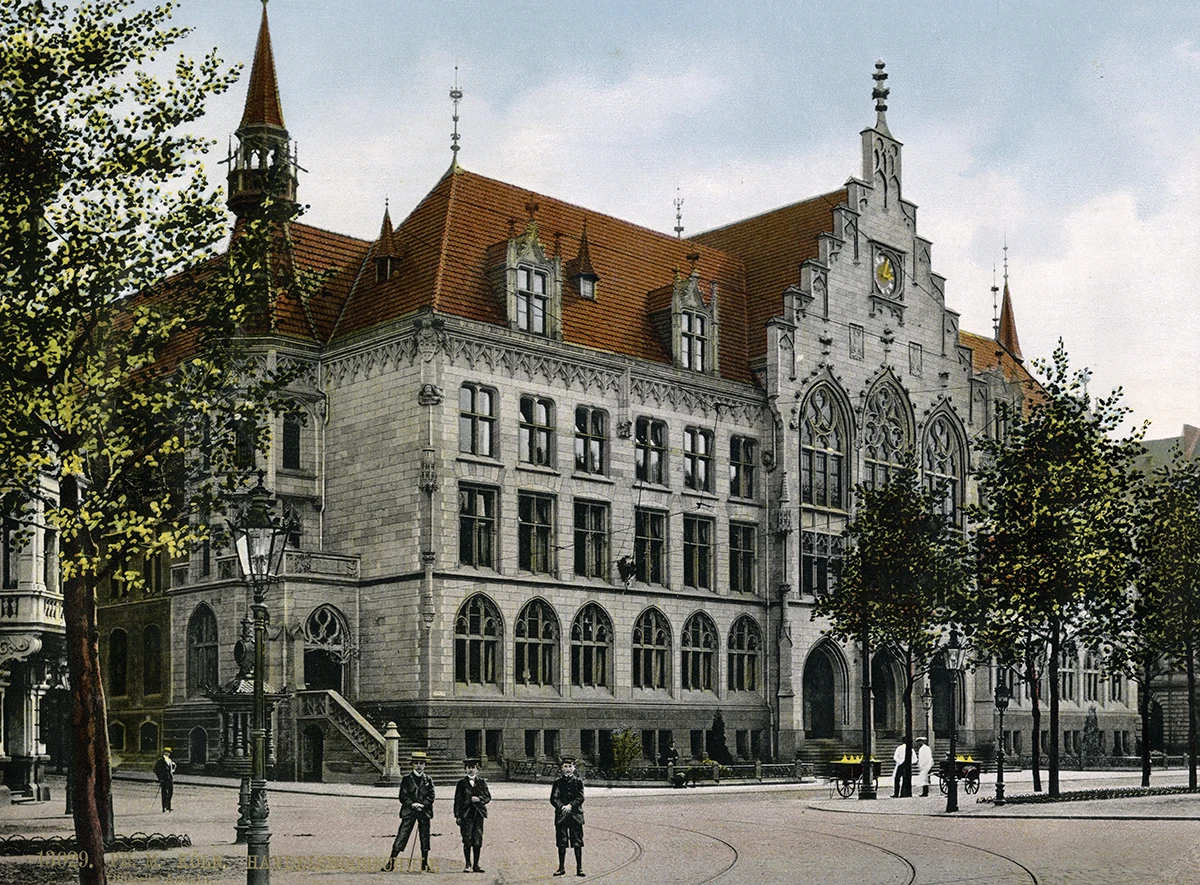
Education and Early Academic Career
Born in 1876 in Mechernich in the Eifel region, Weber began his studies in law and political science in Bonn, where he earned his doctorate in law in 1900. However, his true passion lay in economics, and just two years later, he completed a second doctorate in this field at the University of Bonn. His first major academic appointment came in 1908 at the Commercial College in Cologne, where he quickly rose to lead the College for Social and Municipal Administration.
A Distinguished Professorial Career: From Wroclaw to Munich
Weber’s academic journey took him from Wroclaw, Poland between 1914 and 1919, to Frankfurt am Main from 1919 to 1921, and finally to the University of Munich. There, from 1921 to 1948, he held the Chair of Economics and Finance, and authored influential textbooks on general economics, trade, and transport policy, which reached high print runs. His research covered a wide range of topics, including social policy, banking, land reform, housing, and foreign trade.
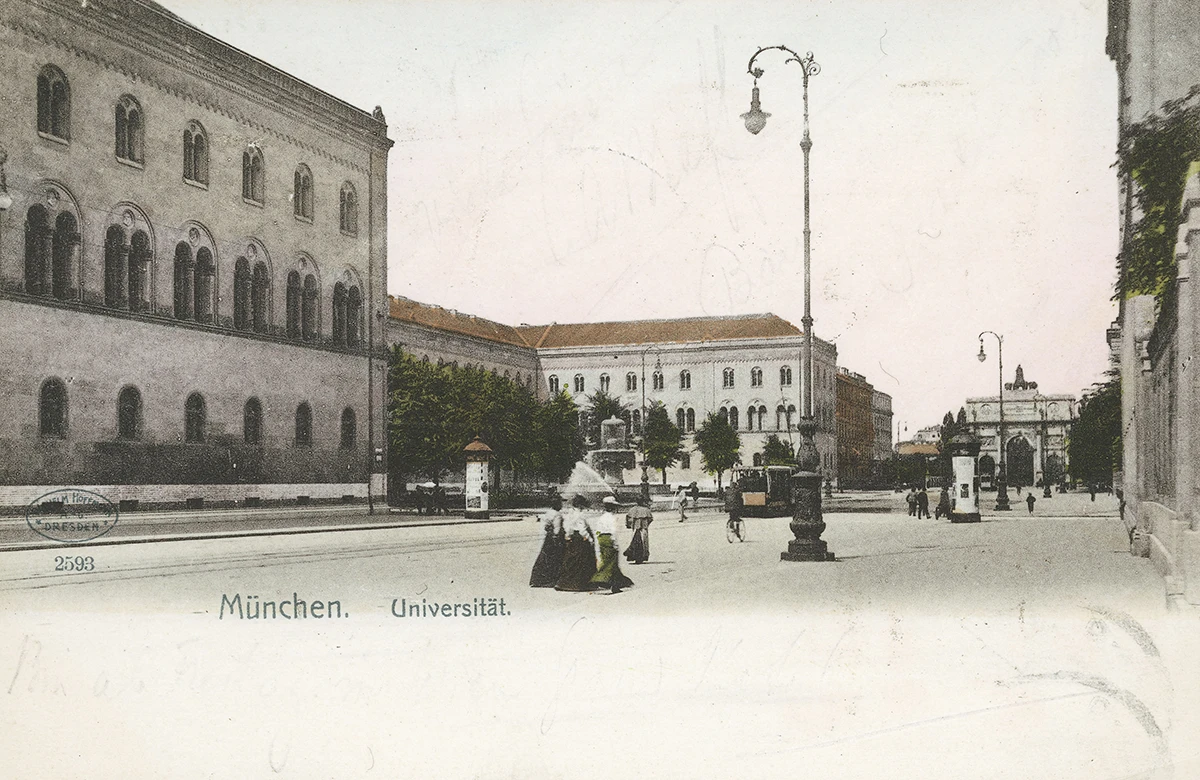

Strategies for Post-War Economic Reconstruction
During World War II, Weber critically analyzed both the Soviet planned economy and the Nazi command economy. Following the war, he established the “Economic Working Group for Bavaria” in Munich, bringing together leading figures from academia and practice to pool economic knowledge for the country’s reconstruction. After stepping down as Bavarian Minister of Economic Affairs, Ludwig Erhard collaborated closely with Weber in this group. Together, they laid the groundwork for applied, politically-oriented economic research in Munich, which allowed the ifo Institute to thrive from 1949 onwards.
To emphasize its independence from political parties, the working group was affiliated with the Department of Political Economy at the University of Munich, under Weber’s leadership. The group’s activities resulted in numerous publications on economics and economic policy. Weber himself published the memorandum “Transition Economy and Monetary System” in 1945 and followed up with the essay “Where Is the Economy Heading?” in 1946. Thanks to his exceptional expertise, Weber became one of the most influential advisors to the Bizonal Economic Administration, which was responsible for managing the British and American occupation zones.
Economic Philosophy and the Munich School of Economics
Weber was not only a leading economist but also a charismatic teacher and founder of the Munich School of Economics. Rooted in the liberal economic traditions of the German Empire (Kaiserzeit), he advanced a “dynamic business cycle theory,” explaining economic crises not as inevitable outcomes of cyclical economic laws but as the result of overinvestment in relation to national savings. While the production of consumer goods remained relatively stable, irregularities in the production of capital goods triggered economic downturns. Weber argued that economic policy should focus on ensuring long-term capital formation by companies through real savings rather than excessive borrowing.
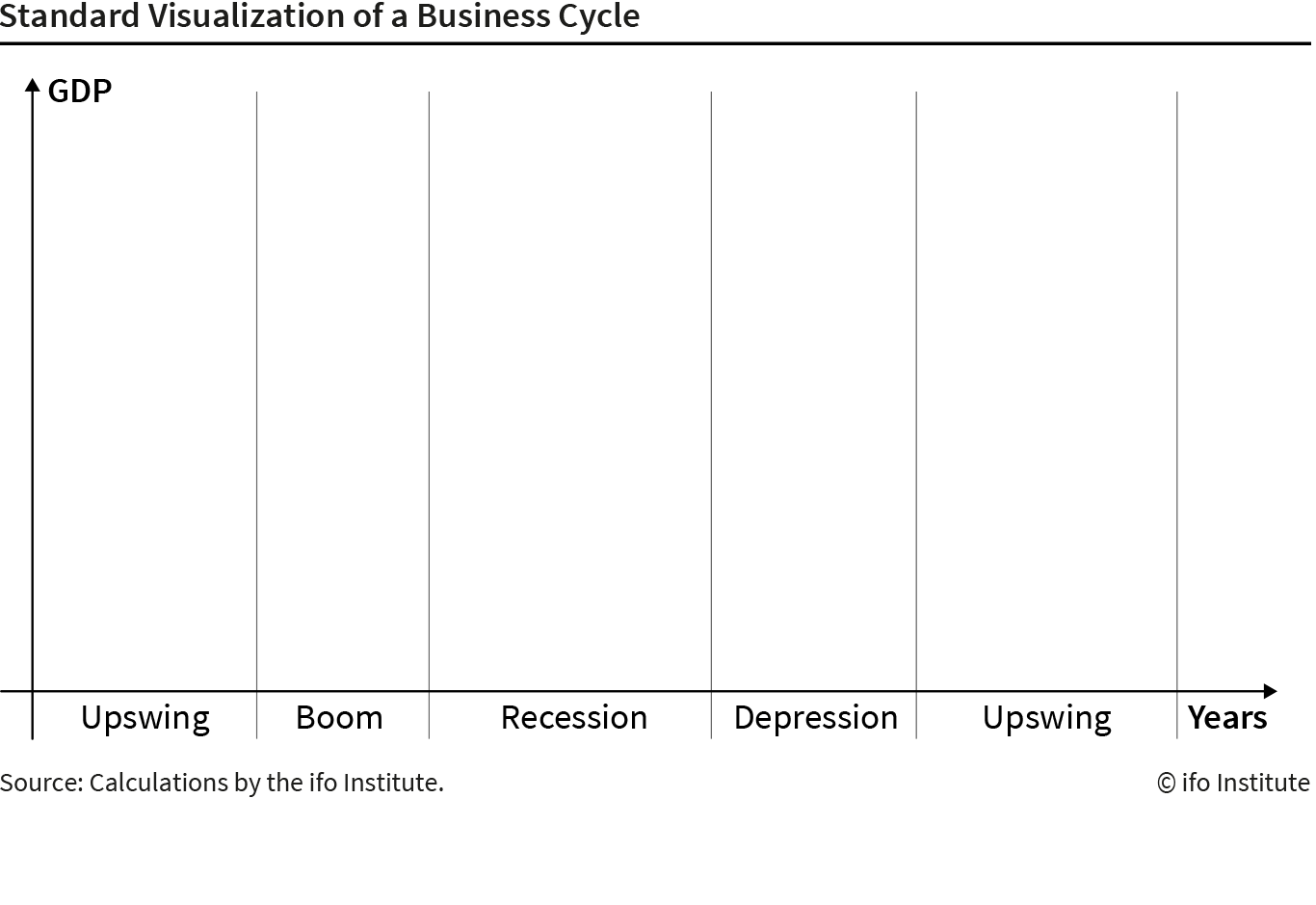
Adolf Weber and Ludwig Erhard: Key Figures in the Foundation of the ifo Institute
Following his time as Bavarian Minister of Economic Affairs, Ludwig Erhard — now head of the Institute for Economic Observation and Economic Consulting, as well as the South German Institute for Economic Research — continued his close collaboration with Adolf Weber. This partnership during the challenging post-war years helped foster a robust environment for applied, politically-oriented economic research in Munich, which laid the foundation for the ifo Institute’s success from 1949 onwards. Adolf Weber passed away in Munich on January 5, 1963.
People
Alfred von Heymel: Publisher, Patron of the Arts, Bon Vivant.
Munich, 1909: What does a well-known bon vivant do when he comes into a fabulous inheritance? He buys an exclusive 4,400 square meter plot in Herzogpark for 96,000 German marks and commissions on of the city’s most sought-after architects, Karl Stöhr, to build an opulent neoclassical-style house for him for another 180,000 marks. Fast forward to today, the impressive building at Poschingerstrasse 5, which was completed in 1910, is now home to the ifo Institute. Its first owner, Alfred Walter von Heymel, was indeed a colorful personality.
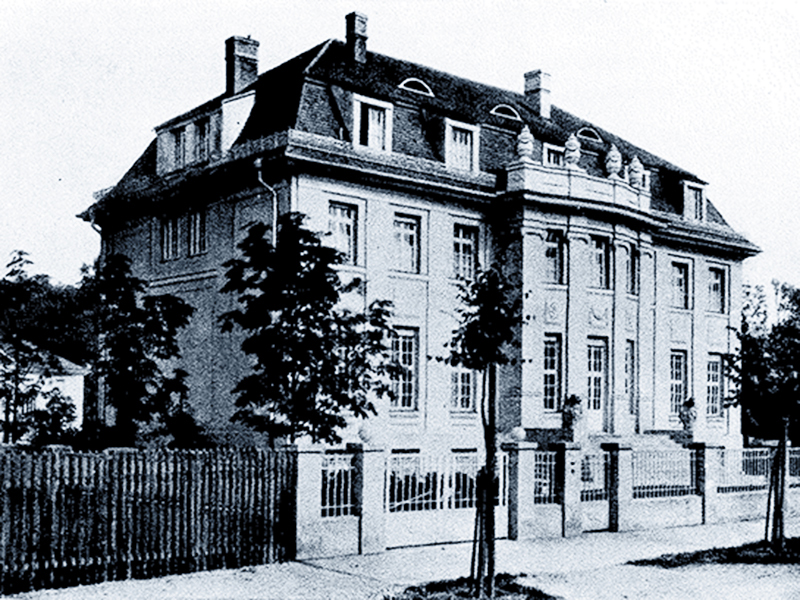
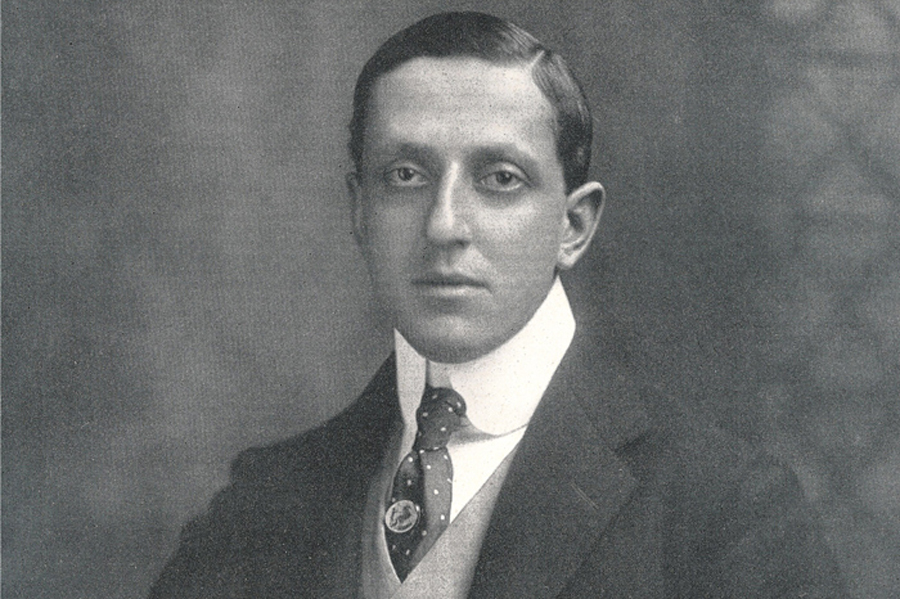
“Beautiful Women, Beautiful Horses, Beautiful Flowers ...
... English books in supple leather bindings, lots of good food and drink, accompanied by a host of friends, some closer than others – this was how the young men from Bremen, Alfred von Heymel and his cousin Rudolf Alexander Schröder, spent their days and nights,” described writer Rolf von Hoerschelmann, painting a vivid picture of their lifestyle.
“Die Insel” – A Beacon of Literary Modernism in Germany
Heymel’s most important patronage was the literary magazine “Die Insel”, which he founded together with Rudolf Alexander Schröder in 1899. Contributors included literary greats such as Hugo von Hofmannsthal, Rainer Maria Rilke and Robert Walser and the illustrations were by none other than Heinrich Vogeler.
Rolf von Hoerschelmann reminisces, “It featured modern poems, literary gems from all eras and countries, and witty essays, all printed on heavy floral paper and bound in exquisite designs, thanks to its connection with the Insel Verlag book publisher.” This book publisher, also founded by Alfred von Heymel and Rudolf Alexander Schröder in 1901, still exists today, unlike the magazine, which ceased publication just three years after its founding. There were simply too few buyers and the financial burden eventually became too much for even a wealthy patron like Heymel to bear.

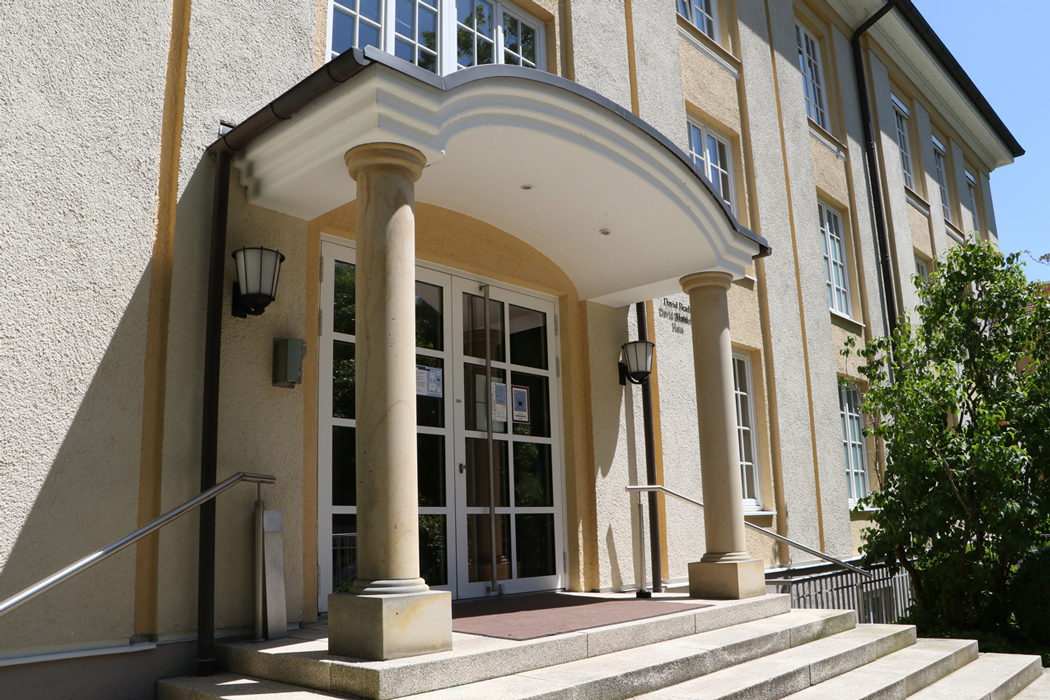
The End of a Magazine, The Start of a Dramatic Life
In 1904, von Heymel married Gitta von Kühlmann, a “blonde aristocratic beauty,” as von Hoerschelmann puts it. In 1910, the couple moved into their new villa at Poschingerstrasse 5, but the marriage failed. Seeking a fresh start after his divorce, von Heymel travelled extensively in Africa before settling in Berlin in 1912, where he died two years later after suffering from tuberculosis.
From the 1920s, the consulates of the then Kingdom of Siam and Argentina, among others, resided in the Villa Heymel. The first employees of what is now the ifo Institute moved into the imposing building in 1952. If you take a walk through Bogenhausen district, you can see it up close.
Note: For the sources used in this text, click on the imprint.
People
Local History
Artificial Intelligence: Opportunity or Danger?
It is undisputed that the use of artificial intelligence is changing society, especially the world of work. However, there is great uncertainty about the “how.” Is its use more of an opportunity or more of a threat? On the one hand, there are expectations of greater efficiency, dynamism, and new business models. On the other hand, there are fears associated with these opportunities – for the economy as well as for society. Will AI become a job killer? Will AI even become uncontrollable due to its lack of traceability? A suitable framework for dealing with AI technologies is essential.

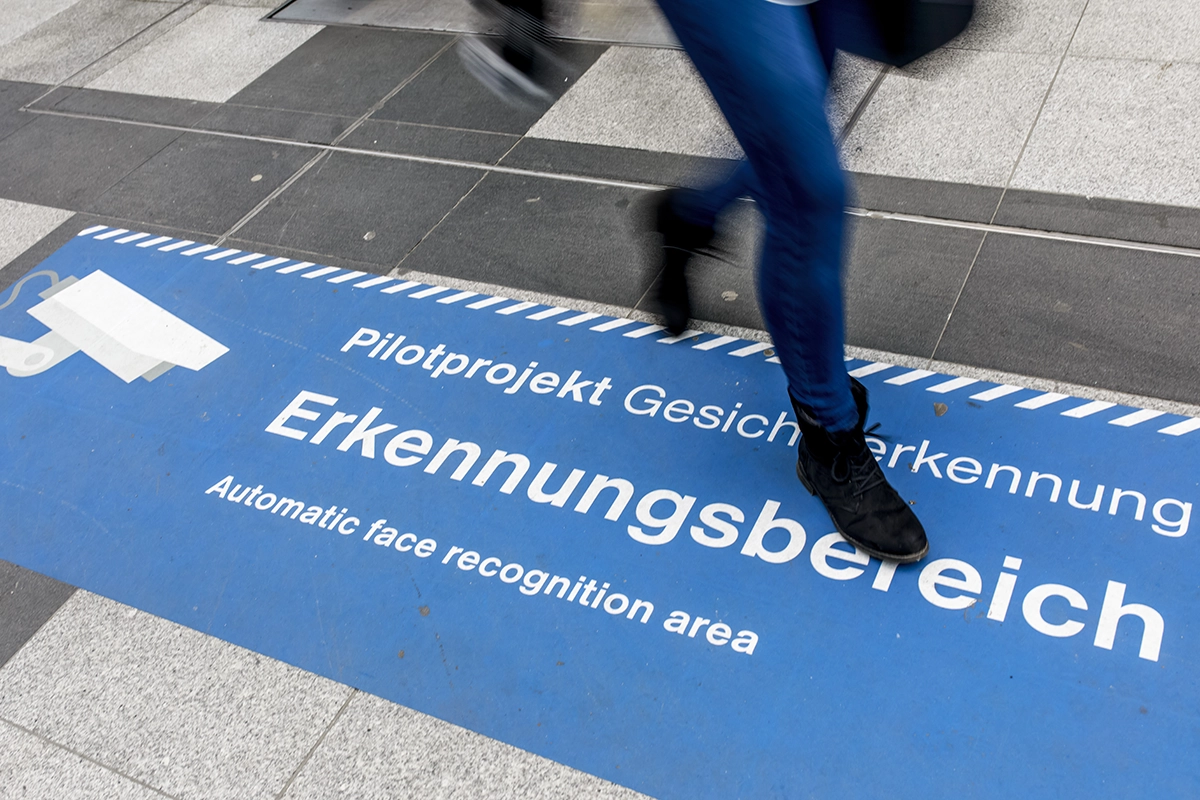
AI, Cloud Computing, and Blockchain – Where Does the German Economy Stand?
Digital technologies are not only changing the efficiency and flow of production processes. They are also having a profound, disruptive impact on our economy in a process often called “digital transformation.” This digital transformation refers to the integration of digital technologies into economic workflows, as well as their impact on living conditions and society as a whole.
The numerous new technologies that have seen considerable progress and widespread acceptance in recent years include digital platforms, the Internet of Things (IoT), robotics, cloud computing, blockchain, and, last but not least, artificial intelligence.
Their wide-ranging application and far-reaching dissemination are giving rise to innovative products, services, and business models that are used in a variety of industries, from logistics and energy to agriculture, trade, telecommunications, financial services, manufacturing, and healthcare. They even have the potential to change people’s lives and society in the long term.
All three technologies have the capacity to significantly change existing business models and the way in which knowledge, products, and services are created and exchanged.


ChatGPT Brings AI to the Center of Society
AI-based systems use techniques such as machine learning and deep learning to automate complex tasks such as pattern recognition, language processing, trend analysis, and decision-making with the help of large amounts of data. Increased computing power, the availability of large amounts of data, and new algorithms have led to the rapid development of AI technology and enabled its broad application across all economic sectors. Most recently, the spread of chatbot applications, such as OpenAI’s ChatGPT, has brought AI to the forefront of public interest.
AI in Companies: HR Managers Have Concerns about Its Use
Fully 86 percent of German HR managers have concerns about the use of artificial intelligence (AI) in their company. This is according to the latest Randstad-ifo Personnel Manager Survey. The most common reason given by HR managers was a lack of expertise (62 percent). Legal aspects are an issue for 48 percent. A lack of trust in AI was cited by 34 percent. For one-quarter of HR managers, a lack of acceptance is an obstacle to the use of AI. For 22 percent, no added value is evident from AI. The high cost of AI is viewed critically by 19 percent, high costs by 18 percent.
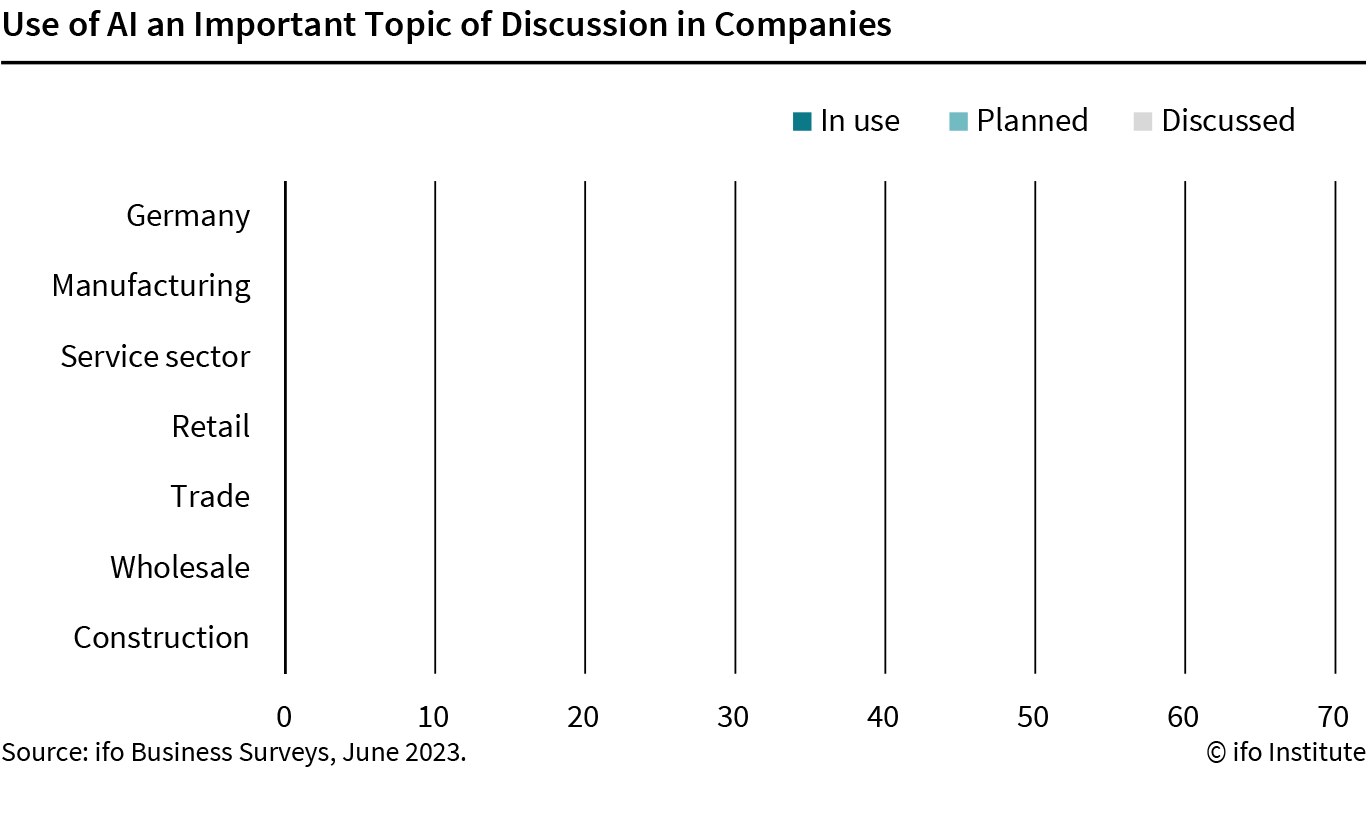

AI Takes Center Stage at the Munich Economic Debates (MED) 2024
At the Munich Economic Debates (MED), we continuously explore the profound impact and burgeoning potential of artificial intelligence (AI) across various sectors. Throughout the year, we bring together leading experts from academia, industry, and society to delve into the vast opportunities and challenges presented by this transformative technology. To stay updated on event schedules and access livestreams, visit our ifo website. We invite you to join the conversation and help shape the dialogue about AI’s role in shaping our future.
Events
Impulse
Big Data Economics at the ifo Institute
Big data – a buzzword: What does it mean for economics? How do you make masses of unstructured data usable for economic research? Sebastian Wichert is the director of the LMU-ifo Economics & Business Data Center, or EBDC for short. In the ifo podcast “Economy for All”, he provides insights into his work with big data economics and the significance of his department within and outside of ifo.
Board of Trustees and Administrative Council: From the Inaugural Meeting to Today
From the outset, the Board of Trustees and the Administrative Council played a decisive role in the development of the ifo Institute. On January 24, 1949, the inaugural meeting adopted the Institute’s Bylaws. The role of the two bodies, then still called the Board of Trustees and the Administrative Committee, is defined as follows: “The Board of Trustees shall support the Executive Board in the fulfillment of its tasks.” And further: “It shall make use of an administrative committee and the Research Advisory Board to carry out its tasks.” 75 years have passed, and definitions and tasks have changed. A look back and at current activities.
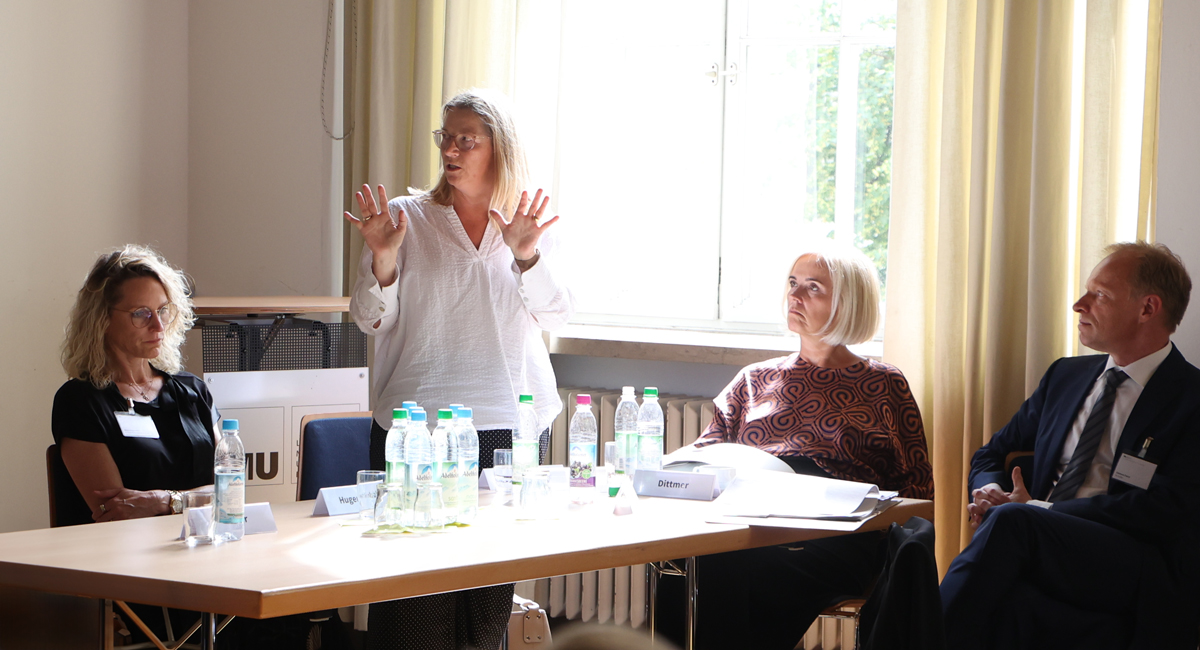
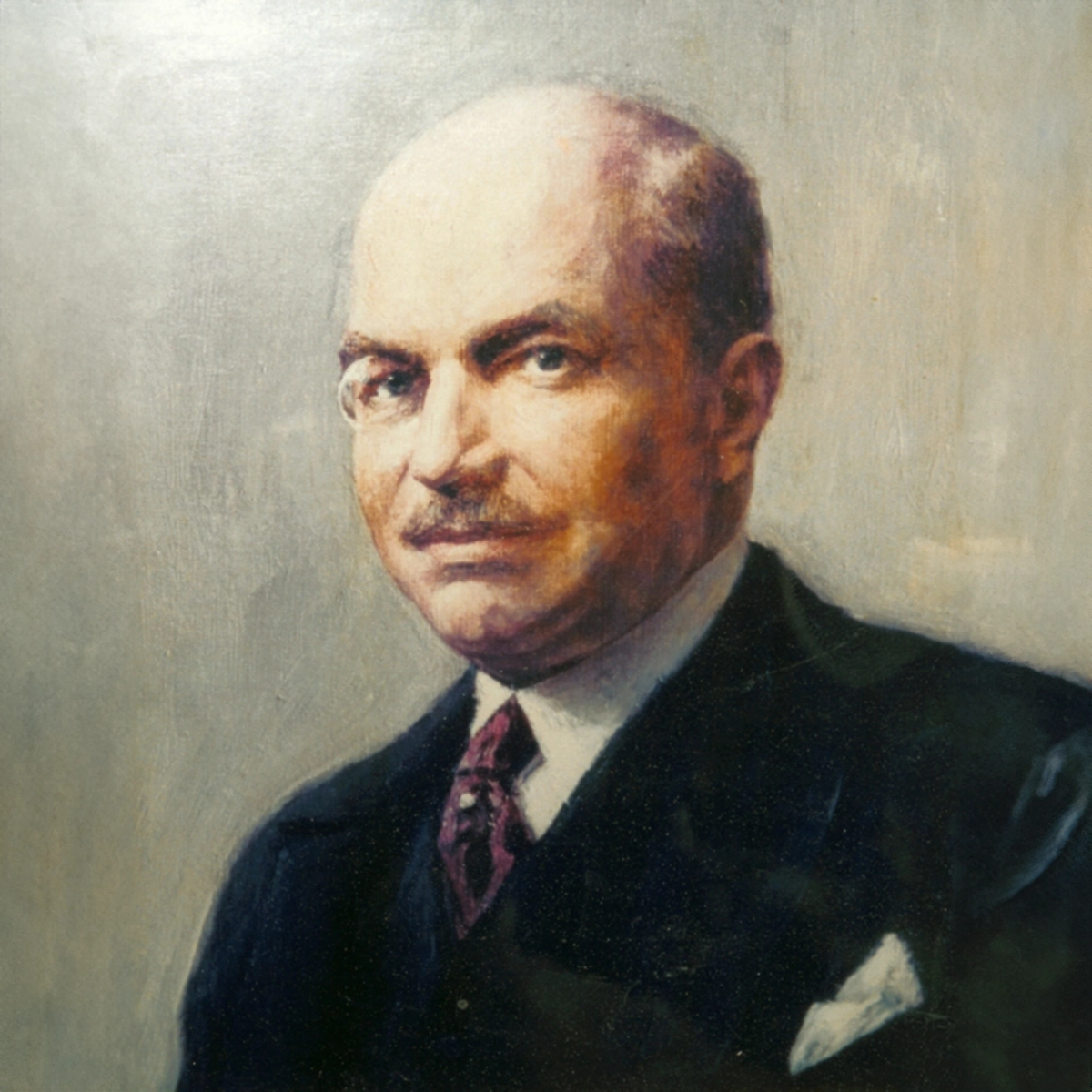
Ludwig Kastl – Chairman From the Very Beginning
The Administrative Committee was a body that was assigned to the Board of Trustees. Ludwig Kastl, who Ludwig Erhard had already recruited for the position of Chairman of the Board of Trustees in 1946 when he founded his Institute for Economic Observation and Consulting, was the first to chair the Administrative Committee and the Board of Trustees.
Kastl had begun his career as a civil servant in the Colonial Department of the Foreign Office and worked in German South West Africa from 1906 to 1920. After returning to Germany, he left the civil service in 1925 and became a managing member of the Presidential Board of the Reich Association of German Industry. After the RDI was ‘brought into line’ by the National Socialists in 1933, Kastl was forced to resign because of his Jewish heritage. During the Second World War, he worked as a lawyer. After the war, and with a clean political record, he took on a leading role at MAN in Nuremberg, and between 1946 and 1947 was President of the Bavarian Economic Council.
His extensive professional experience and large network in politics, business and society made him extremely valuable to the ifo Institute and one of the central figures in its foundation and development. He remained active on the Board of Trustees of the ifo Institute until 1962, when he retired from all offices at the age of 84.
The Board of Trustees: A Strong Network
The composition of the Board of Trustees was clearly defined in the ifo Institute’s founding statutes in 1949. Its aim was to establish contact with the Institute’s most important stakeholders from business, academia, politics, and public administration, and thus network the ifo Institute with key social groups. As it primarily had to elect the members of other statutory bodies and committees and perform support tasks, only natural persons were represented here. Neither has changed to this day.
The tasks of the Board of Trustees were to elect the Board Council, the Executive Board and the Research Advisory Board, and “support the Executive Board with regard to the purpose of the association”. The position of the Chairman was further strengthened by assigning him not only the chairmanship of the Board Council but also the chairmanship of the Research Advisory Board and the members’ meetings.
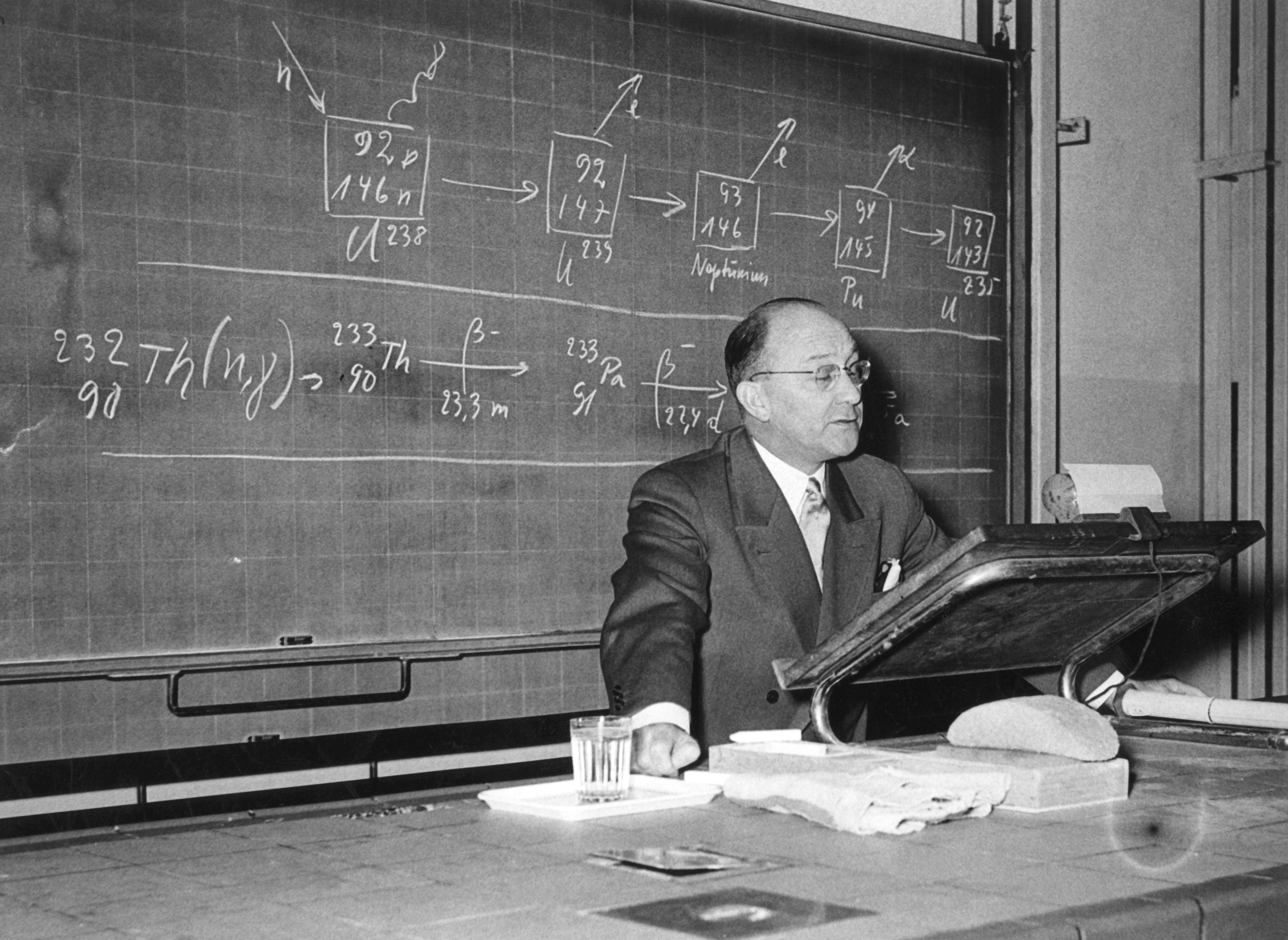
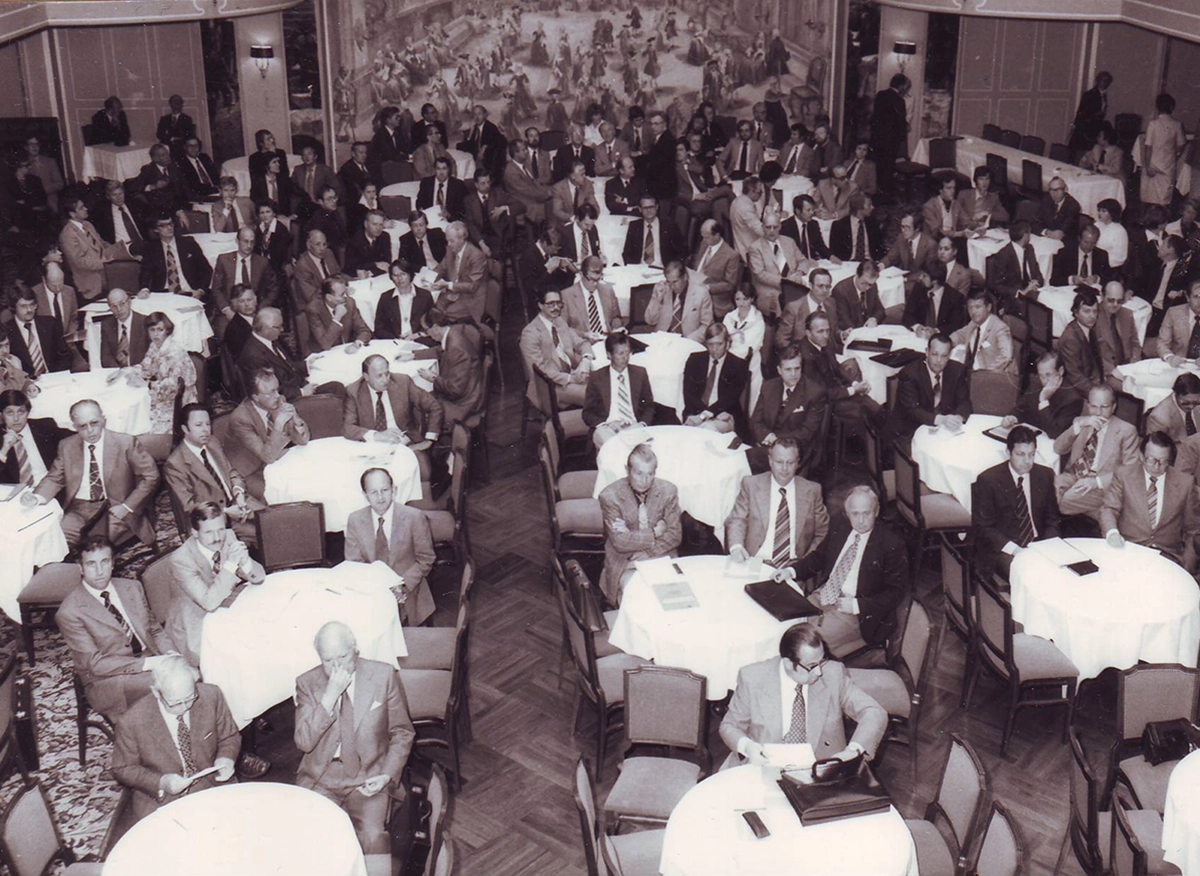
Administrative Council – A Key Role
In 1956, following an amendment to the bylaws, the Administrative Committee became the Administrative Council and an independent statutory body. As was already the case since the adoption of the founding statutes, key strategic management decisions were made here. In addition to personnel policy issues, this included responsibility for finances, which was divided during the ifo Institute’s start-up phase between the Administrative Committee and the Executive Board. The Administrative Committee also approved the budget, was responsible for procuring the approved funds, and audited the financial statements. In the early years of the Institute, the Chairman of the Administrative Committee, Ludwig Kastl, thus had prominent responsibility for ifo’s finances. His position was even strengthened further with the amendment to the bylaws in 1956, when he was assigned the chairmanship of the Research Advisory Board and the members’ meetings.
The New Beginning in the 1990s
Following the extensive reorganization of the ifo Institute in the 1990s, the Institute’s bodies and their functions were also redefined. The position of the Executive Board was strengthened as a steering body with overall responsibility for the development of the institute, and this increase in power was balanced by the expansion of the supervisory and advisory functions assigned to the other ifo bodies.
The Board Council was replaced in 1997 by the Administrative Council. The latter was authorized to appoint and dismiss the Executive Board members, and has a supervisory and advisory role vis-à-vis the Executive Board. In order to ensure the supervisory function through efficient work in a manageable group, the new bylaws limited the number of members of the Administrative Council to eleven. The responsible departments of the German Government and the Free State of Bavaria as well as the Faculty of Economics and the Faculty of Business Administration at LMU were each granted the right to appoint a representative to the Administrative Council. Other members of the Administrative Council who were appointed from the outset were the Chairman and Deputy Chairman of the ifo Board of Trustees and the Chairman of the Scientific Advisory Council. The remaining four members of the Administrative Council were elected by the members’ meeting.

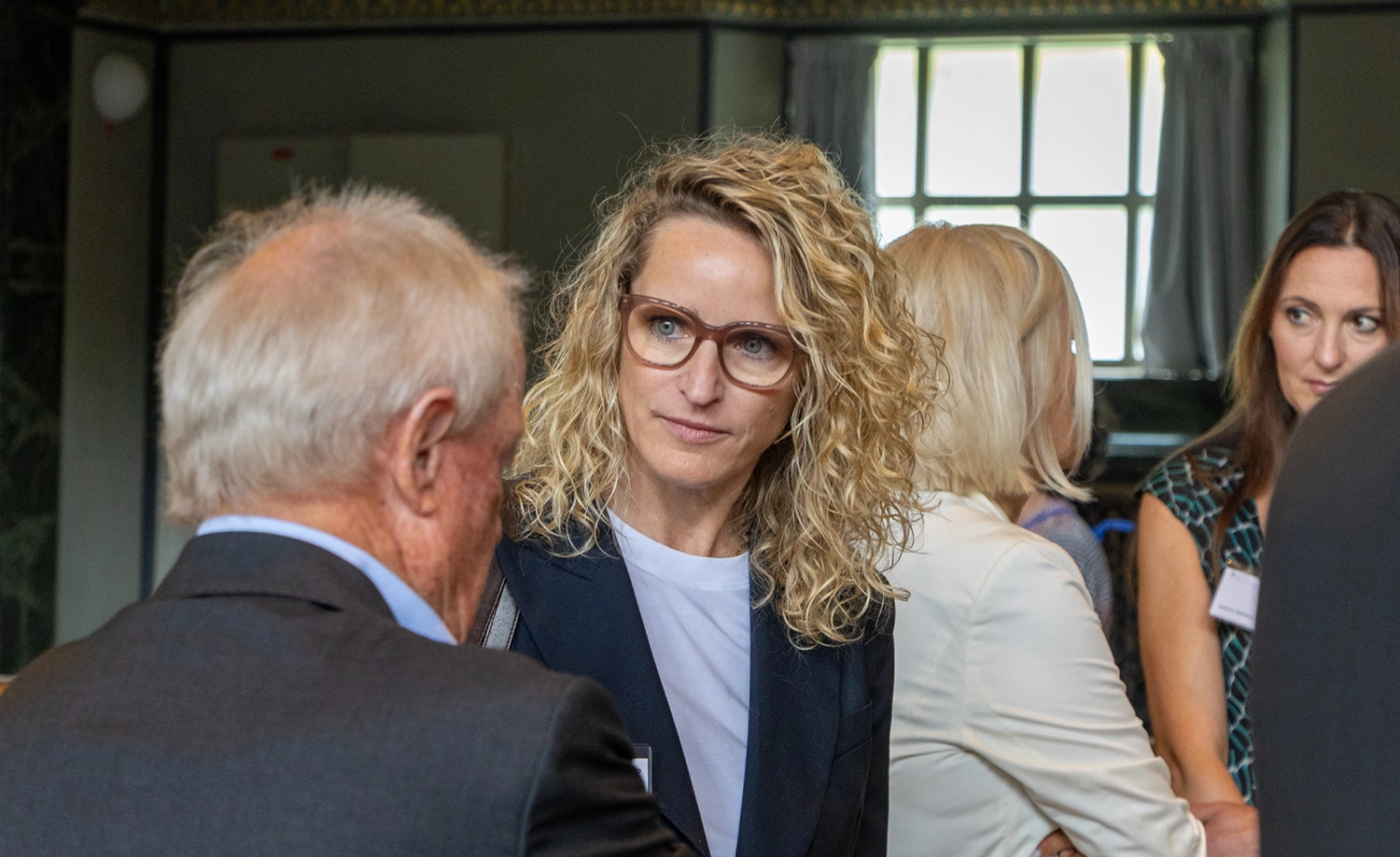
The Bodies of ifo Today
Essentially, the tasks of the ifo Institute’s bodies have not changed: The Administrative Council has a supervisory and advisory role vis-à-vis the Executive Board. It consists of the Chairperson of the Board of Trustees and their deputy, a professor from the Faculty of Economics and Business Administration at LMU Munich, a representative of the federal government department and the department of the Bavarian State Government, the Chairperson of the Scientific Advisory Council, and up to five further members elected by the members’ meeting. The term of office of the elected members of the Administrative Council begins on July 1 of the year of election and lasts three years. Since 2023, Nina Hugendubel, Managing Partner of the book retailer H. Hugendubel in Munich, has been Chairperson of the Board of Trustees and the Administrative Council, with Christine Bortenlänger elected as her deputy.
People
Brexit 2016: A Shocking Turn of Events and Its Consequences
Britain‘s relationship with the European Union has always been at arm‘s length. In the 2016 Brexit referendum, 72.2% of eligible voters participated, with 51.9% voting in favor of leaving the EU. This event marked the United Kingdom as the first country to exit the EU, leading to immense economic consequences, according to the ifo Institute. After a year of intensive negotiations, a new trade and cooperation agreement between the EU and the UK was enacted in 2021.

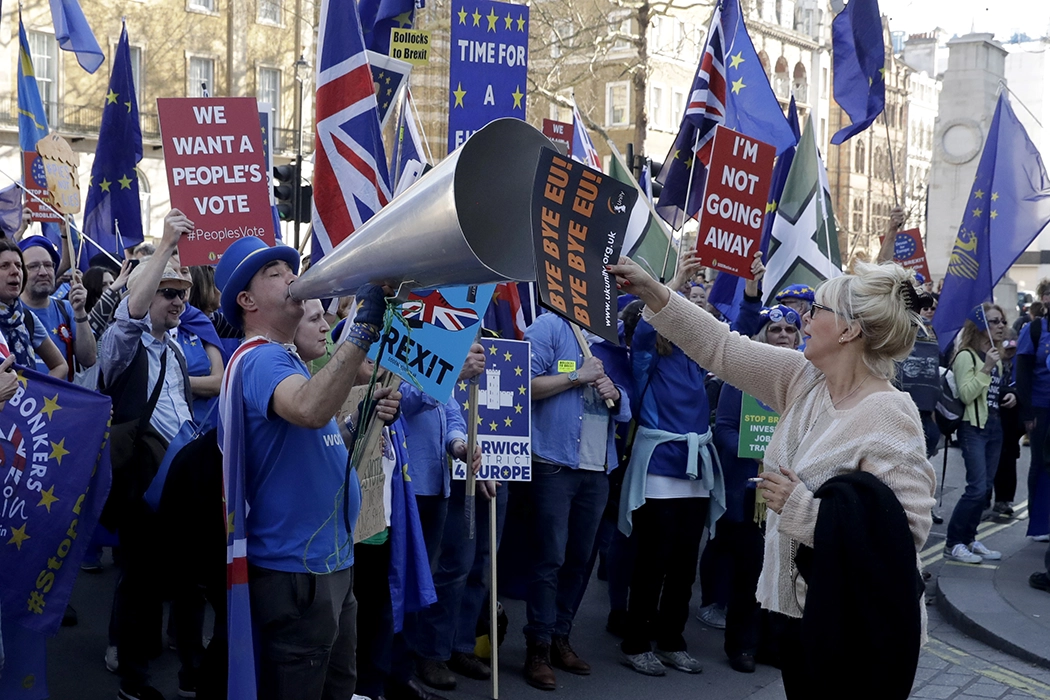
The Road to Brexit: A Closer Look
Brexit promised better control over immigration, an end to payments to the EU, and full sovereignty for the UK. Conversely, there were warnings that leaving the single market could jeopardize the economic stability of the island. Politicians from various camps engaged in heated debates – in parliament, newspapers, talk shows, and on social media. The sentiment for Brexit was already noticeable in 2014 when Prime Minister David Cameron announced his intention to renegotiate the UK’s treaties with the European Union. Following the Conservative Party’s election victory under Cameron in 2015, the Brexit referendum was scheduled for 2016. Cameron also negotiated further special arrangements for the UK in the EU, contingent on the vote against Brexit.
The United Kingdom Divided
The Brexit referendum results laid bare the deep divisions within the United Kingdom. In England and Wales, the majority voted in favor of Brexit; however, in Northern Ireland and Scotland, as well as among London’s electorate, the majority voted to remain in the EU. The divisions were not only regional but also generational. A significantly larger proportion of young Britons voted to stay in the European Community compared to their older counterparts. In November 2018, Theresa May, David Cameron’s successor, reached a provisional withdrawal agreement with the EU. The final exit, initially planned for March 29, 2019, was postponed to April 12 and ultimately to October 31. The complexity and lengthiness of the negotiations between the parties proved too great.
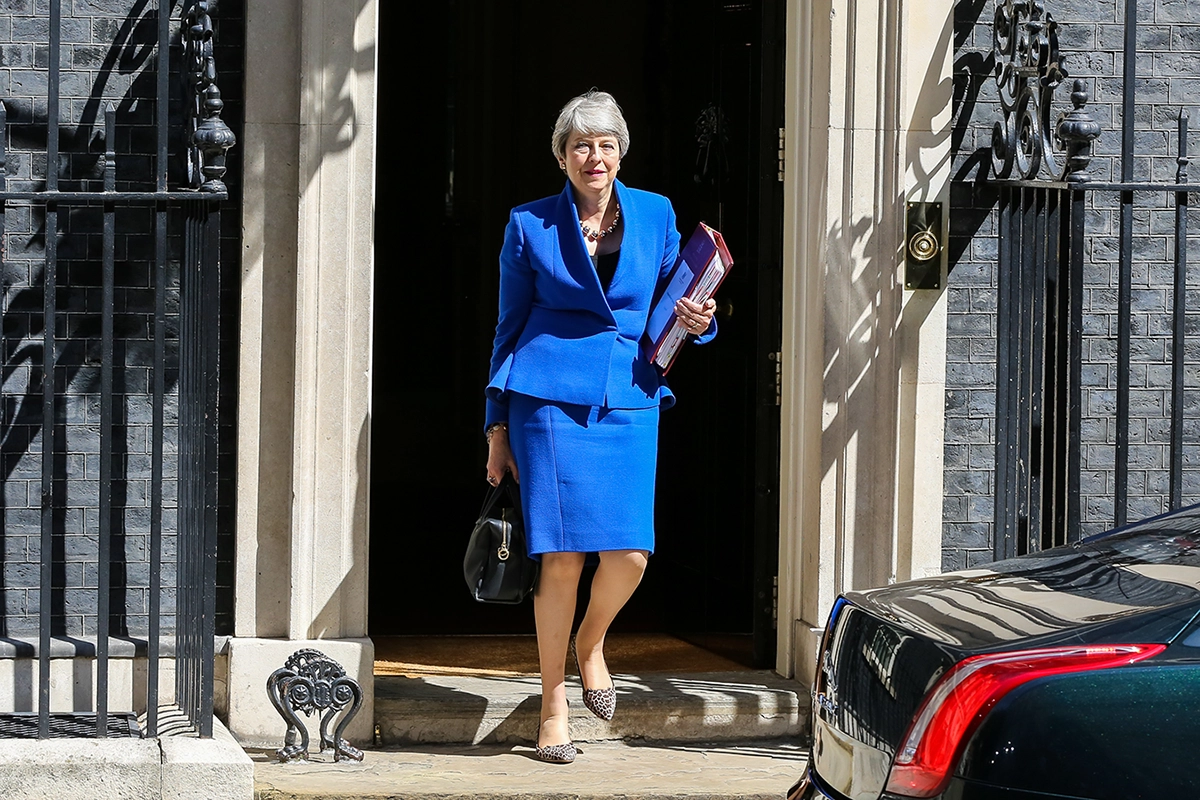
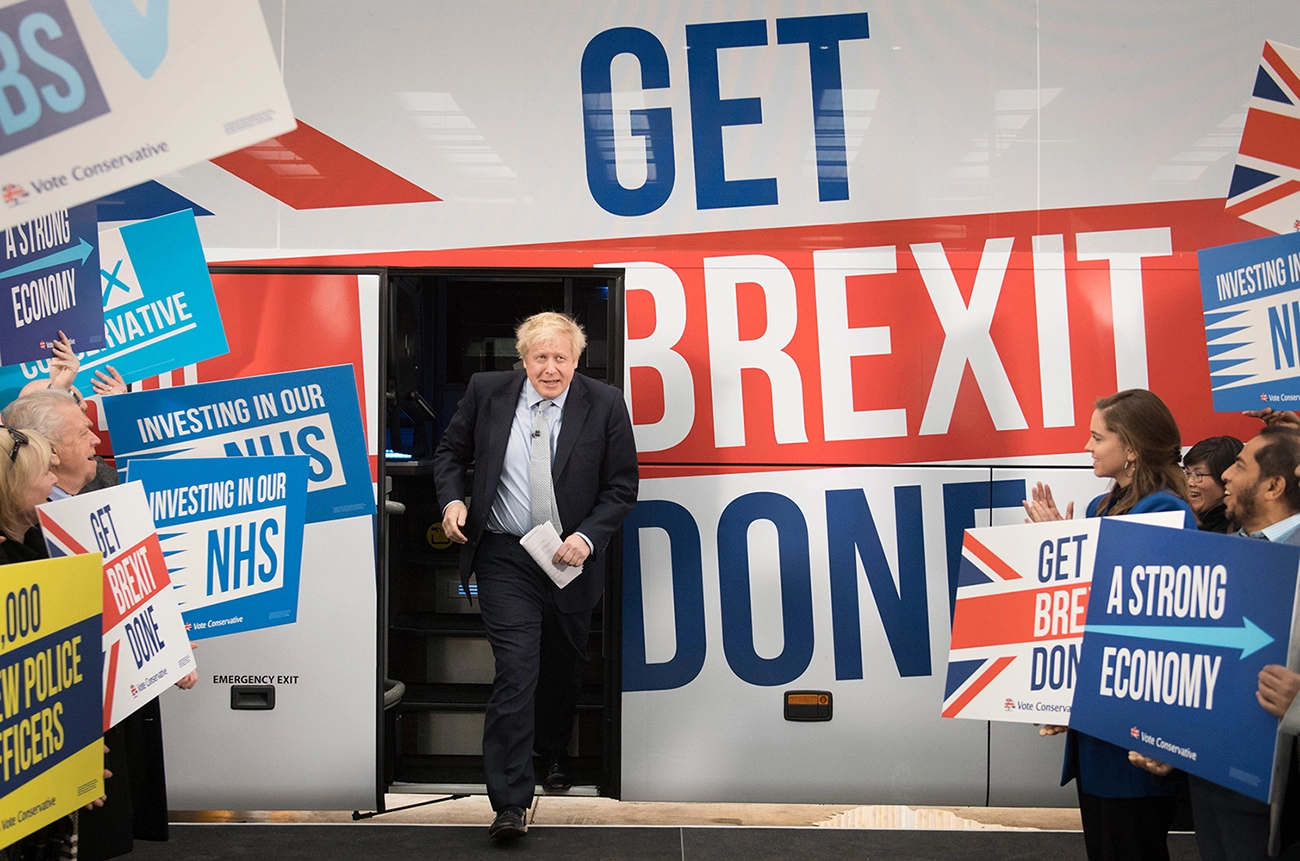
The Protracted Conclusion
Facing heavy criticism from the public and her own party, Theresa May announced her resignation in the summer of 2019. Her successor, Boris Johnson, braced the nation for a hard Brexit with no agreements in place. However, after the British parliament passed a law against a no-deal Brexit, the EU postponed the exit date once again to January 31, 2020, when it finally occurred. A trade agreement, which also included a free trade deal, was still absent. After lengthy negotiations, it came into force on January 1, 2021. While bilateral trade now enjoys exemption from customs duties, UK exports are subjected to extensive customs formalities. Further cooperation agreements were signed in areas such as crime fighting, climate policy, and energy supply, ensuring that collaboration in critical areas continued and the UK was not completely severed from the EU.
Economic Consequences of Brexit
As opponents of Brexit predicted, the negative economic consequences have been less severe for EU countries than for the UK. By 2021, the UK had fallen from being Germany’s third most important trading partner in 2015 to tenth place. In 2022, the ifo Institute updated its initial study on Brexit’s consequences from 2017. Key findings include:
• Since the Brexit referendum on June 23, 2016, the British pound has depreciated by around 13%.
• German exports of goods to the UK have dropped in nominal terms from 90 billion euros to 84 billion euros since 2016.
• In many sectors, the UK’s share of German imports and exports has decreased significantly, particularly in chemicals, vehicles, paper, and mineral products.
• The impact varies among EU member states, with economic size, geographical, and cultural proximity playing significant roles – the closer a country is to the UK, the greater its losses.
Despite the EU and Germany experiencing fewer economic losses from Brexit than the UK itself, the consequences are serious. Both sides are suffering from the uncertainty surrounding the future development of economic relations.

Milestone
Bridging the Divide: Germany’s Economic Union
In 1990, Chancellor Helmut Kohl made a bold promise to transform the regions of Mecklenburg-Western Pomerania, Saxony-Anhalt, Brandenburg, Saxony, and Thuringia into thriving landscapes where people would want to live and work. Despite these aspirations, even three decades after the Berlin Wall came down, the economic vitality of former East Germany remained markedly below that of the West. The ifo Institute’s Dresden branch has been tracking this structural transformation since 1993.
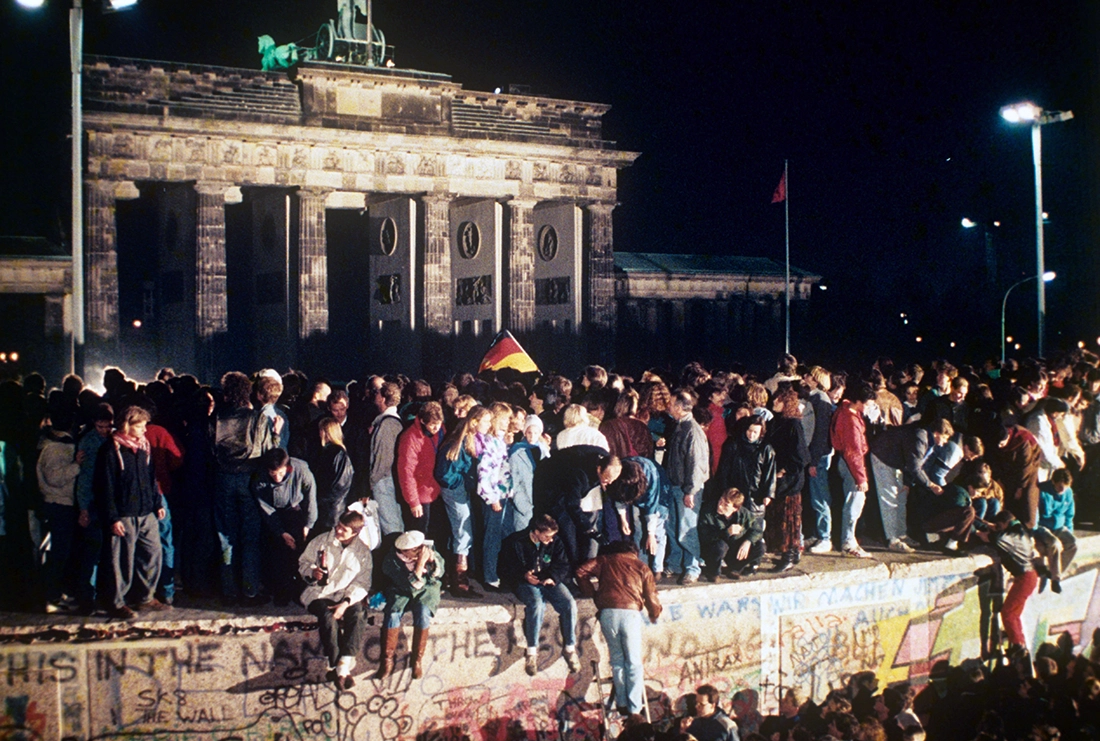

Merging Economic Landscapes
The Berlin Wall’s fall in 1989 paved the way for the State Treaty on Economic, Monetary, and Social Union in July 1990, heralding the economic merger of Germany. The Deutsche Mark became the national currency across both East and West Germany, extending the social market economy’s principles to the newly incorporated federal states. This transition placed immense pressure on East German enterprises to adapt quickly. The Treuhandanstalt, a public agency tasked with privatizing over 12,000 state-owned businesses, failed to find buyers for about 3,000, leading to their closure. To stave off an economic downturn, the federal government launched the “Gemeinschaftswerk Aufschwung Ost” (Joint Initiative for East Germany) in 1991, introducing the solidarity surcharge among other tax increases to fund this support.
Economic Progress Since 1989
By the late ’80s, East Germany’s economy lagged in competitiveness. The conversion rate between the GDR Mark and the Deutsche Mark was unfavorably high. Overnight, West German laws took effect in the East, further straining its struggling economy. “Looking at East Germany’s economic trajectory from the initial years post-reunification, the strides made are impressive,” notes Joachim Ragnitz, Deputy Director of the ifo Institute’s Dresden branch. Following reunification, East Germany saw a significant population decline due to lower birth rates and mass emigration, reducing the population by over 2 million since 1991 and those of working-age by more than 10 percent.
Yet, by the end of 2023, unemployment had drastically fallen from highs of around 20 percent to just 7.1 percent, after having averaged 7.6 percent in 2018. Economic output, risen by 127 percent, real disposable income, risen by 62 percent, and job numbers per working-age individual had seen substantial increases by 2018.
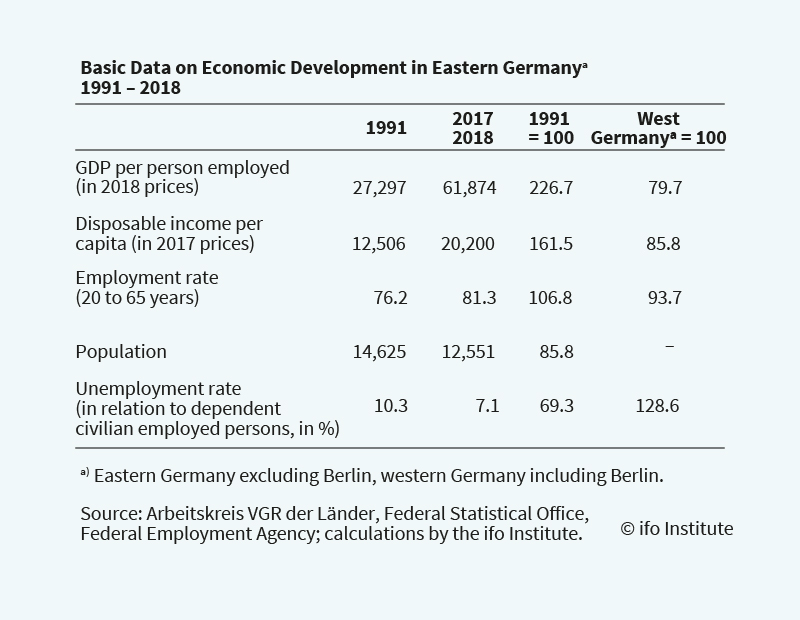
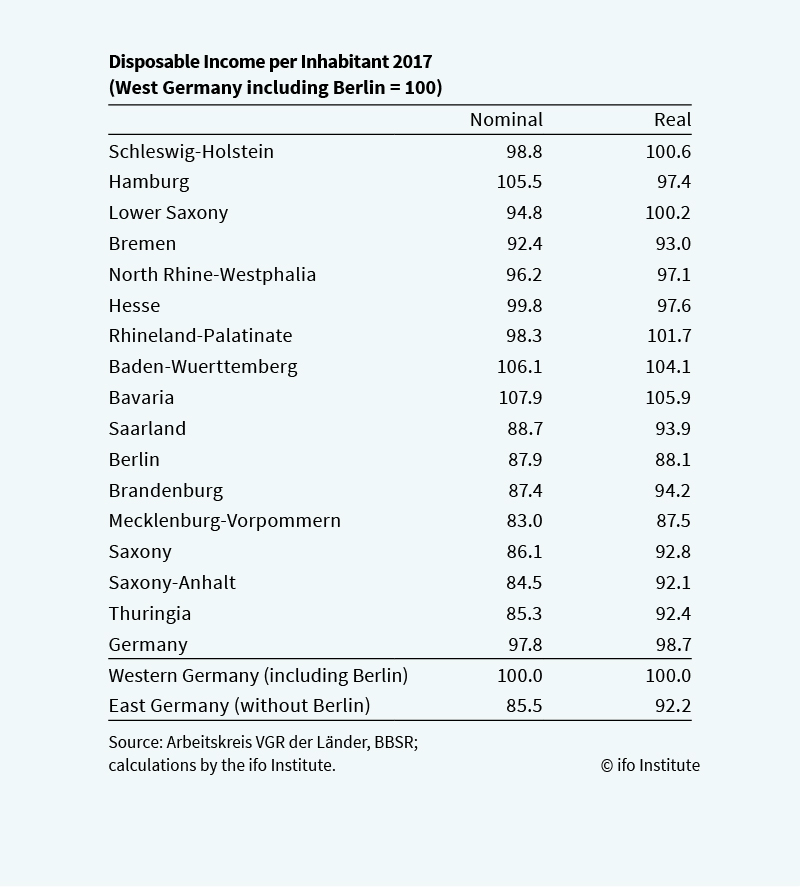
Comparison with the West
Residents of the eastern states often measured their progress against the West, feeling dissatisfied despite considerable advancements. Economic output and wages in the East only reached about 80 percent of the West’s average, with disposable income just catching up to the levels of Bremen and Saarland.
“Public perception of wage disparities fuels discontent,” Ragnitz explains. In 2018, the median wages for full-time workers in the East were 79 percent of those in the West, partly due to structural differences, such as a higher percentage of workers in low-wage sectors, 38.1 percent in the West and 42.9 percent in the East, and a scarcity of large corporations in the East, affecting overall wage averages.
Addressing Structural Shortfalls
Three decades post-reunification, East Germany had only managed to match West Germany’s economic output from the mid-80s. Persistent structural challenges – like fewer large firms, limited headquarters presence, a shortage of skilled professionals, and reduced research and development activities – continued to impede the East’s growth. “Considering these challenges... it’s notable that the East has managed to keep pace with the West’s economic growth in recent years at all and not falling further back,” Ragnitz points out. He suggests that the general sentiment might be gloomier than the actual circumstances, advising politicians to navigate beyond perceived public moods.
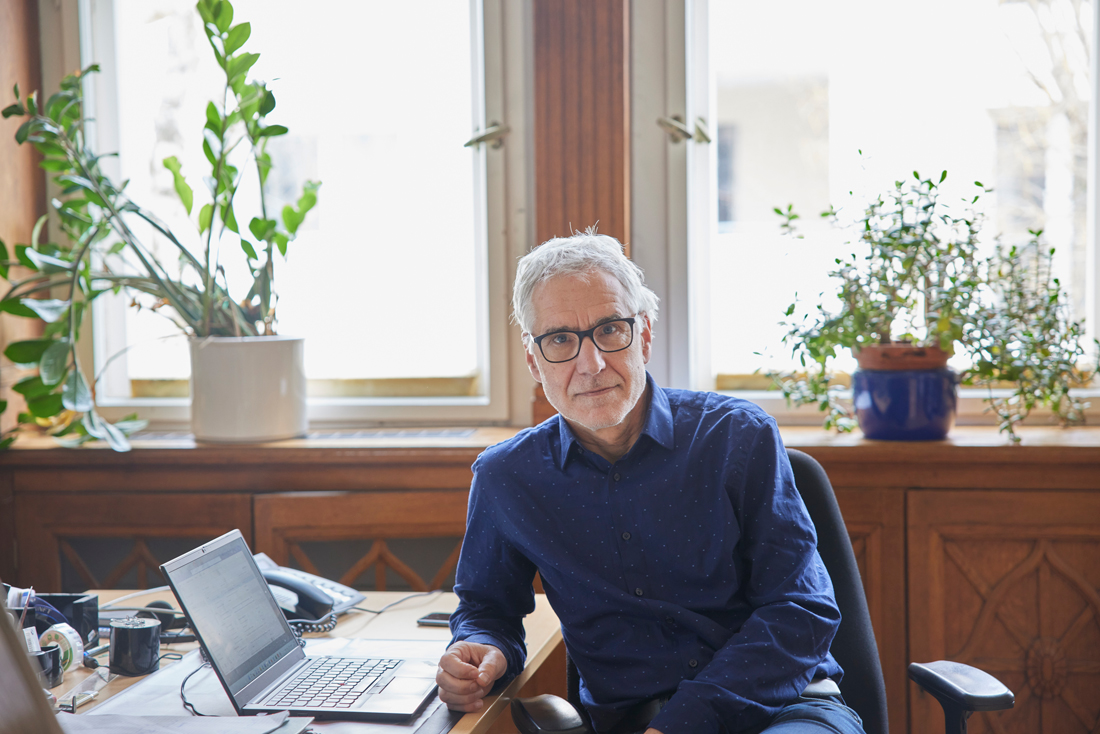
Milestone
Can We Do It? – Flight and Migration in 2015
At the Federal Press Conference on August 31, 2015, Chancellor Angela Merkel left no room for doubt: “We can do it.” Hardly any other sentence is so strongly associated with her term of office. The situation was critical: Shortly beforehand, the Federal Ministry of the Interior had announced that the number of migrants would rise to 800,000 by the end of the year. Merkel tried to brace the country for this huge challenge: “Whenever it matters, we – the federal government, federal states and municipalities – are able to do what is right and necessary. Germany is a strong country. The spirit we need to tackle these things must be: We have managed so much – we can do it!”

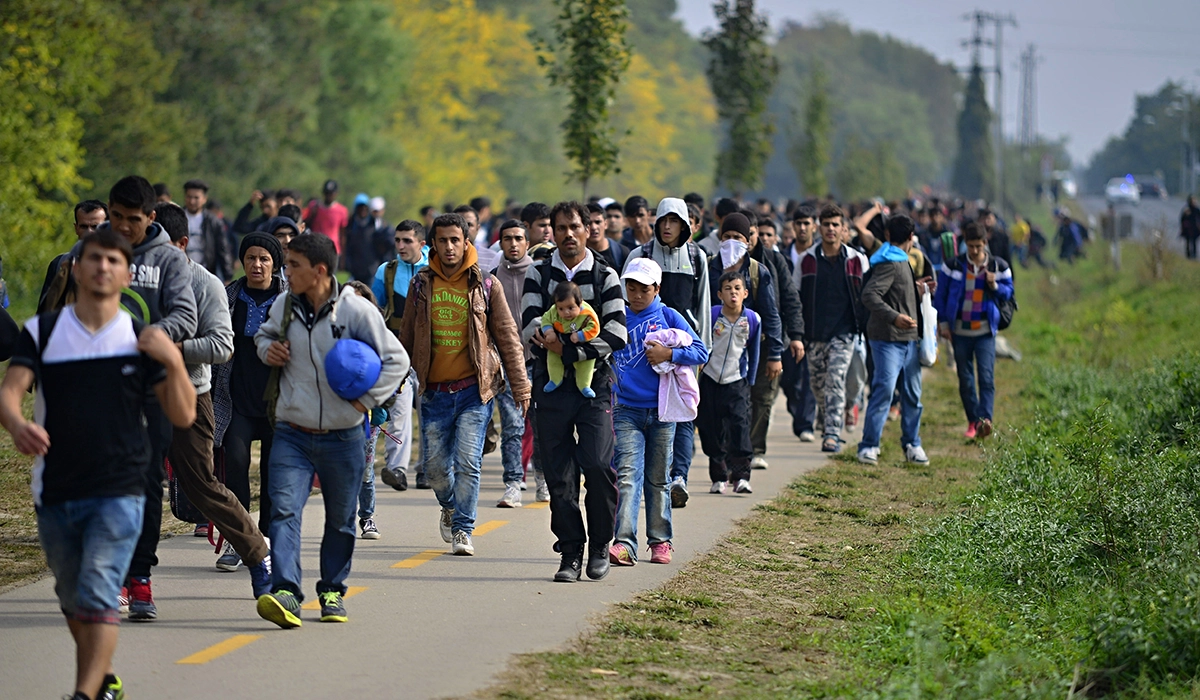
Fleeing from Dictatorship and Terror
The war in Syria was the main cause of the large flow of refugees in 2015. Most of the populace simultaneously faced existential threats from two sides, as the terrorist organization Islamic State grew in strength Syria and Iraq in 2014 and the Syrian President Bashar al-Assad sought to maintain his draconian rule. Fleeing from Syria to Turkey and from there to the Greek island of Lesbos seemed to be the last resort for many people who feared for their lives. The Greek authorities refrained from registering the refugees in an orderly manner and channeled the flows to Hungary and Austria through the Western Balkans.
The Background
Between 2003 and 2013, around 34,000 people a year applied for political asylum in Germany. That figure was 173,000 in 2014 but soared to 800,000 in 2015. Most of them came from Syria, Iraq and Afghanistan. Initially, their escape route took them through the Balkans, in other words, via Greece, North Macedonia, Serbia and Hungary to Austria. By mid-2015, around 150,000 people had reached Hungary and were accommodated in camps there. Hungary’s Prime Minister Viktor Orbán ordered the borders to Serbia to be closed in June. In addition, television pictures flashed around the world showing the harsh treatment meted out by the Hungarian police to refugees. In view of these events, the Federal Office for Migration and Refugees decided to allow people from Syria to enter Germany – even if they had not registered in another EU country.

Germany as a Safe Haven
The upshot was that many refugees no longer wanted to register in Hungary at all, but instead tried to travel directly to Germany. Riots broke out in some camps. In Burgenland, a truck was found containing more than 71 refugees who had suffocated after apparently being packed inside by smuggling rings and abandoned. The picture of the young Alan Kurdi also provoked outrage. The child drowned during the onward journey from Turkey to Greece. Angela Merkel’s decision to help those affected as quickly and comprehensively as possible should also be understood in light of the enormous pressure from the media.
Since 1949: The Fundamental Right to Asylum
The right to political asylum in Germany is governed by Article 16 of the Basic Law. In paragraph 1, it states: “Persons persecuted on political grounds shall have the right of asylum.” And paragraph 2 reads: “Paragraph (1) of this Article may not be invoked by a person who enters the federal territory from a member state of the European Communities or from another third state in which application of the Convention Relating to the Status of Refugees and of the Convention for the Protection of Human Rights and Fundamental Freedoms is assured.” That prompted critics of unrestricted admission of refugees to ask who was regarded as politically persecuted and why those coming from safe third countries such as Hungary and Austria should also enjoy a fundamental right to asylum.
The historical background to the right to political asylum being enshrined in the Basic Law was the expulsion of German Jews during the National Socialist regime. These refugees often had great difficulty obtaining political asylum in other countries, such as Switzerland.


What is the Situation 10 Years On?
Around 55 percent of refugees who came to Germany in 2015 are now in employment. Integration into the labor market appears to be working and that percentage is expected to increase significantly in the coming years. The economist Jan Kluge pointed out the importance of integration back in 2015 in a publication by the ifo Institute. The considerable increase in immigration would counteract population decline in Germany, but the positive effects on the business location
could only be achieved through comprehensive integration into the labor market. Immigration and the successes and problems of integration will continue to spark a passionate political debate in the coming years, including in other EU countries. Some observers see the events of 2015 as the basis for the growing success of right-wing populist parties such as the AfD.
Milestone
Celebrating Excellence: CESifo‘s Nobel Laureates
Today, marking 25 years since its inception, the CESifo network stands as one of the largest economic research collectives globally. Regular gatherings in Munich and around the world foster an exchange of ideas among international researchers, enhancing their understanding of complex economic issues. The prestige of this network is underscored by the exceptional caliber of its members, including 13 Nobel laureates from its ranks of over 2,000 members.

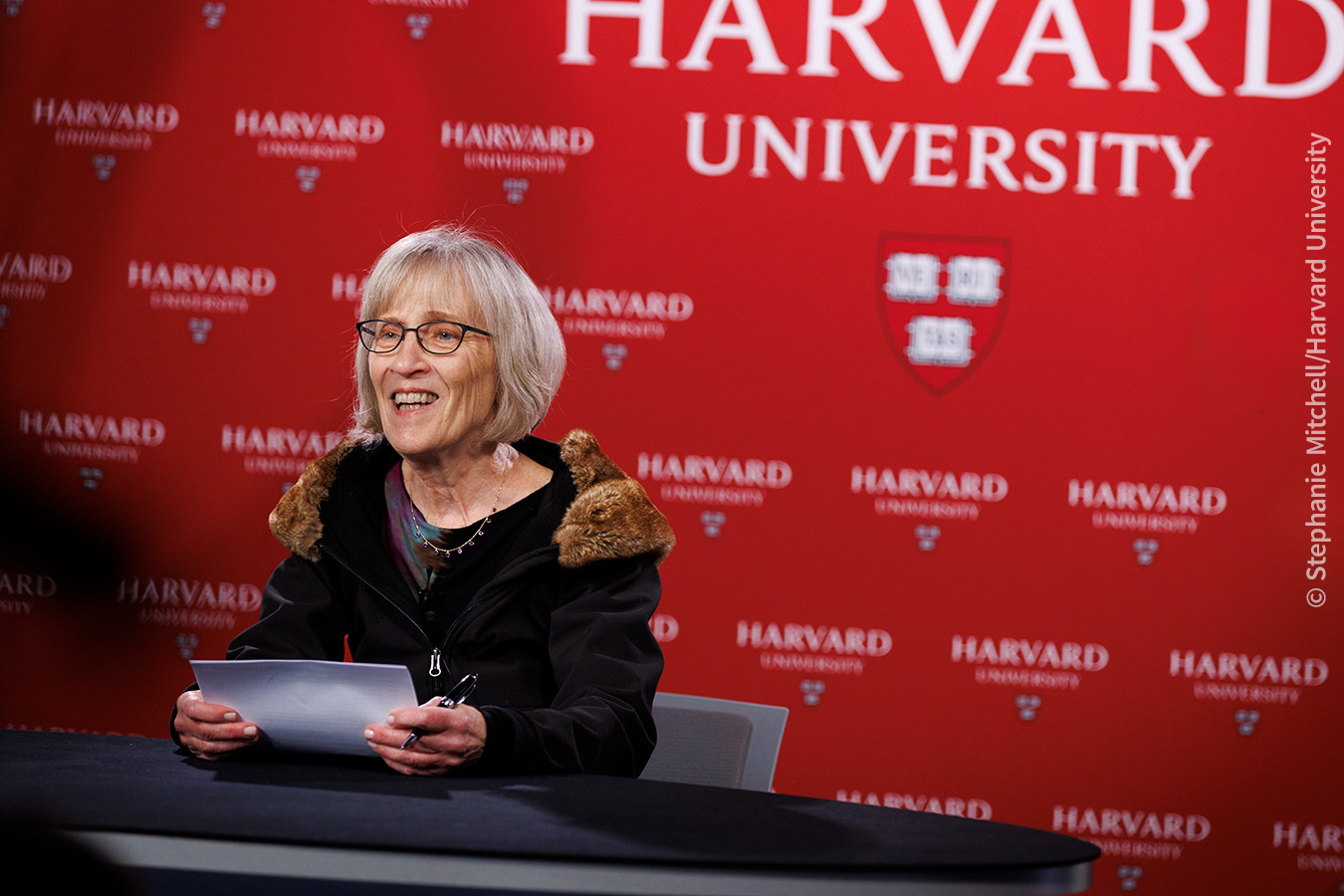
Tracing Women in the Labor Market
Among the distinguished is Claudia Goldin, Henry Lee Professor of Economics at Harvard University, who became only the third woman ever to receive the Nobel Prize in Economics in 2023. And she won it for her research in a field that, for a long time, also received little attention. Her work explores the historical role of women in the labor market, tracing back to the 18th century to uncover roots of present-day wage disparities, family structures, and educational inequalities. Claudia Goldin has been a member of the CESifo network since 2022 and is one of six CES Fellows to receive this coveted award by the Royal Swedish Academy.
Labor Market Dynamics
David Card, another notable CESifo member since 2024, was awarded the Nobel Prize in 2021, together with Joshua Angrist and Guido Imbens. His empirical research in labor economics, particularly his findings that increased minimum wages do not necessarily reduce employment, challenges long-standing economic assumptions.
He deals with central and real-life questions – why do people succeed or fail in the labor market? What factors drive wage inequalities? Given his wealth of publications and findings, it is all the more astonishing that David Card originally studied physics and only later switched to economics.

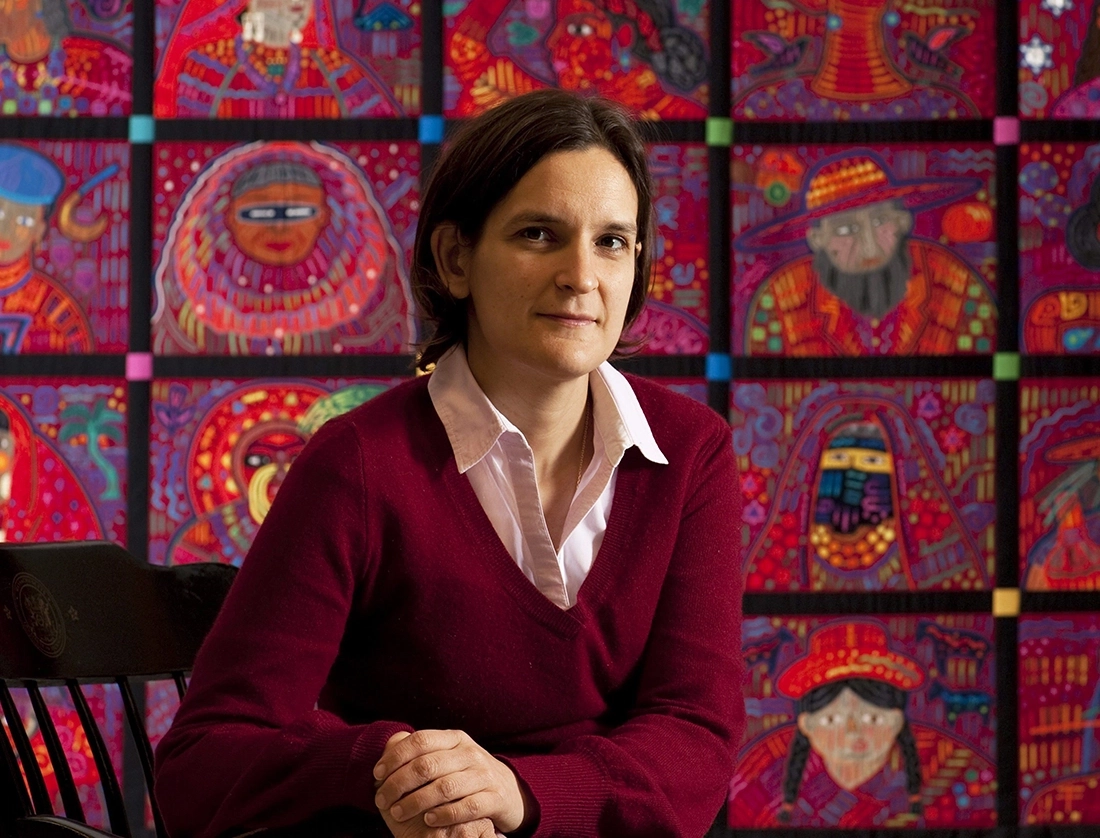
Development Economics and Poverty Reduction
Before Claudia Goldin, Esther Duflo was the second woman to receive the Nobel Prize in Economic Sciences from the Royal Swedish Academy. Awarded in 2019, she shared this honor with her husband, Abhijit Banerjee, and Michael Kremer. Duflo stands out as the youngest economist to receive this distinction. Specializing in development and social economics, her passion for addressing poverty, hunger, and social inequality was influenced by her mother, a pediatrician who worked with humanitarian organizations. It seems almost destined that Duflo would earn the Nobel Prize for her groundbreaking work in poverty research. Since the 1990s, she and her research partners have been using field experiments to devise effective strategies to combat global poverty. Esther Duflo has been a valuable member of the CESifo Network since 2013, contributing her expertise and experience.
Principles of Human Behavior
Many people see contracts as one thing above all else: Sheets of paper and tedious bureaucracy. The Finnish economist Bengt Holmström, however, who joined CESifo in the same year he won the Nobel Prize in 2016, has significantly advanced the understanding of contract theory, particularly in how companies can optimize CEO contracts. His work has broader implications for corporate governance and legal frameworks, offering new perspectives on human behavior and economic incentives within corporate structures. As he comes from the Swedish minority in Finland, he is probably one of the few laureates who could follow the ceremony in his native language.
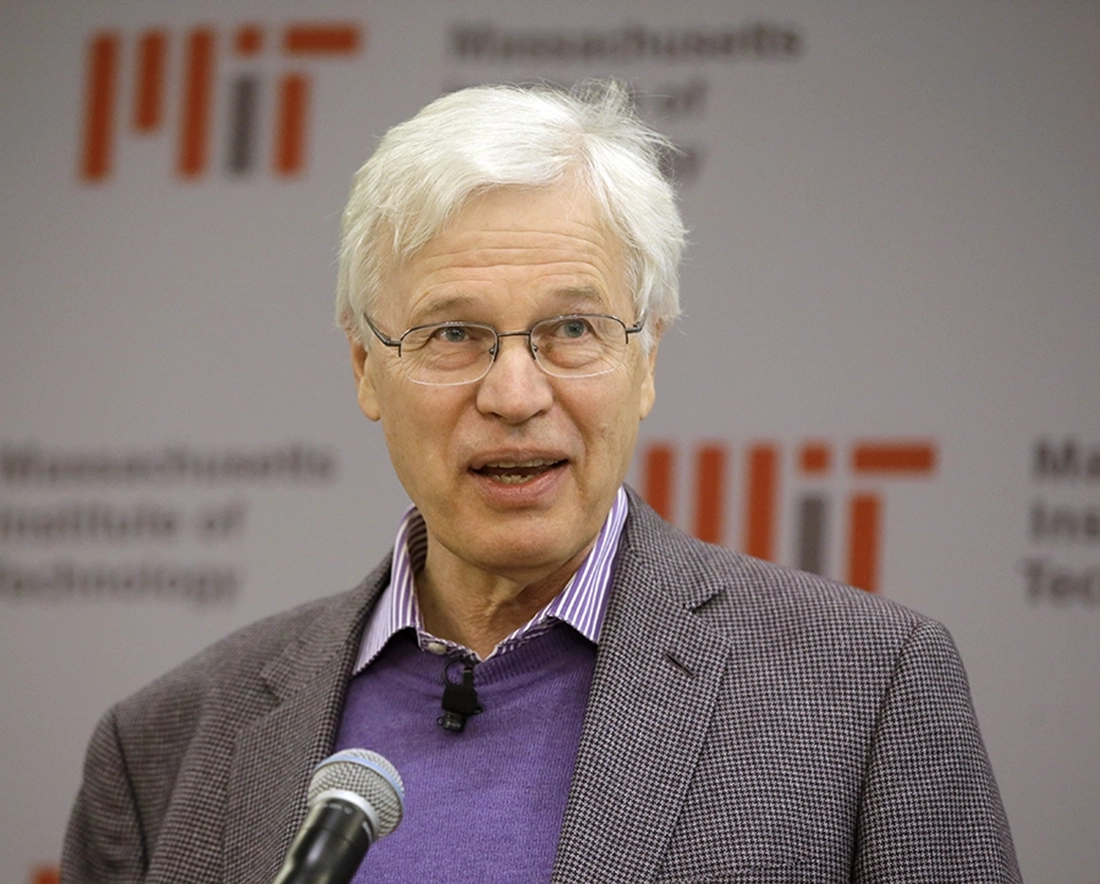
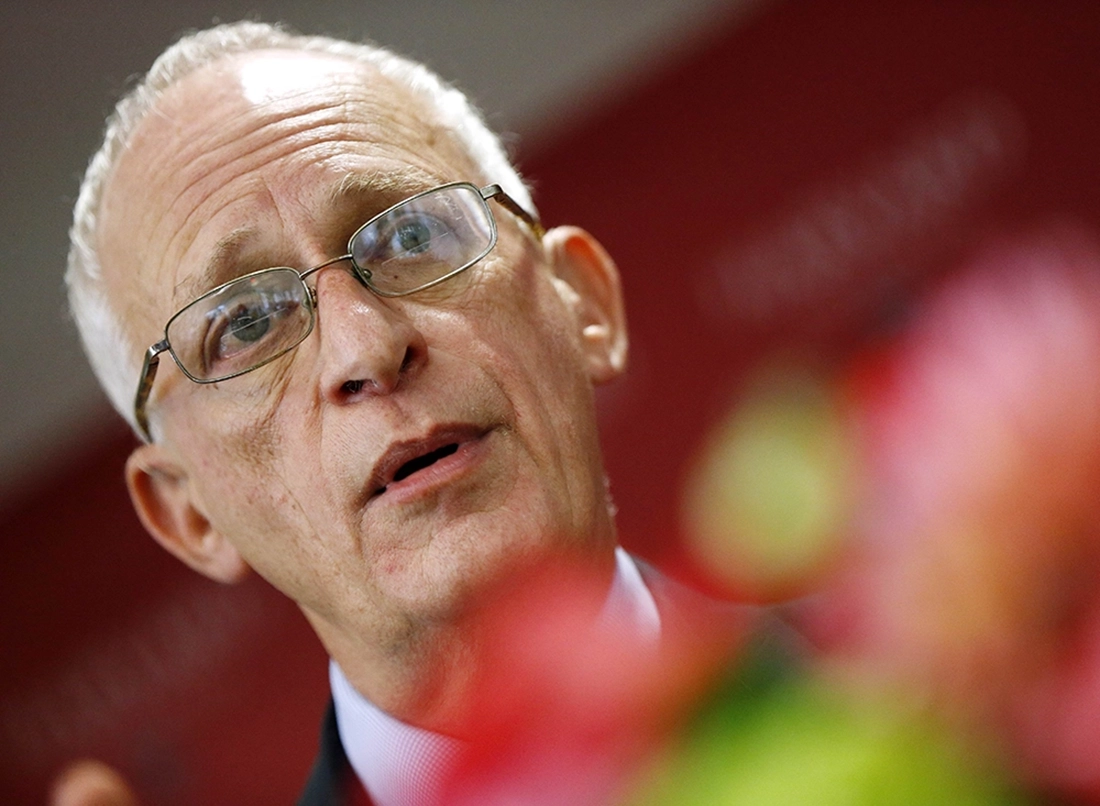
Practical Insights in Contract Theory
2016 was a good year for Nobel Prize winners in the CESifo network. In addition to Bengt Holmström, the jurors decided to award the prize equally to Oliver Hart from Harvard University and his contribution to contract theory. A foundational figure in contract theory, Hart’s innovative work has profoundly influenced both academic thought and practical policy. Journalists, for example, maintain the conviction that Hart influenced the U.S. government in its decision to no longer leave the management of prisons to private contractors. An active member since CESifo’s inception year 1999, his insights have shaped our understanding of how contracts are utilized within and outside the marketplace. Hart’s contributions were recognized with a Nobel Prize, and his ongoing impact was further acknowledged with a knighthood by King Charles III in 2023.
Leaving Poverty Behind
Scottish economist Angus Deaton delves into whether wealth equates to happiness, applying a rigorous economic perspective. Deaton, who was awarded the Nobel Prize in 2015 – a year before Hart and Holmström – received this honor for his lifetime contributions, as noted by the committee. His profound insights into need may stem from his own humble beginnings. Deaton’s research focuses on how individual spending patterns influence societal economic development. Throughout his fieldwork, he repeatedly encounters individuals who have remarkably overcome dire poverty, reinforcing his belief that escaping poverty is always possible. Since 2004, he has been sharing these inspiring stories within the CESifo Network, and in 2016, he was knighted by Queen Elizabeth II, becoming Sir Angus Deaton.
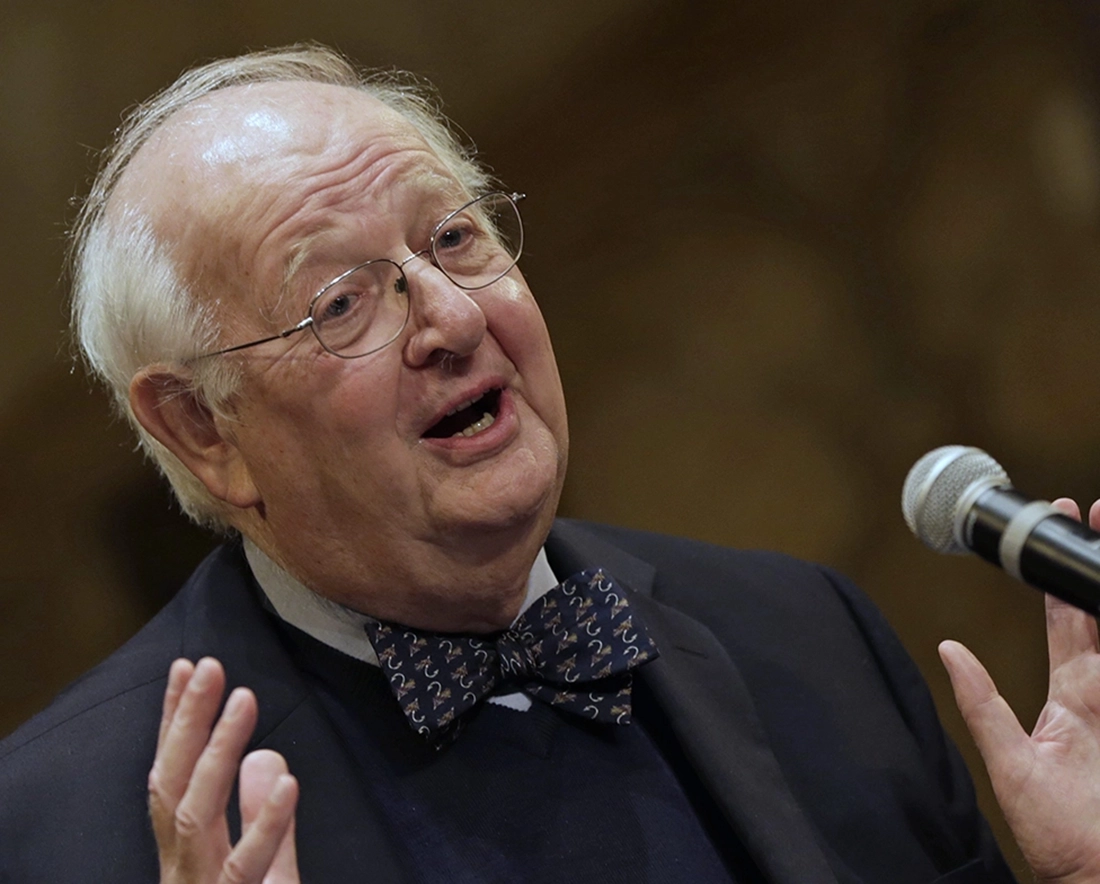
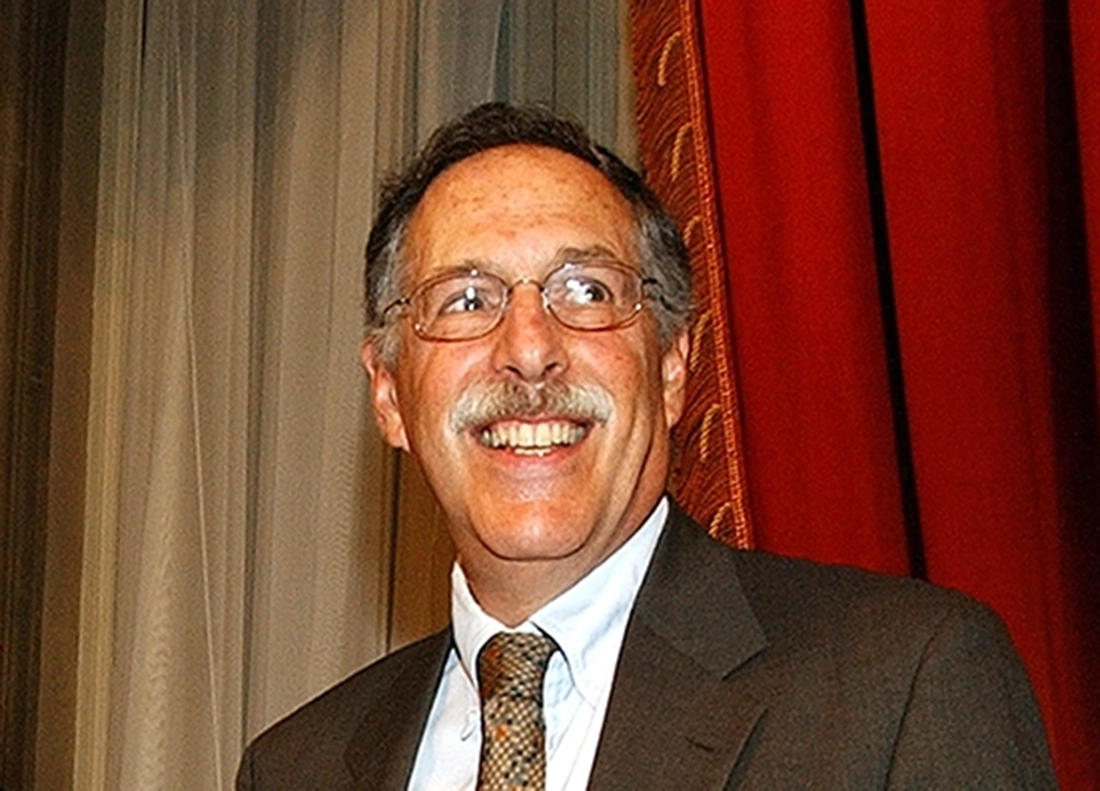
The “Application-Oriented Theorist”
A Nobel laureate in 2010, Diamond’s research into markets with search frictions has clarified the dynamics between policies and economic outcomes like unemployment and wages. With him, Dale T. Mortensen and Christopher A. Pissarides also received the prize. An “application-oriented theorist”, as Nobel Prize winner Eric Maskin once called him, Diamond‘s analysis of pension structures contributed to the reform of the U.S. system and the reconstruction of the Polish pension system. Peter A. Diamond, CESifo member since 2000, strives to get to the bottom of things – a fact that is also shown by his subsequent studies at Harvard Law School. Diamond is now Professor Emeritus at MIT, where he taught from 1966 to 2011.
The Human Factor
His own website describes Edmund S. Phelps‘ life‘s work as a project to embed “people as we know them” in economic theory. Phelps received the Nobel Prize in 2006 “for his analysis of intertemporal tradeoffs in macroeconomic policy”. His pioneering research began in the 1960s, challenging the then-prevailing assumptions about correlations between inflation and unemployment. During his career, he worked on various theoretical approaches and always added the human factor. In his analyses, Edmund S. Phelps recognized that the models failed to take into account ill-considered decisions or decisions made in the absence of better information. He has been sharing his approaches as a member of the CESifo network since 2000.
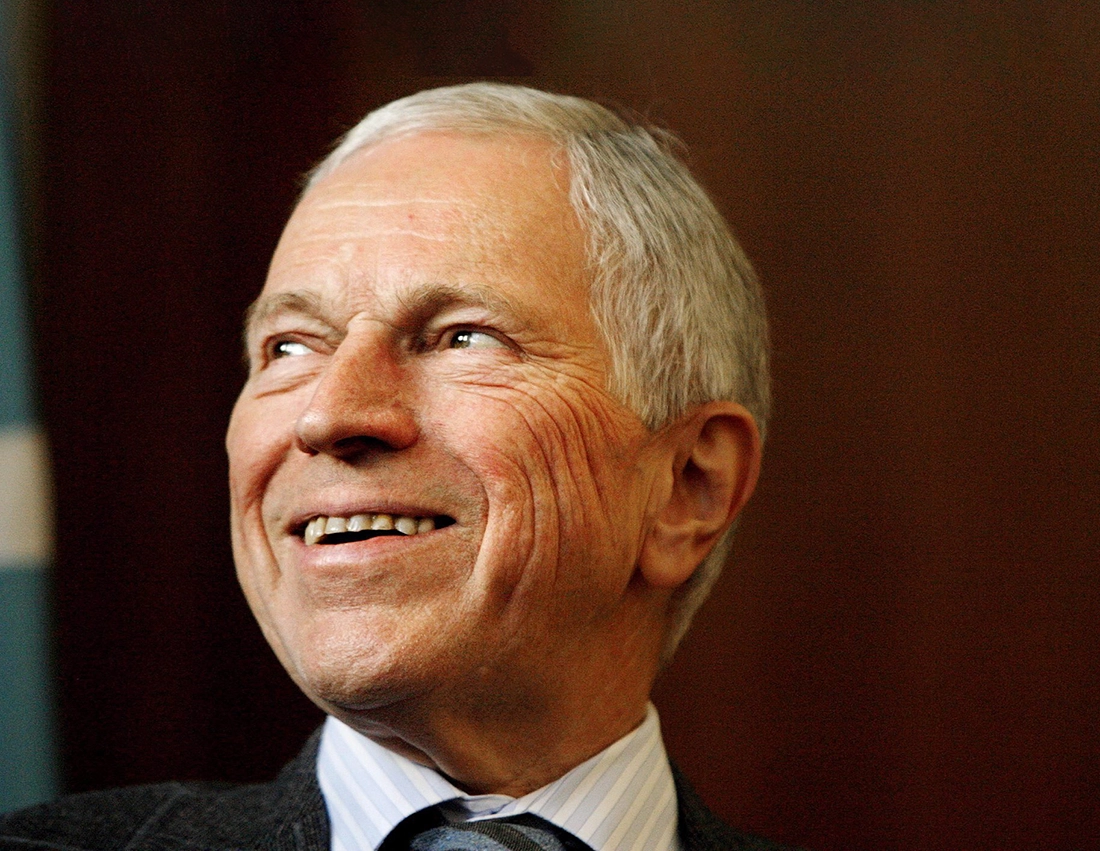
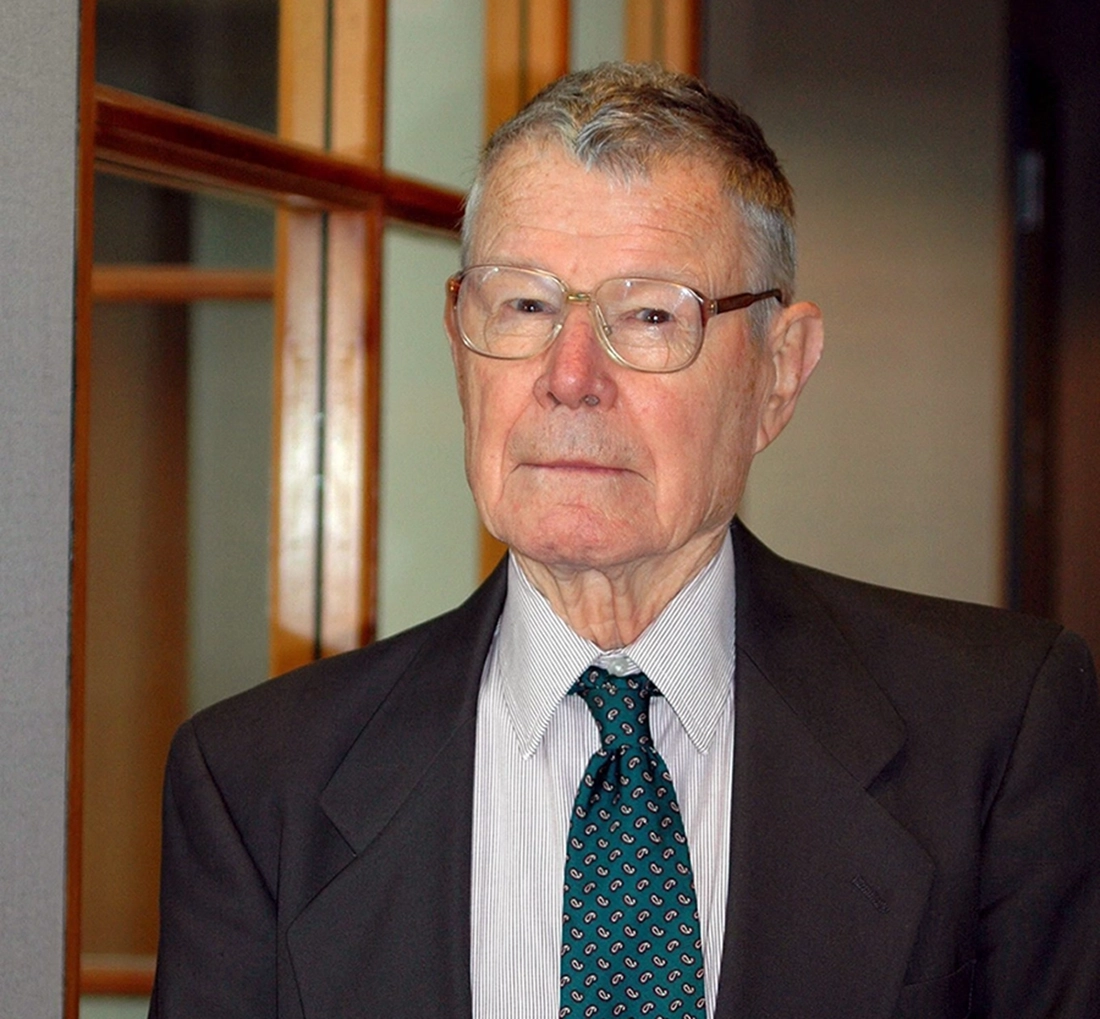
Conflict Theory in the Cold War
As a former classmate of Edmund S. Phelps, it‘s a striking coincidence that Thomas Schelling was awarded the Nobel Prize just a year before him. In 2005, the Royal Swedish Academy recognized Schelling, along with Robert J. Aumann, for advancing our understanding of conflict and cooperation through game theory analysis. During World War II and the early 1950s, Schelling contributed to politics, notably helping to craft the Marshall Plan. His 1960 publication, “The Strategy of Conflict,” remains one of his most renowned works, considered one of the 100 most influential books in the West since 1945. During the Cold War, his studies became particularly influential: Schelling viewed war as a bargaining process and argued that the best defense against a nuclear attack was to safeguard one’s own nuclear arsenal. Thomas Schelling was a valued member of the CESifo Network from its inception in 1999 until his death in 2016 at the age of 95.
The Heckman Correction
James Heckman's areas of expertise lie in political economy and statistics. He takes a deeply analytical approach to finding where economics and other sciences intersect in order to grasp the essential problems of society. Together with Daniel McFadden, he succeeded in developing “Theories and Methods for the Analysis of Selective Sampling”, which earned them both the Nobel Prize in 2000. His “Heckman correction” technique has enabled economists and policymakers to make more accurate interpretations of data where sample selection is biased. A member of CESifo since 2003, Heckman’s work has bridged the gap between theoretical economics and practical application in fields such as education and labor economics.

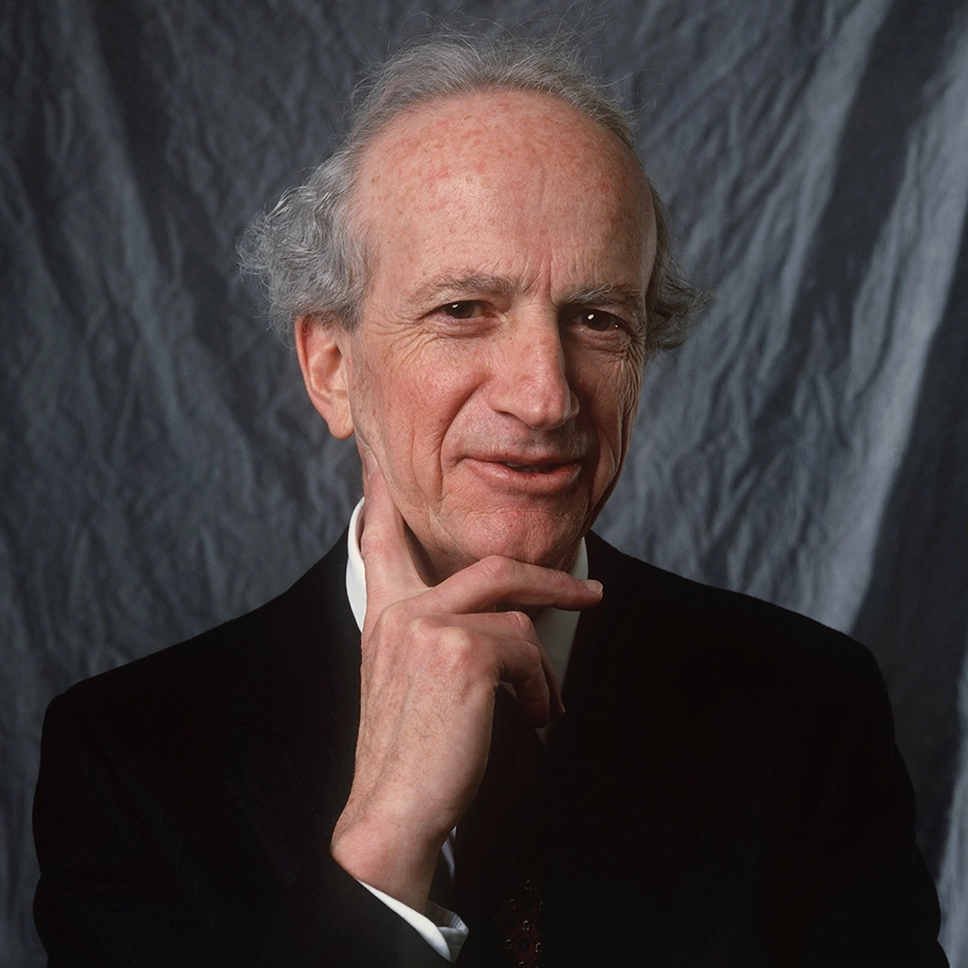
Gary Becker
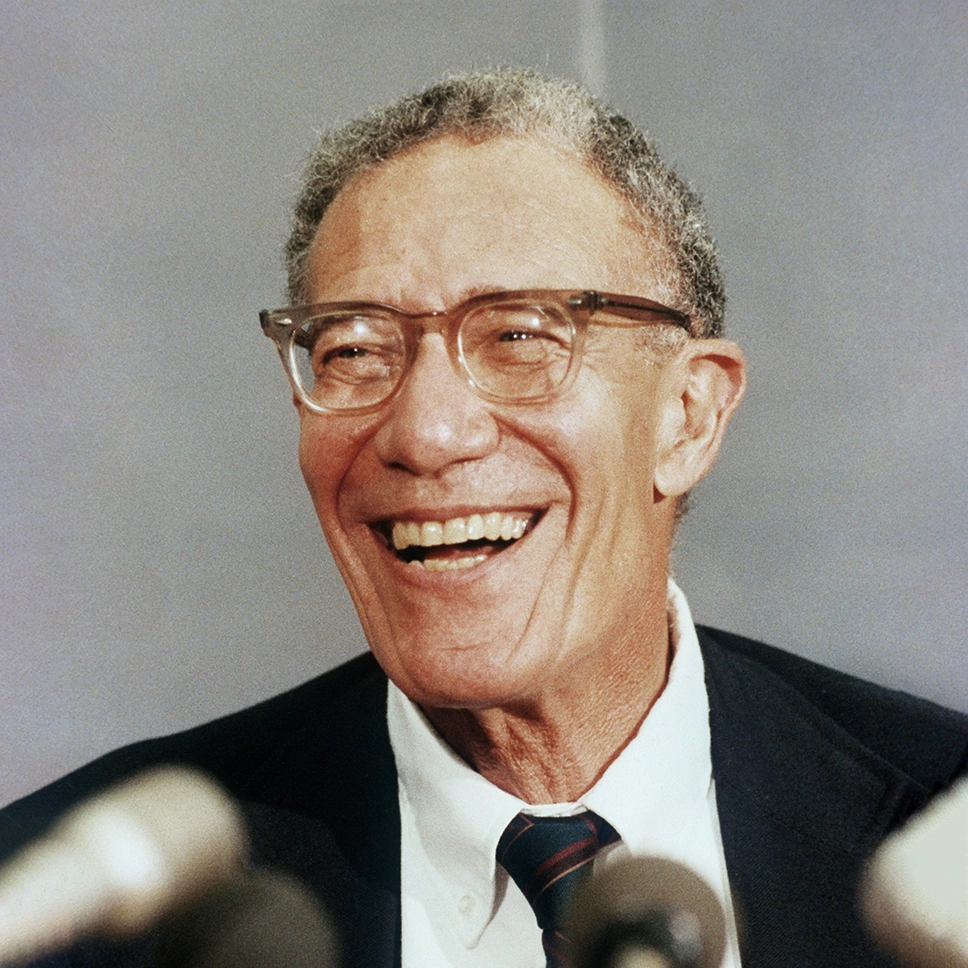
Robert M. Solow
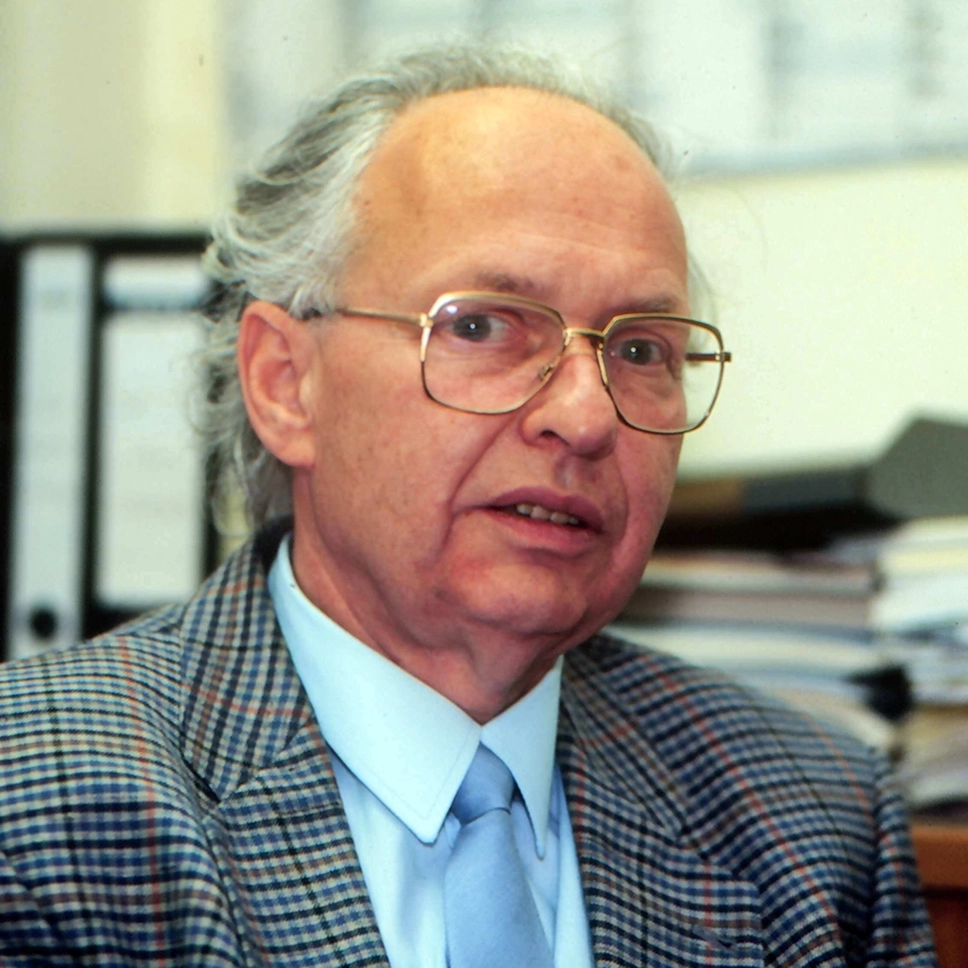
Reinhard Selten
From sociology in economics to game theory
Recognized with the Nobel Prize in 1992, Gary Becker (1930-2014) was a pioneer in extending economic analysis to domains traditionally considered outside economics, such as sociology. A CESifo member since 1999, his approach has influenced broad areas of human behavior and interaction. Awarded the Nobel Prize in 1987, Robert M. Solow‘s (1924-2023) models of economic growth have been fundamental in the study of how economies evolve over the long term. His work emphasizes the role of technological progress and its impact on growth. As a member of CESifo since 1999, the success of Solow’s work also shows in the fact that four of his students, including Peter A. Diamond, were also able to claim the Nobel Prize. As the only German Nobel laureate in Economics, awarded in 1994, Reinhard Selten (1930-2016) was renowned for his refinements of game theory. His work has provided deep insights into economic behavior and strategy, which have had profound implications across various fields. A member of CESifo from 1999 until his death in 2016, Selten’s contributions continue to resonate within the network.
Network
People
Celebrating Milestones: 25 Years of CESifo and 75 years of the ifo Institute
Marking a century of combined knowledge, the ifo Institute and CESifo are celebrating 75 and 25 years respectively – 100 years of scientific rigor influencing and shaping policy across generations. This year, under the banner “75 years of ifo - lots of exciting stories,” we invite you to explore the rich history of economic research and policy advice. Throughout the anniversary year, we will spotlight key events, delve into the institute’s past, present, and future, and introduce the personalities, places, and pivotal moments that have defined our journey.

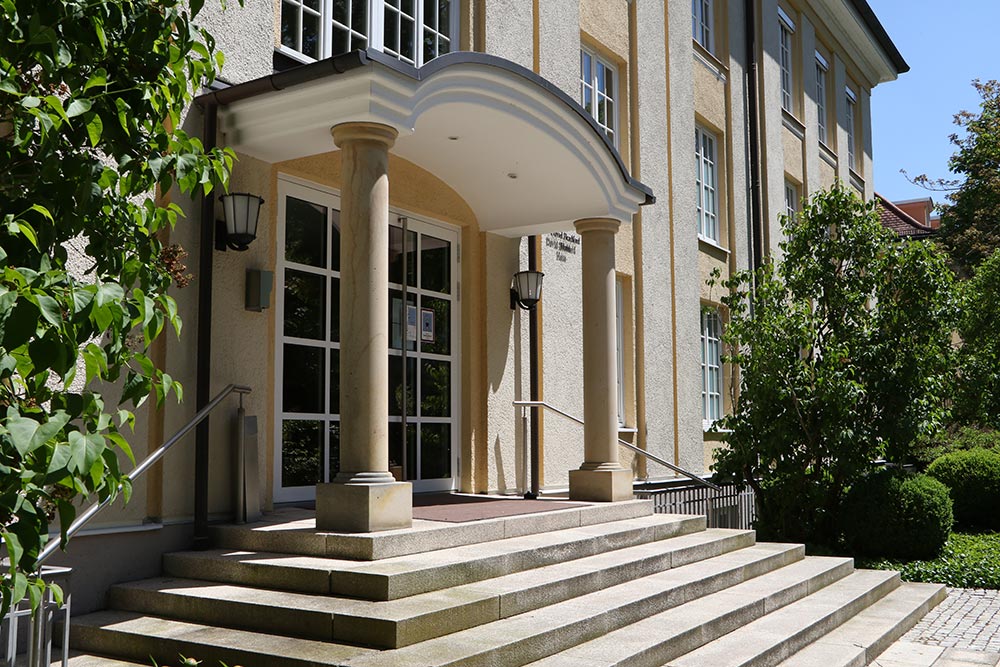
A Beacon of Economic Thought in Europe
Founded in the aftermath of World War II, the ifo Institute arose from the union of the Information and Research Center for Economic Observation and the South German Institute for Economic Research, established by Ludwig Erhard in 1946. Today, it is renowned for its top-tier economic research and policy advice, boasting an international reputation. “Our research provides the foundation for reliable analyses and data, empowering politicians, businesses, and the public to make informed decisions,” says ifo President Clemens Fuest at the start of the anniversary year 2024. “Our history began with economic monitoring via our own surveys. Today, for example, we are tapping into new data sources – big data – to be able to analyze and interpret economic developments more quickly.”
Legacy of the Founding Fathers Erhard, Schlesinger, Pohl
The institute’s operations began on March 1, 1949, with six full-time and twenty part-time employees, including future Bundesbank presidents Helmut Schlesinger and Karl-Otto Pöhl. The current name “ifo,” which stands for “Information und Forschung” (information and research), was added to the institute’s name only in 1950. By the autumn of 1949, the institute had launched its company surveys as an innovative method of economic and business cycle observation. These surveys would become the most important service and hallmark of the institute over the years: even today, they form the basis for the monthly published ifo Business Climate Index, a globally recognized indicator of Germany's economic development.
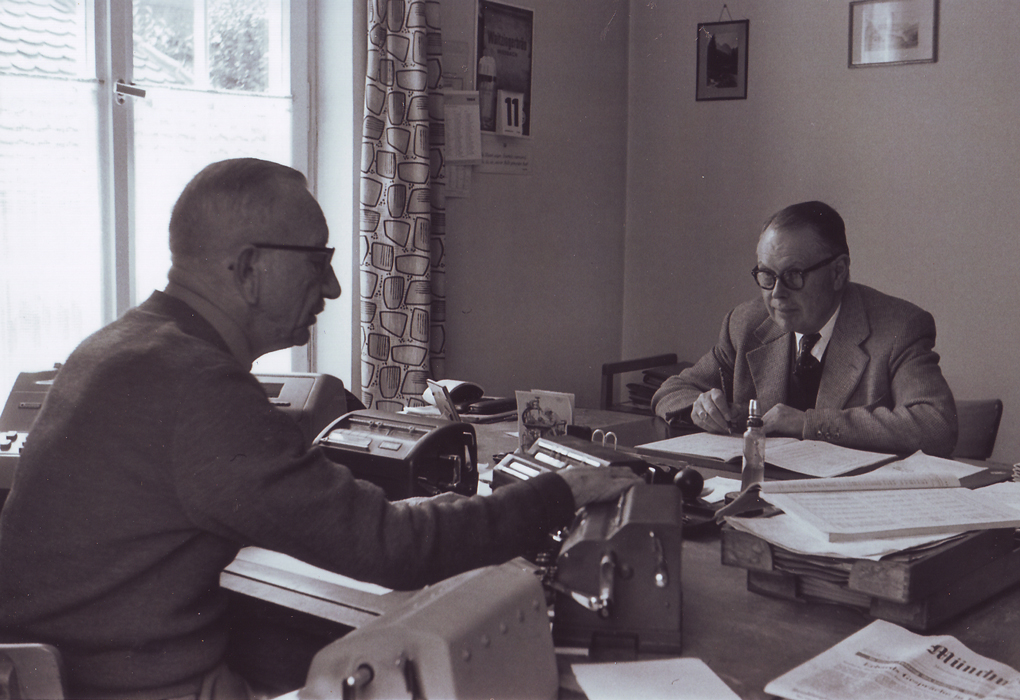

Expansion and Innovation
Since the German reunification, the ifo Dresden branch, established in 1993, has focused on the structural policy issues of the new federal states, particularly Saxony. In 1999, then-president Hans-Werner Sinn founded CESifo GmbH, creating a global network of over 2,000 economists, including several Nobel laureates. Affiliated with Ludwig-Maximilians-Universität München since 2002, the institute recently opened the Ludwig Erhard ifo Center for Social Market Economy and Institutional Economics in Fürth in 2022. In 2023, the ifo Institute revamped the LMU-ifo Economics Business Data Center (EBDC), enhancing its focus on Big Data Economics, which serves as a central research hub for all ifo Centers, their research partners and guest researchers.
“Shaping the Economic Debate”
In addition to economic trends, the institute’s nine research divisions now explore contemporary issues such as climate change, geoeconomics, new technologies, and inequality. The insights gained resonate widely. They are not only discussed within the academic community and published in leading scientific journals, but we also make a concerted effort to cultivate our emerging scholars to ensure research remains at a high level. Moreover, we distill these insights for public discourse. Through media reports and other channels, the ifo Institute’s analyses provide vital information to engaged citizens, business leaders, and association representatives. Additionally, policymakers frequently consult the institute when making significant decisions, underscoring the practical impact of our research.
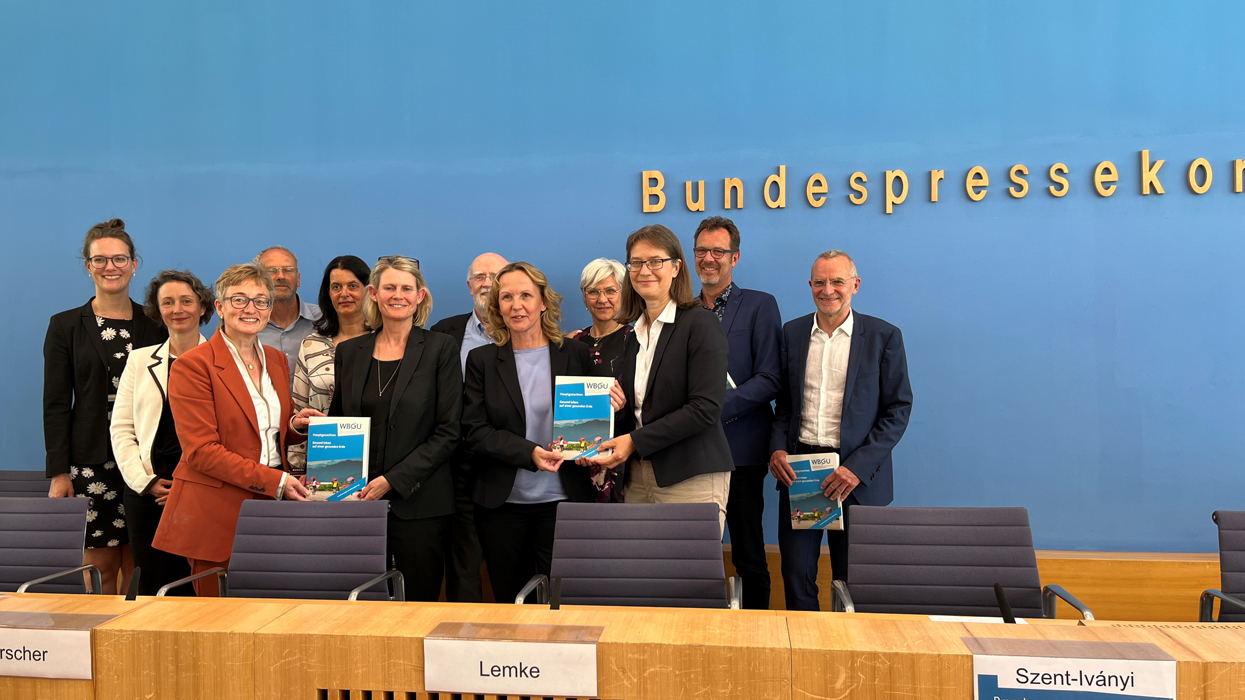
Beginnings
Impulse
CESifo: 25 Years of Growth
What underpins truly excellent research? Certainly, it involves engaging in meaningful exchanges with peers and effectively disseminating impactful findings. Such were the thoughts 25 years ago that, fueled by a vision from former ifo president Hans-Werner Sinn, gave rise to one of the largest research networks in economics. Today, as CESifo marks its silver jubilee, it continues to thrive and expand.
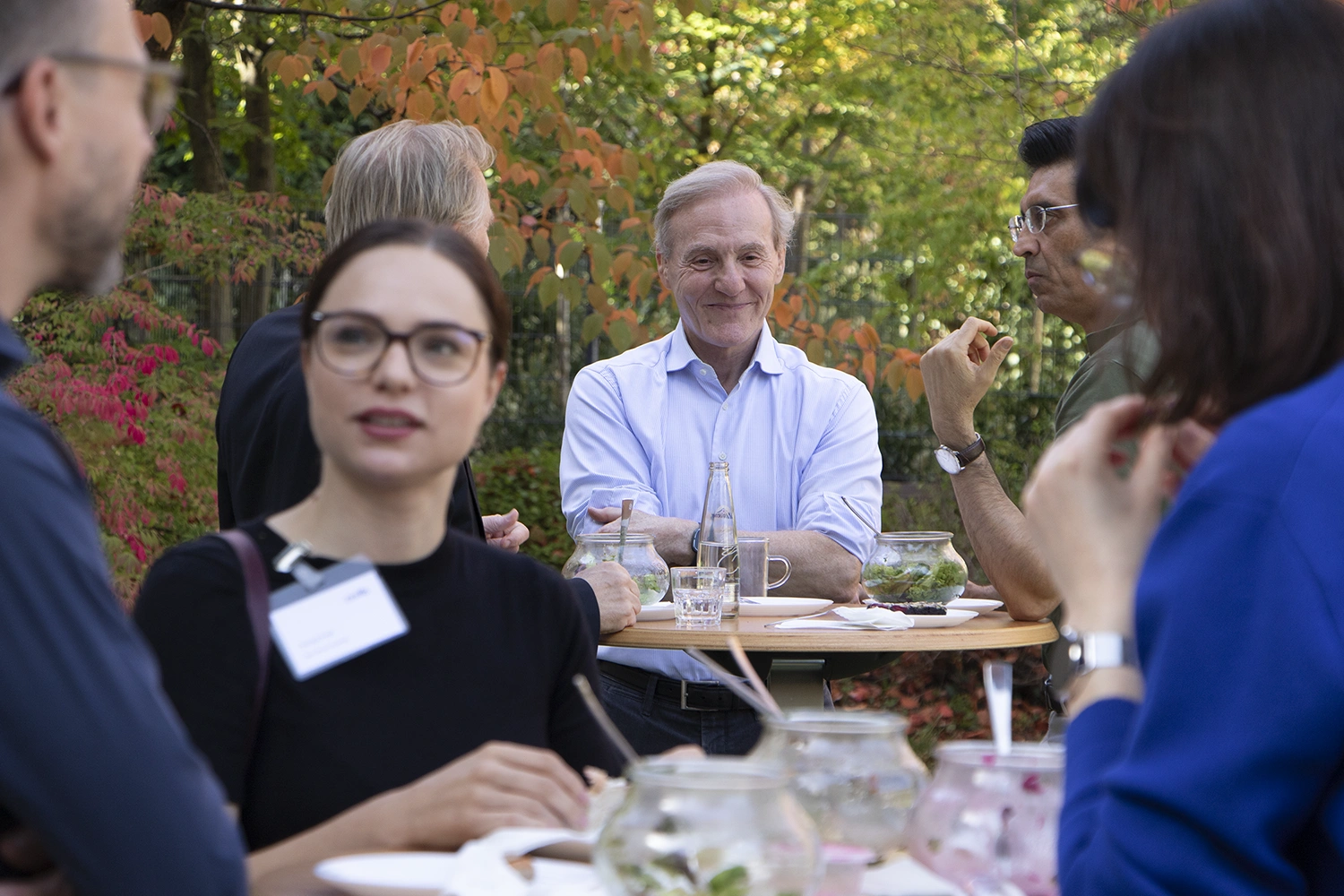

The Origins of CESifo
Every significant achievement begins modestly. A quarter-century ago, Munich wasn’t yet recognized as a hub for economic research. However, the Center for Economic Studies (CES) at LMU Munich attracted attention; its working papers grew in influence, drawing diverse groups of visiting economists. Inspired by this burgeoning interest, former ifo President Hans-Werner Sinn envisioned a network that would harness this momentum. The participation of 230 guest researchers, the burgeoning publication efforts, and the organization of pivotal research conferences became the cornerstones of what CESifo would represent. These foundational elements are still evident in CESifo’s operations today.
CESifo Today: A Synopsis of Growth and Influence
With over 2,040 economists from 46 countries, more than 11,000 working papers published, and upwards of 800 events attracting over 40,000 participants, CESifo has evolved into a premier, independent global research network in just over two decades. The network brings together distinguished economists across various specialties, each contributing years of experience and expertise. Its mission extends beyond fostering global knowledge exchange on economic topics; it aims to fortify the collaboration between the ifo Institute and LMU Munich and to sustain Munich’s role as a dynamic hub of economic dialogue in Europe.
Interested in learning more about CESifo and the team driving its success? Click below to watch our anniversary video, which offers a glimpse into the network’s events and highlights and introduces the people who are integral to CESifo’s operations. For further details, visit us online.
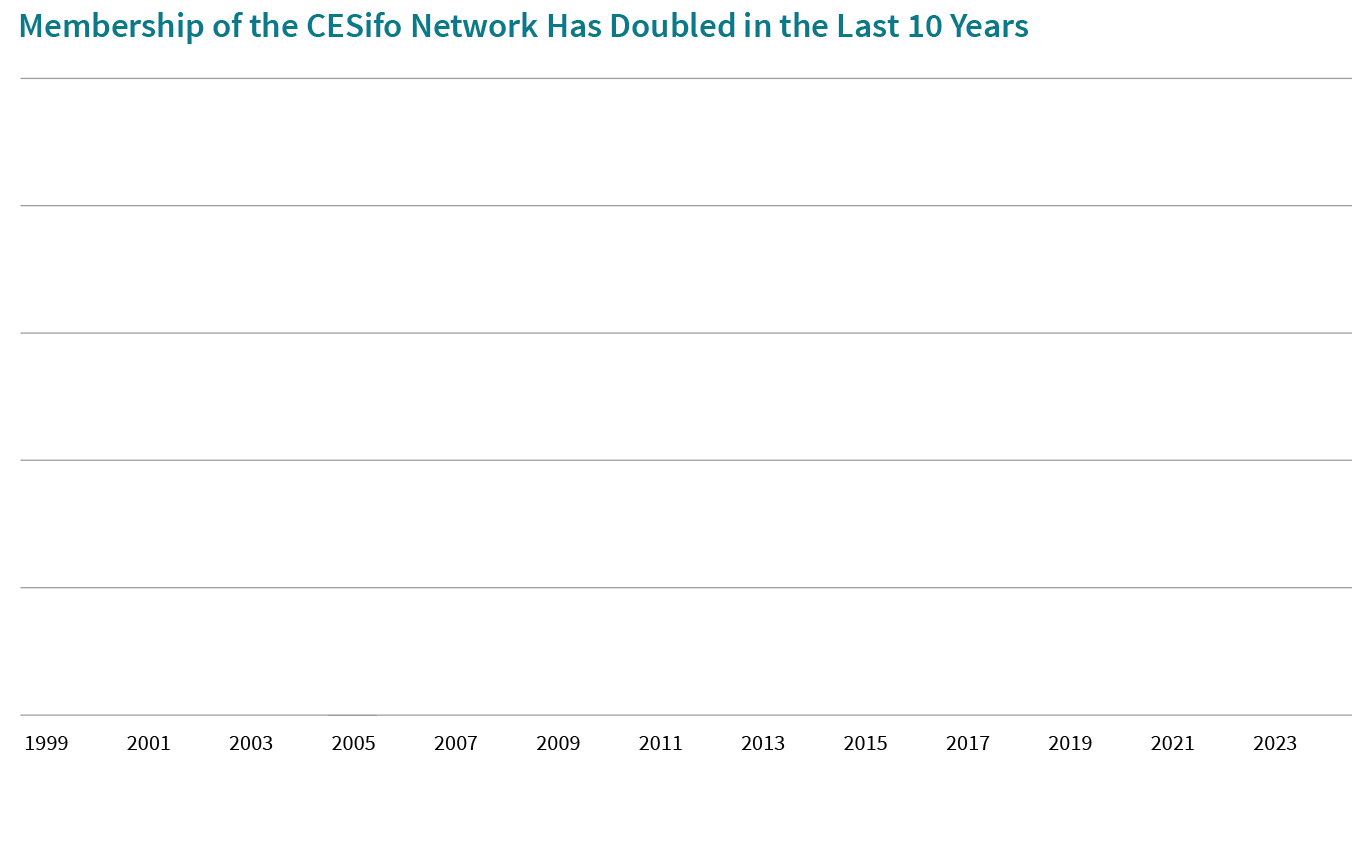
Network
Combating Poverty in Old Age: The 1957 Pension Reform
In the wake of the 1950s’ economic boom, a significant portion of the population, notably the 4.5 million pensioners, found themselves overlooked. In 1957, Chancellor Konrad Adenauer recognized an opportunity to engage a generation that had been previously overlooked, using comprehensive pension reform as a key strategy ahead of the upcoming Bundestag elections. Critics of the reform warned that the central feature – a solidarity-based intergenerational contract – would lead to significant financial challenges for future politicians, especially if birth rates declined, effectively creating a form of hidden national debt. However, Adenauer famously brushed aside these concerns, asserting that “People always have children.” The ifo Institute has actively participated in these discussions, tracing from the initial pension debate in 1956 through to contemporary analyses.
Urgent Calls for Reform
The Invalidity and Old Age Insurance Act, a piece of Bismarck’s social legislation introduced in 1889, provided basic security in old age or in case of occupational disability. However, to meet the full cost of living, individuals often had to dip into their savings or depend on family support. Despite the changing economic landscape, this pension system’s core principles remained unchanged through the post-war period, not accounting for rising prices and wages. Many lost not only their loved ones and savings during the war but also found pensions as their sole income source. The need for reform was clear, yet after initial promises in 1953, Konrad Adenauer’s government faced criticism for its slow action.
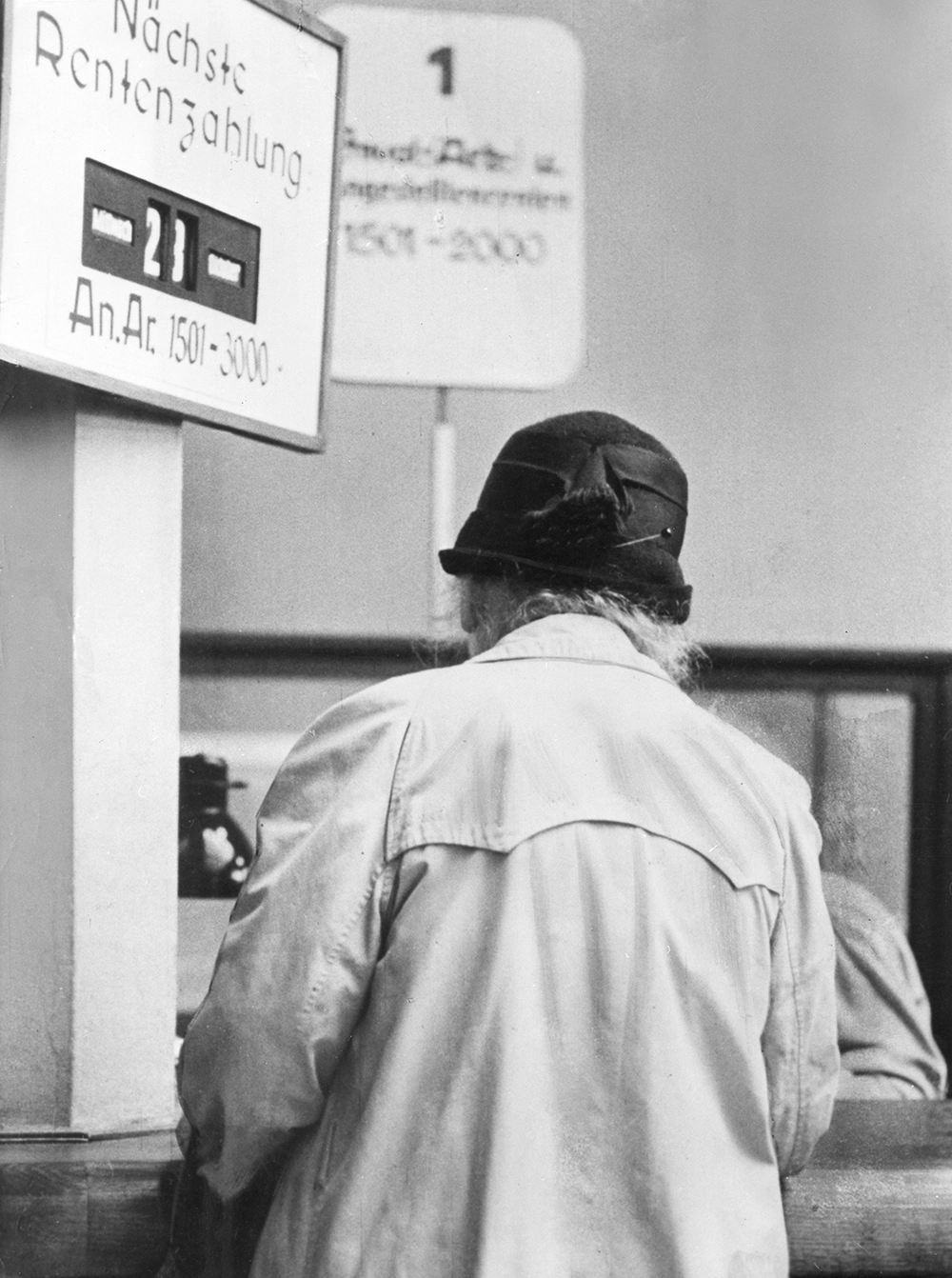
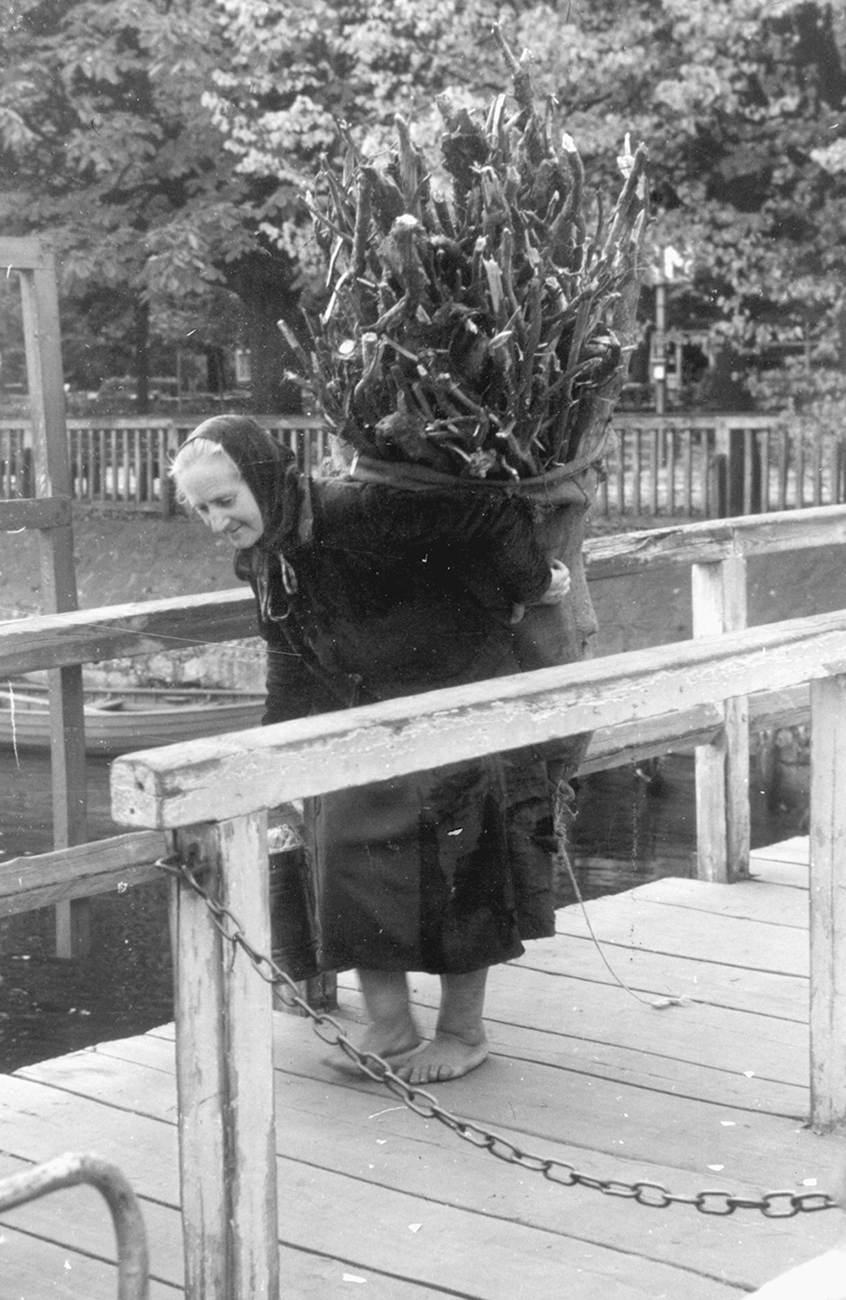
The “Schreiber Plan”
A study by the Federal Statistical Office, commissioned by the Federal Ministry of the Interior on the social conditions of pensioners and benefit recipients, catalyzed the push for significant reform. With the average net pension at 62.90 Deutsche Mark – merely a third of an average wage and below the subsistence level – an increase in social benefits was deemed urgent.
Wilfrid Schreiber, a pre-war writer and journalist, proposed a reform plan. Despite his controversial past, including membership in the NSDAP and involvement in wartime propaganda, the Association of Catholic Entrepreneurs (BKU) hired him as a consultant, and he also taught courses in economic theory, social policy, and statistics at the University of Bonn.
The Reform Draft
Schreiber’s reform proposal envisioned a unified mandatory statutory insurance to replace the separate schemes for disability, employee, and miner’s pensions. Crucially, it proposed replacing the existing funded system with a novel pay-as-you-go method. This so-called generational contract required each working individual to pay a certain percentage of their gross income into the pension fund, from which current pension payments would be made. Additionally, Schreiber suggested redefining how pensions were calculated. He developed a formula that was linked, among other things, to general wage developments. This principle of dynamic pensions was intended to bring about a significant increase in social benefits.
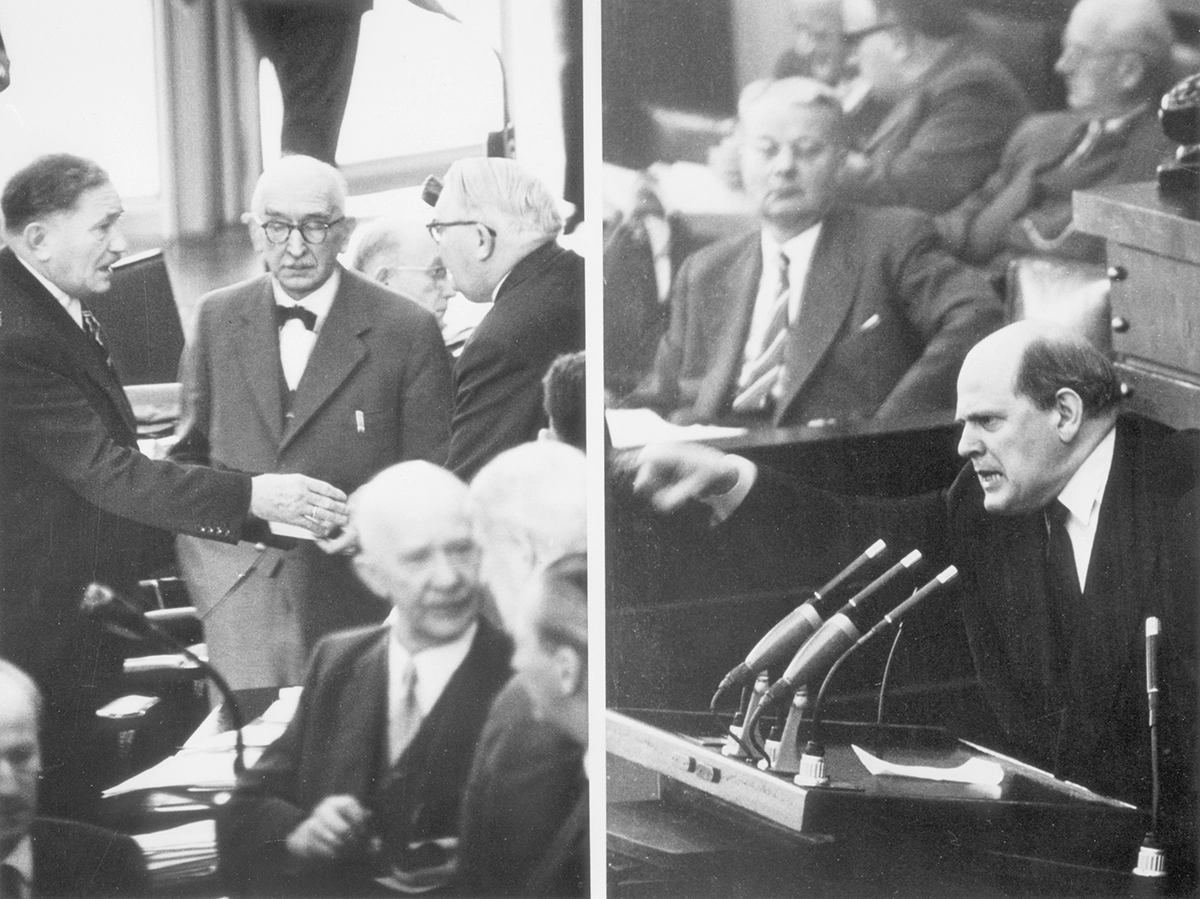
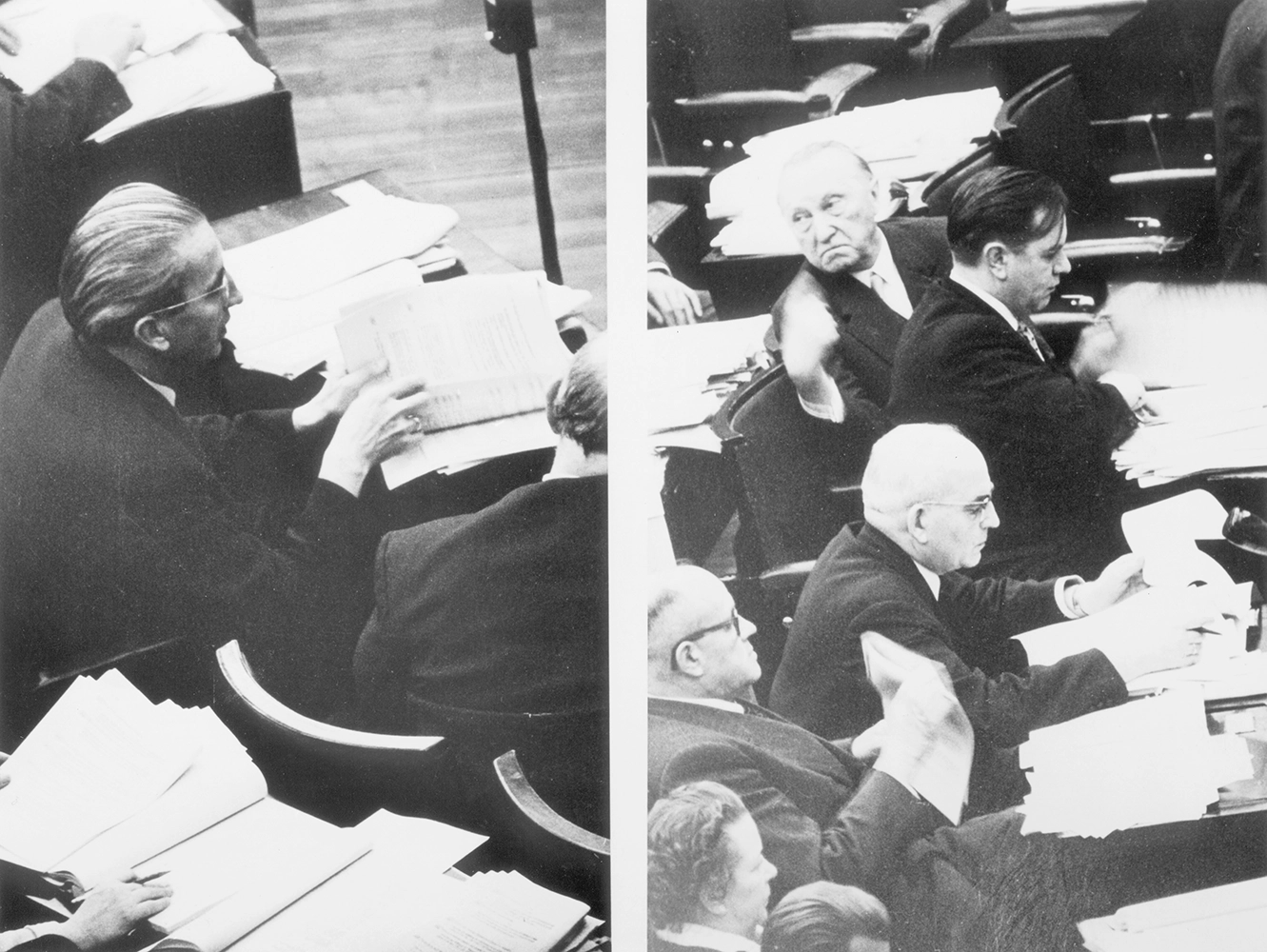
Intense Discussions and Historic Approval
The journey towards the enactment of the 1957 pension reform was marked by profound and, at times, heated debates, earning its place in history as the “pension battle.” In the Bundestag, Germany’s federal parliament, the debates reached their zenith. Members of the Social Policy Committee had already laid the groundwork with spirited discussions, but it was during the bill’s second reading that parliamentarians truly delved into the heart of the matter. For four days, a marathon of speeches unfolded, with parliament dissecting and debating hundreds of paragraphs and amendments. In the end, the Bundestag cast its votes on January 21, 1957, and the reform was approved by a substantial majority.
Konrad Adenauer, the Chancellor, had been a driving force behind the reform, strategically aligning its passage with an eye towards the upcoming Bundestag elections. The first payments under the new system were made in April 1957, setting the stage for a significant electoral victory for the CDU/CSU in the September 1957 Bundestag elections, where they achieved an absolute majority.
Ifo’s contribution to the pension debate
In the lead-up to the pivotal pension reform of 1957, the ifo Institute made significant contributions to the shaping of the debate. In 1956, it published a comprehensive study titled “On the economic problems of dynamic social pensions”.
The study brought to light several fundamental economic concerns associated with the forthcoming reform, which was anticipated to dramatically reshape the West German economy. It argued for minimal state intervention in the pension scheme, proposing that pension adjustments should occur automatically in line with wage and market trends. Moreover, the ifo Institute’s report emphasized the importance of individual responsibility and the need for clear incentives for personal pension planning.
By the time the reform took full effect, the level of benefits had increased by an average of 65 percent. Wages and pensions rose substantially in the years following the reform, with pensions increasing by 110.5 percent by 1969, nearly keeping pace with a 115.7 percent rise in wage levels. This alignment ensured that pensions were sufficient to cover living expenses, a marked improvement from the pre-reform era. The switch to the pay-as-you-go system also enhanced the reliability of the pension system, safeguarding it against the economic volatility that had previously eroded its value.
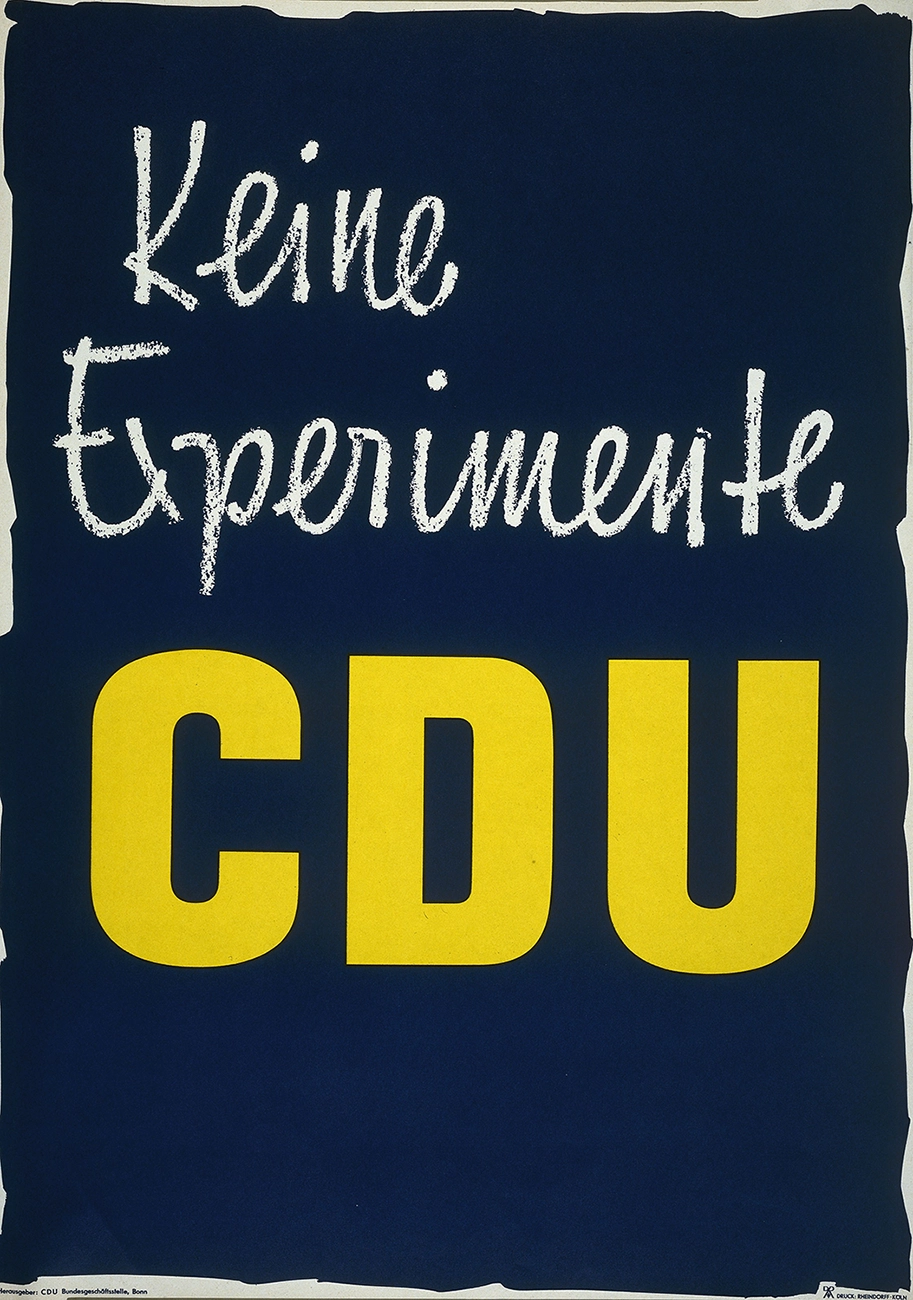
Milestone
COVID: A Virus Changes the World
December 31, 2019: Authorities in the Chinese mega-city Wuhan informed the World Health Organization (WHO) about an outbreak of a previously unknown lung disease. A novel coronavirus variant was identified as the cause on January 7, 2020. On January 30, the WHO declared a public health emergency of international concern. The coronavirus pandemic spread rapidly, changing the world as we knew it. Right at the beginning of the pandemic, the ifo Institute showed that containing the number of infections and curbing the economic consequences went hand in hand – and were not conflicting goals, as many claimed.
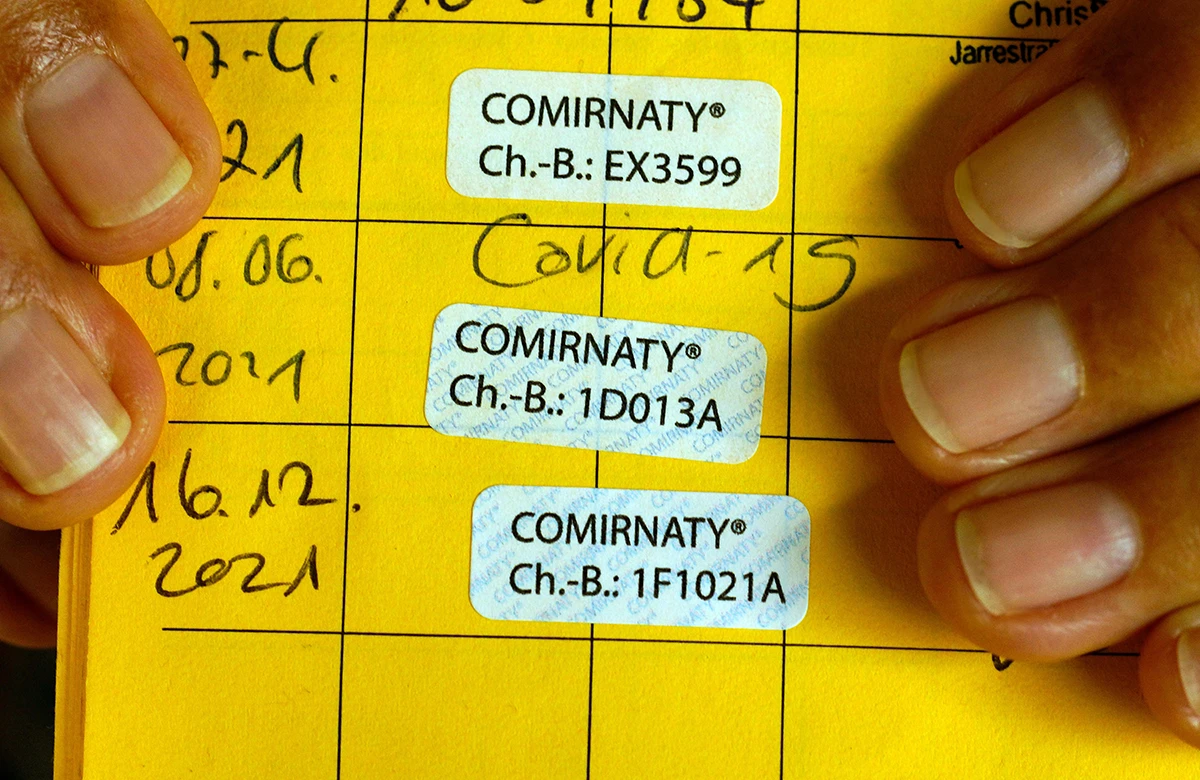
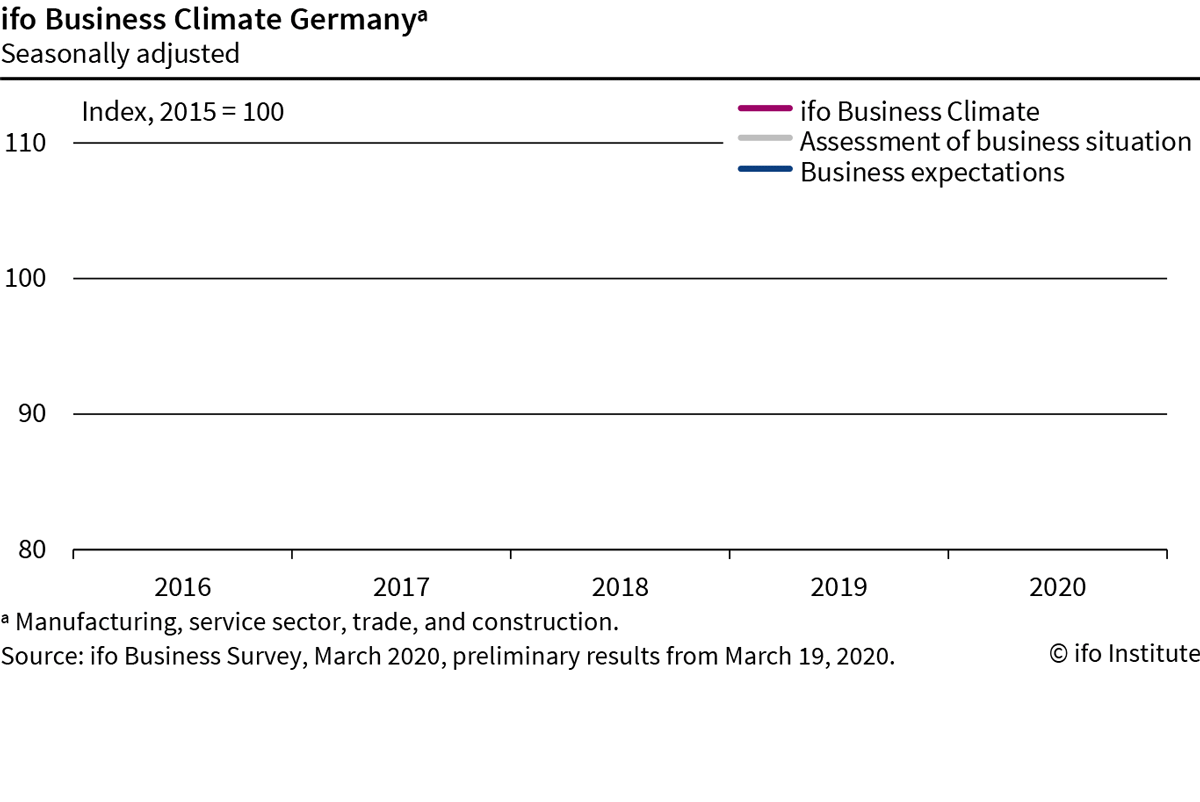
Global Economic Impact
The global economic repercussions of the coronavirus outbreak were discussed at the G20 summit in Riyadh, Saudi Arabia, on February 22, 2020. There was still hope of containing the virus’ spread and that there would only be a short-lived economic slump. Yet it was already too late. The international financial markets tumbled dramatically in February. The world stood on the brink of a severe economic crisis. For the first time in its history, the ifo Institute published an interim Business Climate Index on March 19, revealing the sharpest decline in business expectations in its 70-year history. Other indicators also plunged. In the assessment of ifo President Clemens Fuest, a global economic crisis with more dramatic consequences than the 2009 financial crisis loomed.
“It’s Serious. Take it Seriously Too!”
Angela Merkel addressed the German people with those dramatic words in a televised speech on March 18, 2020. And the calculations by the ifo Institute in February 2022 showed just how serious the pandemic’s consequences were not only for people’s lives and health, but also for prosperity. COVID caused EUR 330 billion in economic losses for Germany in 2020 and 2021, corresponding to a drop of ten percent compared to overall economic output in 2019. Before the pandemic, economic growth of 1.3 percent in each of those years had been forecast.
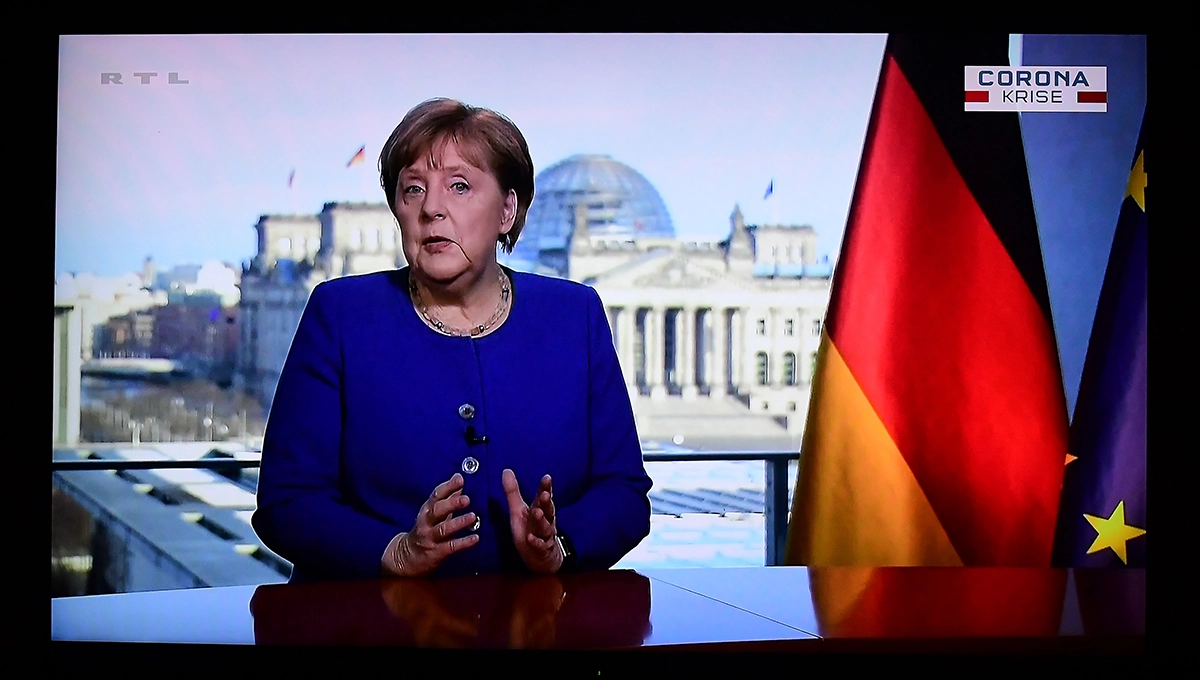
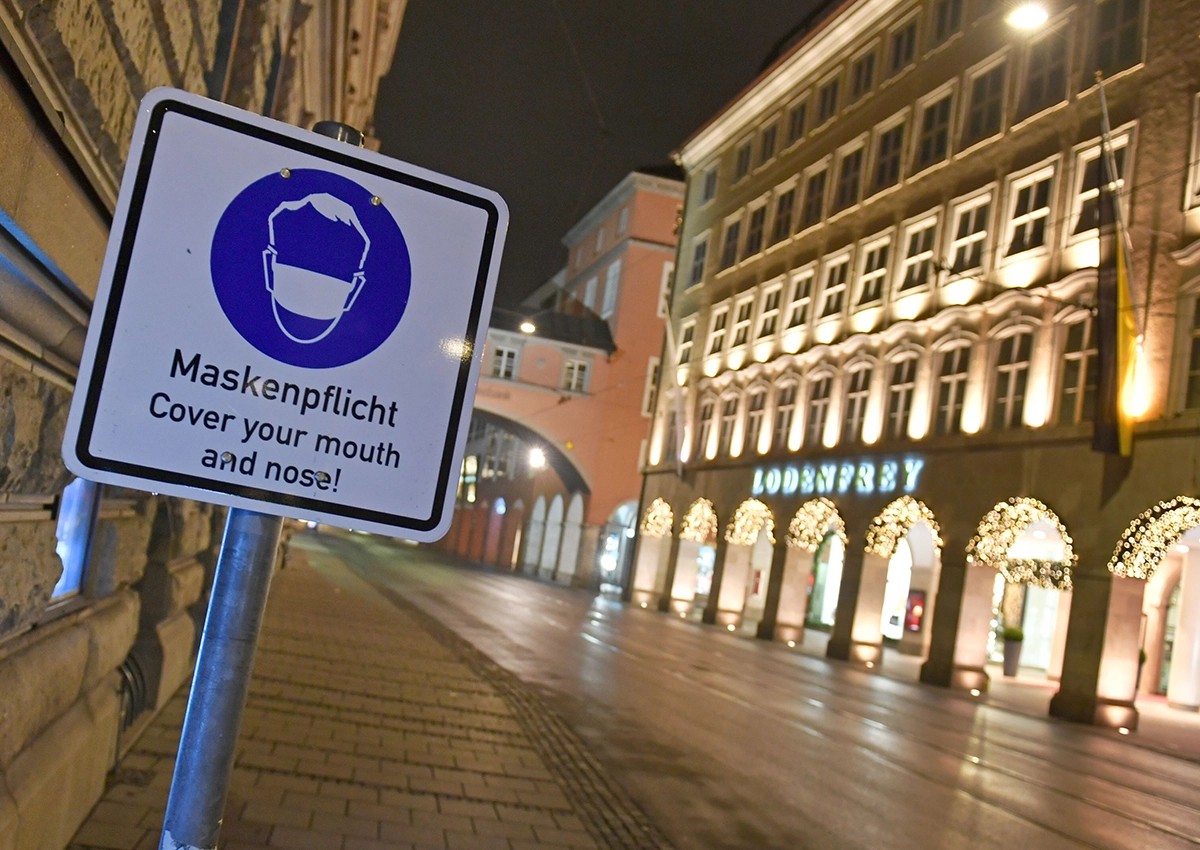
Exceptional Measures
A total of 13 researchers from various disciplines – including the virologist Melanie Brinkmann, the sociologist Heinz Bude, the internist Michael Hallek, the political scientists Maximilian Mayer and Elvira Rosert, the physicists Michael Meyer-Hermann and Matthias Schneider, and the economists Clemens Fuest and Andreas Peichl – published a joint paper on combating the pandemic in January 2021. Their main goal was to significantly reduce infections while maintaining industrial production and enabling local openings through extensive testing. The plans likewise included a testing, contact tracing and isolation strategy as well as local outbreak management. Phases necessitating rigorous measures would repeatedly be superseded by one where an easing of them was allowed. The strategy was envisaged as an infection prevention concept for the whole European Union.
Economy under Pressure
German industry in particular suffered heavy losses during the first coronavirus wave in spring 2020. That was due to the lockdowns and company closures, but also to impediments to international trade and the growing recession in countries that were important trading partners. For instance, German goods exports dropped by almost 33 percent in March and April 2020, while industrial production fell by around 25 percent.
Sectors of the economy that relied on personal contact with customers experienced a rapid slump. The ones mainly hit were brick-and-mortar retail, hospitality, arts and entertainment, and service businesses such as hairdressing salons and beauty studios. In 2020, around 3.3 million people were employed in brick-and-mortar retail, 2.4 million in hospitality, 1.3 million in arts and culture, and 0.3 million in the social service sector.
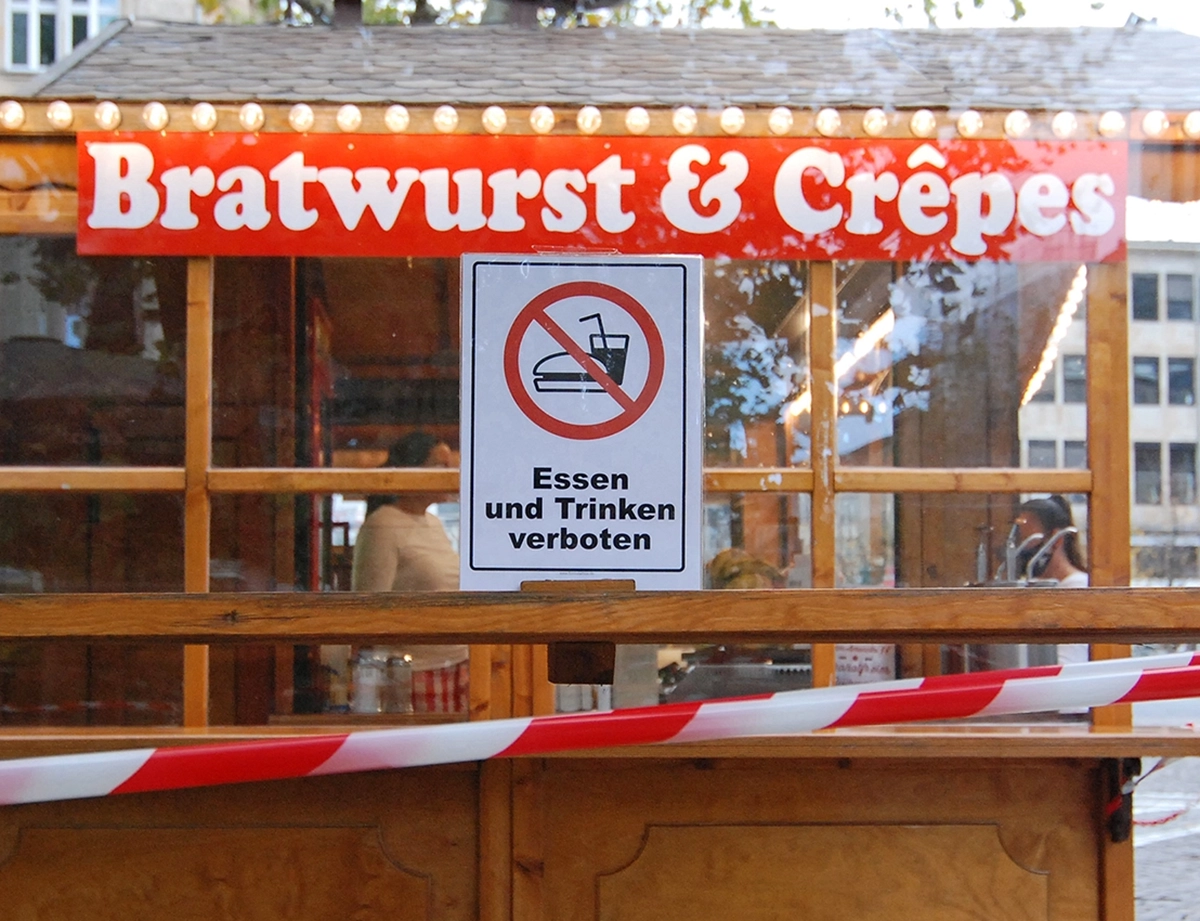
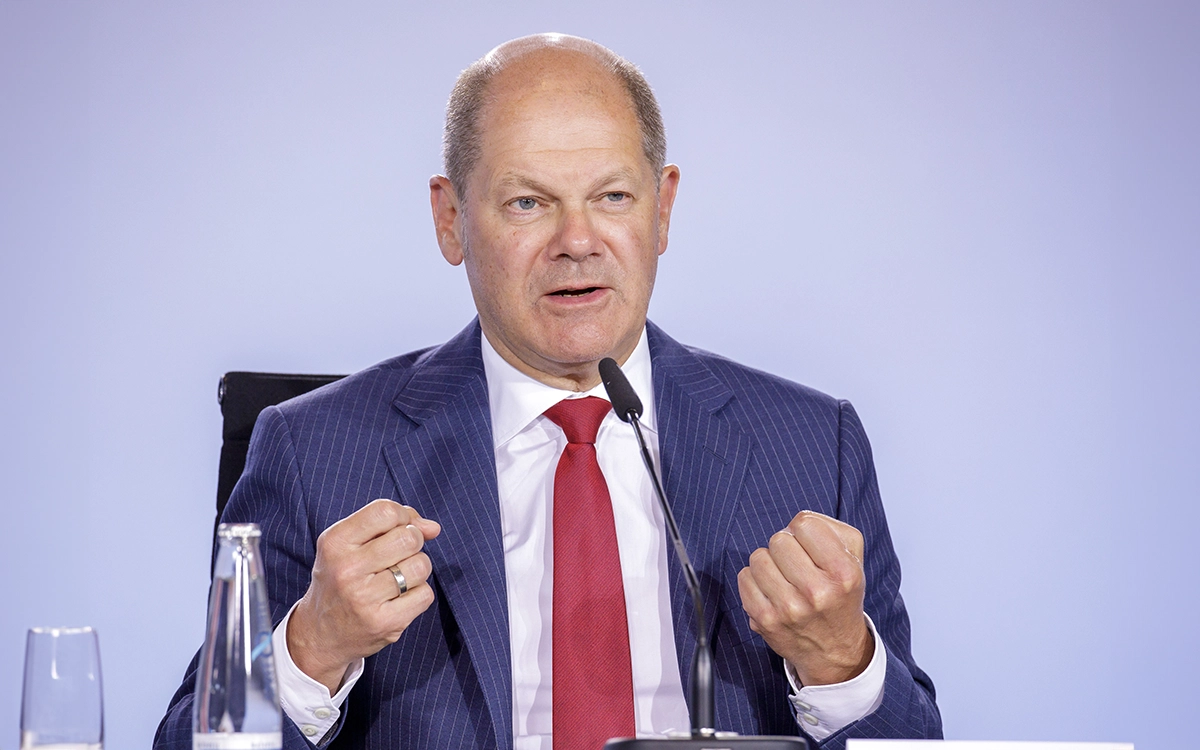
Government Aid in Germany
In view of these dramatic developments, the German government adopted comprehensive aid packages. For example, the income lost by the unprecedented figure of 10.2 million short-time workers reported by the end of April 2020 was cushioned by compensation payments. The support measures for companies were able to prevent the anticipated wave of insolvencies. In contrast to the temporary and targeted aid measures, the EUR 130 billion economic stimulus package, which Finance Minister Olaf Scholz termed “Ka-Boom” when it was passed on June 3, aimed to boost future economic growth and innovations so as to ensure competitiveness.
Pupils without School
The coronavirus crisis posed particular challenges for the education system. Surveys by the ifo Institute came to the conclusion that school closures had halved the time in which pupils were able to engage with subject matter in lessons together. Remote learning was not able to plug that gap. Moreover, the lockdown meant children spent far more time on their smartphones and computers. If they were from educationally disadvantaged families, they were particularly handicapped because they had no one at home to help them learn. Germany also had a lot of catching up to do when it came to developing digital teaching methods. In the assessment of the ifo Center for the Economics of Education, the skills not acquired during the coronavirus pandemic may have repercussions and effects on future careers and reduce lifetime earnings by around 3 percent – with the foreseeable negative impact that would have on the entire German economy.
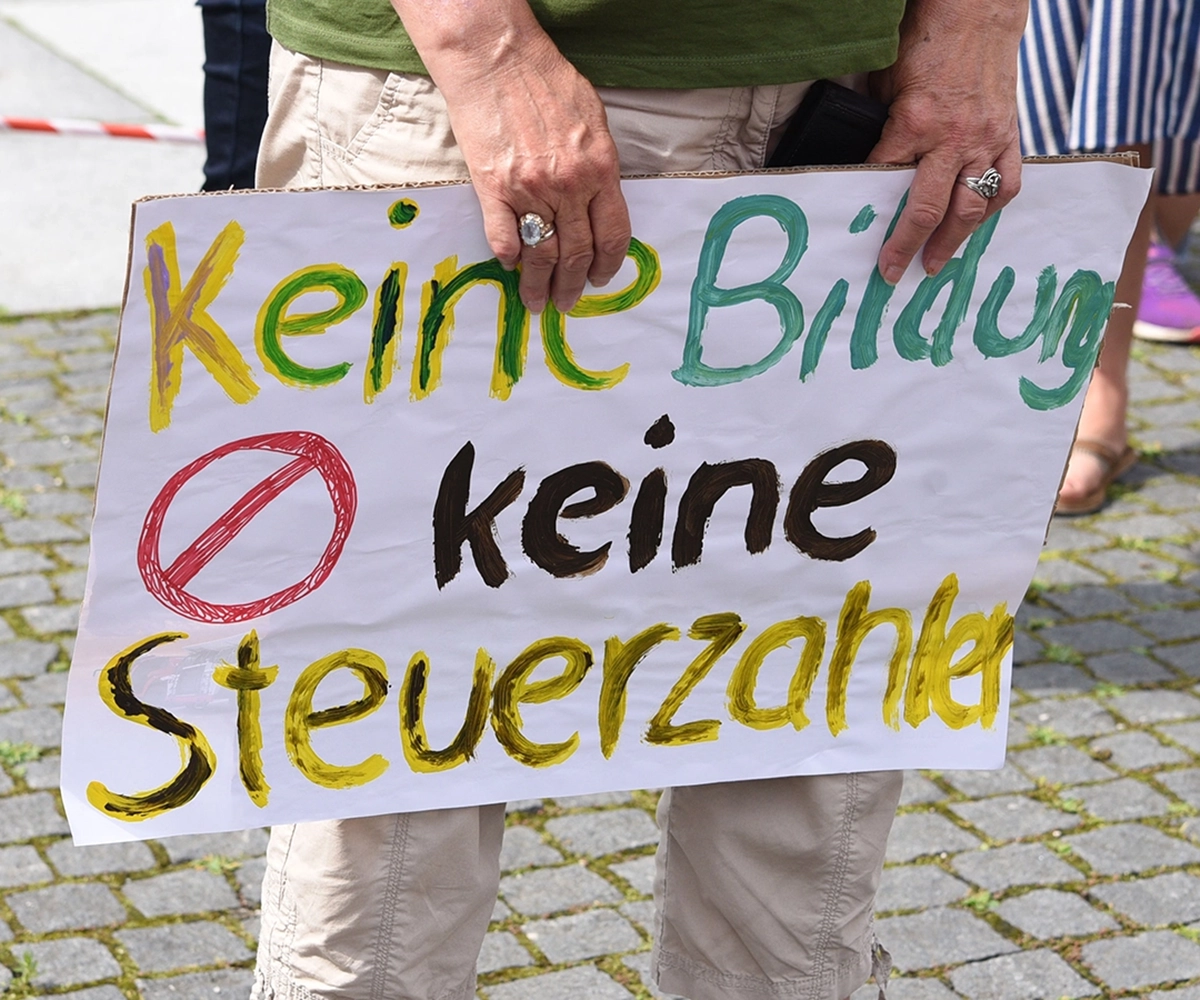
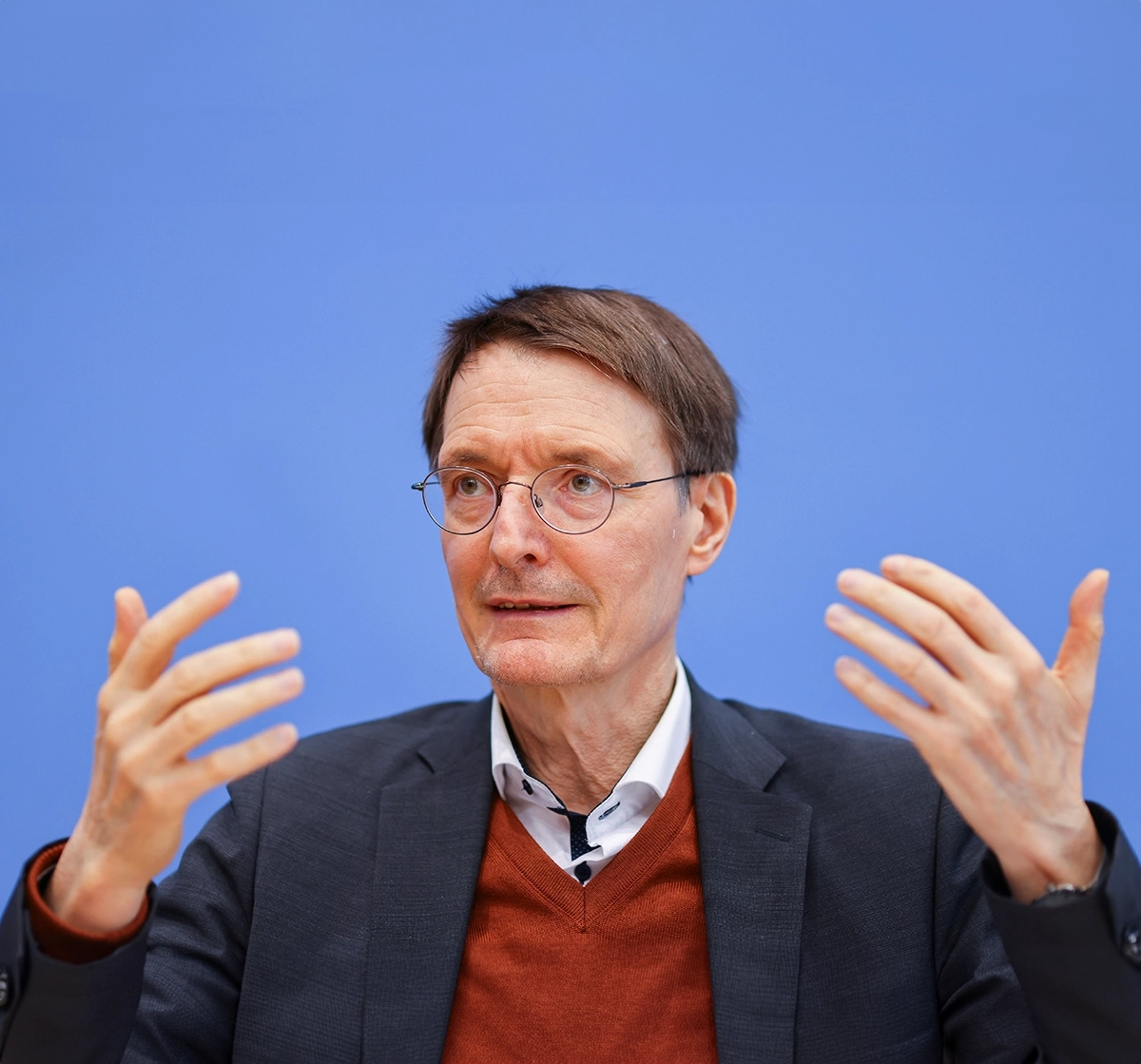
After the Crisis...
In April 2023, Minister of Health Karl Lauterbach announced the end of the coronavirus prevention measures, but the long-term consequences of the pandemic remain serious. According to WHO estimates, six to ten million people fell victim to it, while 65 million suffered or are still suffering from long COVID. The trend toward working from home has presented many companies with the challenge of pressing ahead even more resolutely with digitalizing their work processes. Everyday office life and interaction as part of work have to be redefined. Vacant office buildings and the upswing in e-commerce are changing the demands on urban infrastructure.
In many areas, however, the crisis was also seen as an opportunity to instigate important structural changes that would unleash new growth potential. Development prospects in all areas, from ecological restructuring of the economy to expansion of the European single market, meant researchers were hopeful that there would be a rapid economic recovery and a consolidation of public finances. However, these hopes were dashed when Russian troops invaded Ukraine on February 24, 2022.
Milestone
Data Art: Patrick Doan’s “FlowStates” in the ifo Institute
Data expertise meets art. The ifo Institute presents 75 years of expertise with economic data – its collection, analysis and interpretation – in the shape of the data artwork “FlowStates.” And it shows innovative ways of using this expertise to build bridges to society. The result? Forms, seemingly organic, in motion, constantly forming new patterns, flow in time with real data updates across a huge screen in the foyer of ifo’s main building.
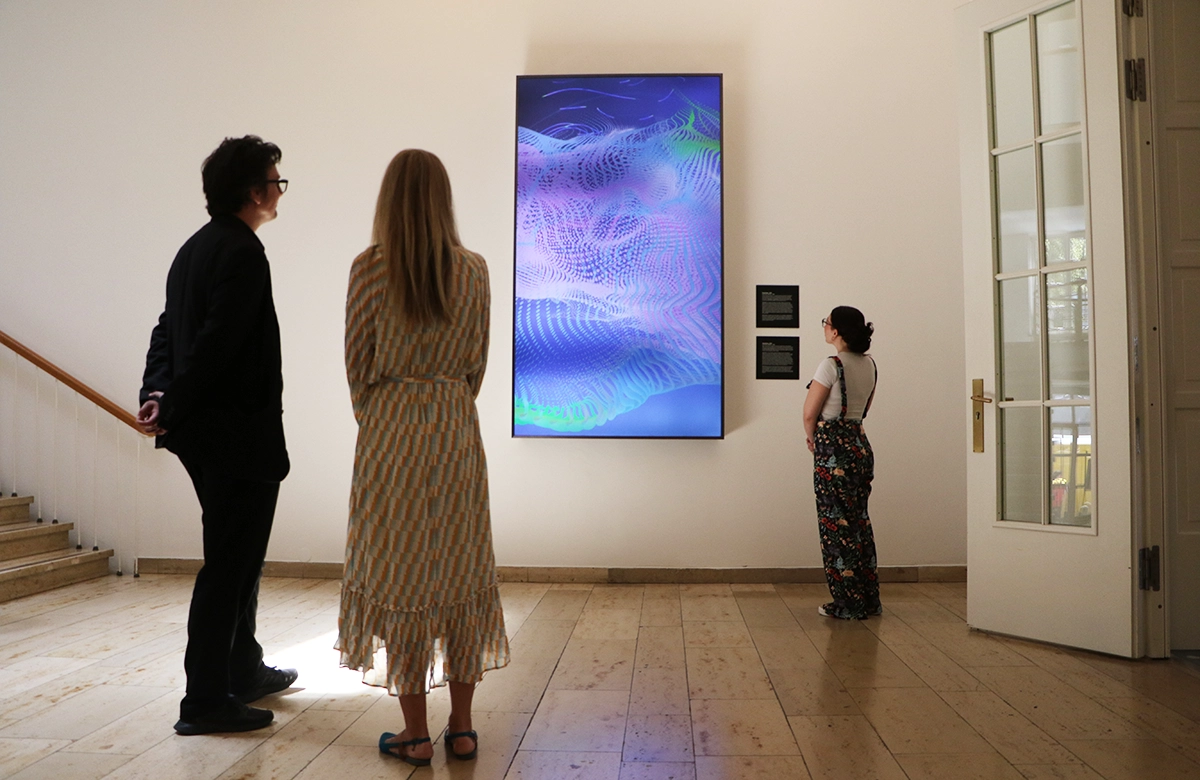

The Beauty of Data
Colorful, but discreet, always in motion, seemingly without a beginning or an end – that is how data streams in the guise of abstract visual organisms currently move across the monitor at Poschingerstrasse 5. It is certainly not an everyday sight at the ifo Institute, where economic data tends to be cast in mathematical models and presented in tables, Excel charts, and text. And yet the “FlowStates” installation carries ifo’s DNA within it: It consists of six fixed data series of the ifo Business Climate Index, which are continuously updated and interwoven with data from Eurostat, such as figures on international trade on the European market or production volumes in the construction industry. An algorithm converts the data streams into forms that are presented in a random temporal sequence, determined by a day and night cycle. The result is an interplay between the real flow of data and the corresponding visual translation into movement, form, speed, or color.
“FlowStates” and the ifo Institute
Art is open to the processing of data – and the ifo Institute is open to art. “FlowStates” symbolizes the constant, dynamic change in our economy and society, just as ifo’s research takes up current trends in the economy and society, evaluates them and proposes new options in response. The locally created artwork has an impact, transcends geographical and disciplinary boundaries, and reaches an international audience through digital distribution – just like the Institute’s scientific findings. “FlowStates” underscores the Institute’s commitment to the future of economic research with big data.
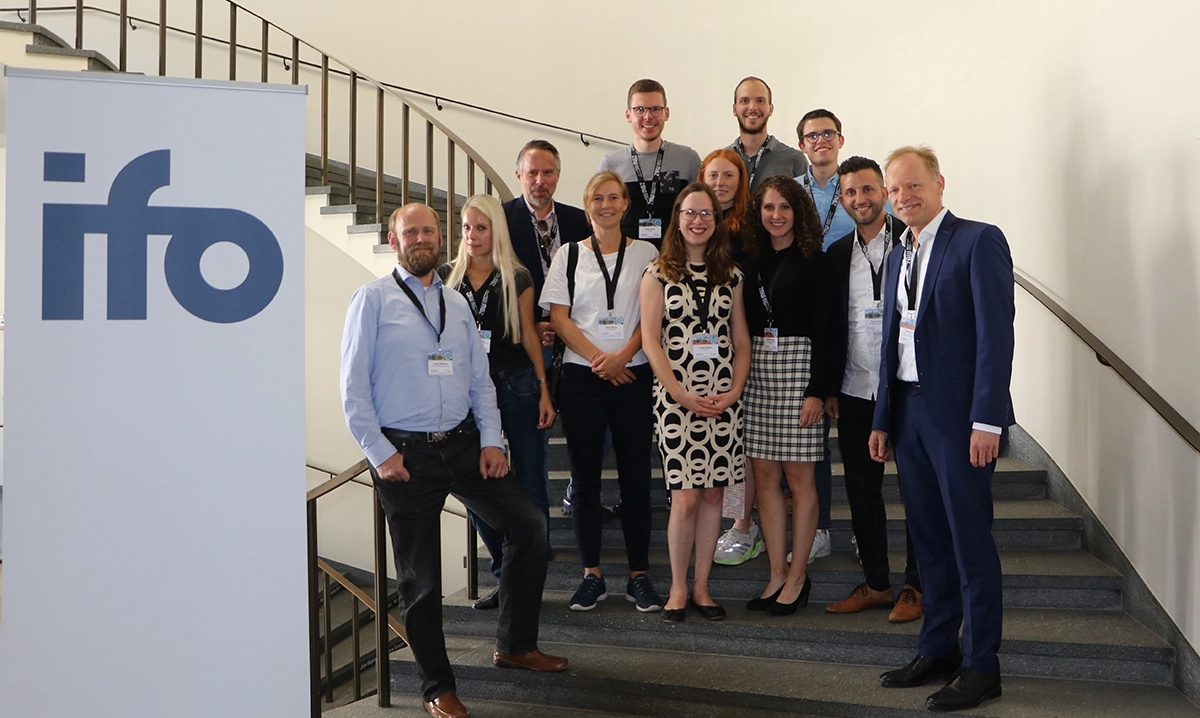
For information about the artist, check out the story “The Creator of the ifo Data Painting”.
You can go to the artwork here:
Publications
Elinor Ostrom: A Legacy of Community and Sustainability
Elinor Ostrom (1933-2012), a professor of economics at Indiana University, Bloomington, USA, alongside her husband Vincent Ostrom, was instrumental in founding the so-called Bloomington School. Her work focused on bridging the gap between state and market forces, advocating for efficient, hybrid governance systems. Ostrom championed the principles of self-organization, steering away from centralized state control. The “Elinor Ostrom Villa” at the ifo Institute, adjacent to the main building at Poschingerstrasse 5, honors her Nobel-winning legacy.
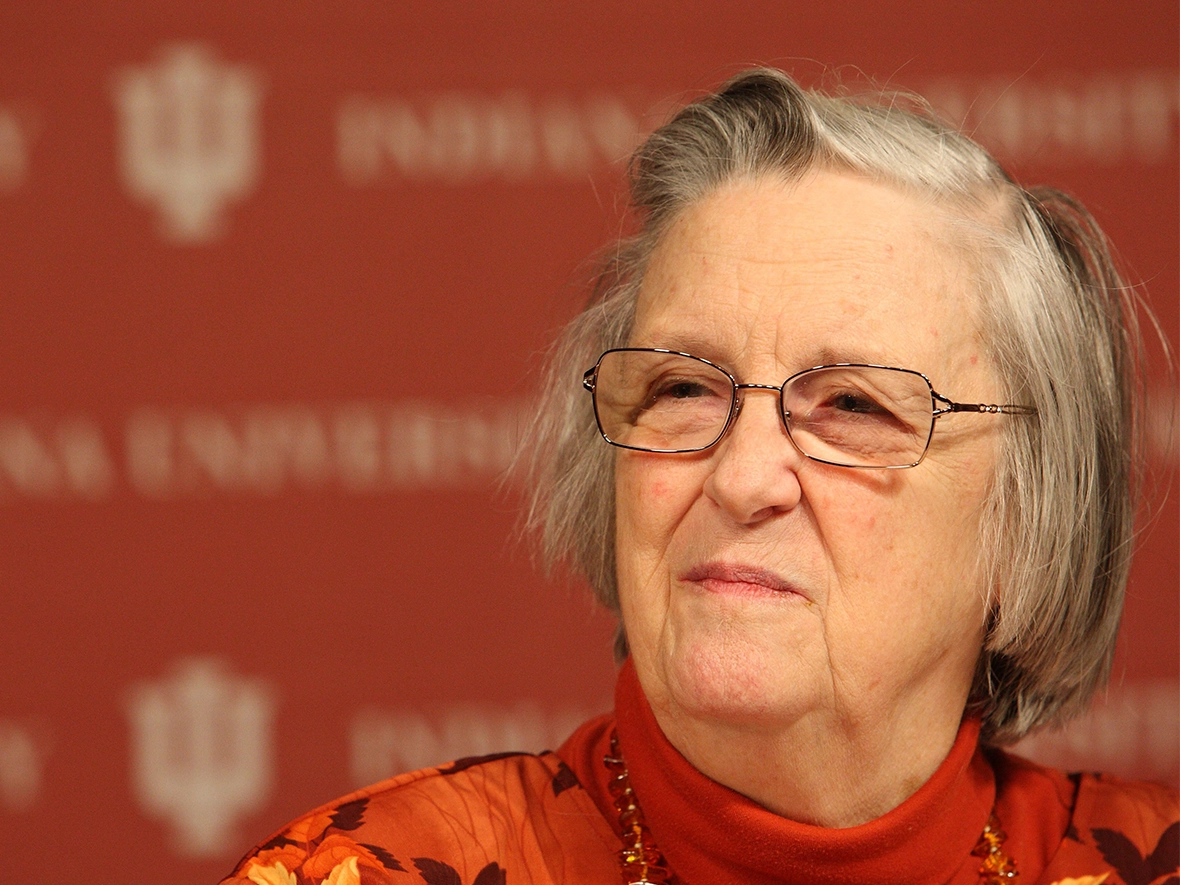
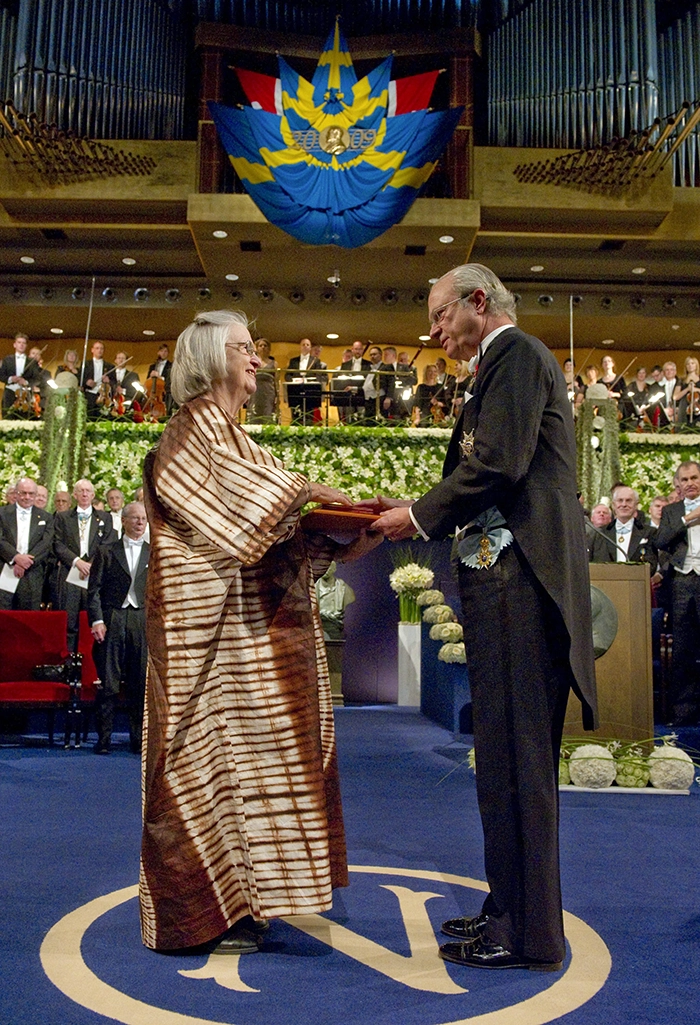
Recognition of a Trailblazer: The Nobel Prize
In 2009, Elinor Ostrom broke new ground by becoming the first woman awarded the Alfred Nobel Memorial Prize in Economic Sciences. The Royal Swedish Academy of Sciences lauded her for demonstrating “how common property can be successfully managed by user organizations.” Her path to this pinnacle was fraught with challenges. Initially, when she secured her first scholarship at the University of California, Los Angeles, in 1960, there was skepticism from faculty members who considered it a “waste of scarce resources” to invest in a woman who, they believed, was unlikely to ascend to a professorship.
Such skepticism was proven unfounded as Ostrom’s career unfolded, marked by significant contributions to environmental economics and the study of commons. According to the Nobel Committee, she explored how communities often devise sophisticated decision-making and enforcement mechanisms to avert “imminent conflicts of interest” in managing shared resources, effectively sidestepping the need for dominant state or market interventions.
Her research was concerned with the question of how people organise themselves in order to tackle complex tasks together. She analysed how the rules of institutions affect the actions of individuals who are exposed to certain incentives and have to make decisions. And she presented comprehensive solutions to these challenges.
Sustainable Self-Organization
Ostrom gained international recognition with her seminal work, “Governing the Commons: The Evolution of Institutions for Collective Action” (1990), where she argued that local cooperation, rather than state administration or privatization, often leads to the most sustainable management of commons. Through her global research, Ostrom identified successful and unsuccessful instances of community-based resource management, formulating the “Design Principles” for effective governance. These principles stress the importance of clearly defined boundaries for resource use, collective decision-making processes, and accessible, direct conflict resolution methods.


Wisely Managing Common Resources
The challenge of resource depletion, such as overfishing in oceans, deforestation, and the exhaustion of natural resources, raises the question: Is this inevitable? Advocates of centralized resource management often cite the “tragedy of the commons” to justify their approach. This concept, introduced by U.S. microbiologist and ecologist Garrett Hardin in his 1968 essay, paints a grim picture of communal resource exploitation. He uses a vivid image: a pasture open to all, where each herd owner, motivated by profit, increases their sheep count, leading to overgrazing and eventual ruin. According to Hardin, unrestricted access to limited resources invariably results in their overexploitation, concluding that “Freedom in the commons brings ruin to all concerned.” But Elinor Ostrom’s research uncovered that privatization or centralized government control are not the only paths to preventing resource depletion, highlighting the potential for local communities and resources.
Innovations Beyond Market and State
The assumption that the market is the sole mechanism for managing private goods, and that centralized control is necessary to curb selfish behavior in the management of public goods, is challenged by Elinor Ostrom’s extensive body of work. Her database at the Center for the Study of Institutional Diversity in Tempe, Arizona, contains over 1,000 case studies on the shared use of scarce resources, showcasing a vast array of instances where individuals cooperatively manage resources in environmentally sustainable ways.
One of her earliest field studies in the 1970s focused on groundwater management in Southern California, an area facing the critical challenge of dwindling groundwater reserves amid a growing population. Through her investigation, Ostrom encountered a variety of structures and flexible networks that local municipalities had developed to regulate groundwater extraction. This study uncovered that that the communities in small and medium-sized towns, through necessity, had formed governance structures more adept at addressing the challenges of water management than larger, centralized state institutions.


Learning from Lobster Fishermen in Maine
In the 1920s, the lobster populations off the coast of Maine faced near extinction due to overfishing. This crisis prompted the local fishermen to take innovative steps towards self-organization to preserve their livelihoods and the lobster stocks. They instituted a series of creative rules aimed at sustaining the lobster population. One notable measure was the tagging of pregnant female lobsters before releasing them back into the ocean, ensuring they could continue to contribute to the reproductive cycle. A trader who offered an animal with a tag at a market was ostracized by fishermen and buyers alike. This practice discouraged fishermen from catching these crucial contributors to the lobster population’s regeneration.
This example from Maine and other cases are a testament to Elinor Ostrom’s assertion that complexity in managing common resources does not inevitably lead to chaos. Instead, it shows how localized, community-based approaches can yield sustainable solutions, ensuring the long-term viability of shared resources.
People
Ernst Helmstädter: Economist and Artist
The vibrant screen prints by Ernst Helmstädter (1924–2018) are a striking feature in the corridors of the ifo Institute. These works were acquired in the 1980s by Karl Heinrich Oppenländer for the ifo, forming a unique connection between economics and fine art. In parallel to his academic career, Helmstädter engaged deeply with aesthetic theories, discovering surprising parallels along the way.


A Distinguished Career in Economics
Born in Mannheim in 1924, Ernst Helmstädter studied economics and sociology at the University of Heidelberg, where he earned his doctorate in 1956. After working at the Federal Ministry of Finance and the Federal Office for Economics and Export Control, he became a research assistant at the University of Bonn in 1961, where he later earned his habilitation in 1965. In 1969, Helmstädter was appointed Professor of Economics at the University of Münster, where he led the Institute for Industrial Economics Research and the Research Center for General and Textile Market Economics. Throughout his career, he was active in academic administration and cultural promotion, leading the Senate Committee for Art and Culture in Münster for nearly a decade after his retirement in 1989. Renowned for his research in growth and structural economics as well as distribution theory, Helmstädter authored numerous publications, notably his two-volume textbook “Economic Theory.” He also served on the German Council of Economic Experts from 1983 to 1987.
Helmstädter’s Exploration of Op Art
Op Art, short for Optical Art, is an artistic movement that avoids symbolic meanings and narrative content, instead relying solely on form, color, and structure to create its effects. Through geometric shapes and bold contrasts, it generates illusions of three-dimensionality, movement, and vibration. Artists in the Op Art movement applied the latest theoretical insights and technologies, adhered to strict compositional rules, and saw their work as an aesthetic contribution to the theory of perception.
The 1965 exhibition “The Responsive Eye” at the Museum of Modern Art (MoMA) in New York marked the beginning of Op Art’s broader recognition. Curated by William C. Seitz, the exhibition featured works by artists such as Victor Vasarely, Bridget Riley, and Richard Anuszkiewicz, bringing Op Art principles to a wider audience and establishing the movement as a significant part of modern art.
A pivotal moment in Helmstädter’s artistic development occurred during his 1969 research stay at Harvard University. Here, he deepened his engagement with fine art, particularly with the works of Op Art, which was especially popular in New York at the time. In addition to the works of Victor Vasarely and Bridget Riley, Helmstädter was especially influenced by the art of Josef Albers, a key figure in the Op Art movement.


Artistic Career
Helmstädter’s artwork plays with viewer perception, using complex patterns and structures to create dynamic visual effects that appear to move and change. His works reflect an ambivalence in the perception of images, a concept central to both his artistic and economic thinking. To bring his visual concepts to life, he preferred techniques such as carefully crafted collages and screen printing. His artistic creations have been featured in exhibitions in cities like New York, Montreal, and Vienna.
Bridging Art and Economics
The dynamic effects central to Op Art also resonate with Helmstädter’s economic research. Just as Op Art simulates movement and transformation through visual illusions, his economic studies focused on dynamic processes in growth, structural economics, and distribution theory. He often emphasized the inherent ambiguity in interpreting data, a theme explored in perception theory at the time, which found parallels in Op Art compositions. This overlap between art and economics inspired Helmstädter’s own creative works.

People
Exploring Dual Leadership: Podcast with Stephanie Dittmer and Clemens Fuest
Can two heads lead better than one? Stephanie Dittmer and Clemens Fuest, co-leaders of the ifo Institute, embody this approach, balancing the scientific freedom and administrative necessities inherent in managing a renowned research institute. Their leadership style, characterized by shared responsibilities, not only fosters a culture of collaboration but also integrates the nuances of managing such dynamic tensions within their organizational framework.
In the realm of research, maintaining independence from political and societal influences while delivering top-notch research poses significant challenges. How does ifo navigate these waters, and what metrics are effective for guiding staff performance?
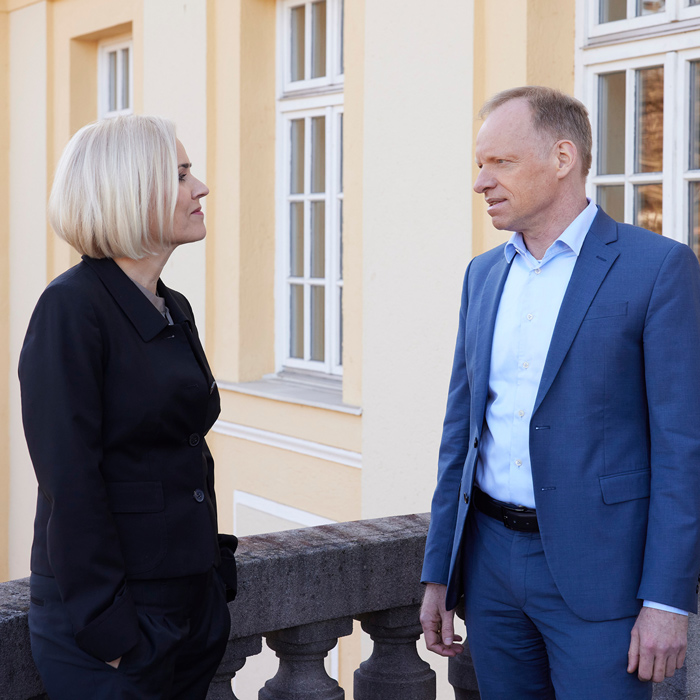
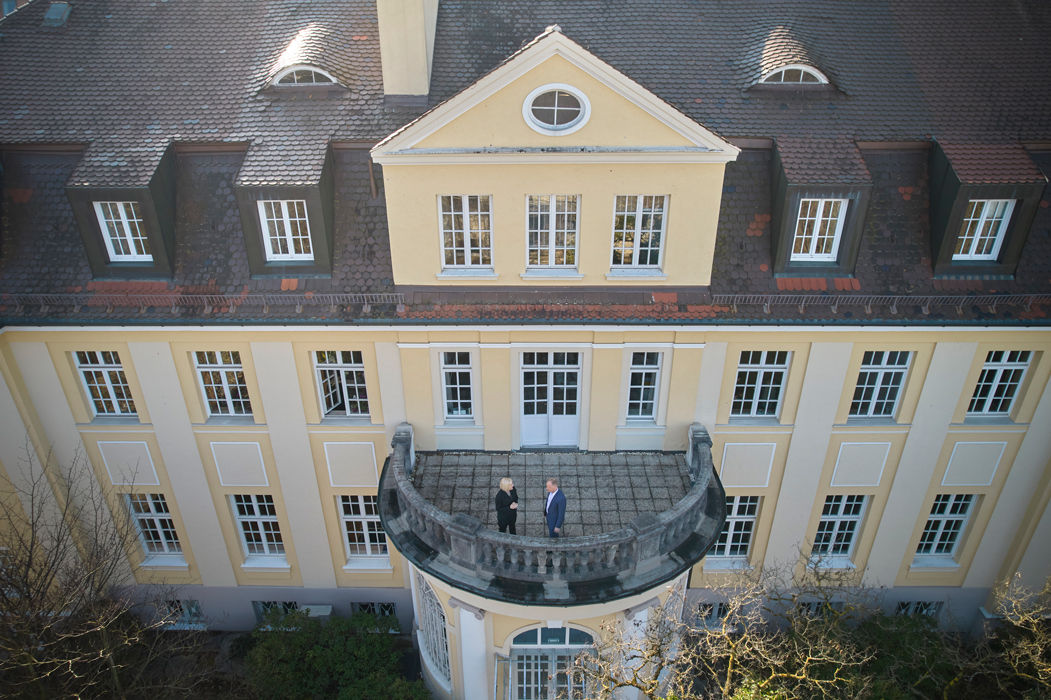
Tania Lieckweg, a consultant specializing in strategy development, leadership, and organizational growth, sheds light on the efficacy of dual leadership. She highlights the importance of embracing dissent, aligning under a unified strategy, and prioritizing more than just output metrics to ensure leadership success.
This insightful discussion is available in a podcast as part of the series "Die Zukunftsmacher*innen" (The Future Makers) produced by osb international systematic consulting, first released as a "Science Special" in December 2023 (German only).
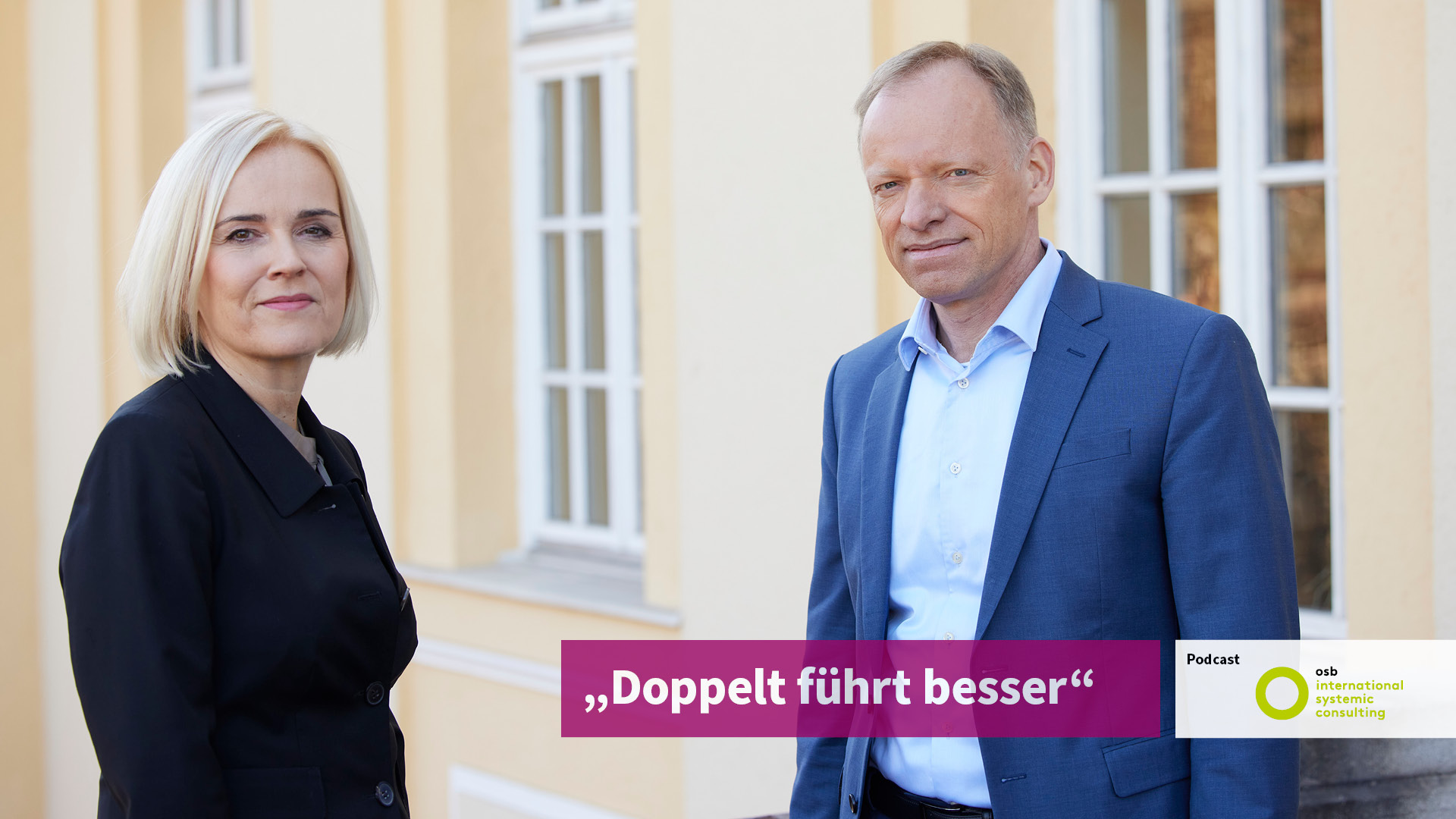
Impulse
From the White House to the ifo Institute: David Bradford
“David Bradford worked tirelessly and enthusiastically for the ifo Institute. His impartial judgment, wisdom and friendship were a great help.” This is what the ifo Institute wrote in its obituary about the American economist and political advisor David Bradford, who was one of the most important chairmen of the ifo Institute’s Scientific Advisory Council. Bradford died in 2005 at the age of 66. In his honor, the ifo Institute’s main building in Munich was renamed the “David Bradford House” that same year.

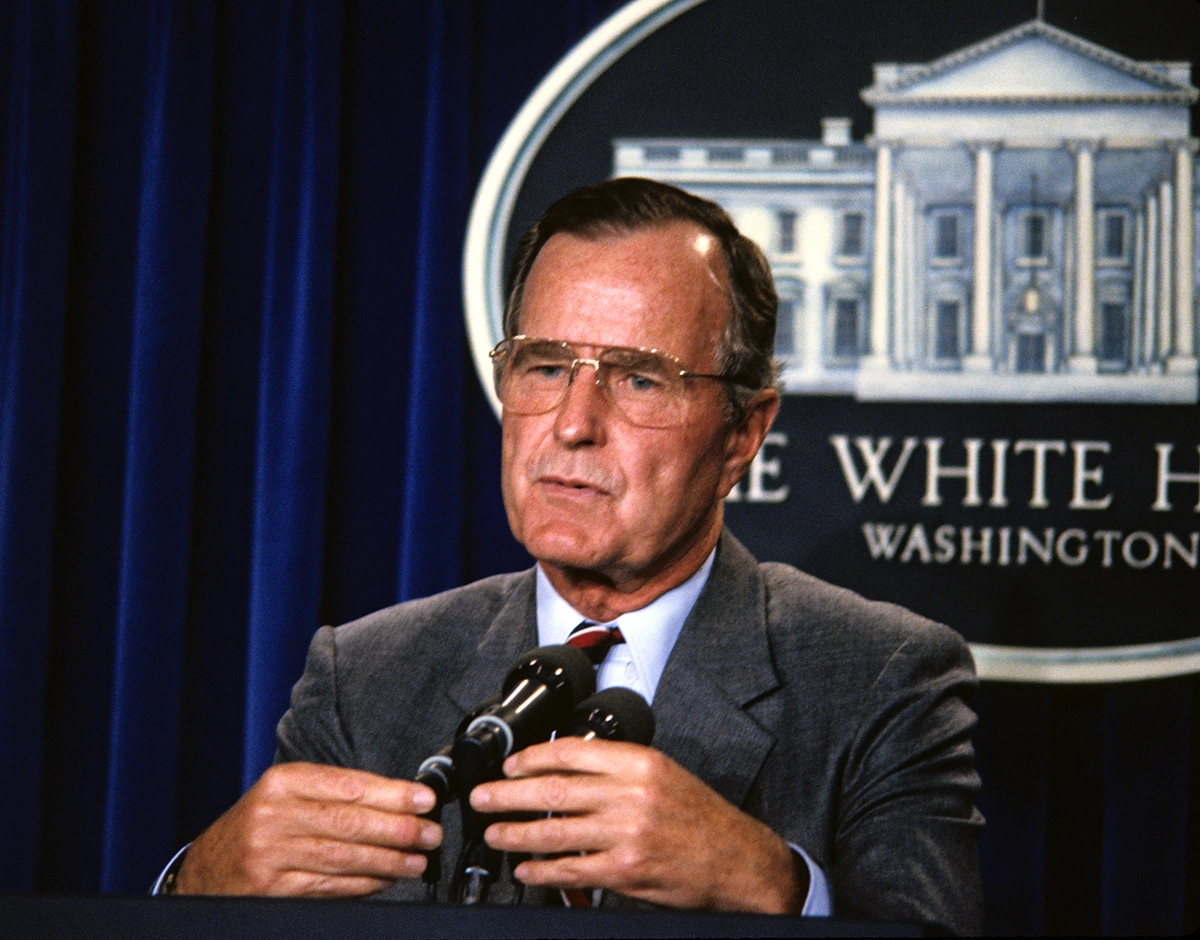
An Illustrious Academic and Political Career
David Bradford’s educational journey took him from Amherst College in Massachusetts, where he studied from 1956 to 1960, to advanced degrees at MIT, Harvard University, and ultimately a doctorate from Stanford in 1966. He served as a Professor of Economics and Public Affairs at Princeton, and from 1993 at the Law School of New York University. Known as a leading expert in US tax policy, Bradford also held significant roles in government. He was the Deputy Assistant Secretary for Tax Policy from 1975 to 1976 and played a pivotal role in President Ronald Reagan’s tax reforms during the 1980s. From 1991 to 1993, he served as a personal advisor to President George H. W. Bush.
Bradford’s academic contributions significantly shaped public debate on consumer taxation, public goods pricing, urban planning, and environmental policy. A staunch advocate of the 2005 Kyoto Protocol, he was deeply involved in global efforts to combat climate change.
A Quantum Leap in Tax Policy
David Bradford’s seminal work “Blueprints for Basic Tax Reform” laid the groundwork for the sweeping 1986 tax reforms under Reagan, which dramatically reduced the top tax rate from 70 percent to 28 percent, positioning it as the lowest among industrialized nations at that time. His book “Untangling the Income Tax,” published in the same year as the reforms, offered an exhaustive analysis of income tax variations and championed the idea of a consumption tax.
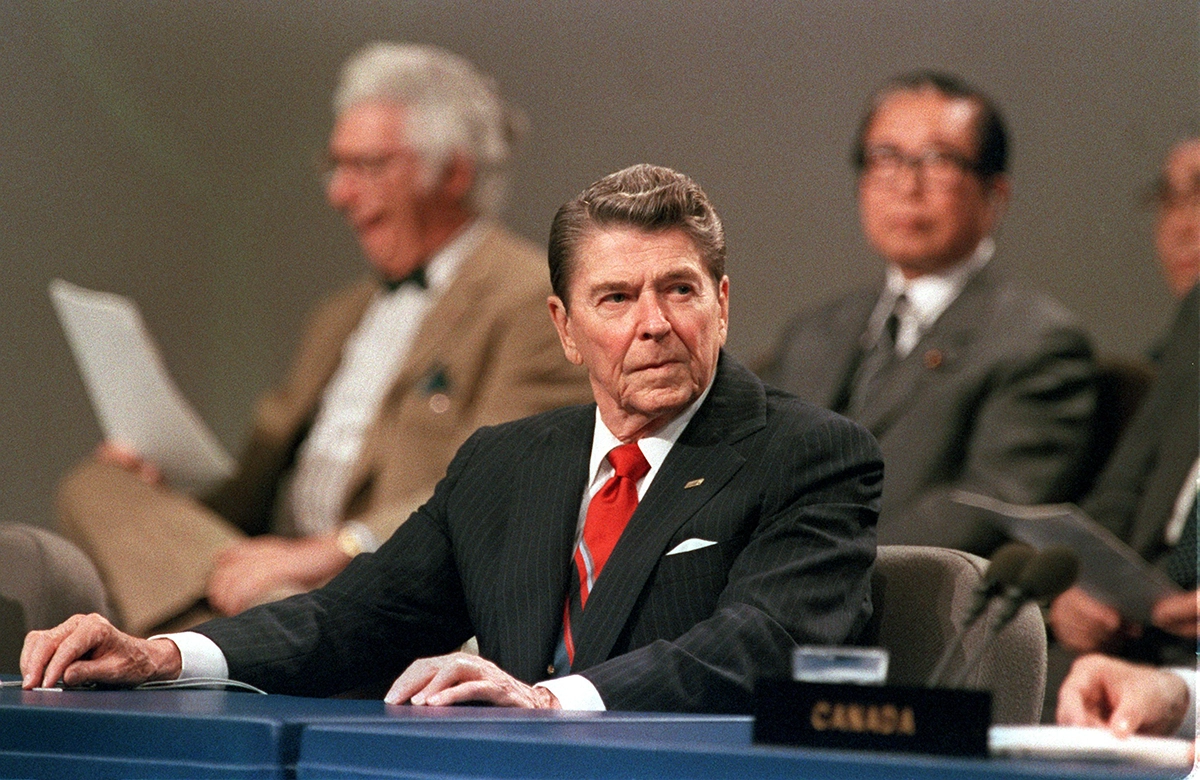
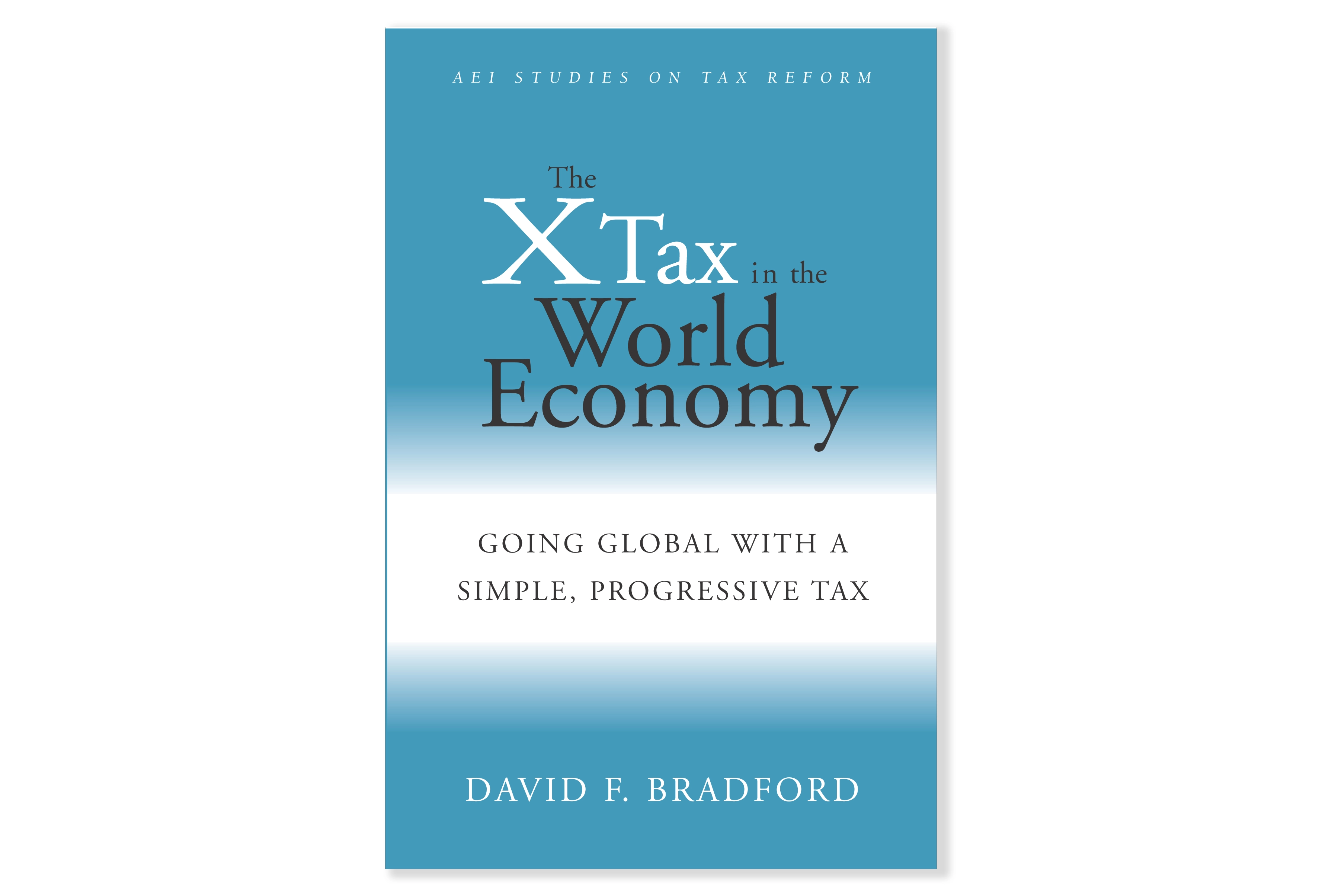
The “X-Tax” Concept
Bradford’s X-Tax proposal sought to simplify and make the tax system fairer through a dual approach: taxing companies after allowing deductions for investments and payroll, thereby incentivizing job creation and innovation; and imposing a progressive income tax on individuals after subtracting private savings and investments, thus facilitating long-term financial planning for families. His vision was to exempt profits from financial transactions from taxes, creating a more streamlined and equitable fiscal environment.
Guiding the ifo Institute’s New Direction
When Hans-Werner Sinn assumed leadership of the ifo Institute in 1999, he faced a period of uncertainty about its future. Under his leadership, the institute’s Scientific Advisory Council was reconstituted, bringing on board twelve new members including Nobel laureate Robert Solow from MIT and David Bradford from Princeton University. After their appointment in May 2000, Bradford was elected Chairman of the Council in September of the same year. Under Bradford’s chairmanship, the Advisory Council played a crucial role in redefining the ifo Institute’s scientific direction, significantly contributing to its ascent as a premier global economic research institution.
People
Hey Teacher – We Don’t Leave You Alone
School is an important place to acquire skills in the field of economics. Teachers are ambassadors: They have a significant influence on what students know and think about the economy. In times of fake news and an overabundance of information, the ifo Institute sees it as a central task to be a credible and reliable source of economic information for teachers and their students. To this end, we have a well-coordinated portfolio of offers, which we implement partly on our own and partly in cooperation with established partners. Partners are the Association of Bavarian Business Philologists (wpv) and the Dillingen Academy for Teacher Training and Personnel Management (ALP).

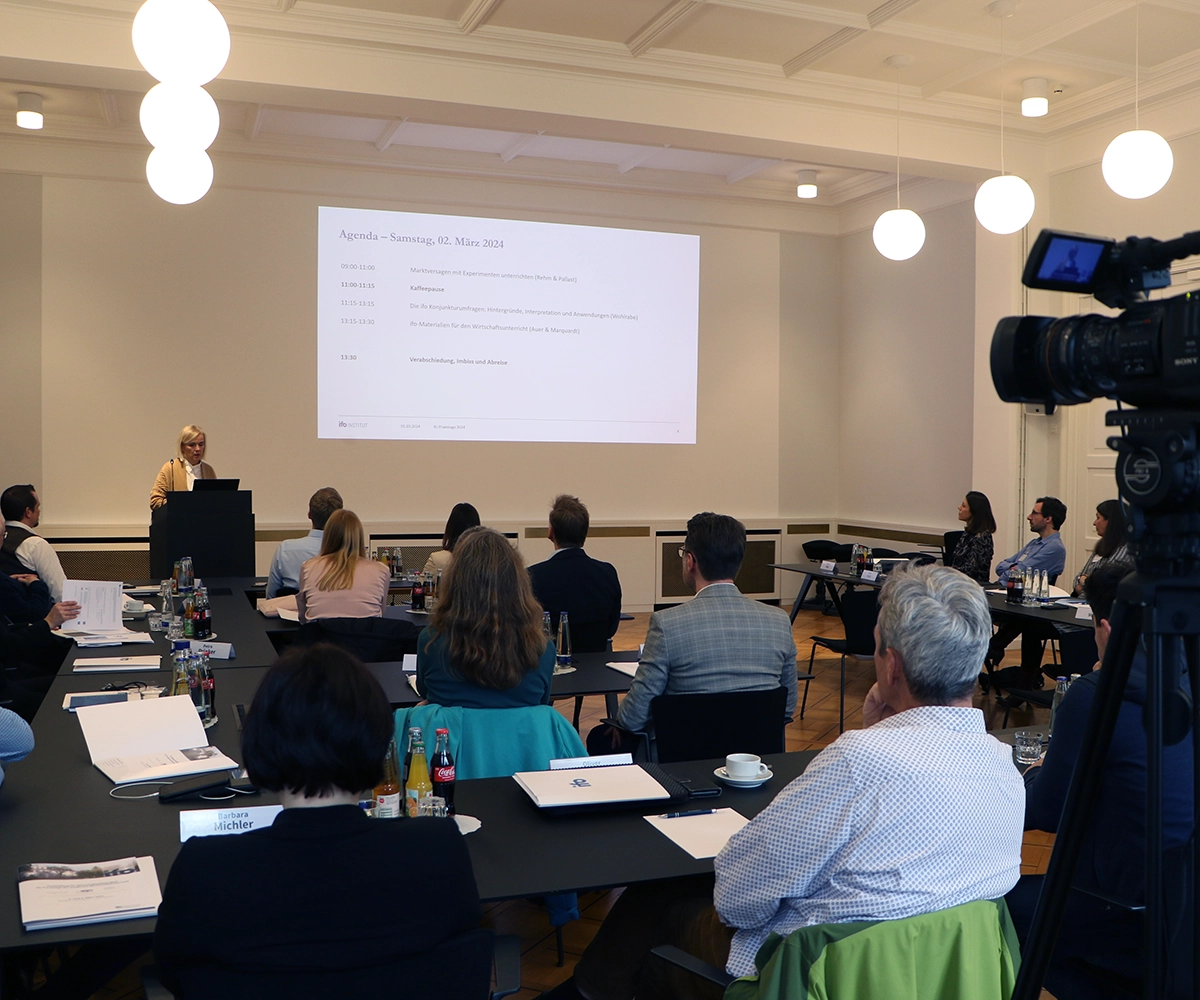
Bringing research into the classroom
The ifo Institute views teacher training and continuing education as a means of keeping business educators up to speed with information, preferably firsthand, on current research and debates. To this end, we launched the ifo Hands-On Modern Economics Teaching Days training series in 2018. It is aimed at economics teachers from Bavaria at general education and vocational schools. Since 2019, the Center for Economics Education in Siegen (ZöBiS) has been providing additional support for teaching the contents of this advanced training course, which is conducted in cooperation with the wpv.
Every spring, 25-30 teachers are guests at the ifo Institute for two days. ifo President Clemens Fuest presents a current economic policy topic to discuss with the teachers. ifo business surveys and economic forecasts are also a fixed part of the curricula. The presentations also take into account current developments, such as inflation.
Other contributions include foreign trade, energy, and taxes. At the same time, the needs of the teachers are also surveyed. One result of the needs survey was the introduction of our teacher newsletter, the ifo Klassenzimmer (classroom).
New impetus for teachers
The ifo Klassenzimmer newsletter provides teachers five times a year with current information grouped by topic for lesson preparation. It contains both opinion pieces by ifo experts and research articles on a specific topic and supplements these with data and editable graphics. Another special perk ifo offers teachers is a protected area on its website, where they can access all the newsletter content.
Since 2018, we have also been offering a training initiative together with the ALP that focuses on the practical implementation in classrooms of economic policy research results. For the annual event, the ifo Institute provides the specialist speakers, while ALP provides the premises and organization . The event is a useful addition to ifo’s own offerings as a way of reaching teachers in other parts of Bavaria.
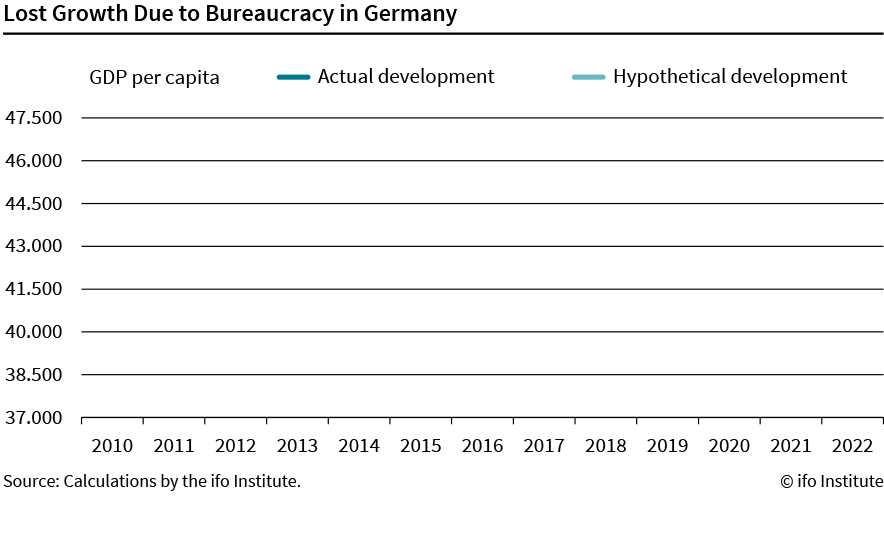
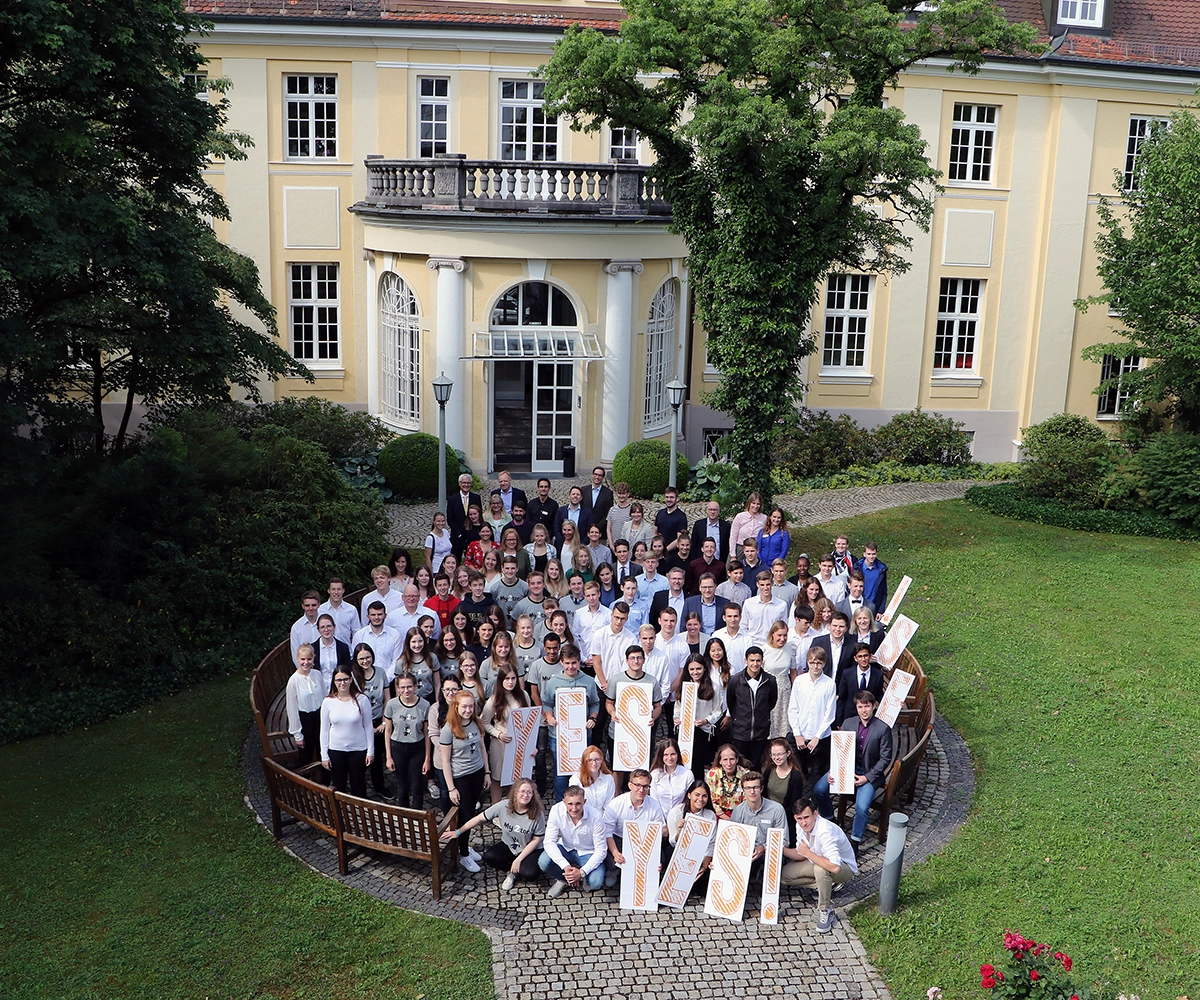
Economy as competition
Since the 2018/19 school year, our researchers and subject specialists have been involved in YES! (Young Economic Solutions). This national and now largest school competition on global challenges in the economy, society, politics, and the environment for grades 10+ is a joint project of the Leibniz Information Centre for Economics (ZBW) and the Joachim Herz Foundation under the patronage of the German Federal Ministry for Economic Affairs and Climate Action.
Our colleagues develop topics and introduce the school teams to scientific work. Every year in July, around 100 students come to the ifo Institute to present their ideas in the South-East regional final. On this day, the air crackles with the energy radiating from the various teams. Joy, ambition, fairness and a burning passion for their project – all of that unites the students. In addition to the valuable support provided by our specialists, the Executive Board also makes time for the students. This proximity to the students is an essential part of our work in the school sector. The ifo Institute sees itself and its team as approachable, reliable, and fact-based. And did you know that Clemens Fuest ended up in economics thanks to a stock market game? Neither did we, but he told the students that.
Veranstaltungen
ifo Annual Meeting: Social Market Economy 2049
On June 27, 2024, the ifo Institute's Annual General Meeting wasn't just a routine gathering; it was a celebration of the Institute's 75th anniversary. Held in the grand setting of Ludwig-Maximilians-Universität's Great Hall, the event was marked by reflections on the past and, more importantly, forward-looking discussions. Under the theme "Social Market Economy 2049: What will our prosperity look like, and who will share in it?" attendees delved into future challenges, potential scenarios, and strategies to ensure equitable benefits from the social market economy model.
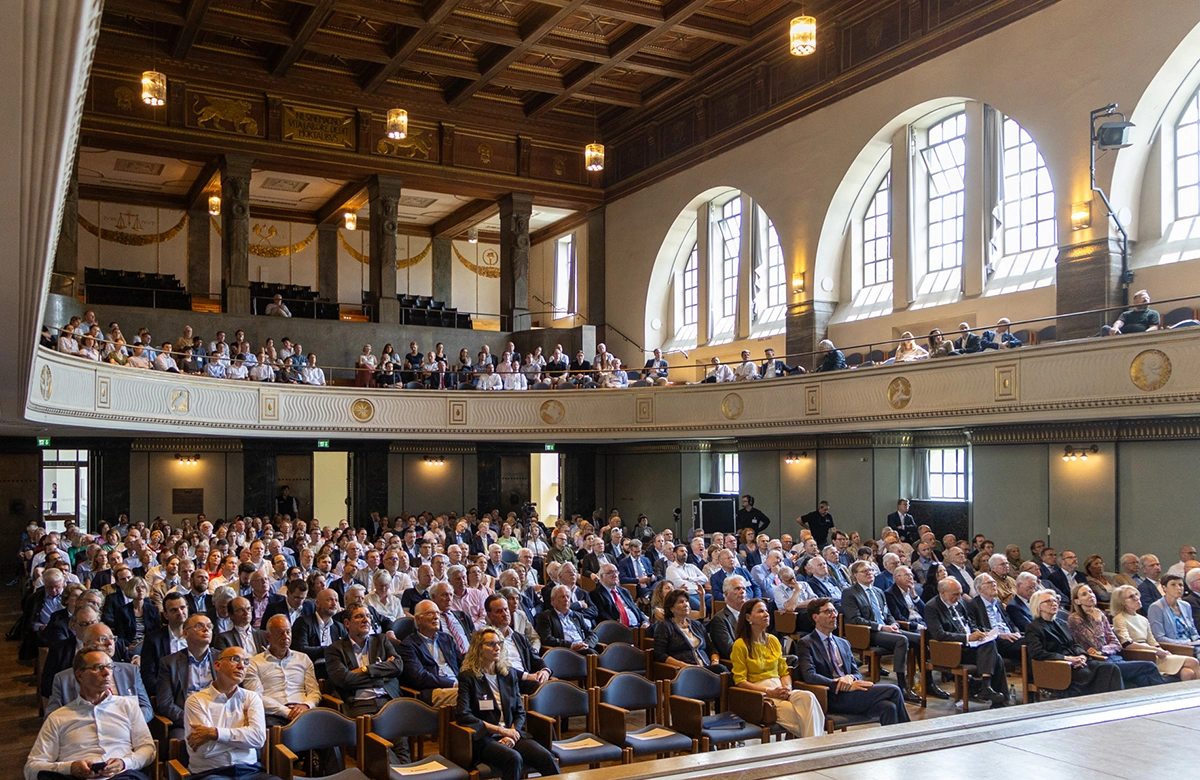

75 Years of Social Market Economy
Clemens Fuest, President of the ifo Institute, began by linking the social market economy to Ludwig Erhard, a pivotal figure in the institute’s founding 75 years ago. Erhard championed competition and market trust as central elements of this system, which enjoys wide support among the public and is credited with ensuring satisfactory prosperity levels. However, this economic model faces significant challenges, notably a labor shortage leading to declining production potential. Alarmingly, Germany records the lowest working hours per employee globally, not just due to high part-time employment but also a tax system that seldom rewards overtime. Additional challenges include the need for decarbonization, adapting to climate change impacts, navigating foreign trade frictions, and catching up on digital and public infrastructure.
Between Cutting-Edge Research and Practice
Christian Lindner, former Federal Minister of Finance, highlighted in his opening remarks that Germany’s Basic Law, also marking its 75th anniversary, laid the groundwork for today’s decentralized economic order, safeguarding private property. Today’s economic system, shaped by the social market economy, emerged from this foundation. Current debates over high subsidies for climate transition and climate-friendly technologies suggest a deviation from the social market economy’s principles, which demand clear stability policies, especially in fiscal decisions.
A shift from prescribed and selective support policies to the inherent decentralism of the social market economy is crucial. Lindner stressed that individual creativity and competition foster progress, contingent upon improved conditions for all economic actors and a shift towards personal responsibility and entrepreneurial risk-taking.


Responding Flexibly to Current Problems
Simone Bagel-Trah, Chairwoman of the Supervisory Board and Shareholders' Committee of Henkel AG & Co., argued that companies must individually address current economic issues without awaiting political directives, requiring long-term planning security for investments. Additionally, enhancing the attractiveness of workplaces through flexible working models and further training is crucial.
Annette Niederfranke, former State Secretary and Director of the International Labour Organization (ILO)/Germany, emphasized the need for early investments in education and workforce inclusion, particularly supporting women with reliable childcare solutions to encourage workforce participation.
Structural Change is Unavoidable
Monika Schnitzer, Chairwoman of the German Council of Economic Experts, acknowledged the inevitability of structural change, urging clear communication from politicians about chosen paths, such as the implementation of CO2 levies. She advocated for a moderate debt approach over a restrictive debt brake, emphasizing the need for a clear roadmap and enforceable rules to prevent fiscal excesses.
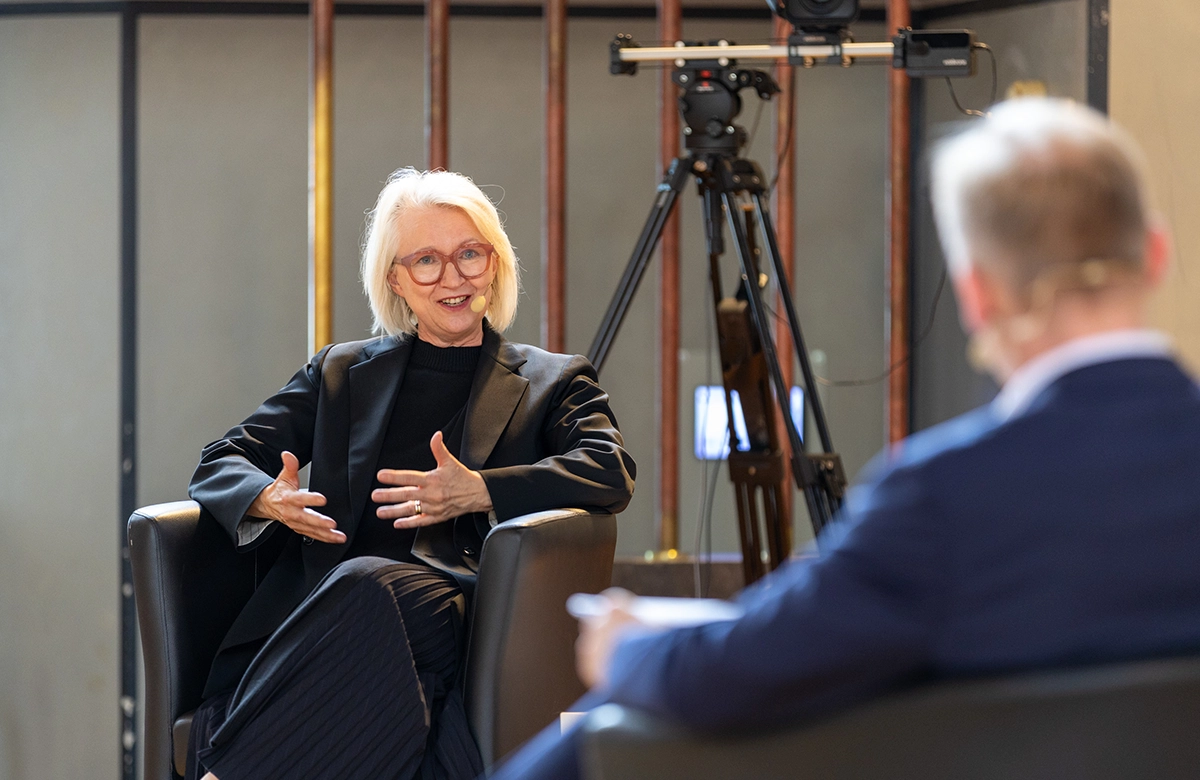
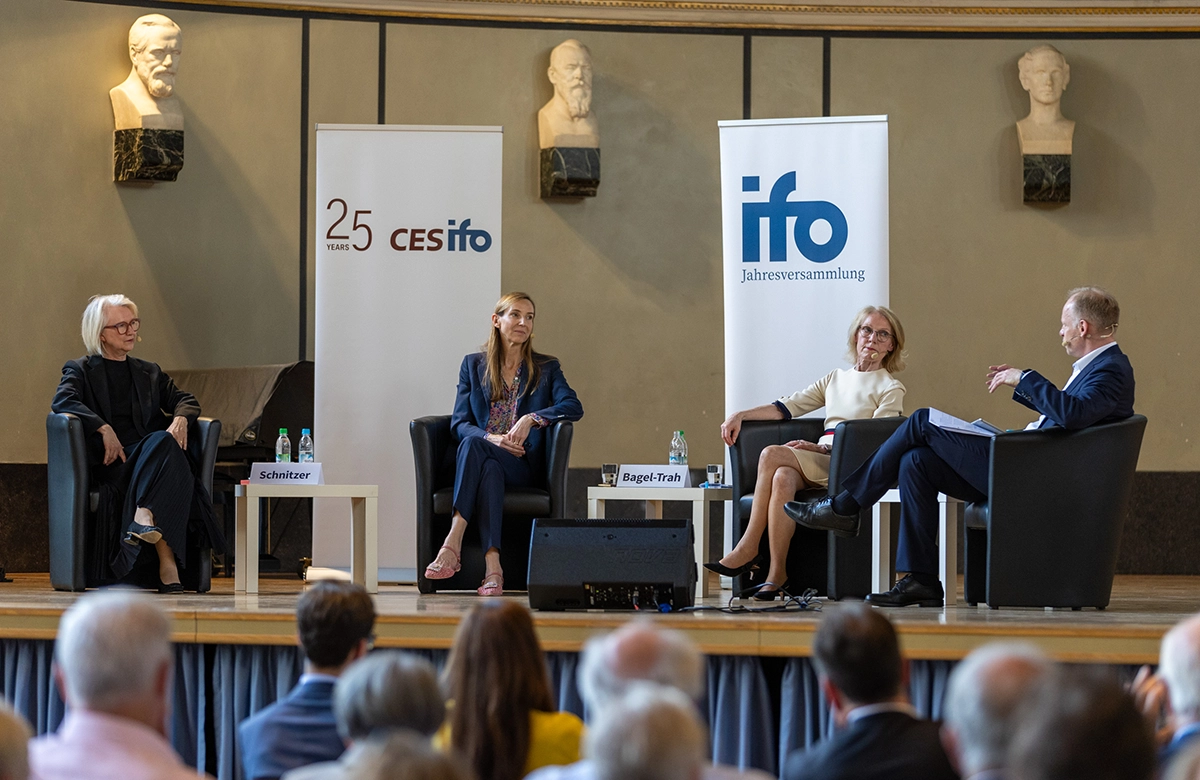
The Social Market Economy of the Future
Looking ahead to 2049, panelists envisioned Germany as an innovation hub, leveraging freedoms to foster technological and social advancements. Germany’s potential as an industrial powerhouse, thriving within global ecological limits and celebrated for its social achievements, positions it as a globally attractive destination for labor market immigration.
Das vollständige Video zur Jahresversammlung sehen Sie hier:
Veranstaltungen
In His Own Words: Interview with Hans-Werner Sinn
CESifo and ifo are celebrating significant milestones: 25 years and 75 years, respectively. Hans-Werner Sinn, who played a pivotal role in revitalizing ifo and founding the CESifo International Research Network, reflects on the early days. In an interview, he discusses CESifo's inspirations, the strong partnership between the ifo Institute and the international network, and their successful journey from local beginnings to global prominence.
"It replaced provinciality in German economic research with its internationalization, and it built a bridge between real-life problems and academic economic research, enabling citizens and policymakers to participate in a rational political and economic discourse."
Discover more of his thoughts on CESifo.org!
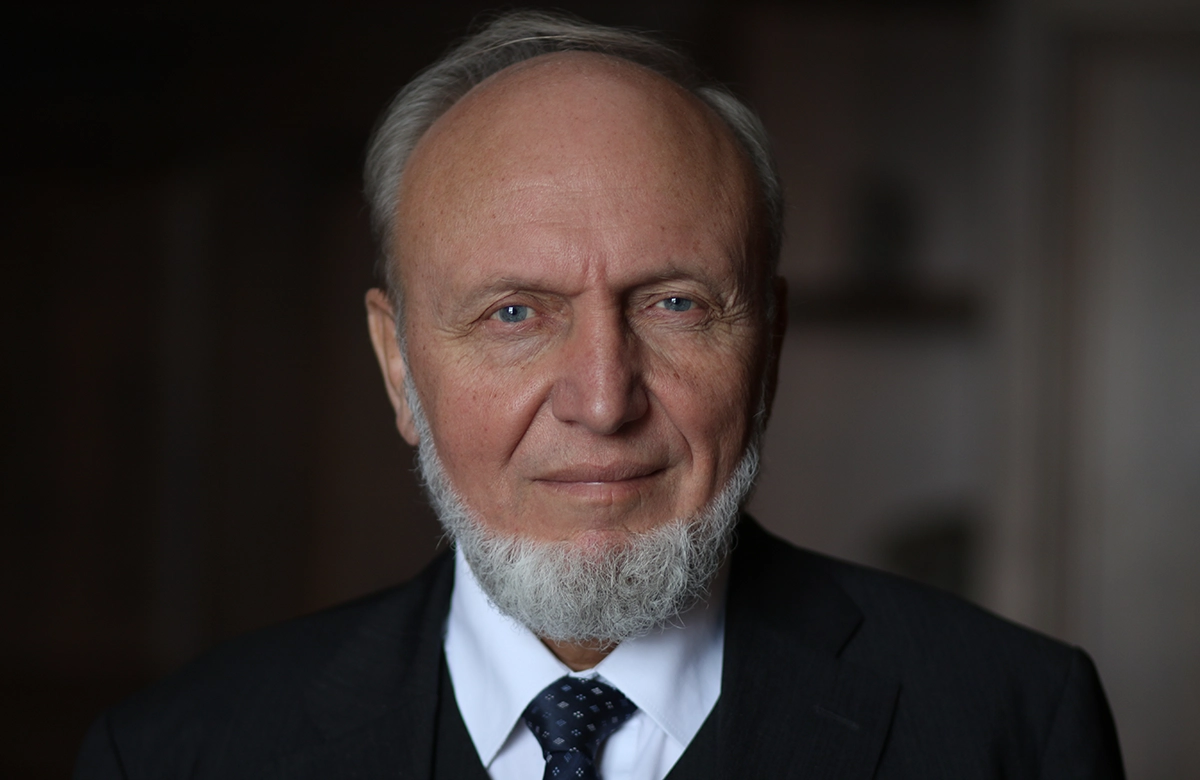
People
Lecture: 75 Years on the Pulse of Economic Policy
Albrecht Ritschl, Professor of Economic History at the London School of Economics, gave a lecture at the 75th anniversary celebration of the ifo Institute in the Great Hall of the Ludwig Maximilian University of Munich. It focuses on the Institute’s reliable forecasts, whose methodology dates back to the 1920s. After its foundation, the institute offered economic services and consulting before becoming a leader in empirical economic research in the 1950s and 60s. From the 1960s, budget crises and the departure of important researchers were responsible for the growing dependence on public contracts. Under President Karl-Maria Hettlage, who had previously worked in the Ministry of Finance, the ifo Institute recovered financially by 1976, but Hettlage’s close involvement with the Nazi regime went unnoticed for a long time.
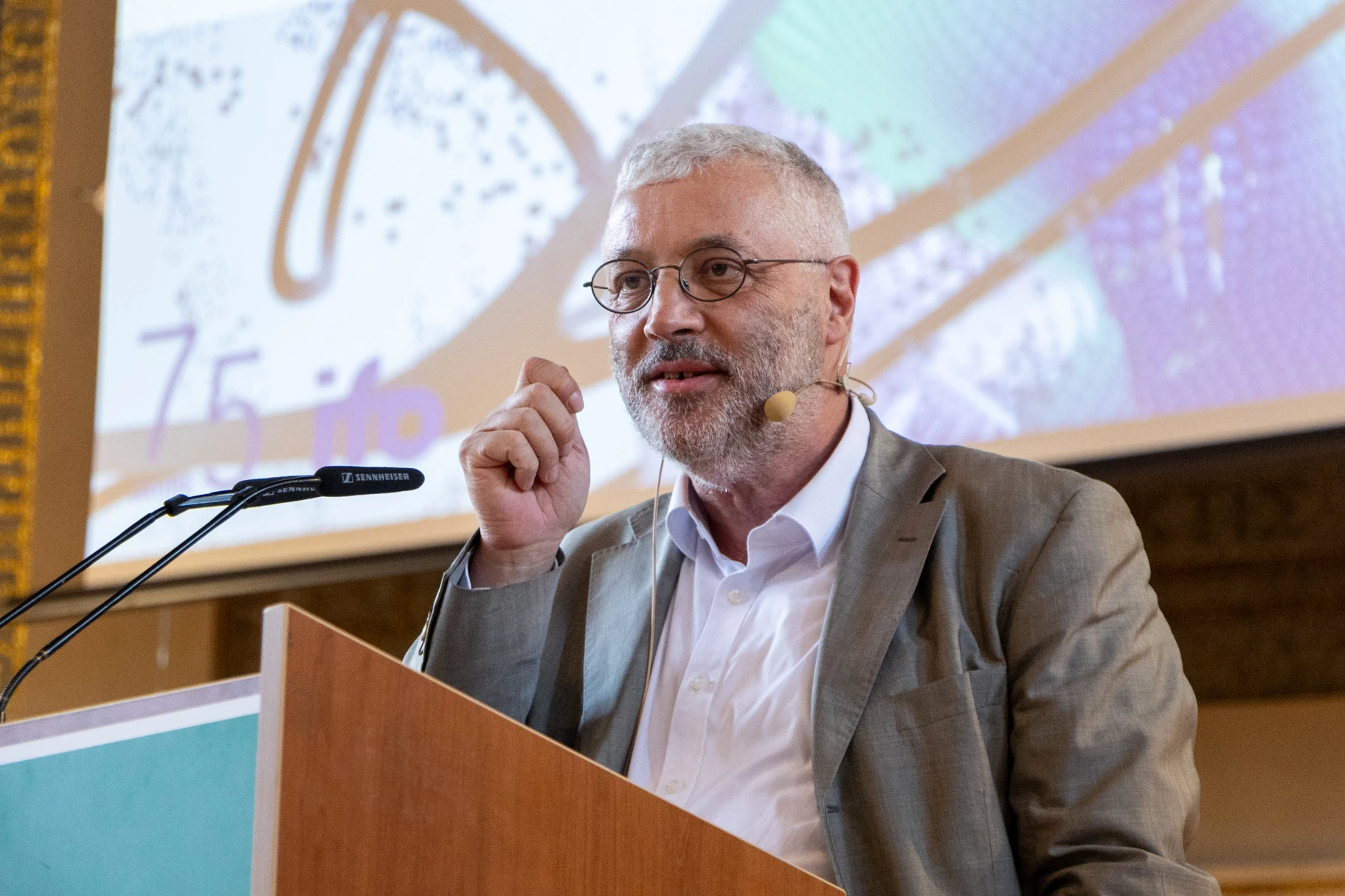
At the end of the 1990s, a reorientation began under Hans-Werner Sinn, which strengthened the institute academically. Today, under the leadership of Clemens Fuest, the institute is one of the most important players in German and international economic research. Despite its successes, Ritschl concludes, the question remains as to how the institute should position itself in the future – whether it should concentrate more on the academic field or also further expand its non-academic activities, such as economic consulting. You can also read an article by Ritschl on the topic in ifo Schnelldienst.
Watch the full lecture by Albrecht Ritschl here:
Events
Literature Meets Economics: Navigating Upheavals
Climate catastrophe, demographic change, digitalization, and war: How do the perspectives of literature and science differ on these pressing issues? Are experiences of upheaval reflected differently across disciplines? What opportunities are there for shaping the future? On March 3, 2024, ifo President Clemens Fuest, historian Philipp Blom, and author Theresia Enzensberger discussed these questions at the Literaturhaus.
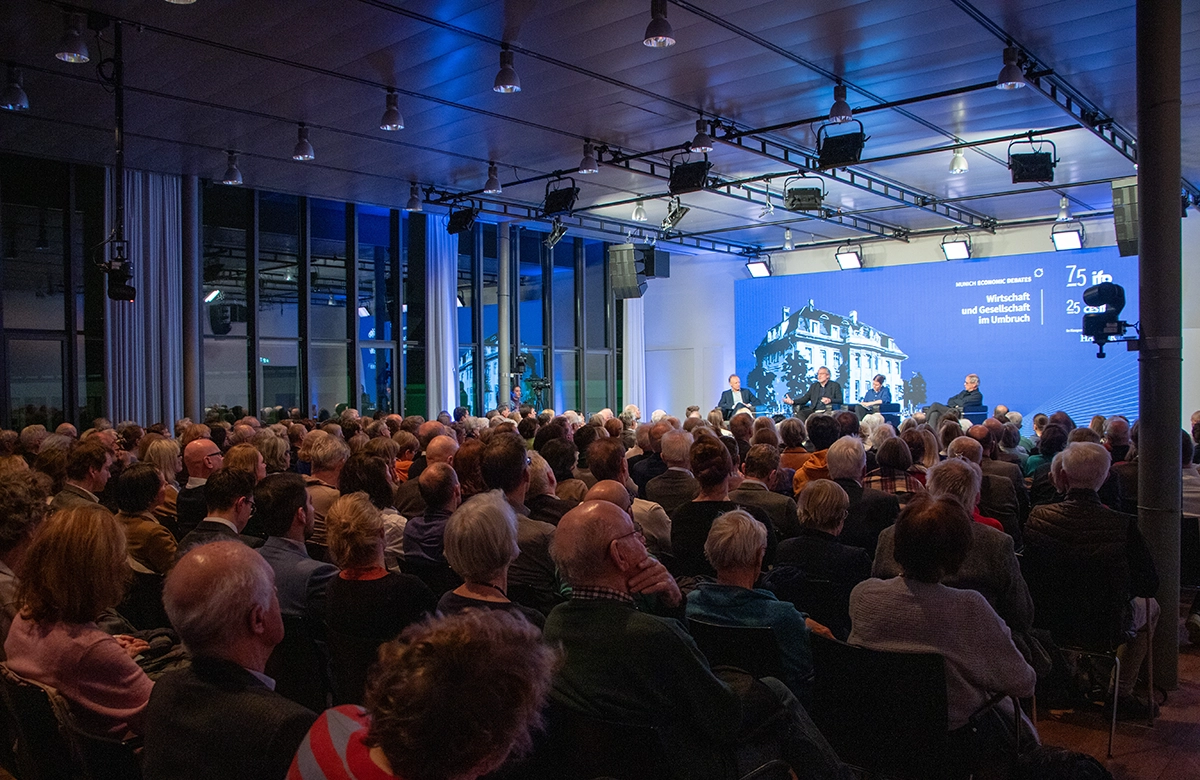
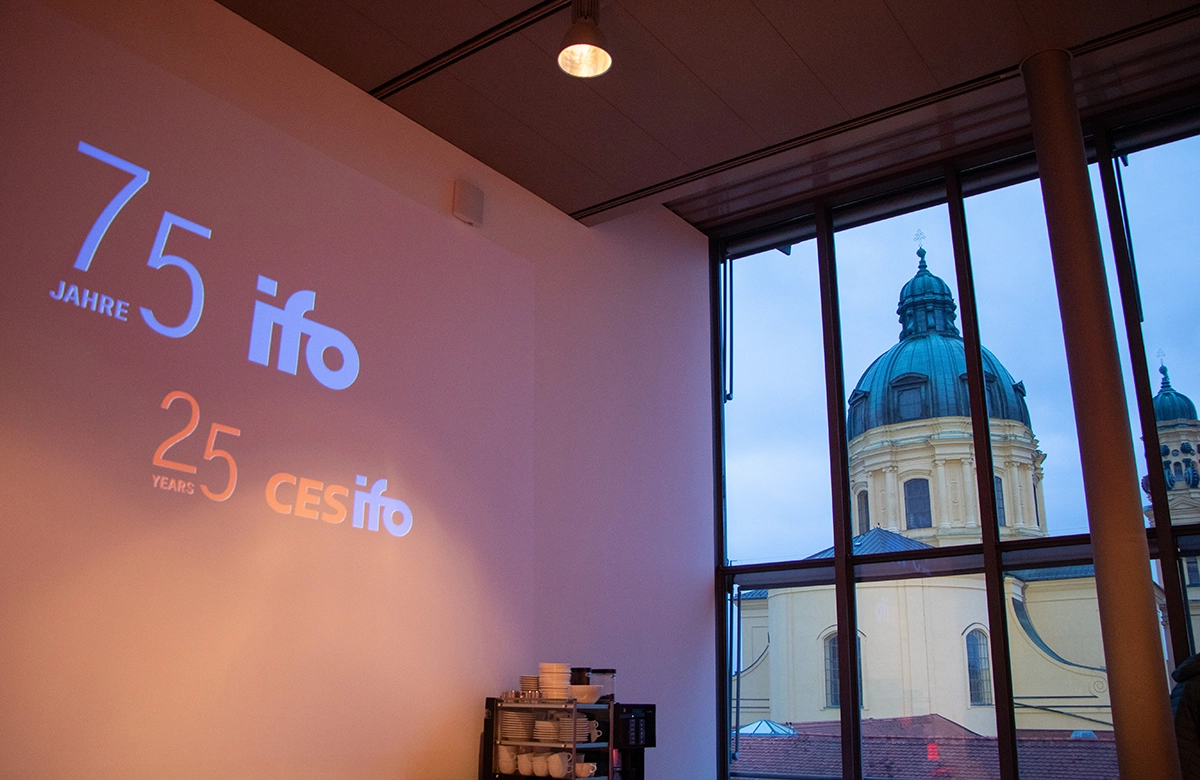
Literary Utopias and Dystopias
In her novel Auf See (literally “At Sea”), Theresia Enzensberger vividly depicts a world dominated by apocalyptic preparation. A small, elite community withdraws to a Baltic Sea island to live self-sufficiently – a utopia that gradually turns dystopian. The novel explores themes of self-reliance and personal responsibility, critiquing neoliberal ideas through a narrative inspired by the libertarian visions of a Silicon Valley tech entrepreneur. Enzensberger’s story suggests that the antidote to dystopia lies in fostering social care and communal solidarity.
Lessons from the Little Ice Age
Philipp Blom, an acclaimed author and historian, notes that history has always been marked by upheavals. He points to the Little Ice Age, beginning in the mid-15th century, when temperature drops of up to two degrees Celsius had profound economic and societal impacts. Blom argues that, just as societies emerged transformed from past crises, we too will likely undergo significant changes in response to today’s challenges. While historians and writers cannot predict the precise nature of future societies, they can craft narratives that offer new perspectives and insights.
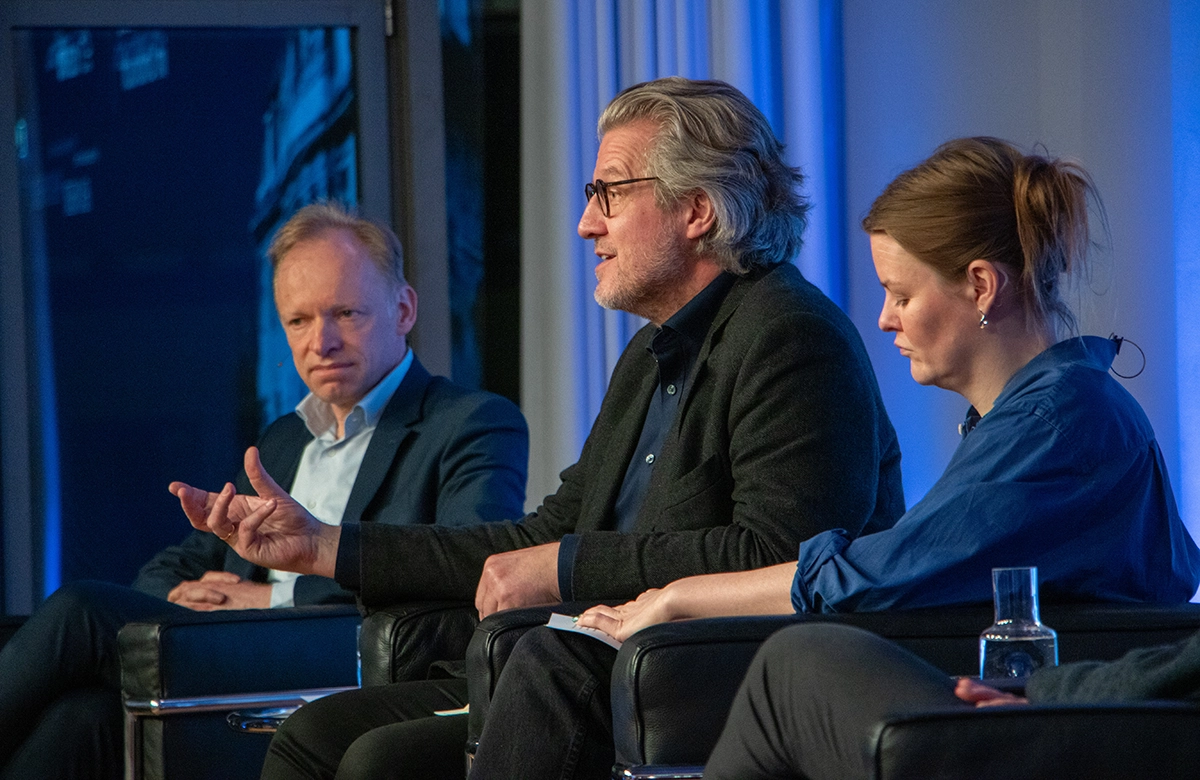
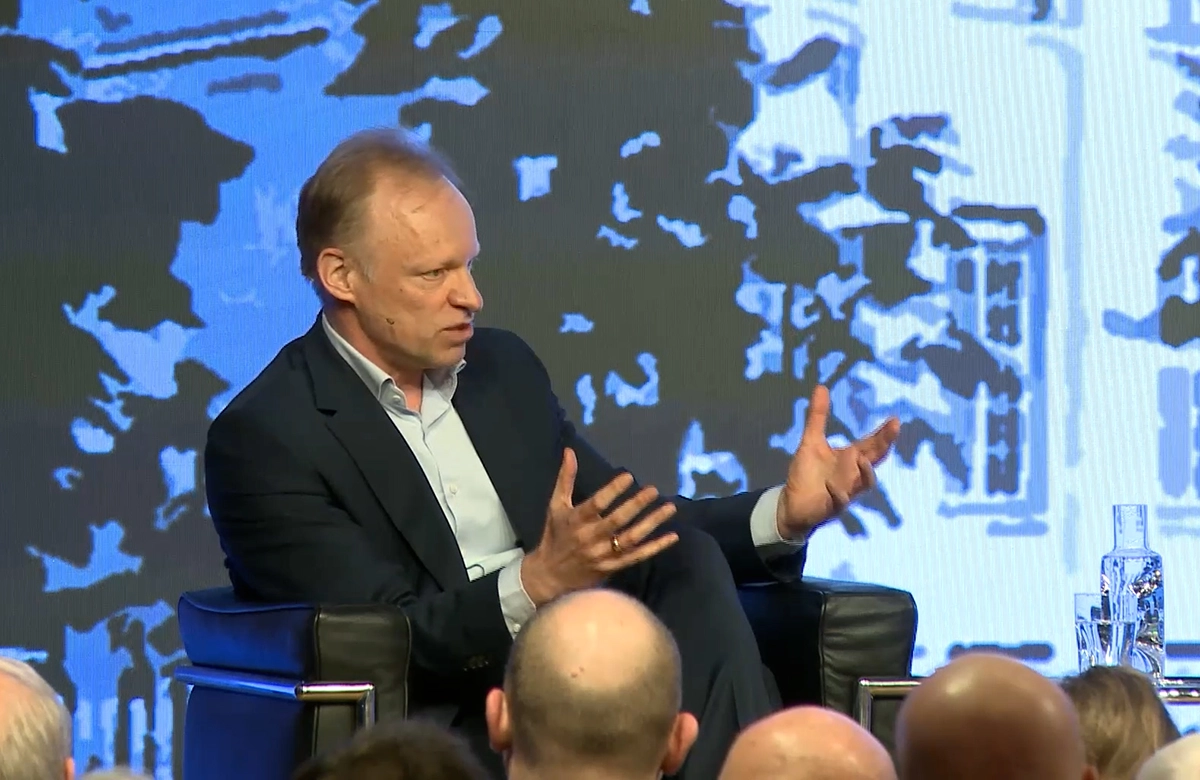
The Search for New Scientific Theories
Clemens Fuest addresses the current upheavals through scientific research and policy advice. He notes that economics typically considers – mathematically – how the world might function in the future. He emphasizes that traditional scientific methods are inherently backward-looking, as they rely on historical data to draw inferences for the future. However, in periods of rapid change, this approach has its limitations. Fuest argues that during such times, the focus should shift toward developing new theories, models, and assumptions that can better capture the dynamics of future developments.
You can find the recording of the discussion here:
Events
Ludwig Erhard: Scientist, Chancellor, Visionary.
Ludwig Erhard’s name is synonymous with the concept of the social market economy, which remains the cornerstone of the Federal Republic of Germany’s economic system to this day. Erhard‘s political journey led him from serving as the Federal Minister of Economics under Chancellor Konrad Adenauer from 1949 to 1963, to holding the prestigious office of Chancellor himself from 1963 to 1966. Erhard also played a pivotal role in the establishment of the ifo Institute.
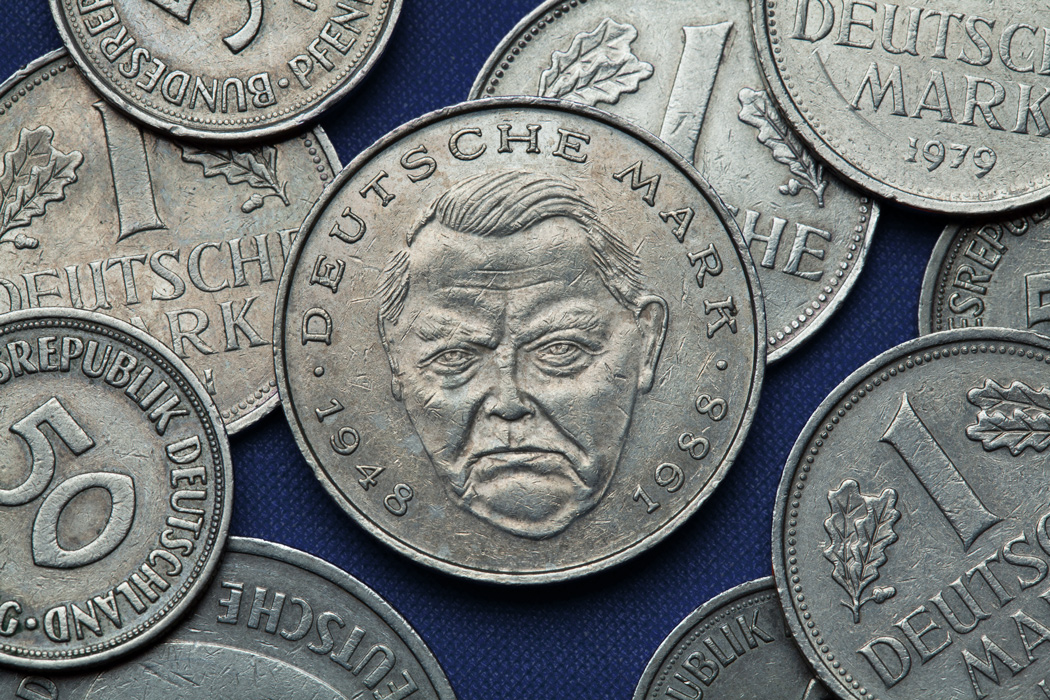

Academic Career Over Family Textile Business
Ludwig Erhard was born on February 4, 1897, in Fürth, Bavaria. After attending elementary and secondary school and completing an apprenticeship as a linen merchant in 1916, he was expected to take over the family textile business. However, his life took a different turn: Despite a foot deformed by polio, Erhard served as a soldier in World War I from 1916. He was severely wounded in 1918 at Ypres (Belgium) and discharged from military service in 1919.
Instead of joining the family business, he enrolled at the Nuremberg College of Commerce, graduating in 1922 with a degree in business administration. He then studied business economics, national economics, and sociology at the University of Frankfurt, with a particular interest in economics: Erhard once described himself as a student who “wanted to learn business economics but was possessed by a zeal for economics.” In 1925, Erhard earned his PhD and joined the family business as a managing director, but he had to declare bankruptcy for the company in 1929.
A year before the bankruptcy of his family business, Ludwig Erhard had already returned to academia, joining the Institut für Wirtschaftsbeobachtung der deutschen Fertigware, a marketing research institute. There, he rose to the position of Deputy Research Director. In 1942, he left this role to establish his own institute for consumer research, the Institut für Konsumforschung, which, even at the height of World War II, began to address questions of post-war reconstruction. The founding of this research institute is considered a key precursor to the establishment of the ifo Institute.
A “Left-wing Democrat” Takes Bavarian Economic Helm
Erhard’s successful work in economic observation, economic policy analysis, and advising practitioners paved the way for his political career. The very day after American troops liberated his hometown of Fürth on April 18, 1945, Erhard stepped forward, offering his vast economic expertise to the occupying forces. Recognizing his potential, the American military governor appointed him as the Minister of Trade and Industry in the nascent Bavarian state government on October 22, 1945. At this time, Erhard was not affiliated with any political party but was nonetheless categorized as a “Left-wing Democrat” in the administration led by the Social Democratic Minister President Wilhelm Hoegner.
At the turn of the year 1945/46, Ludwig Erhard assessed the Bavarian government’s capacity for reconstruction as limited. He stated that “a purely Bavarian economic policy could not solve the impending problems; this could only be achieved within a German framework and in cooperation beyond Germany's borders.” This demand was seen as provocative by some of his government colleagues. Ludwig Erhard increasingly isolated himself in Bavarian politics. After the first elections to the Bavarian State Parliament on December 21, 1946, he lost his position.
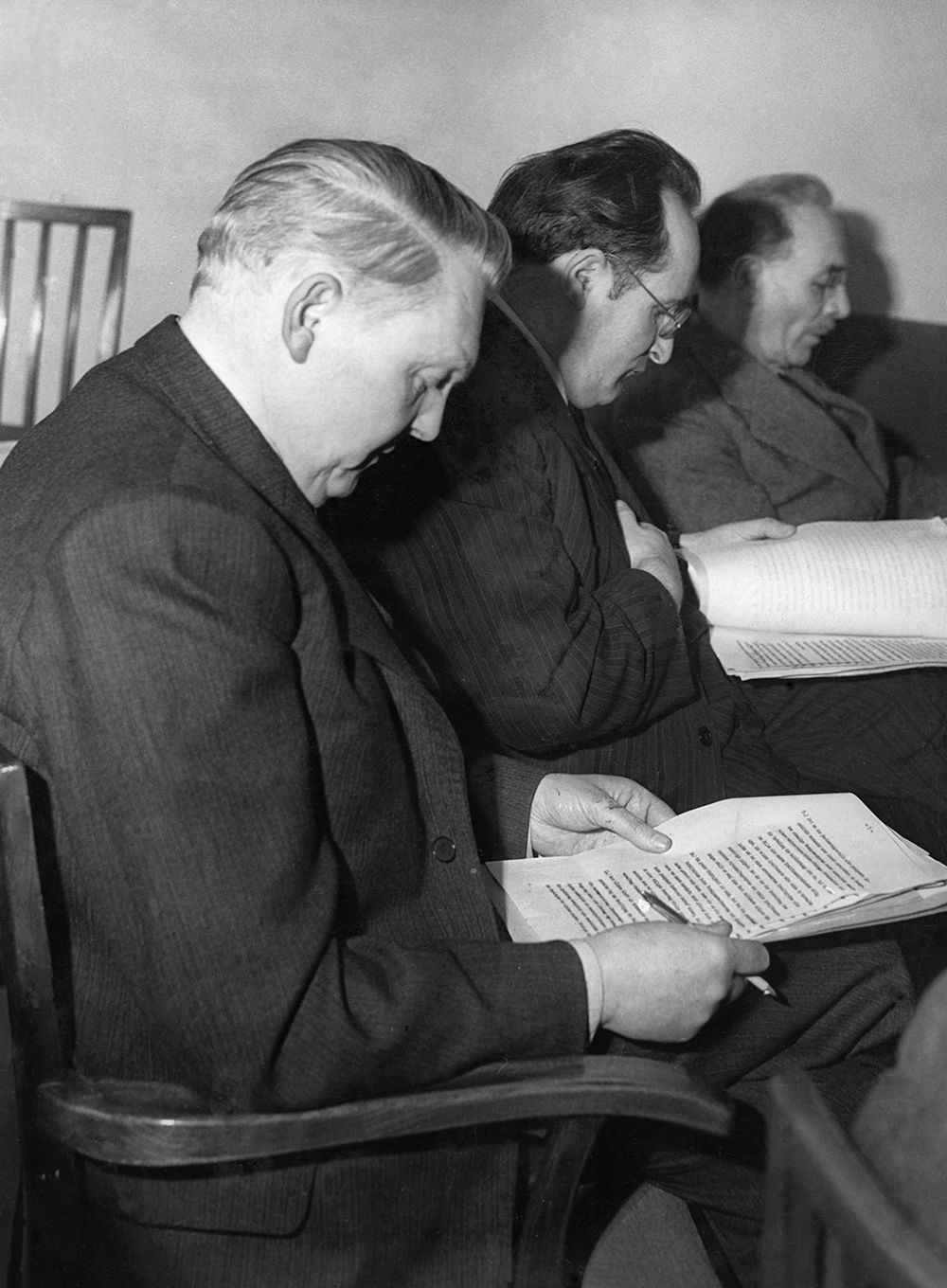
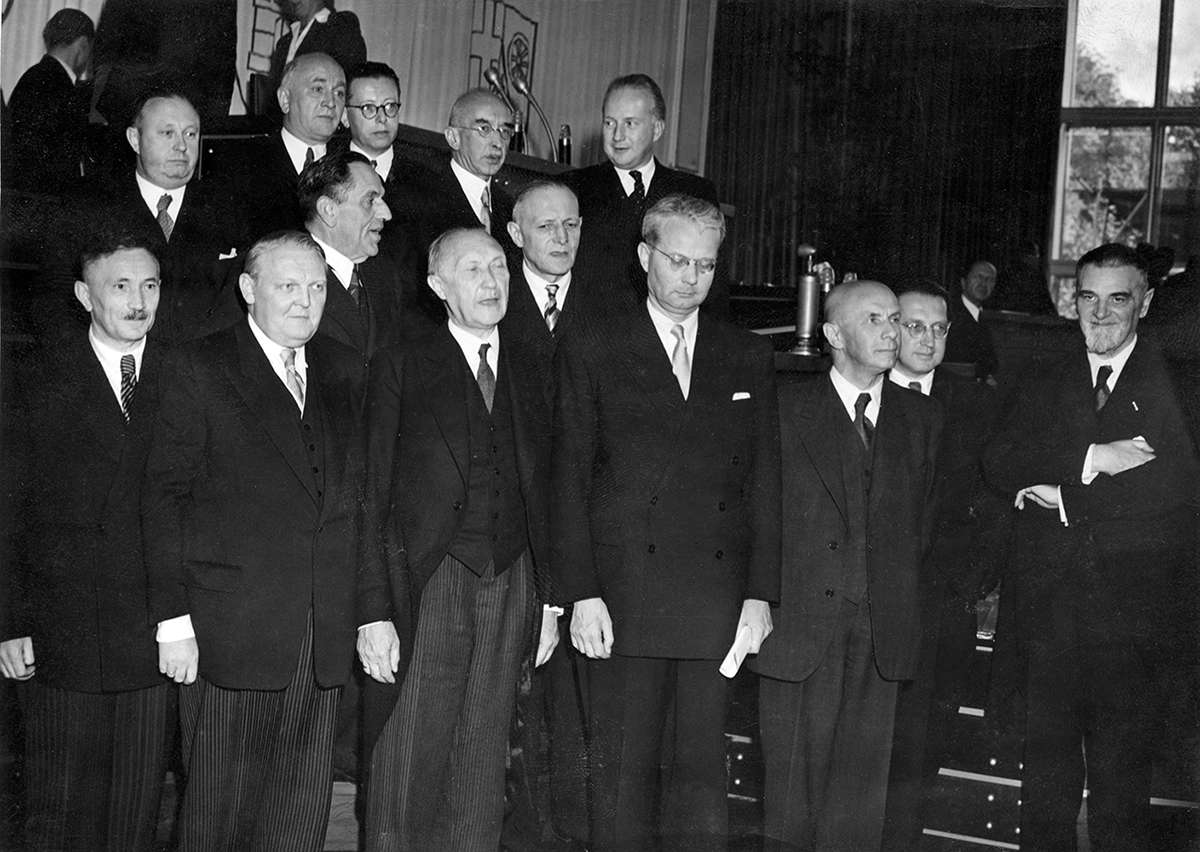
Broadening Horizons Beyond Bavaria
Once again, a professional setback turned out to be the next step in Ludwig Erhard’s rapid career ascent. The post-war years in Munich not only fueled his political ambitions but also provided him opportunities to engage with leading national economists and financial scholars. He was particularly active in the “Volkswirtschaftliche Arbeitsgemeinschaft für Bayern,” founded by Adolf Weber, where he gained further economic expertise that propelled his political career beyond the borders of Bavaria. In 1947, Erhard headed the Special Division Currency and Credit at the Finance Administration of the British-American Bizone in Frankfurt. On March 2, 1948, he was elected Director of the Department for Economics of the Combined Economic Area, making him responsible for economic policy in the Western occupation zones. Following the first Bundestag election in 1949, Chancellor Konrad Adenauer (CDU) appointed him as the Minister of Economic Affairs in his first cabinet.
The German Economic Miracle
Ludwig Erhard was a staunch advocate for a free, social market economy, which led to remarkable growth in West Germany for a decade and a half. The Federal Republic emerged as a leading industrial and export nation.
After serving 14 years as Minister of Economic Affairs, Erhard moved into the Chancellor's office in 1963, but his tenure lasted only three years. Disagreements over economic and fiscal policies led to the collapse of the governing coalition between the CDU/CSU and FDP in 1966. During Erhard’s chancellorship, West Germany faced its first economic crisis, with economic growth having slowed since 1960. Criticism of Erhard’s austerity policies grew louder. On November 10, 1966, the CDU/CSU parliamentary group nominated Kurt Georg Kiesinger as Chancellor, and on December 1, Erhard resigned.
On his 80th birthday on February 4, 1977, Erhard received numerous honors, and he passed away three months later on May 5 in Bonn due to heart failure. In line with his vision, the Ludwig Erhard ifo Center for Social Market Economy and Institutional Economics in Fürth today researches governmental actions in light of new challenges. In honor of Erhard, the main lecture hall at the ifo Institute has been renamed the “Ludwig Erhard Hall.”
Note: For the sources used in this text, click on the imprint.
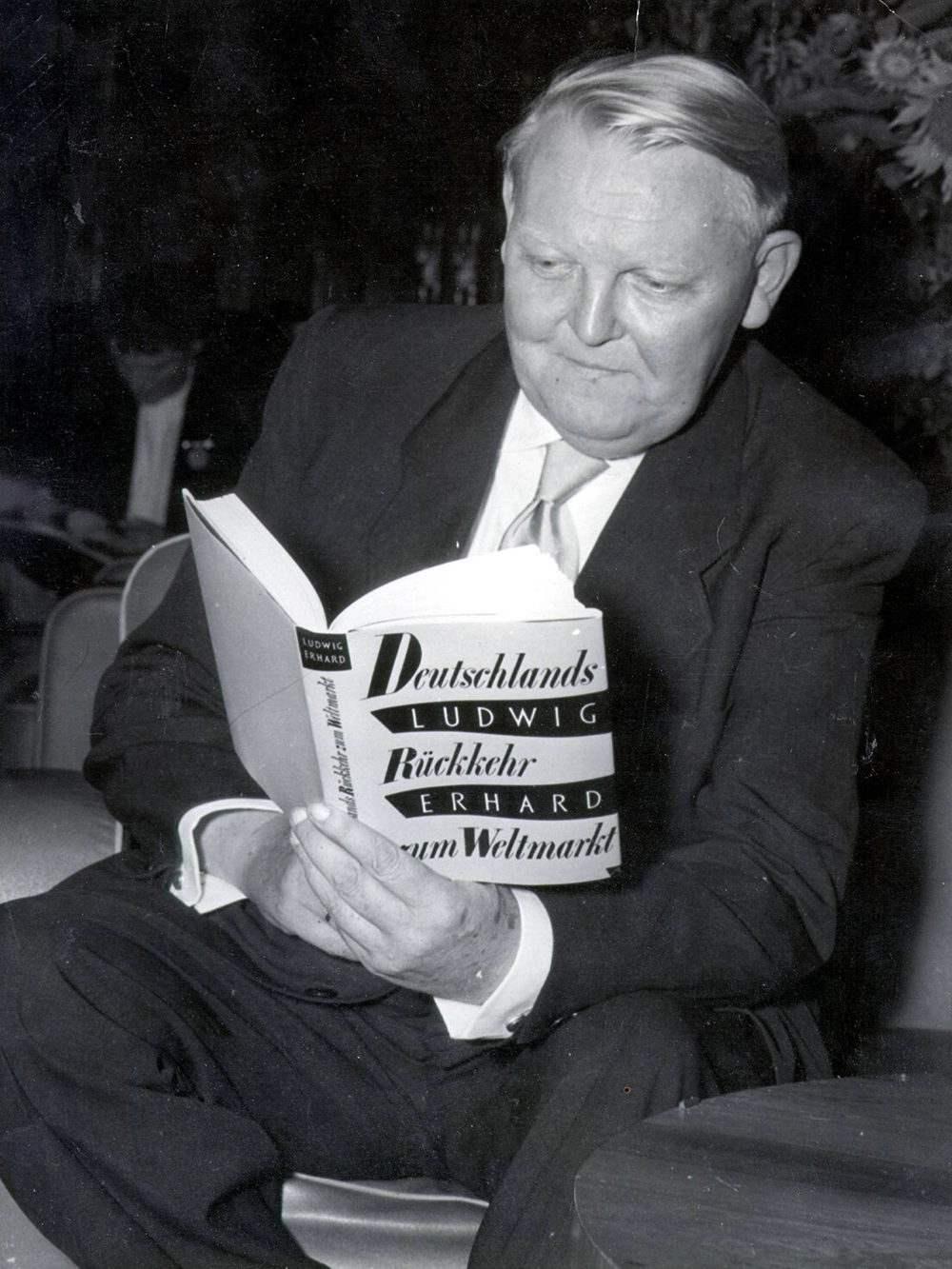
Beginnings
People
Munich, the EconHub on the Isar
The pursuit of excellence in economic sciences has a long tradition at the ifo Institute, but Munich itself is also an outstanding EconHub location in Europe. Is excellent economic research in the air here? In the beautiful waters of the River Isar? Not (only) if Florian Englmaier from the Faculty of Economics at the Ludwig Maximilian University of Munich (LMU) has his way. He was head of the institute for several years and served as Director of the Munich Graduate School of Economics (MGSE). He knows that both institutions played a crucial part in making Munich the center of economic research that it is today. What other factors play a role? And what about the next generation of (international) talent? We asked him.
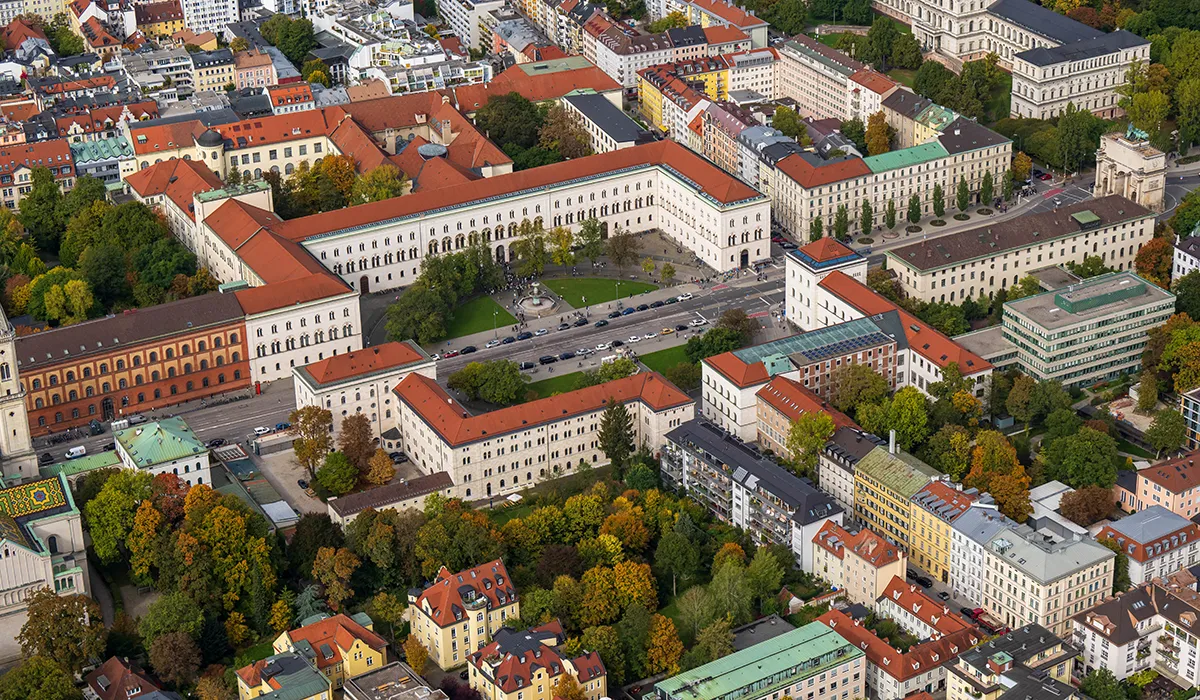
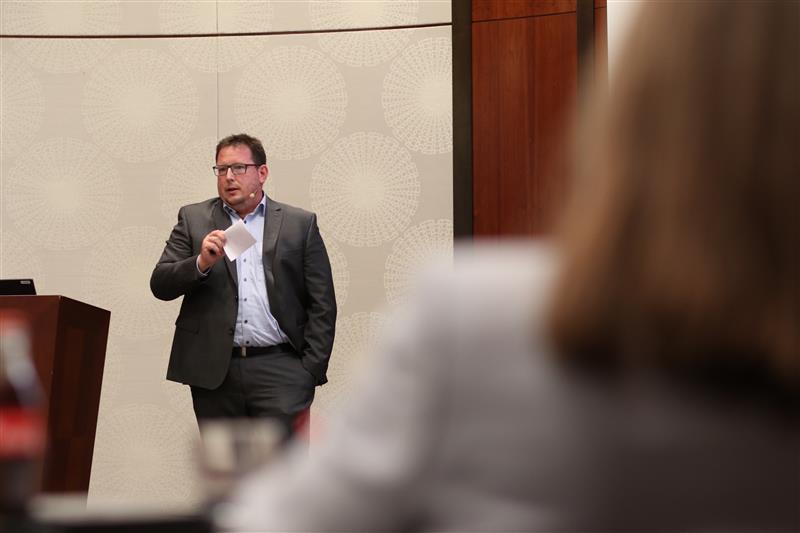
Why Is Munich a Relevant Location?
The Faculty of Economics at LMU Munich, the ifo Institute and three Max Planck Institutes for economics form an outstanding cluster in the field of economic research in Europe. A large number of economists are very visible not only academically but also in political consulting.
Munich is also an important business location with numerous large companies and a flourishing start-up ecosystem, which opens up considerable potential for cooperation. Within the EconHub, various platforms are offered to foster sharing of knowledge and ideas between academia and practice and politics. The EconHub can thus help ensure that research results are put into practice sooner.
This has a long tradition: Munich has had a strong economics faculty since the 19th century. Added to this is ifo’s close connection to the University of Munich since the late 1990s and the establishment here of the three Max Planck Institutes in the last 15 years. Internationalization and the increased focus on excellence in recruitment and training young talents then resulted in even closer integration and improved quality over the past ten years.
Overall, the EconHub is characterized by team spirit and a shared commitment to becoming better, more international and more relevant. It attracts a huge number of excellent international guests and offers a raft of great conferences, workshops and dialog formats.
How Does the Hub Foster Young Talent?
Under the umbrella of the Munich Graduate School of Economics (MGSE) and the Junior Development Program, we have created strong structures that provide sustained support for all young talent at the location through mentoring programs and other assistance. Integration in the promotion of young talent has also led to closer cooperation across the institutions and between individual researchers. The excellent courses on offer at the LMU draw talents from all over the world and help attract them to Munich. That’s a good thing as international networking is vital. There are many joint projects with world-leading researchers and institutions in this field. Of course, it helps that Munich is one of Europe’s hubs for conferences and guests. And let us not forget that the CESifo network is an excellent institution when it comes to international exchange.
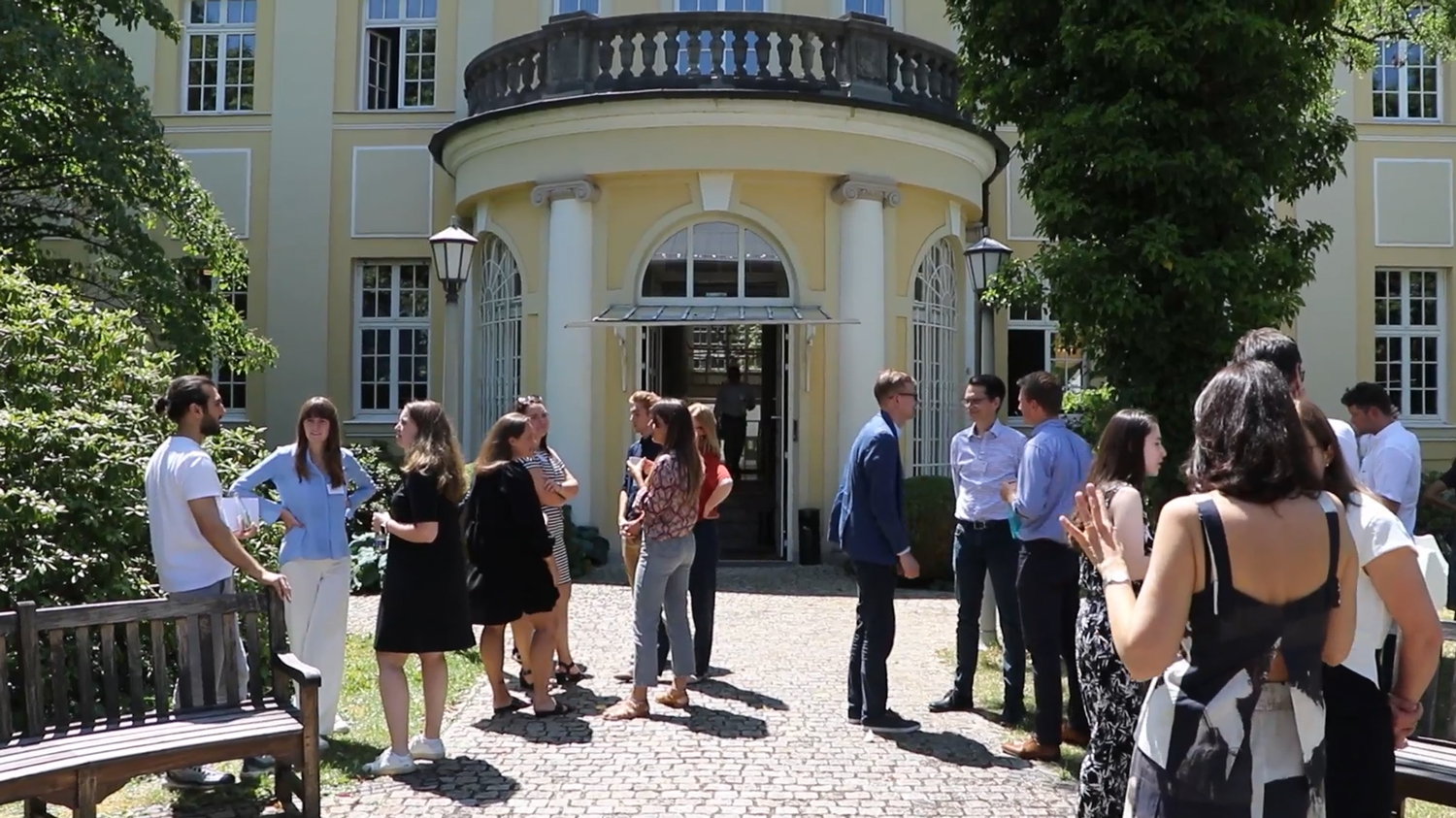
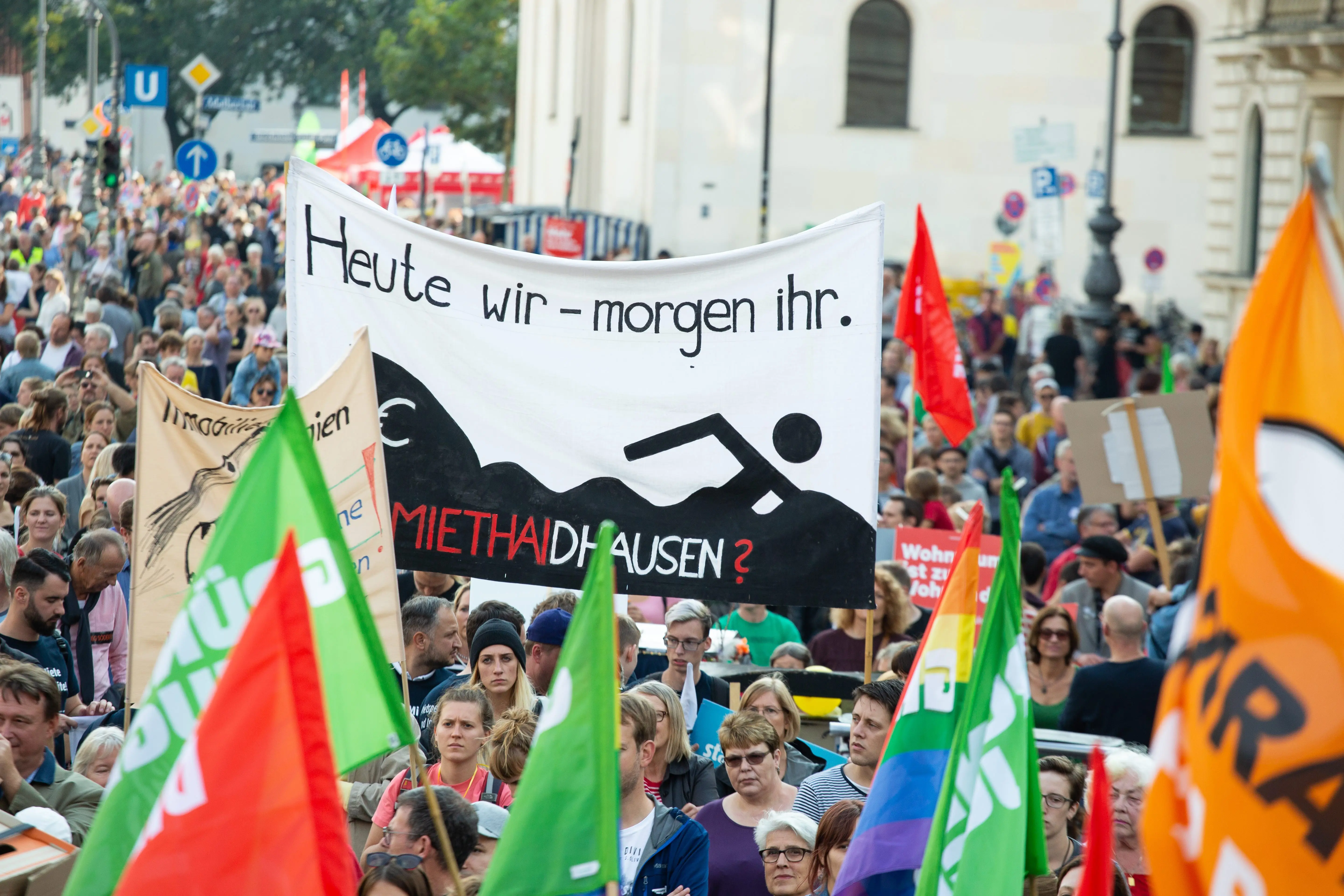
What Challenges and Visions Does the Hub Have?
Despite all these positive aspects, it goes with saying that there are – unfortunately – challenges to overcome in Munich. A housing shortage and the rising cost of living are issues, as is the bureaucracy that creates additional obstacles to recruiting international talent. Funding doesn’t grow on trees, either. On the other hand, we at the EconHub are tackling a host of social issues and trying to find solutions and improvements: The shortage of labor and skilled workers, the green transformation, social inequality; and we are developing approaches to tackle weak productivity.
We are seeking closer cooperation with the business community in order to leverage company data even more effectively for research. To this end, we will continue existing investments in a high-performance research data environment. We also want to drive our internationalization forward and become even more attractive to international talent. We must systematically address the major social issues so that we remain relevant and can continue to have a significant impact on the professional and political debate moving ahead.
Network
Navigating the Oil Crises: Driving Restrictions and Economic Downturns
In autumn 1973, in response to the Yom Kippur War, Arab oil-producing states slashed their production and quadrupled oil prices, causing a market uproar. Heavily dependent on these imports, Germany faced unprecedented daily life restrictions. On November 25, 1973, and three subsequent Sundays, a driving ban was enforced for the majority of the population. The ifo Institute published proposals for energy planning.
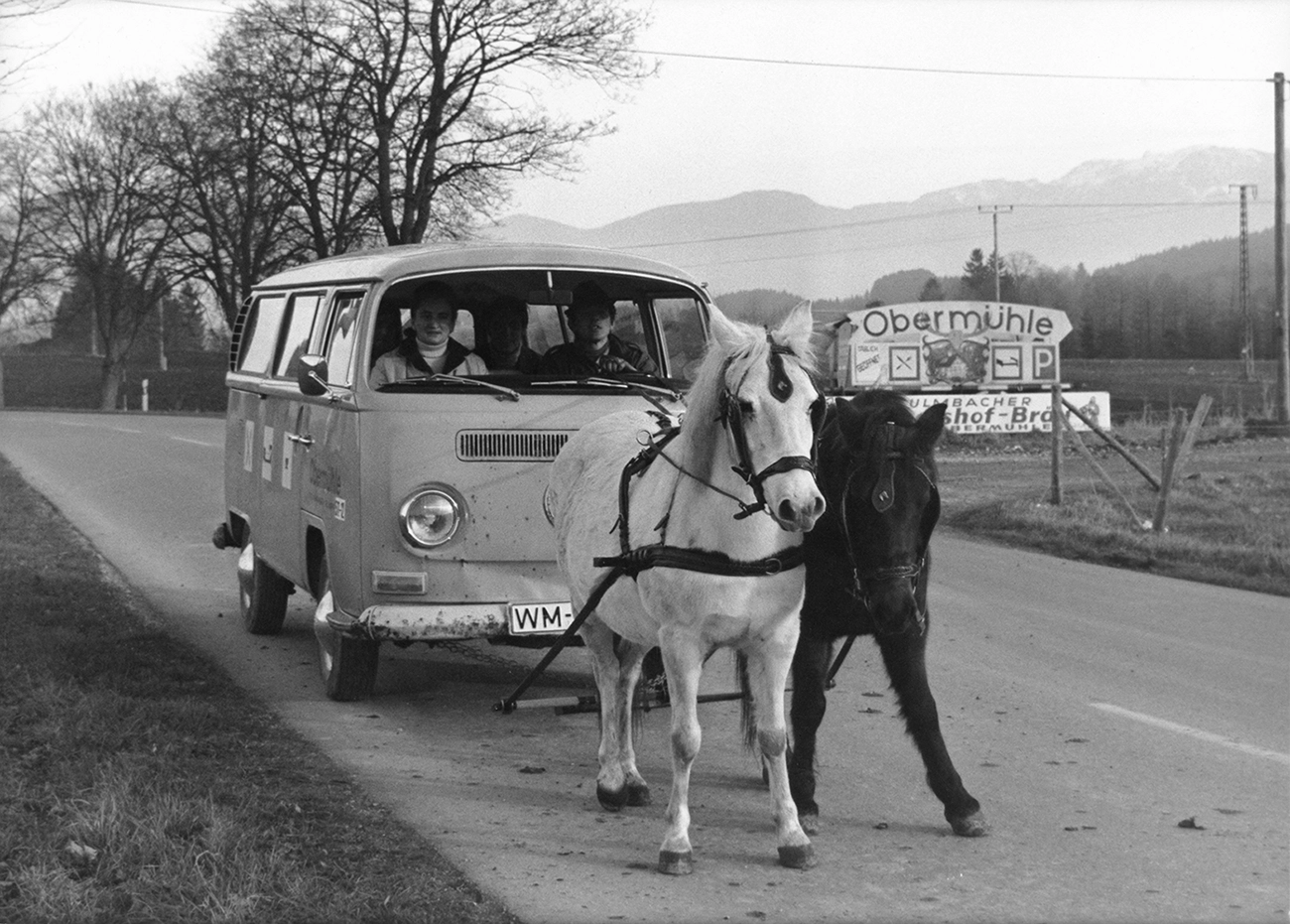
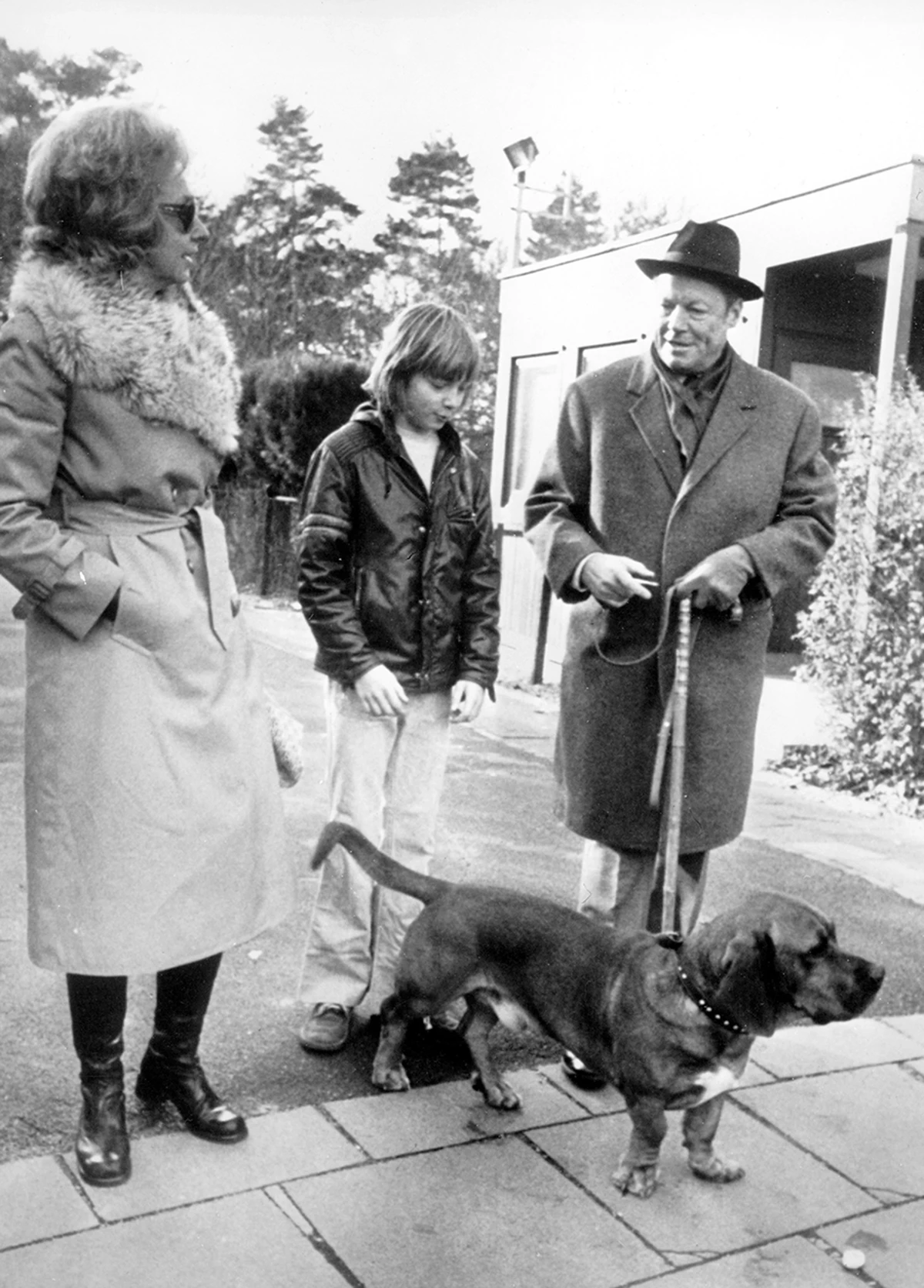
The Middle East Conflict and the Oil Embargo
On October 6, 1973, Egypt and Syria attacked Israel on the Jewish holiday of Yom Kippur. With American military aid, Israel narrowly averted defeat. International pressure from the USA, Soviet Union, and UN led to a ceasefire by late October, which was met with confusion by Arab oil states. Viewing Western support for Israel as biased, they leveraged their oil reserves to advocate for Palestinian rights.
On October 16, Gulf countries agreed to hike the price of “Arabian Light” crude oil by 70%, prompting OPEC members to follow suit. A limited supply boycott came into effect on October 17, accompanied by a 5% monthly production cut. The embargo targeted the USA and the Netherlands, with Rotterdam being a pivotal hub in European oil trade.
Oil constituted the primary energy source for Western industrial nations, with demand steadily rising. In West Germany alone, 55% of energy needs were met by imported crude oil, 75% of which came from Arab nations. The oil crisis swiftly drove up prices for heating oil and gasoline, prompting government austerity measures. Federal agencies were instructed to reduce heating and lighting usage, and a speed limit was imposed on federal vehicles. However, the public resisted reducing their mobility, and fuel consumption did not decline as expected.
The Next Steps
In early November 1973, Chancellor Willy Brandt swiftly enacted the Energy Security Act, allowing for restricted vehicle use based on location, time, route, speed, and necessity. This legislation paved the way for car-free Sundays initially planned for November and December. Additionally, speed limits of 100 km/h on highways and 80 km/h on rural roads were established, with exemptions granted to essential services such as police officers, doctors, florists, journalists, and taxi drivers.
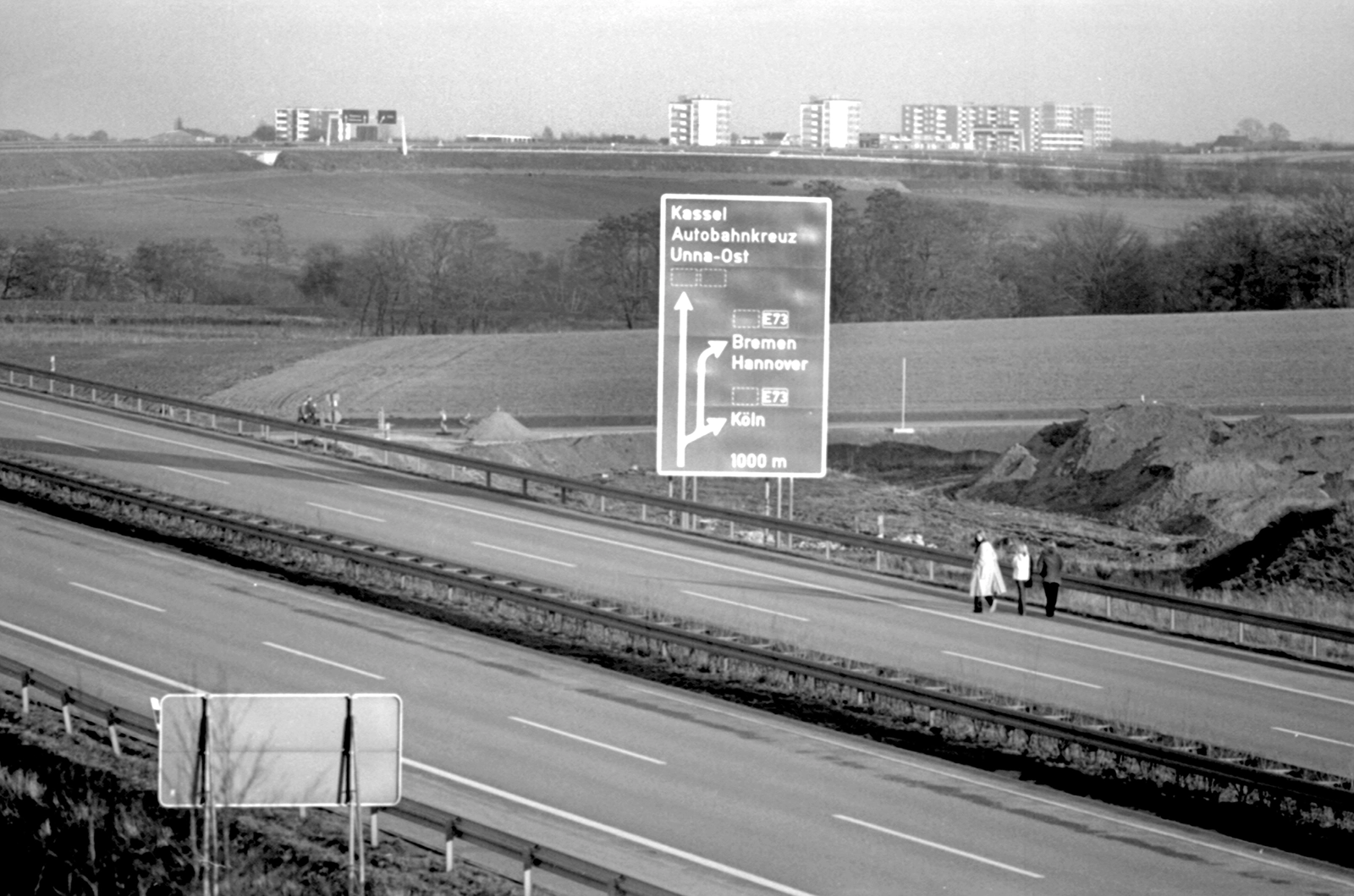
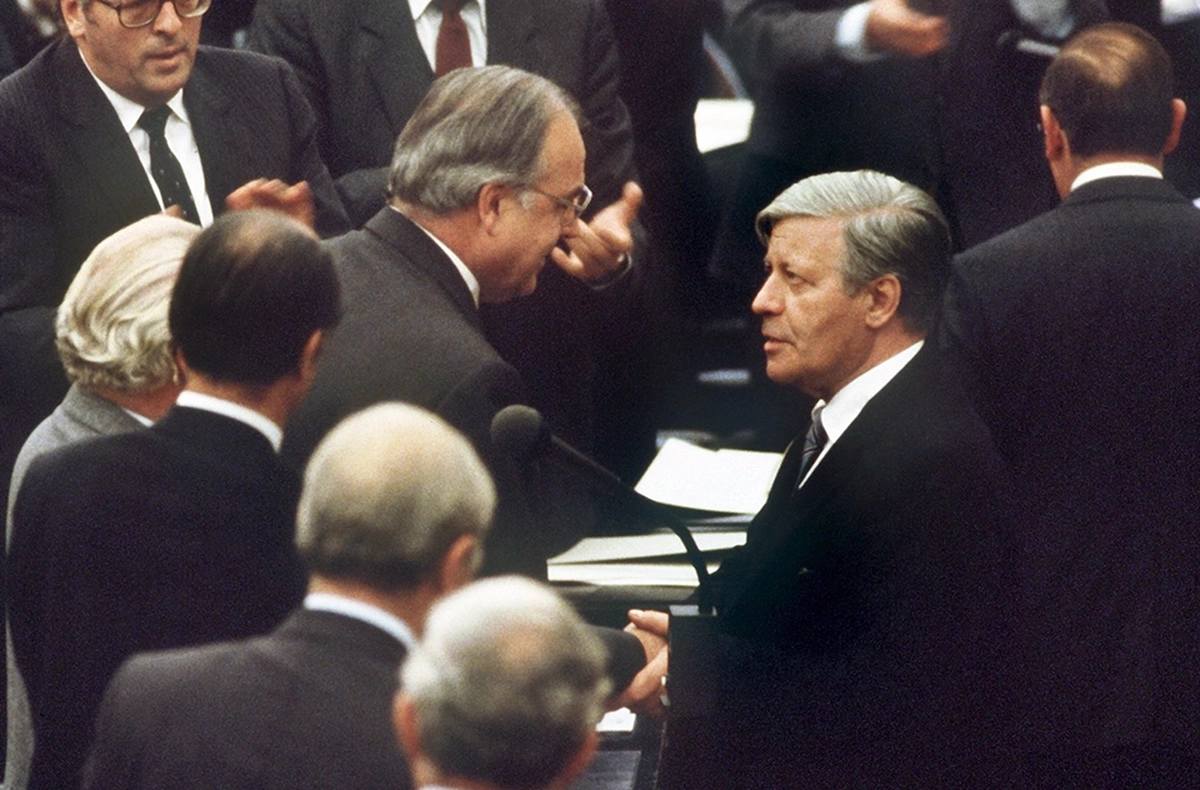
ifo Institute Addresses Dependencies
Even before the outbreak of the Yom Kippur War in August 1973, the ifo Institute had highlighted Western industrial states’ vulnerability to oil imports and the resulting economic risks. Hildegard Harlander from the ifo Institute detailed West Germany’s dependence on oil imports and explored prospects for new energy sources in a paper. She had also extensively engaged with the Club of Rome’s 1972 study “The Limits to Growth,” advocating for energy planning that considered ecological sustainability and set energy-saving targets.
Conclusion of the Oil Wars – and the End of Germany’s Economic Miracle
By late 1973, tensions in the Middle East had eased, leading OAPEC states to ramp up oil production while maintaining higher prices. Germany scrapped plans for a 1974 driving ban, and speed limits were lifted by March. Despite these moves, the German economy grappled with the aftermath of the oil crisis. In 1974, the Federal Republic spent 23 billion Deutsche Marks (DM) on oil imports, a 153% increase from the previous year. Car sales plummeted, leading to reduced hours in the automotive industry and similar downturns in the construction materials sector, chemical industry, and iron and steel production. Unemployment surpassed one million by 1975.


The Second Oil Crisis and Political Change
After Shah Reza Pahlavi’s ousting in January 1979, Iran transformed into an Islamic Republic under Ayatollah Khomeini, triggering another oil crisis. Production shortfalls drove crude oil prices to DM 619 per ton by 1981, with energy imports consuming 4.85% of GDP. Germany slid into recession, seeing over 2 million unemployed for the first time in 1983. Rising prices prompted cuts to social welfare programs, with the SPD-FDP government in 1982 increasing social security contributions, reducing benefits, and restricting access to unemployment benefits. Child benefits for the second and third child were also reduced by DM 20 each. The FDP advocated further cuts to social welfare to address economic woes, with Economics Minister Otto Graf Lambsdorff and Foreign Minister Hans-Dietrich Genscher pushing for reduced state intervention in market affairs. In autumn 1982, the Liberals aligned closely with the CDU. On October 1, Chancellor Helmut Schmidt lost office in a constructive vote of no confidence, leading the Union parties, with FDP support, to elect CDU leader Helmut Kohl as the new Chancellor. Fresh elections were scheduled for March 1983, resulting in a CDU/CSU-FDP coalition securing a strong majority.
Milestone
Navigation System for the Economy: ifo Economic Forecasts
Private households plan their budget, companies calculate investments, the German government determines state spending – from single income to the national budget, expectations regarding the future economic situation influence a host of decisions. Forecasts are therefore extremely welcome. Economic forecasts predict overall economic development. The ifo Institute publishes the ifo Economic Forecast for Germany four times a year and the ifo Economic Forecast for Eastern Germany and Saxony twice a year.


ifo Feels the Pulse of the Economy
From 1951, the ifo department for “General Economic Observation and Economic Policy” dealt with economic development in Germany. The main focus of this department was on macroeconomic diagnosis and prediction, with the initial aim of creating the basis for a quarterly calculation of the national product. In the second half of the 1950s, alongside the short-term analysis of economic development, the call for a long-term structural and growth analysis became ever louder. The hitherto available data did not provide sufficient information for that, so it had to be supplemented by a series of empirical studies. On that basis, the research teams initially calculated the expected number of people of working age and the required working hours for individual sectors of the economy. It was now possible to forecast the volume of work in the Federal Republic of Germany for the duration of an entire decade. That was used, taking the productivity trend into account, to derive the social product to be expected at full employment.
Electronic Data Processing
The ifo Institute’s work at the time was also considered groundbreaking because it had been making use of the possibilities of electronic data processing since 1959. Ever larger volumes of data could thus be collected, structured and analyzed. Thanks to the new technology, the ifo Institute was able to carry out a forecast of the transport volume up to 1970 and make statements on the long-term development of steel exports. The first macroeconomic forecast for the Federal Republic of Germany, which was drawn up between 1959 and 1961, was also a milestone. It provided a forecast of production development up to 1970 – for nine branches of industry and four branches of transport.
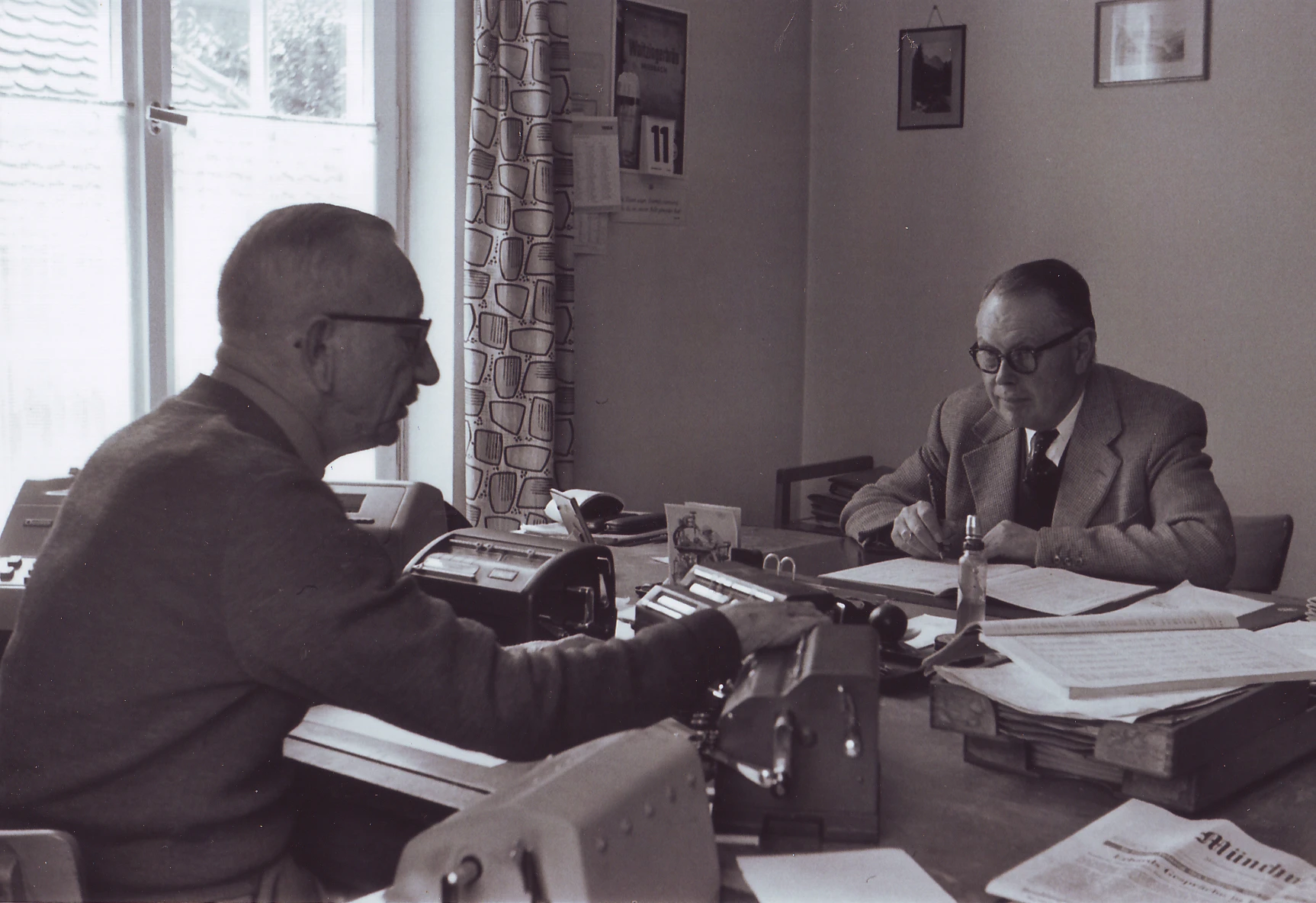
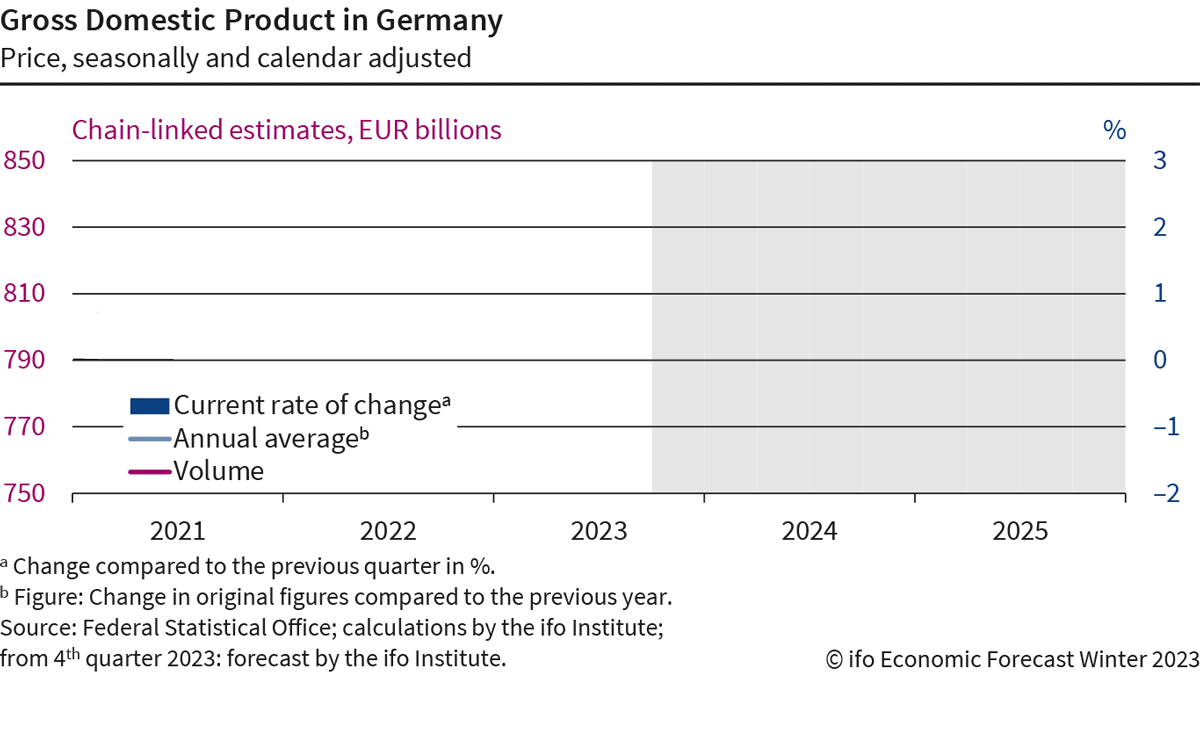
The “Secret” of the Economic Forecast
An economic forecast is based on the assumption that economic activities follow a pattern of recurring cycles. An economic cycle consists of four phases: recovery, boom, slowdown, and crisis. One task of economic forecasting is to identify potential disruptions in the economic cycle and determine their impact on future macroeconomic development. The key figure that is forecast is gross domestic product, which comprises all economic activities of an economy.
Forecasts vs. Prophecies
Scientifically prepared economic forecasts are anything but fortune-telling. The first step is a detailed analysis of the economic situation, the economic diagnosis. The current position of the economy in the economic cycle and its drivers are identified. Assumptions are also made as to whether these influencing forces will continue for the forecast period and whether new factors are to be expected.
Essentially, the researchers obtain the results of their forecasts from the analysis of historical observations and the insights thus gained for the development of macroeconomic variables. Economic researchers know that economies react to disruptions according to certain patterns. Their task is to identify “shocks” that hit an economy from the outside and to make forecasts based on the development of similar crises in the past. Researchers reach their limits in the case of extreme events, such as the coronavirus pandemic, for which there was hardly any comparable data.
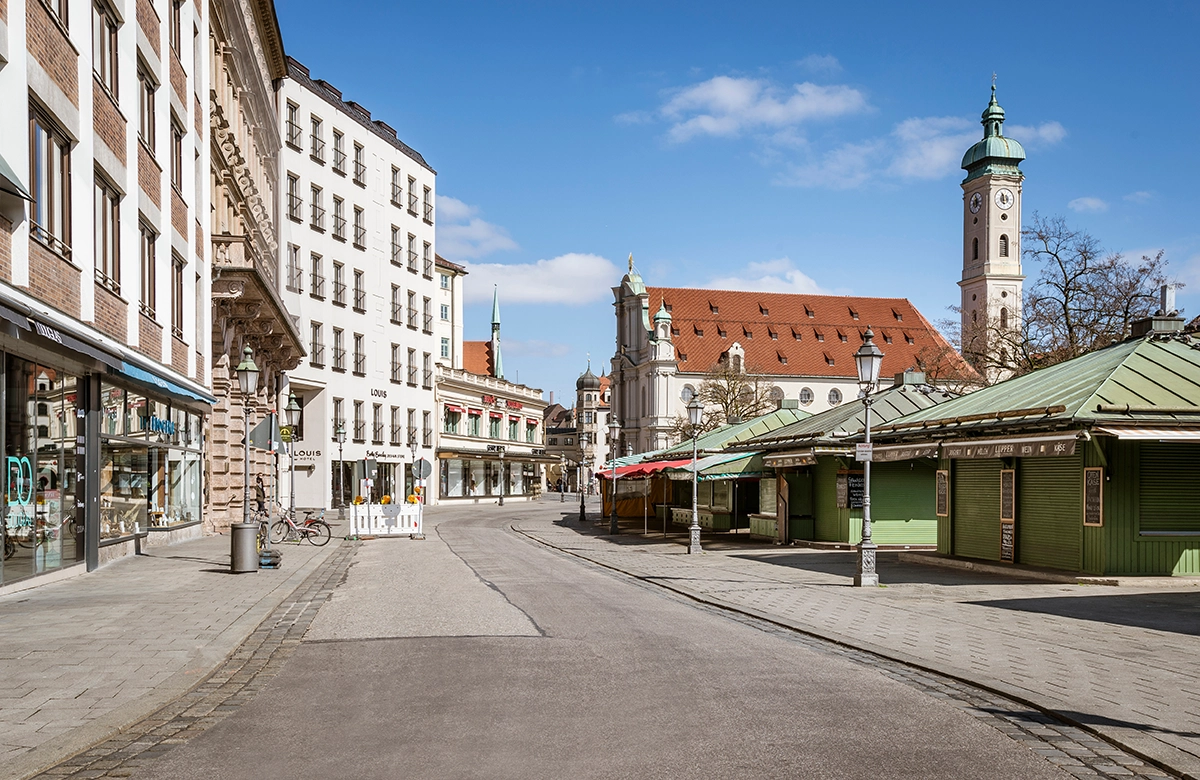
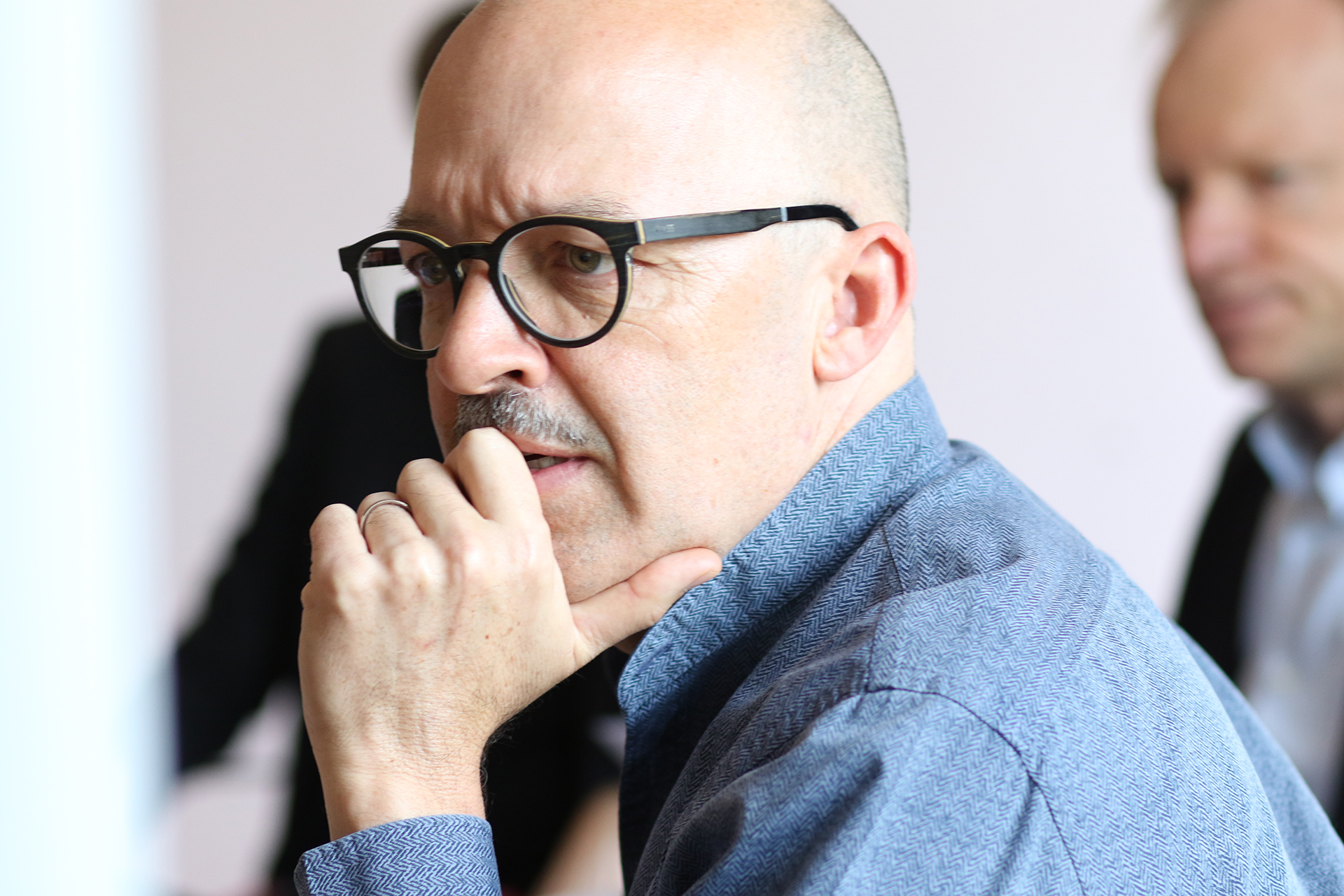
“The Human Factor”
The ifo Institute does not base its economic forecasts solely on statistical and mathematical methods. They are complemented by human expertise. The forecasters contribute their knowledge of economic developments and their experience from many years of economic research and, against this background, make a qualitative classification of the measurement results. This qualitative data is processed in multi-stage analysis processes together with the data and facts obtained, and readable forecast results are obtained by reducing the complex information.
State-of-the-Art Methods: The ifoCAST
The economic forecast can be based on numerous indicators obtained at the ifo Institute itself – most importantly the ifo Business Climate Index – as well as from external sources. There are over 300 leading indicators for Germany alone. In order to condense the wealth of information obtained under very different conditions as effectively as possible, researchers use the latest methods made possible by advances in digitalization. Since 2020, ifo has been using the forecasting tool ifoCAST – a portmanteau of ifo and forecast – which runs fully automatically and thus enables researchers to assess the current economic development at any time and with manageable effort.
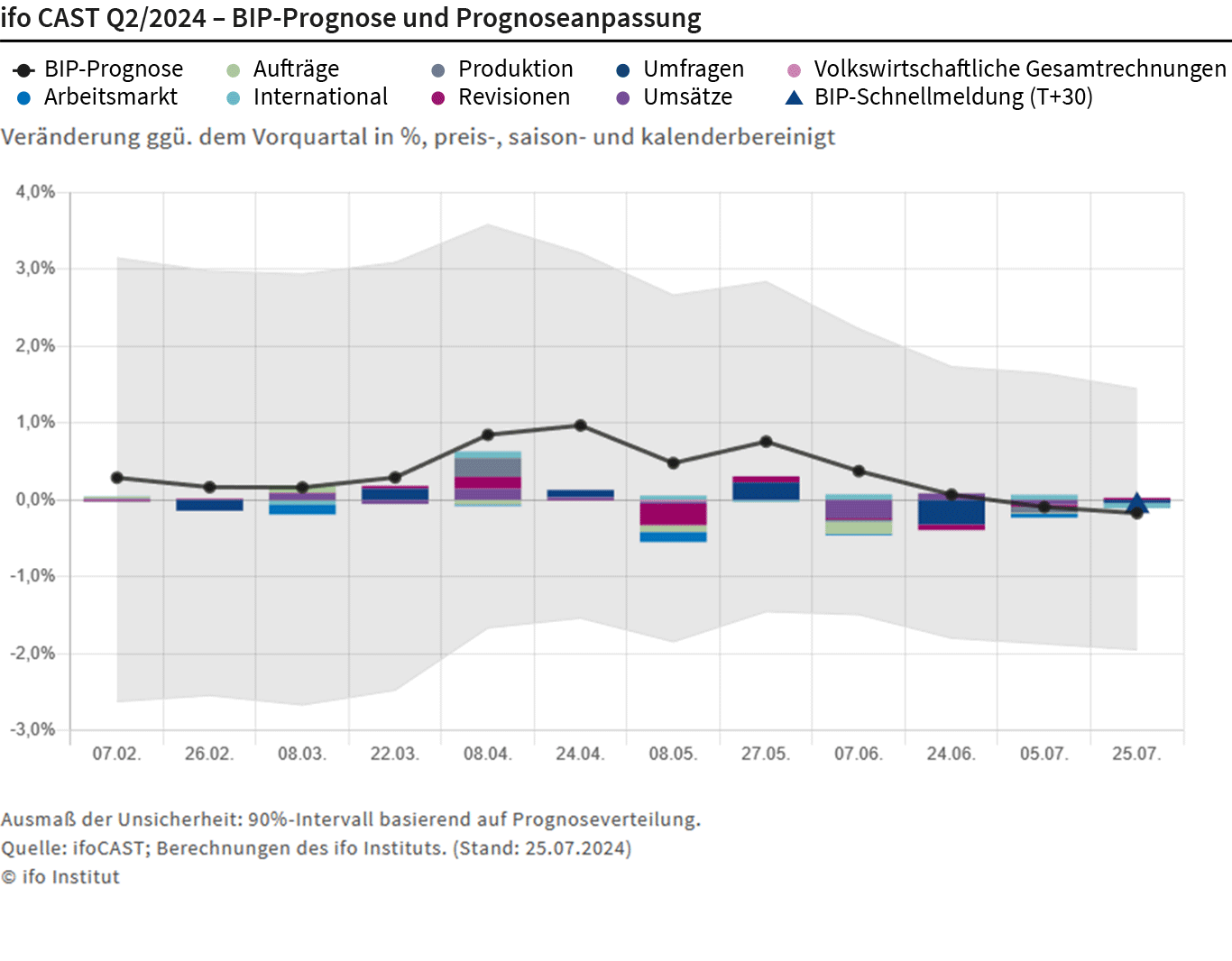
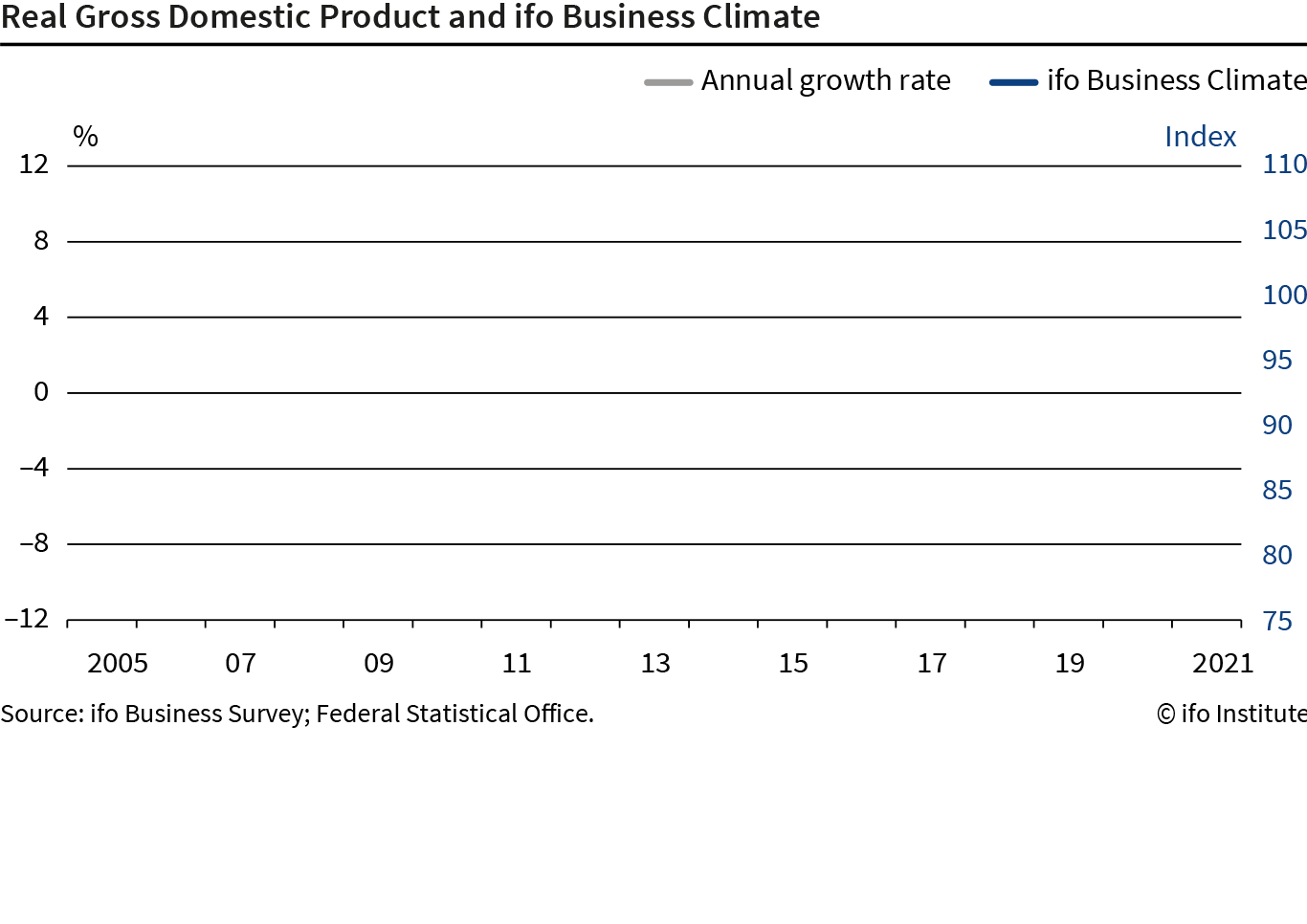
High Reliability Provides Guidance
The ifo Institute’s regular economic forecasts provide guidance for economic decisions. They facilitate the planning of households and companies wishing to invest in real or financial assets and help economic and financial policymakers take appropriate measures.
And they do so with a high degree of reliability: The ifo Institute’s forecast record is impressive. The reliability of the forecasts for the development of real gross domestic product is extremely high. The accuracy of the ifo economic forecasts was also higher on average than the corresponding figures from Consensus Economics, a global survey company that surveys more than 700 economists each month about their forecasts for over 2,000 economic indicators in 115 countries.
Publications
Oskar Anderson: Methods of Business Cycle Research
For nearly four decades, Oskar Anderson was a pivotal figure in shaping the ifo Institute's approach to business cycle research, continuously optimizing its methods step by step through his meticulous scientific contributions. He passed away on March 13, 2006, in Hamburg at the age of 84. From 1970 to 1988, he served as a professor at Ludwig Maximilian University in Munich. In recognition of his vast contributions, a seminar room at the ifo Institute’s main building in Munich has been named “Oskar Anderson” since the early 2000s.
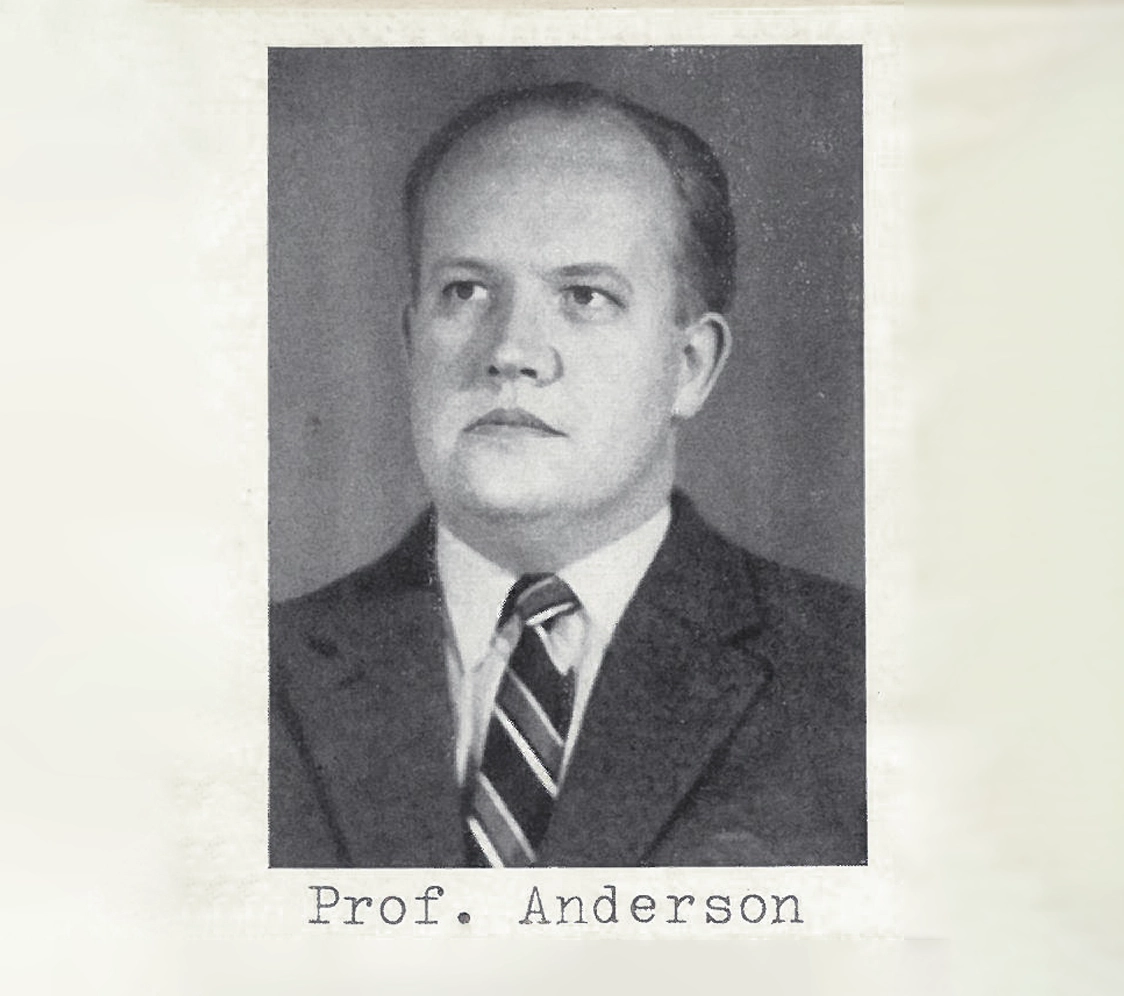
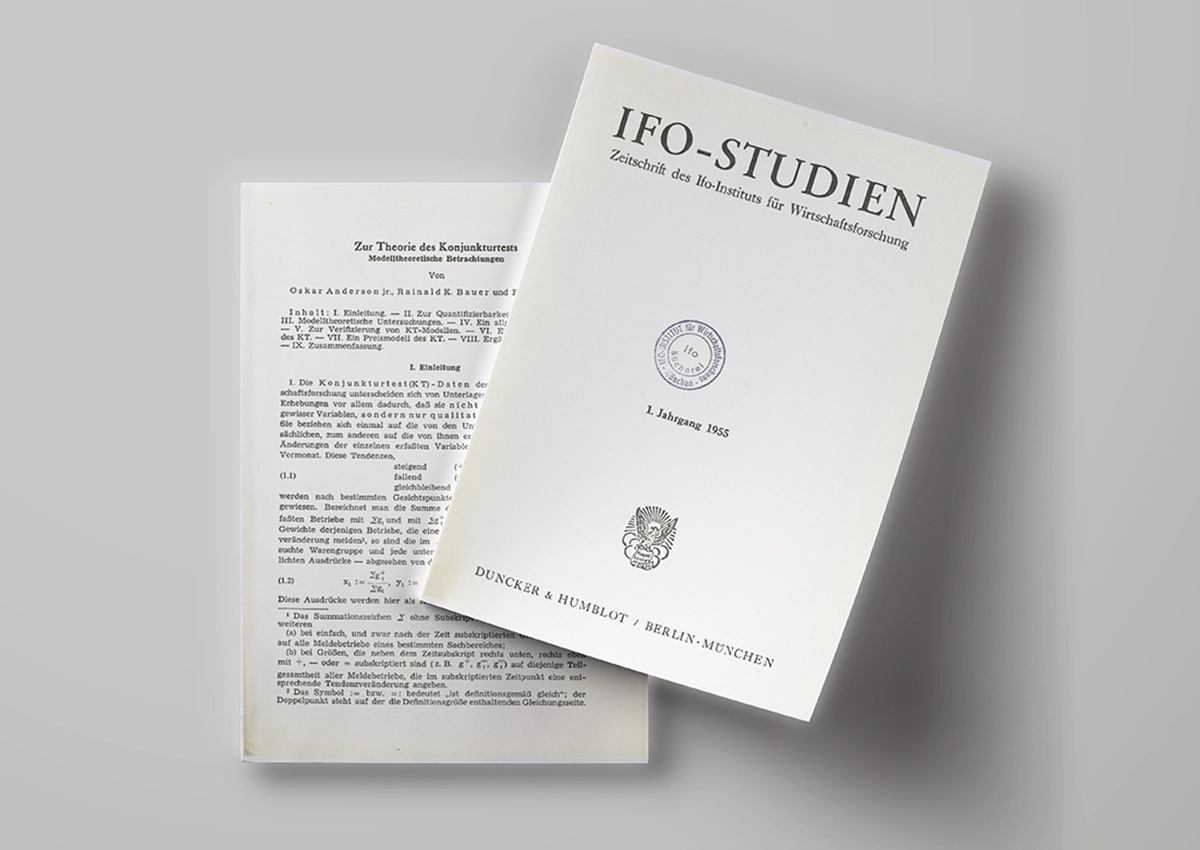
Groundbreaking Foundational Research
Oskar Anderson’s journey in economic research began at the ifo Institute, where he first worked as a student trainee. He completed his economics degree in 1951, and soon distinguished himself with pioneering research in mathematical-statistical methods for analyzing survey data, which deepened the understanding of corporate behavior. His groundbreaking foundational research was published in national and international journals from the early 1950s. The first issue of Ifo Studien, launched in 1955, focused almost entirely on methodological issues related to business cycle tests. Under Oskar Anderson’s leadership, ifo broke new scientific ground through statistical and methodological studies, with the intention of widely sharing and discussing these results.
Legacy in Economic Research
Oskar Anderson’s father, Oskar Anderson Sr. (1887-1960), was a renowned econometrician who laid the foundation for future statistical economic research. In 1935, he founded the “Statistical Institute for Economic Research at the State University of Sofia” (SWIFO) and served as its director until 1942, after which he joined the Kiel Institute for World Economics as head of the Department for Eastern Research. Starting in 1947, he taught as a full professor at the University of Munich. Anderson Sr. was also a founding member of the ifo Institute, attending its inaugural meeting on January 24, 1949. He remained actively involved in shaping the institute's future through his long-standing membership on both the Board of Trustees and the Research Advisory Board. His son, Oskar Anderson Jr. (1922-2006), contributed significantly to the development and optimization of the ifo Business Survey from the early 1950s onwards.
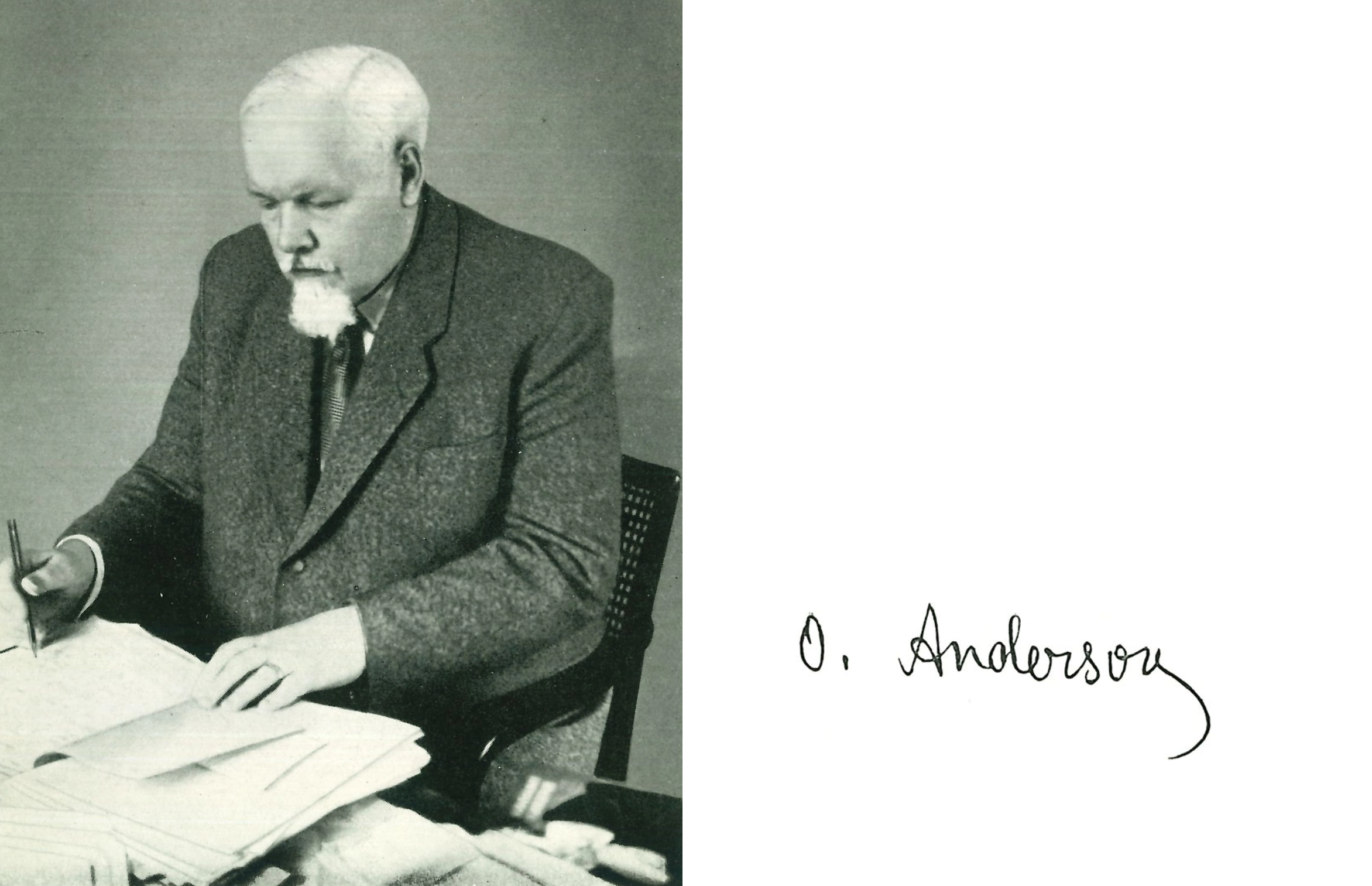
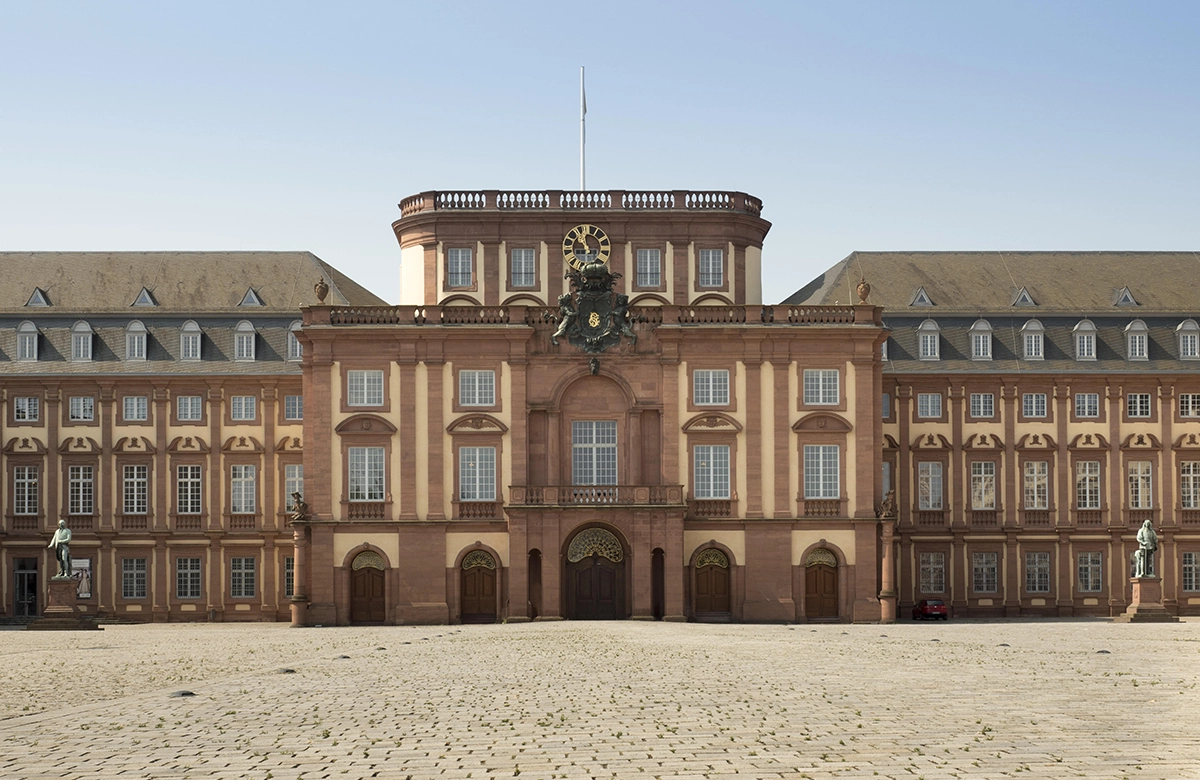
Paternal Concerns and Academic Career
Oskar Anderson Sr. expressed paternal concerns to the ifo Executive Board, worrying that his son was becoming overly absorbed in practical matters related to company surveys instead of focusing on his habilitation. However, these concerns proved unfounded. In 1962, Oskar Anderson Jr. embarked on a successful academic career, becoming a Professor of Statistics at the University of Mannheim. In 1970, he moved to Ludwig Maximilian University in Munich, where he taught until his retirement in 1988.
Innovations in Survey Methodology
From the early stages of the ifo Business Survey, Oskar Anderson Jr. was deeply involved in refining the theoretical foundations of survey methodologies. As an expert in statistics, he strongly believed in the ability of microdata to predict corporate behavior reliably. His pioneering work included transforming qualitative survey responses into quantitative indicators and assessing how accurately these qualitative data reflected real economic conditions. His research on seasonal adjustment and the precision of business expectations had a transformative impact on the ifo Institute.
Oskar Anderson remained associated with the ifo Business Survey until 1988. Over the course of his four decades of scientific involvement, the ifo Business Climate Index—based on the ifo Business Survey—attained the methodological reliability that today establishes it as a globally respected economic indicator.
People
Peggy and Richard Musgrave: Together for Financial Policy
The British-American public finance scholar Peggy Brewer Musgrave (1924–2017) and the German-American economist Richard Abel Musgrave (1910–2007) gained renown for their research on public finance. In recognition of their academic contributions and their close association with the ifo Institute, a seminar room in the ifo Institute’s main building in Munich has been named the “Musgrave Room” since the early 2000s.
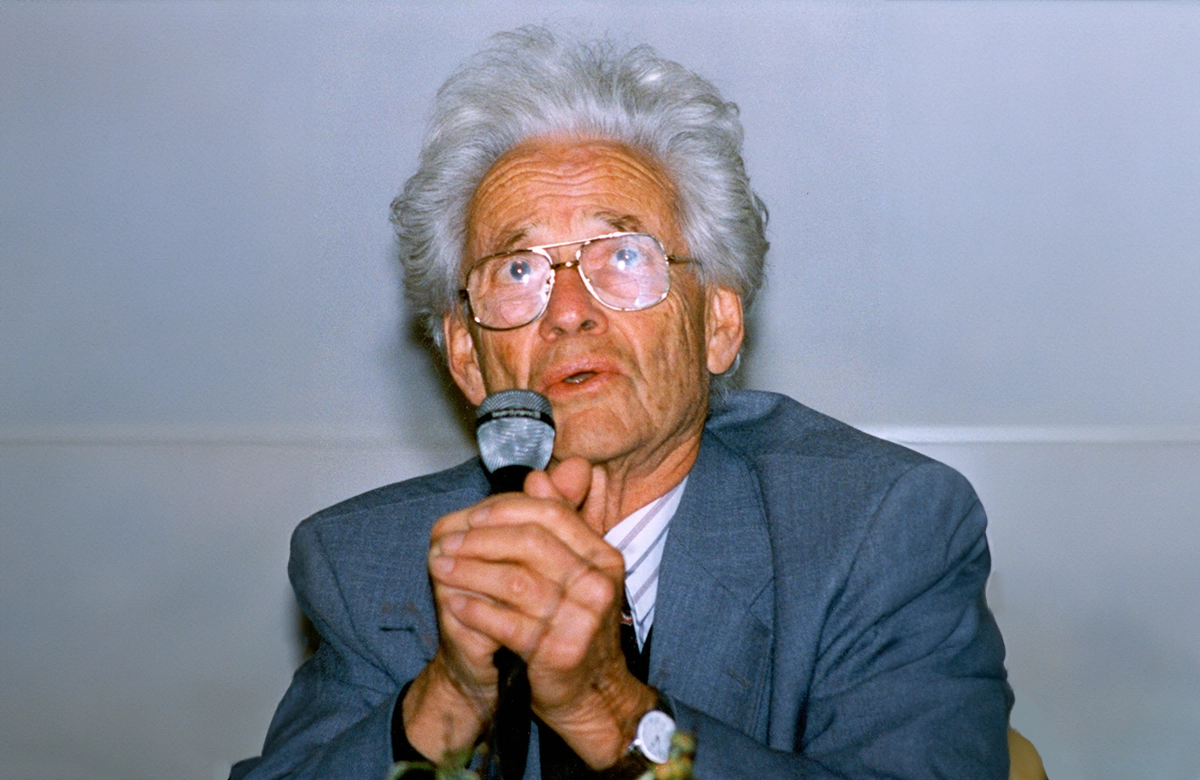
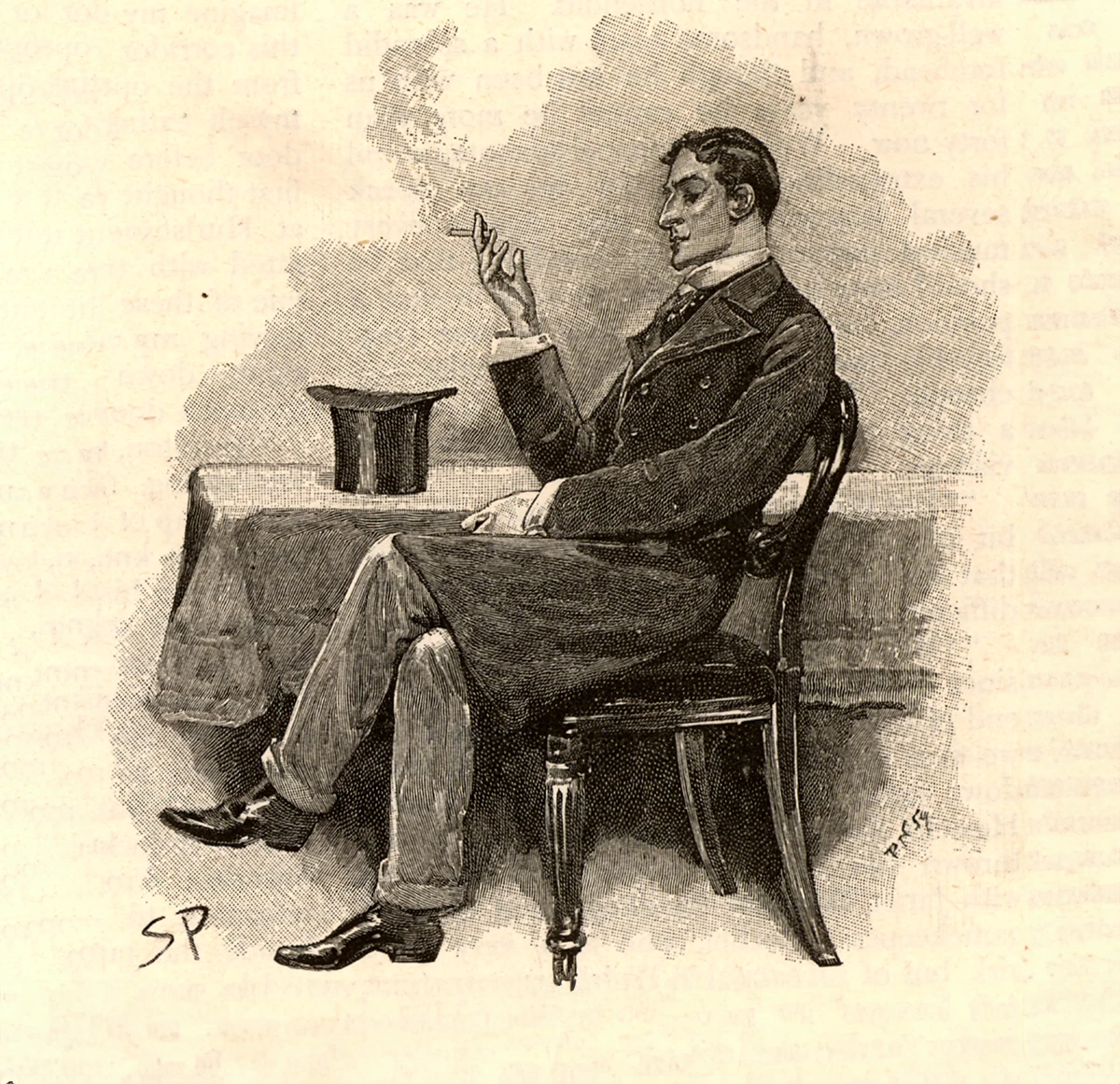
Arthur Conan Doyle as Namesake
Richard Musgrave was born in Königstein im Taunus in 1910 and grew up in an intel-lectually rich environment. His father, Curt Abel, was a socialist, author, and transla-tor. He decided to adopt a second surname that would sound more familiar in the Anglo-American world and chose “Musgrave,” inspired by the family name in Arthur Conan Doyle’s Sherlock Holmes short story, “The Musgrave Ritual.”
Richard Abel Musgrave began his economics studies after graduating from high school in 1930 at the University of Munich and continued in Heidelberg, where he studied under Jakob Marschak, Alfred Weber, and Otto Pfleiderer, completing his degree in 1933. In the fall of 1933, Musgrave received a scholarship to study in the USA. As a member of a family with Jewish roots, he had experienced the anti-Semitic attitudes of the National Socialist regime in Heidelberg and decided not to return to Germany.
Wartime and Careers
Richard Musgrave continued his academic career at Harvard University, where he completed his Ph.D. in 1937 and began his career as a professor of economics. After the war, he taught at some of the most prestigious U.S. universities, including Michi-gan, Princeton, and Johns Hopkins.
His future wife, British-born Peggy Brewer, began her studies at Cambridge Universi-ty in 1942. After the war, she resumed her studies in economics, earning her Ph.D. from Johns Hopkins University in 1962. She then taught international economics at the University of Pennsylvania from 1963 to 1965. The couple met in Pennsylvania in the early 1960s and married. They later moved to Cambridge, Massachusetts, where Richard was appointed Professor of Public Economics at Harvard University, and Peggy worked as a Senior Research Associate at the International Tax Program at Harvard Law School. In 1979, both were appointed to the University of California, Berkeley, where they taught until their retirement.

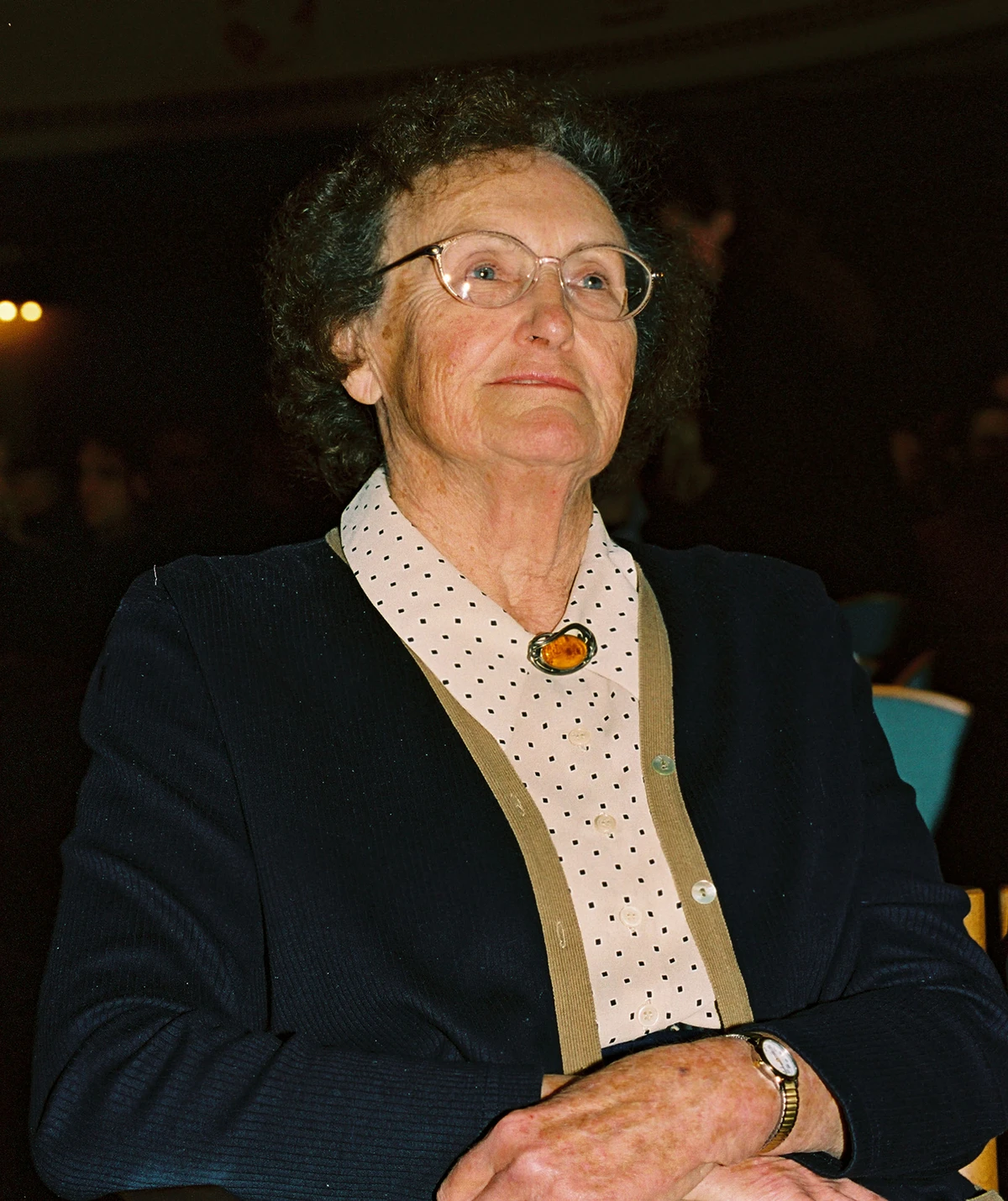
From “Capital Export Neutrality” to “Merit Goods”
Peggy and Richard Musgrave explored various topics in their research on public finance, analyzing the role of the state in a market economy. Richard developed a framework suggesting that government intervention should serve three main goals: allocation efficiency, economic stabilization, and redistribution.
Peggy’s primary focus was on international taxation, especially the taxation of foreign investments by companies. She introduced the concept of "capital export neutrality"—the idea that tax systems should be designed so that differences in tax rates between countries do not influence investors' location decisions, as each investor is ultimately subject to the tax rate of their home country, regardless of whether the income comes from domestic or foreign sources.
Richard Musgrave coined the concept of “merit goods,” such as education, which would be underconsumed if left solely to market forces. Musgrave explained that the benefits of such goods are difficult for individuals to recognize, leading to market failure. He argued that the state should intervene to promote or even mandate the consumption of merit goods through subsidies and legislation. This concept, however, is problematic from the perspective of traditional welfare economics, which emphasizes consumer sovereignty.
Joint Publications
In 1959, Richard Musgrave published the book Theory of Public Finance, which established his reputation and was first translated into German in 1966 under the title Finanztheorie. In 1968, Peggy and Richard Musgrave jointly published Fiscal Policy. This was followed in 1973 by their seminal work Public Finance in Theory and Practice, which remains available today in three volumes under the German title Die öffentlichen Finanzen in Theorie und Praxis and continues to serve as a fundamental text for academic teaching.
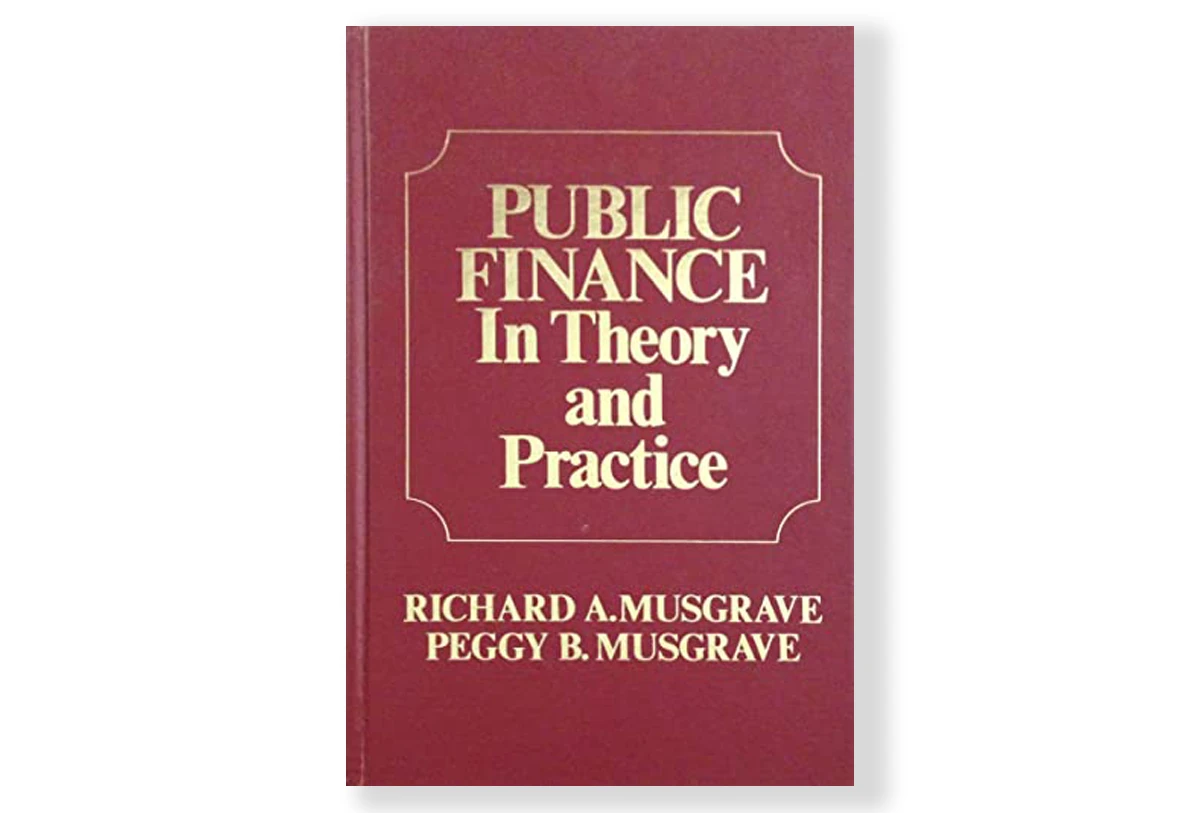

Musgrave and CESifo
Since 1978, Richard Musgrave had been one of the most influential members of the International Institute of Public Finance (IIPF). Founded in Paris in 1937, the institute is the leading international organization for public finance research. Its members form a global network that promotes academic research and the exchange of ideas between academia and politics. Since 2003, the IIPF has awarded the “IIPF Peggy and Richard Musgrave Prize.”
In 1991, at the initiative of Hans-Werner Sinn, Richard Musgrave became a founding member of the Center for Economic Studies (CES) at the University of Munich. That same year, he published the first CES Working Paper titled Social Contract, Taxation and the Standing of Deadweight Loss.
A year after Richard Musgrave's death in 2008, the IIPF and CESifo established a visiting professorship at the University of Munich in honor of the distinguished economist. The President of CESifo and the President and Vice-Presidents of the IIPF select the awardee through a formal selection process. In 2024, this professorship was awarded to Henrik Kleven, Professor of Economics and Public Affairs at Princeton University.
People
Promote and Demand: The Hartz Reforms
Agenda 2010, introduced by Germany’s red-green coalition government under Chancellor Gerhard Schröder, was a sweeping program designed to improve the competitiveness of German companies in global markets. A cornerstone of these reforms was the restructuring of social benefits for the unemployed, which came into effect on January 1, 2005, and is widely known as the Hartz reforms, named after Peter Hartz, the architect of the concept.

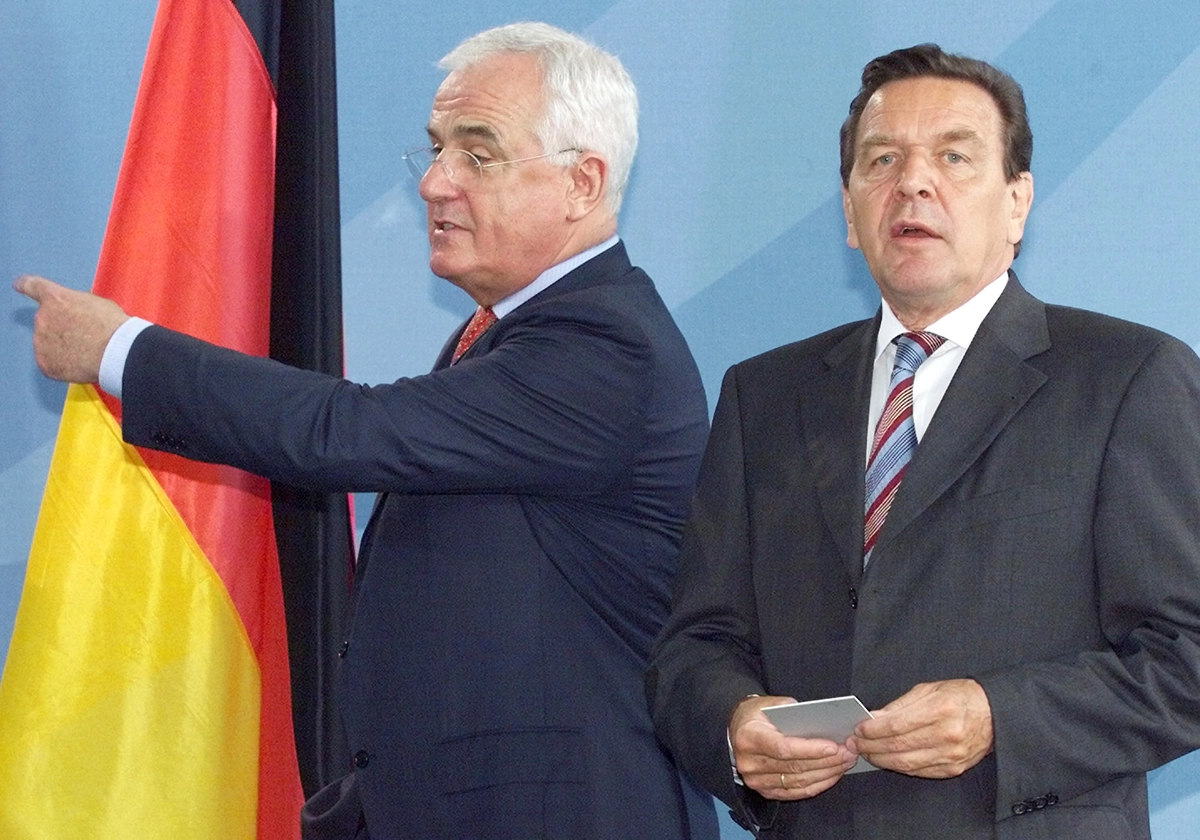
Objective: Stimulate the Labor Market
The “Fourth Act for Modern Services on the Labor Market,” commonly referred to as Hartz IV, combined unemployment benefits with social assistance and aimed to reduce unemployment significantly. This reform benefited both employers and employees by reducing unemployment insurance contributions.
The legislation provided a basic economic safety net for unemployed individuals capable of working but lacking sufficient income or assets to support themselves. The program actively encouraged a return to work through targeted job placement services, vocational training, and educational programs. However, participation was mandatory—those who declined assistance risked cuts to their benefits. The guiding principle was simple: to “promote and demand.”
The Origins of the Hartz Reforms
Peter Hartz, a trade unionist, Social Democrat, and Volkswagen AG’s head of Human Resources from 1993 to 2003, chaired a commission tasked with proposing labor market reforms. Between 2002 and 2004, these proposals were implemented in four stages, labeled Hartz I through Hartz IV. The reforms aimed to reduce unemployment, cut social expenditure, and eliminate incentives for misuse of unemployment benefits as a long-term substitute for work. The core principle was to ensure that gainful employment provided higher income than state support, which was sharply reduced during this period. Despite fierce resistance from trade unions and social organizations, Chancellor Schröder pressed ahead with the reforms.
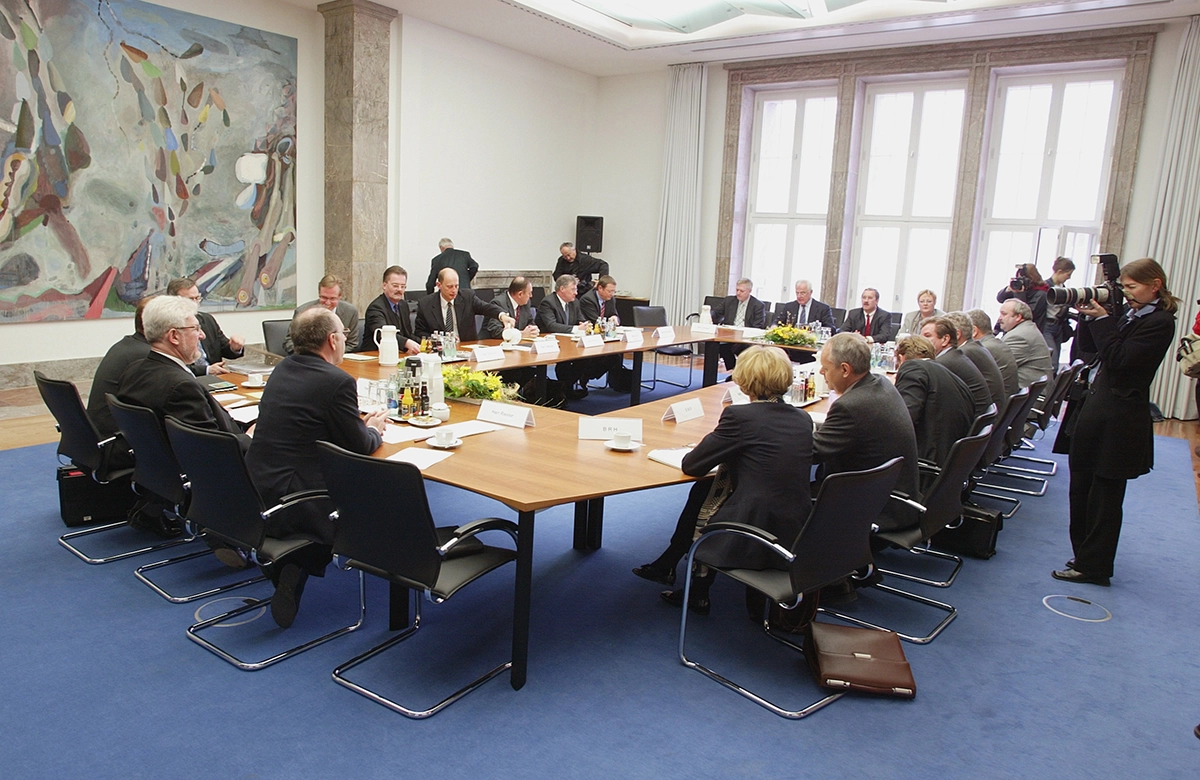
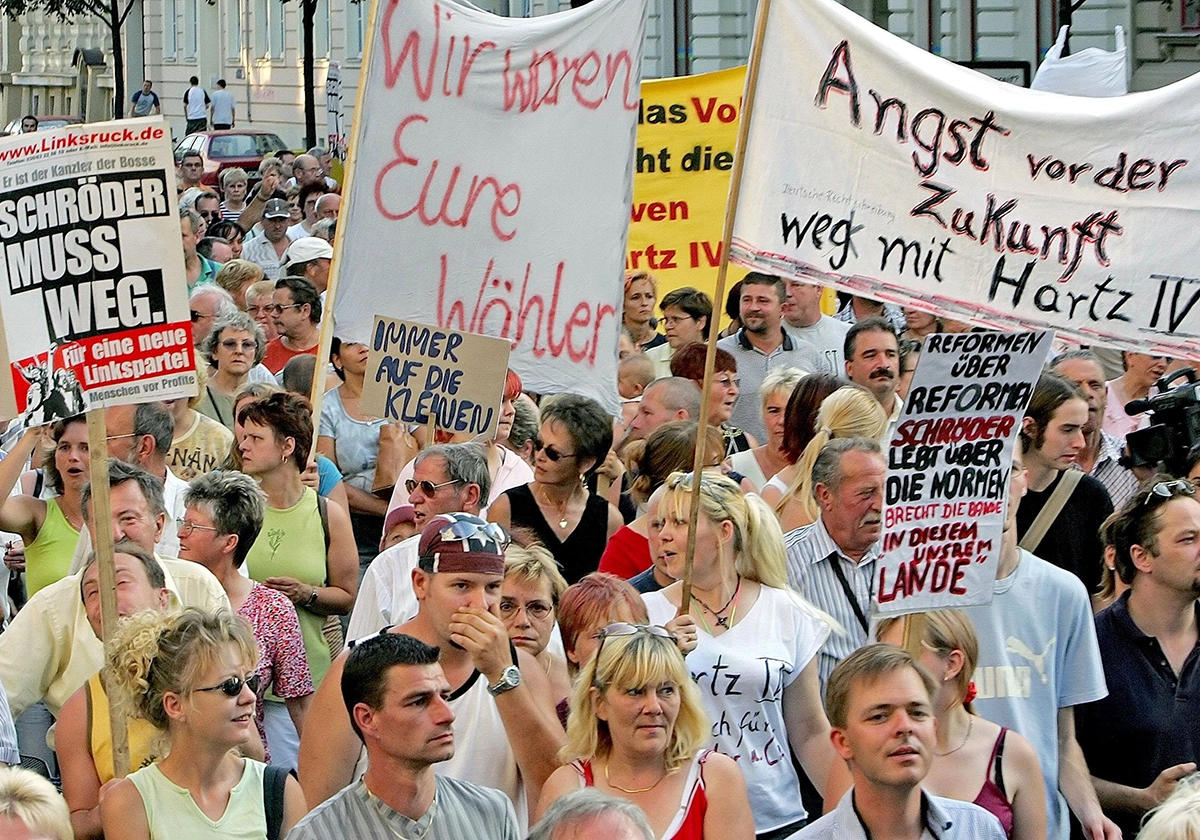
ifo’s Blueprint for Reform
In May 2002, the ifo Institute published a study proposing a more active approach to social assistance. The report highlighted how welfare systems, instead of counterbalancing market forces, often exacerbated labor market inefficiencies. Social assistance at the time functioned as a de facto wage floor, discouraging employment at lower wages and preventing companies from offering jobs in the low-wage sector.
The ifo study suggested that insufficient wages could be supplemented by state funds, but only if individuals were required to work according to their abilities. By removing the option to opt out of the labor market entirely, the proposal aimed to incentivize companies and private households to create new jobs. This proposal laid the groundwork for key aspects of the Hartz reforms.
The Introduction of Unemployment Benefit II
The most transformative element of Hartz IV was the merger of unemployment benefits with social assistance into a single program, Unemployment Benefit II (ALG II). This new system was funded by taxes and tailored to address evolving societal needs.
By the late 20th century, Germany’s social security system faced a breaking point. Rising unemployment and deficits strained resources, making indefinite funding through tax revenues unsustainable. Hartz IV introduced a unified, tax-financed basic benefit for long-term unemployed individuals, shifting some of the financial burden from contributors to taxpayers.
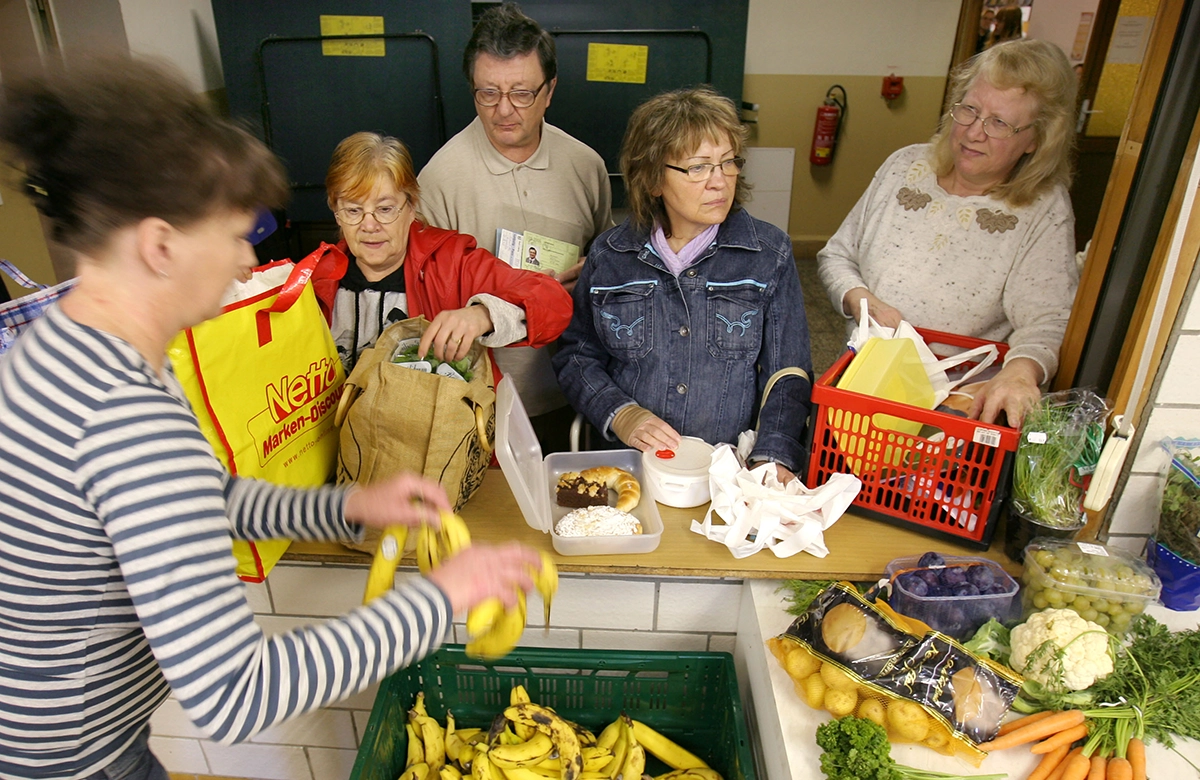
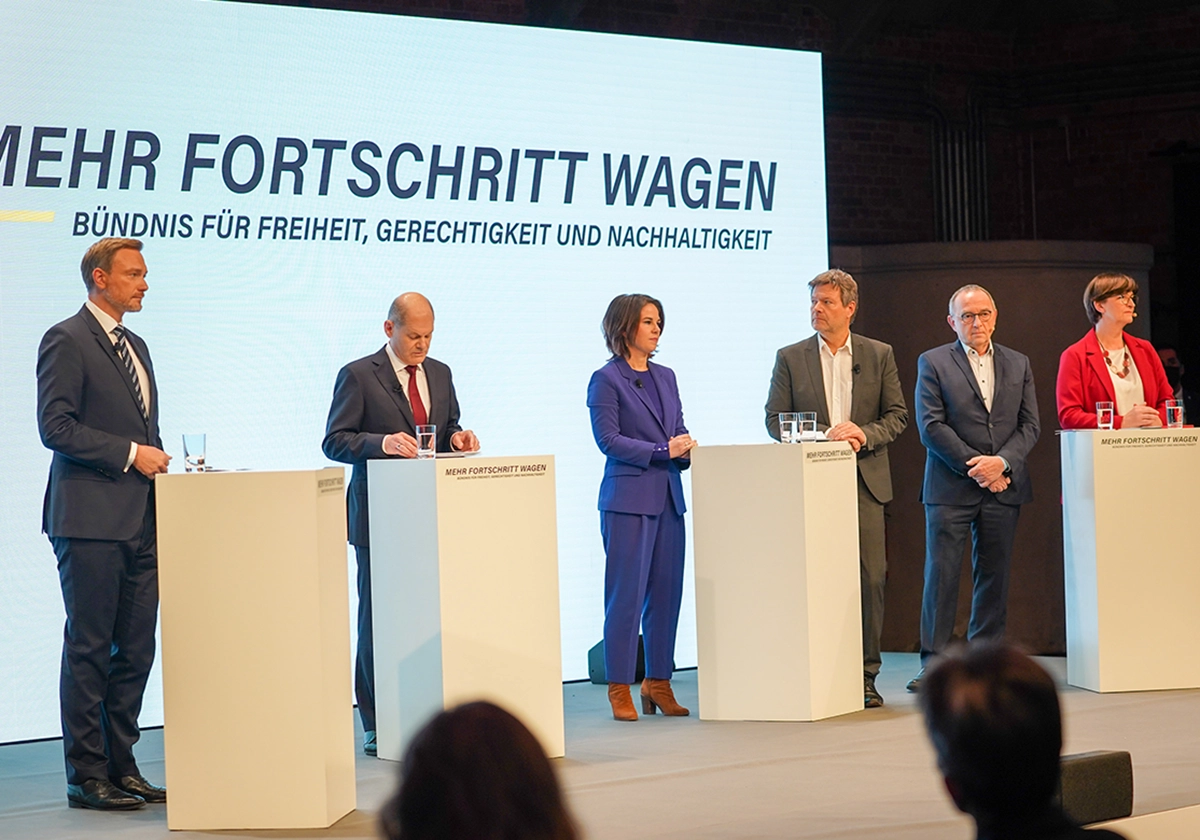
Calls for Further Reform
In the years following Hartz IV, debates over its effectiveness intensified. Issues such as benefit levels, sanctions, and the types of jobs deemed “reasonable” for unemployed individuals became points of contention. The ifo Institute contributed to these discussions, offering extensive analyses and proposing new concepts. In February 2019, the institute presented a reform plan that gained renewed attention in 2021 when Germany’s coalition government pledged to update Hartz IV.
The ifo Institute stressed the need to eliminate disincentives within the system. It argued that individuals receiving basic income support should have stronger motivation to accept higher-paying jobs to thus reduce their reliance on state aid. Additionally, the institute emphasized addressing “hidden poverty” among those receiving other forms of assistance, such as housing or child supplements, who did not technically count as Hartz IV recipients but still struggled financially.
On January 1, 2023, Germany marked the end of the Hartz IV era with the introduction of a new citizen’s income system.
Milestone
Reorientation – The ifo Institute in the 1990s
The German Council of Science and Humanities regularly assesses research institutions that are financed by taxpayers’ money – such as the Leibniz Association’s institutes, one of which is ifo. In 1996, the results of this assessment were negative and consequently the competent committee of the Council of Science and Humanities recommended to the Joint Commission of the Federal and State Governments responsible for continuation of funding that the ifo Institute should no longer be supported. The final decision was to be made in January 1997. A cessation of funding would have meant the end of the ifo Institute.
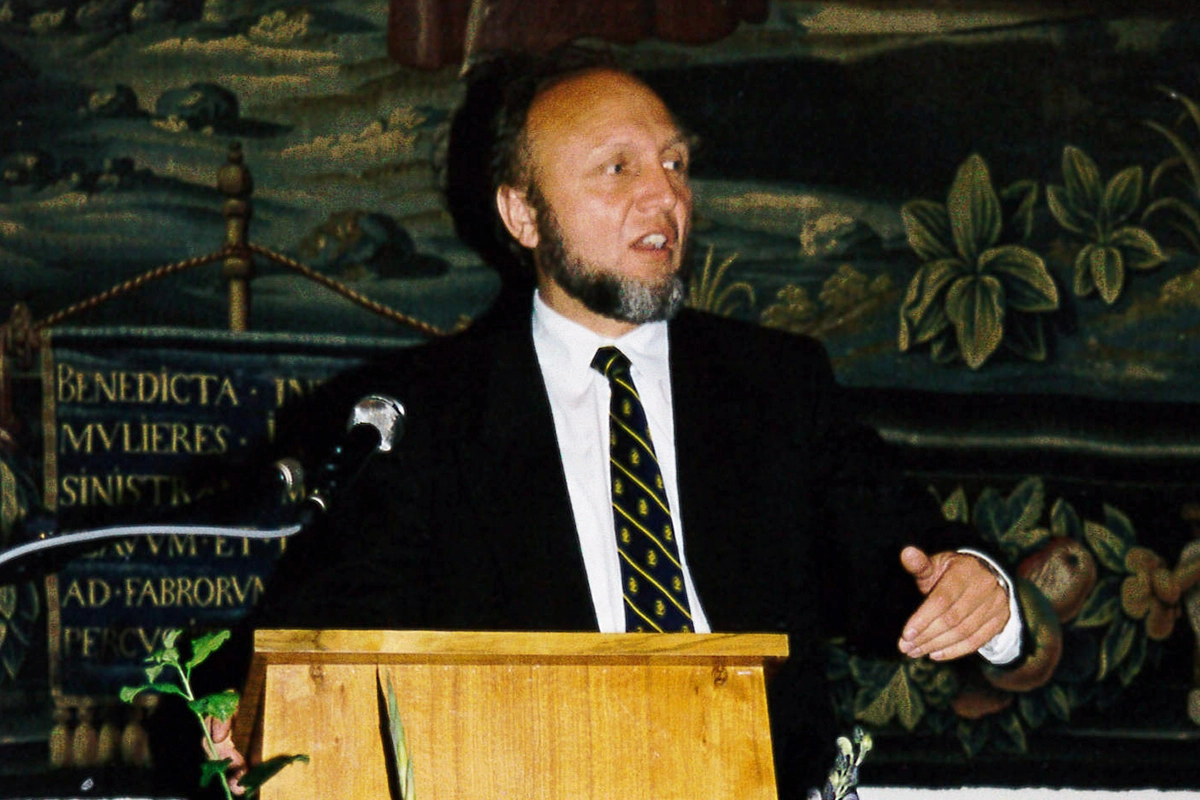

The Reputation
The further development and differentiation of business cycle analysis and, above all, the targeted observation of individual sectors were core fields of work at the ifo Institute and in particular addressed practical needs. Karl Heinrich Oppenländer, President of the ifo Institute from 1976 to 1999, was considered one of the outstanding economic observers of his time. Well into the 1990s, the ifo Institute’s reputation was founded on the quality of its economic surveys and practical research projects. That met the expectations of political decision-makers, but not quite those of the Council of Science and Humanities. Back in 1982, the latter expressed its mission in an assessment as being “to obtain proof of publications in internationally recognized, peer-reviewed and top-class journals that not only involved an interesting issue, but also demanded a profound theoretical and econometric foundation.” (Hans-Werner Sinn in his autobiography “Auf der Suche nach der Wahrheit” (“In Search of the Truth”).
The Evaluation
The German Council of Science and Humanities announced that its representatives would evaluate the ifo Institute on October 14 and 15, 1996. Meinhard Knoche, who had been appointed Managing Director on September 1, 1995, and had previously been Deputy Director of Administration and Head of the Human Resources Department at the Konrad Adenauer Foundation, endeavored to prepare for this evaluation by reorienting the Institute in line with the requirements of the Council of Science and Humanities. To achieve that goal and even before he officially took office in mid-1995, he initiated the reorganization of the entire IT infrastructure and a departure from the continuous personnel expansion of past years. He aimed for a gradual, socially responsible reduction in the headcount. Above all, however, he strove to develop a new mission statement and set up a certified quality management system.
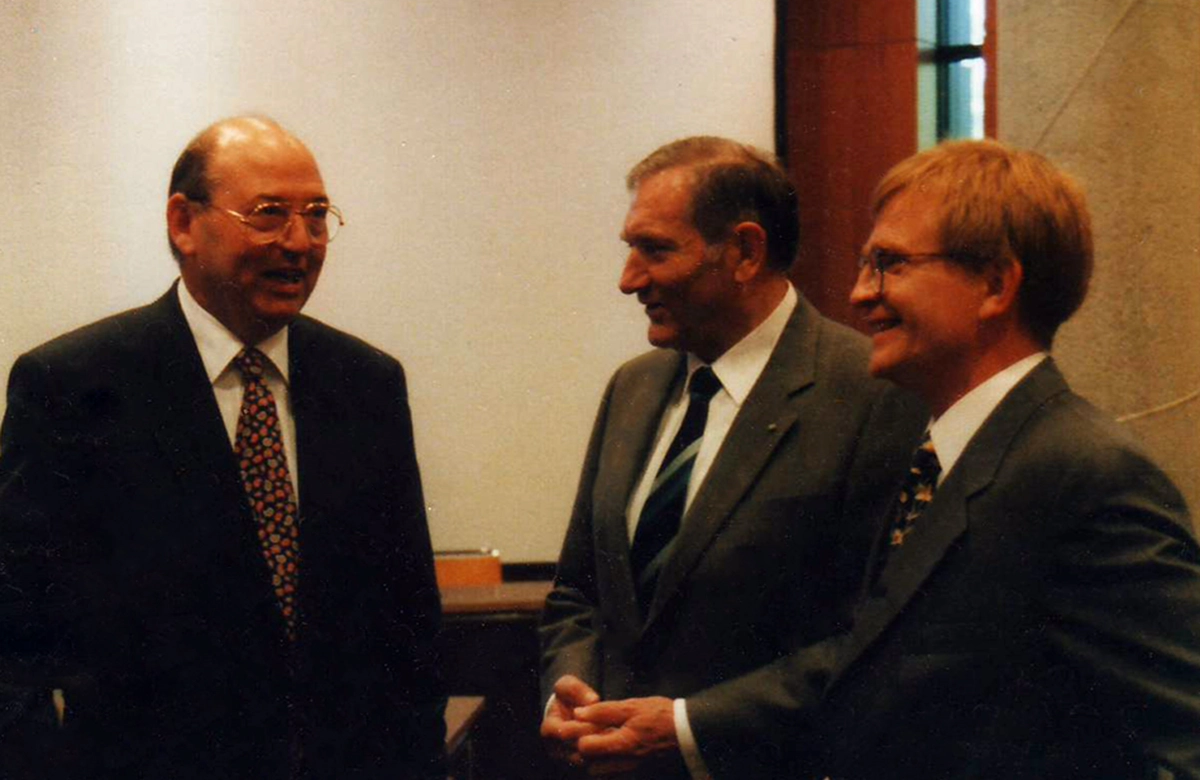
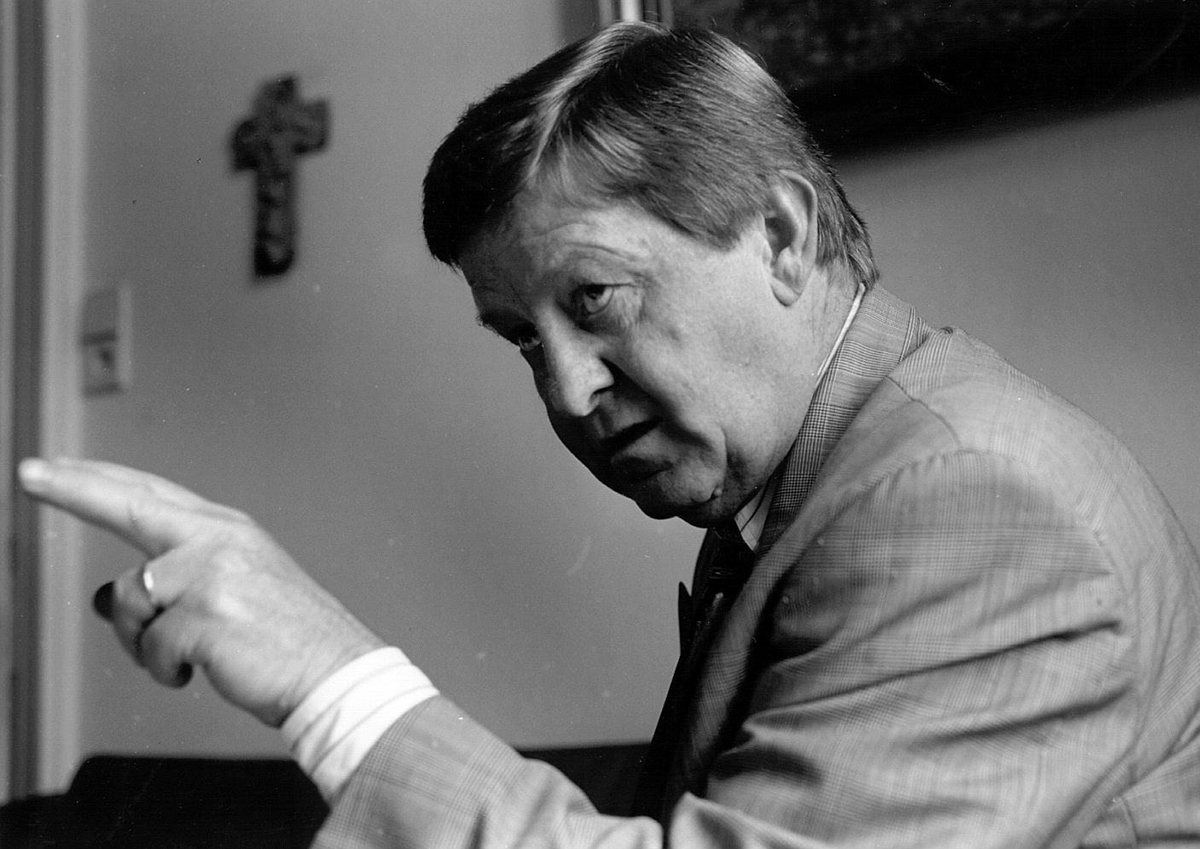
Buying Time
The draft resolution by the Council of Science and Humanities, which was revealed shortly before Christmas 1996, contained alarming statements: Considerable deficits in the methodological and theoretical foundation of most of the ifo Institute’s scientific work were identified. The commission recommended ending the ifo Institute’s funding as a research institution within the framework of the ‘Blue List Scientific Community’ (later the Leibniz Association). Time had to be bought before this draft resolution could be adopted in January 1997. Bavaria’s Minister of Economic Affairs Otto Wiesheu and, on the federal side, the State Secretary Johannes Ludewig intervened forcefully in the process and succeeded in having the decision on the resolution postponed. A working group of the German Council of Science and Humanities was set up prepare an expert opinion on the open questions by the end of 1997.
A Second Chance
The task now was to make immediate use of the time gained and to initiate a change in strategy that would reduce dependence on contract research, yet create freedom for scientists to publish ambitious research projects in peer-reviewed scientific journals as soon as possible.
An important component of this change in tack was the cooperation agreement concluded with the LMU Munich on September 11, 1997, which envisaged the joint appointment of the future ifo President (with a chair at the LMU), the participation of ifo scientists in teaching, collaboration in the areas of research and the encouragement of young academics, and representation of the LMU on the supervisory body.
Furthermore, ifo’s Bylaws were to be reformed so as to strengthen the Executive Board, the Board Council was dissolved and replaced by the Administrative Council, and the Scientific Advisory Council was enshrined in the Bylaws. Seven research areas (instead of the previous 17 specialist departments) bundled the human and material resources. As a result, the institute was able to work far more efficiently.
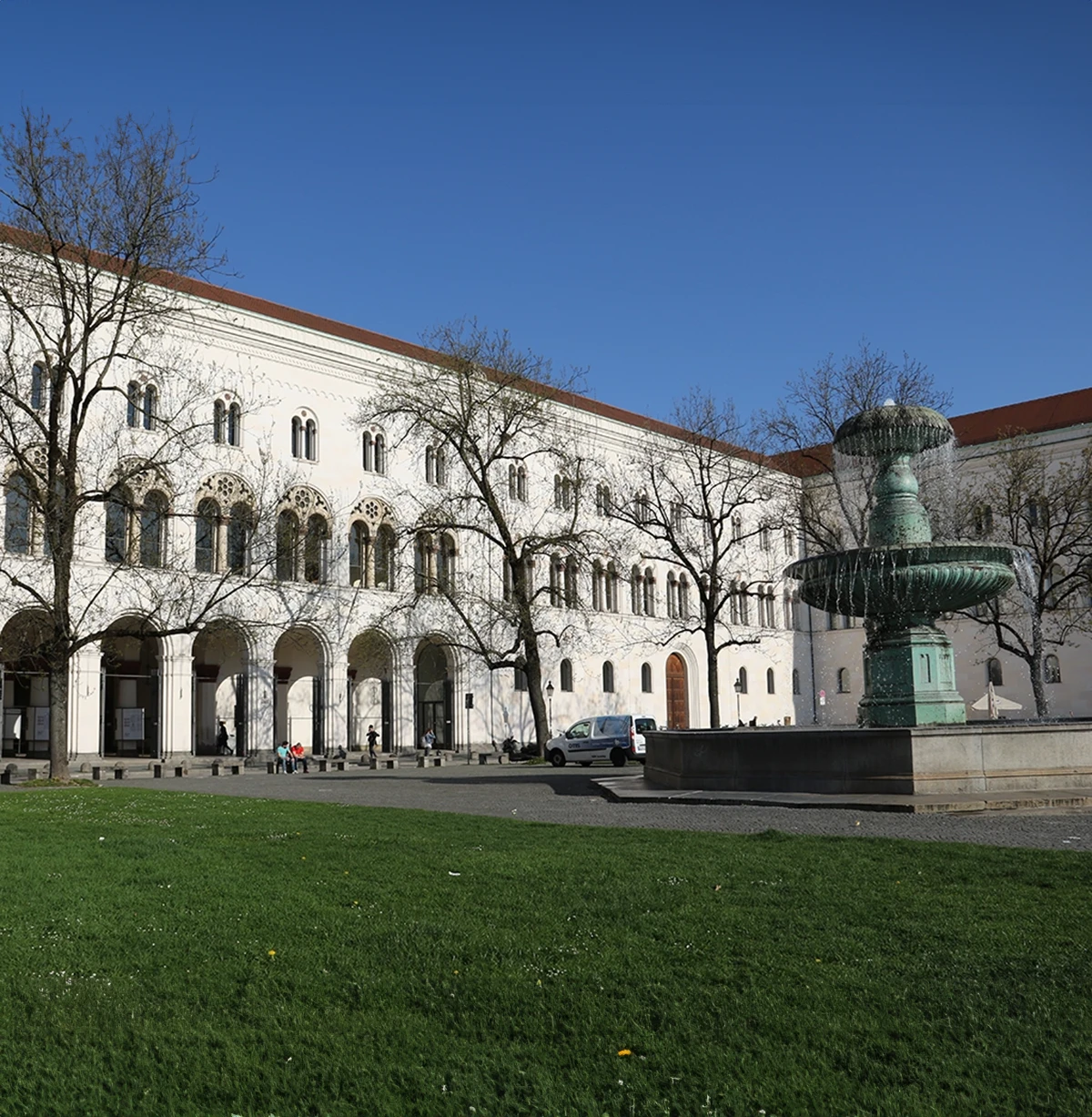
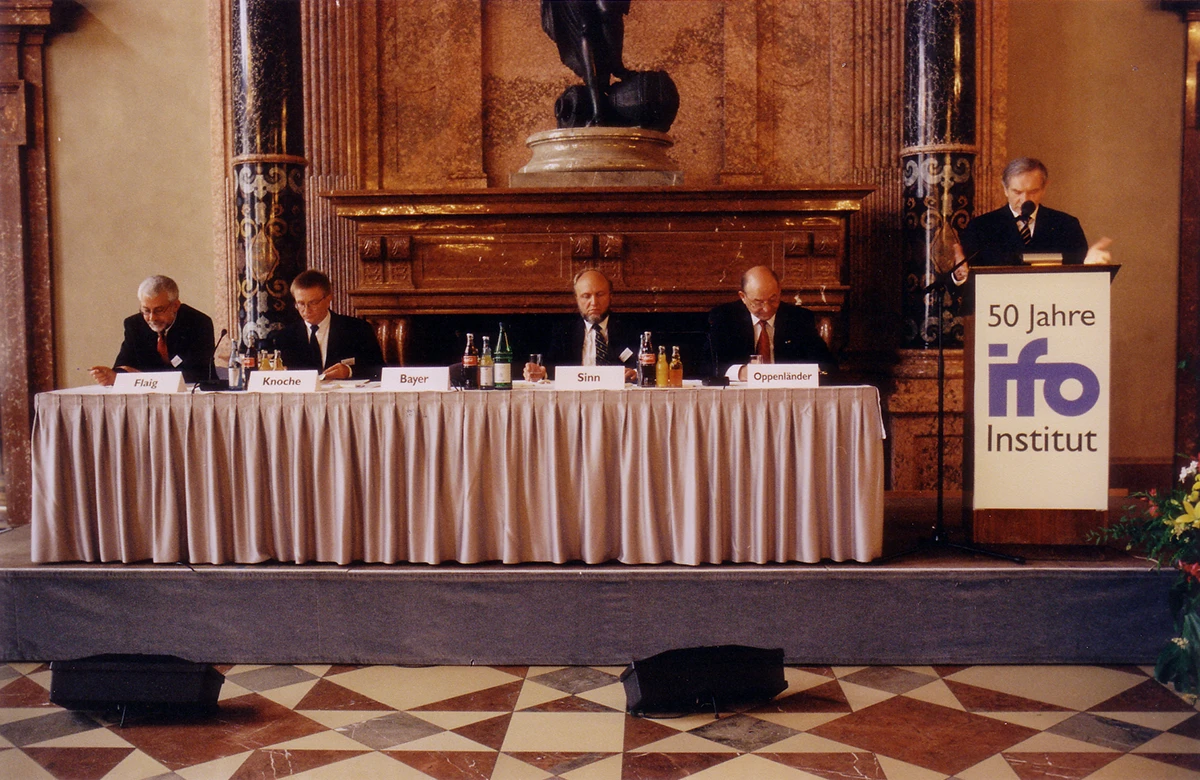
A Big Sigh of Relief
The Council of Science and Humanities concluded the pending evaluation process on January 23, 1998. To sum up its working group’s opinion, contract research had expanded at the ifo Institute and the vast majority of research work exhibited deficits. However, the service-oriented empirical work, such as the business, investment and innovation surveys in particular, were of national importance and merited funding. The funding bodies of the Joint Commission of the Federal and State Governments recommended that the ifo Institute should no longer be supported financially as a research institute, but rather “as a research-based service institution.” At the same time, the ifo Institute’s basic budget was to be restricted.
A New ifo President
Further research funding by the federal and state governments (Blue List), which was vital for the institute’s continued existence, was secured. And despite the burdens caused by the evaluation process and internal reforms, ifo employees’ scientific productivity and productivity in projects funded by third parties improved significantly in the years 1996 to 1998.
In the course of 1997, Bavaria’s Minister of Economic Affairs, Otto Wiesheu, contacted Hans-Werner Sinn in order to recruit him as the ifo Institute’s new President. Hans-Werner Sinn had completed his habilitation at the University of Mannheim and had held the Chair of Economics and Insurance at the Faculty of Economics at LMU since 1984. In 1991, he was given the opportunity to establish the Center for Economic Studies (CES). In order to arouse Sinn’s interest in taking over as ifo President, the minister held out the prospect of developing the CES as an international research network – and that was how CESifo was born. The appointment of Hans-Werner Sinn, whose high academic reputation was to accelerate the ifo Institute’s transformation from a service organization back into a research institute, proved a success. The appointment commissions established by ifo and LMU unanimously recommended his engagement, and the Administrative Council elected Hans-Werner Sinn as President of the ifo Institute at its meeting on December 10, 1998. The new ifo President’s term of office began on February 1, 1999.
Note: For the sources used in this text, click on the imprint.
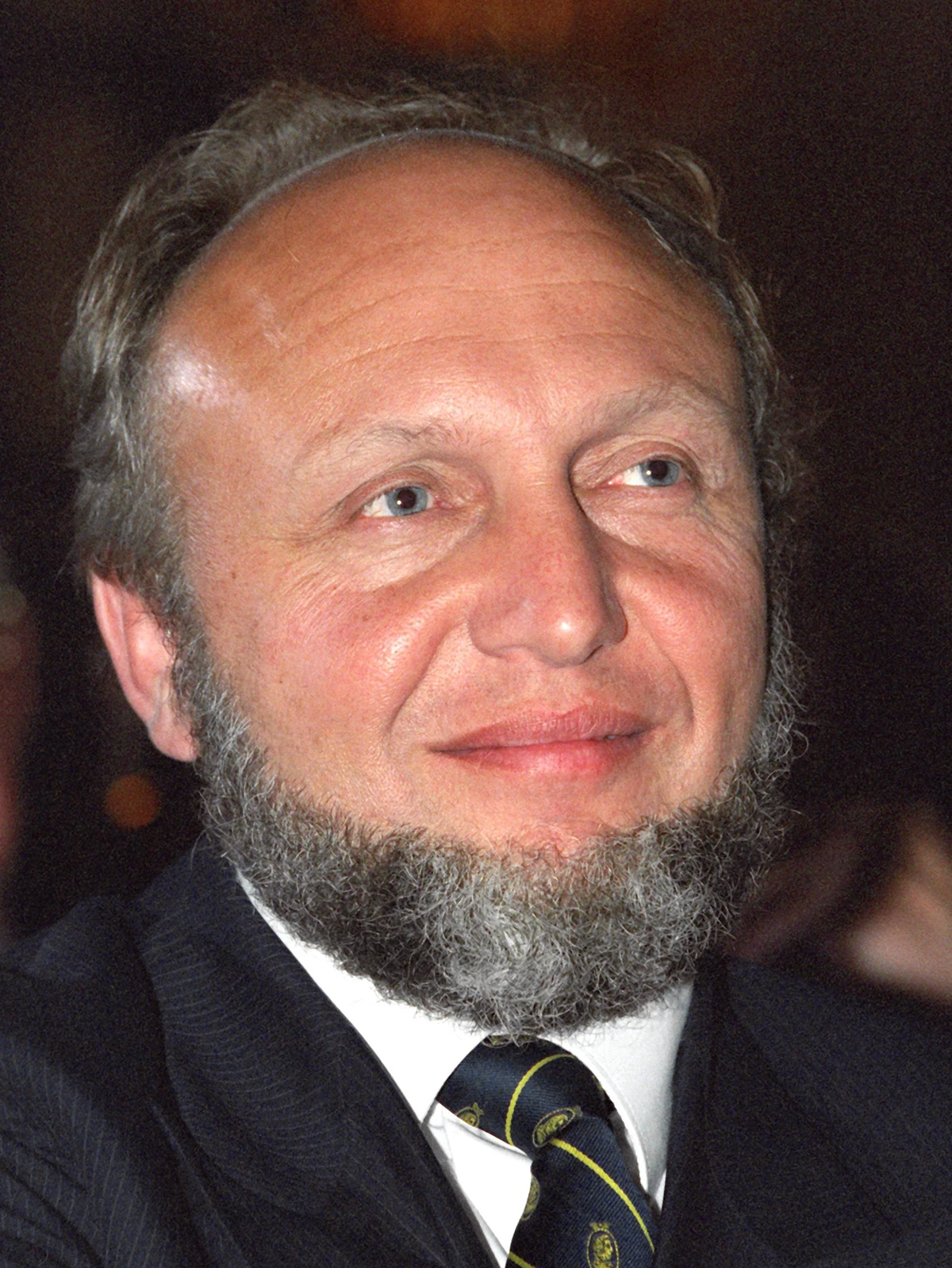
Impulse
Tackling Recession: The Stability and Growth Act of 1967
After the prosperous years of Germany’s “economic miracle,” the first clear signs of a recession emerged. In response, on May 10, 1967, the German Bundestag passed the “Act to Promote Stability and Growth in the Economy” by a substantial majority. The Federal Government aimed to achieve four major objectives: full employment, price stability, external economic balance, and economic growth – collectively known as the “magic square.” The ifo Institute has consistently supported these measures with up-to-date data.
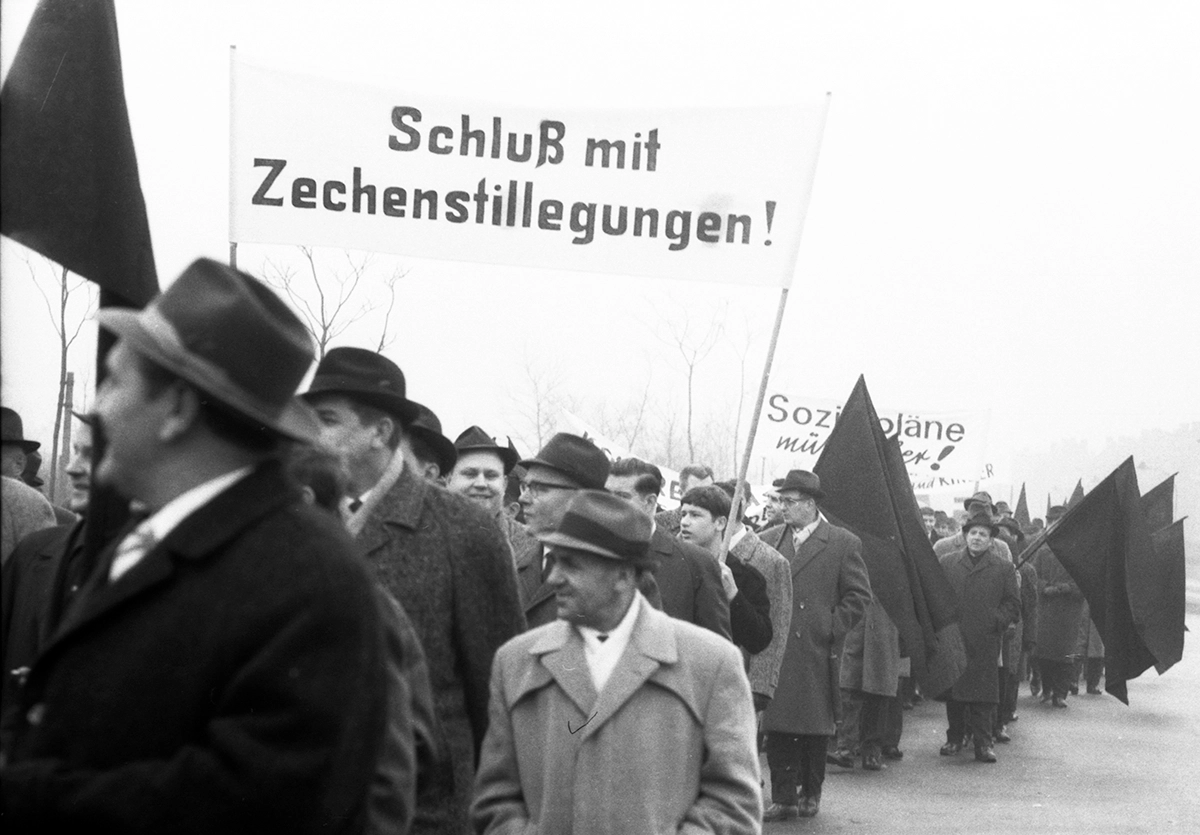
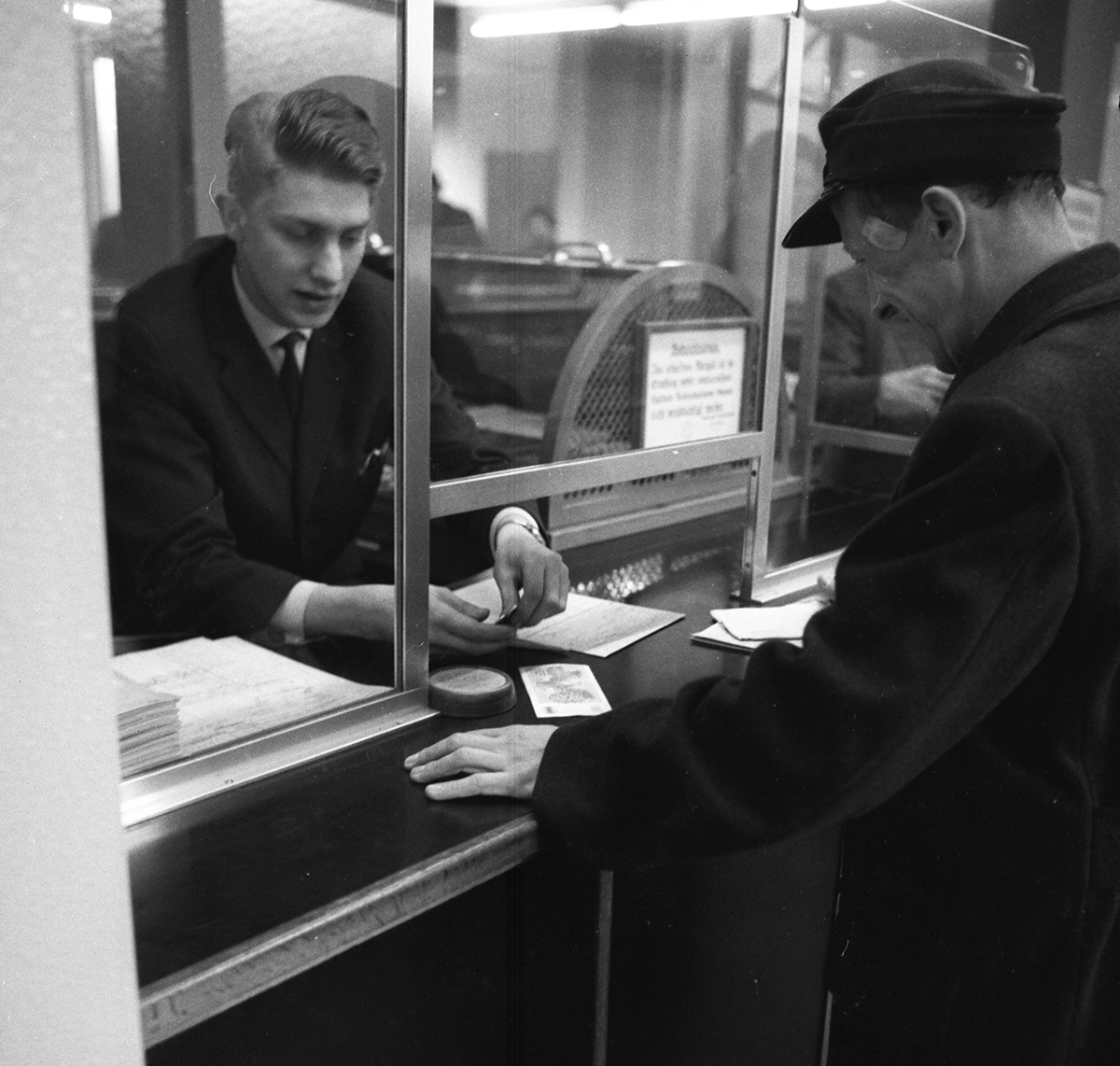
Germany’s First Economic Crisis
Between the fall of 1966 and the summer of 1967, the Federal Republic of Germany faced its first significant economic downturn. The unemployment rate increased from 0.7 to 2.1 percent. Prices rose, while wages barely moved. The budget situation became precarious, making subsidy cuts and social policy reductions seem inevitable. Political disagreements over the federal budget culminated in the dissolution of the Christian-Liberal government under Chancellor Ludwig Erhard in October 1966. Following Erhard’s resignation on November 30, a grand coalition of the CDU/CSU and SPD took over government responsibilities for the first time on December 1, 1966.
New Government, New Economic Policies
Chancellor Kurt Georg Kiesinger (CDU) announced an expansionary and stability-oriented economic policy in his government declaration on December 13, 1966. The economic crisis was to be countered with stimulus programs and the newly introduced Stability Act. The new Federal Minister of Economics, Karl Schiller (SPD), advocated for an “enlightened market economy” – mix of competitive markets and state oversight, contrasting sharply with Ludwig Erhard’s preference for a free market economy with minimal state intervention. The Bundestag set the stage for the first economic stimulus package on February 23, 1967, with the Credit Financing Act, which authorized 2.5 billion Deutsche Mark, with 850 million Deutsche Mark earmarked for immediate measures including investments in federal railways, postal services, and road construction. Legal authorization was required for the necessary loans. Federal Finance Minister Franz Josef Strauss (CSU) had introduced the necessary Credit Financing Law. At the same time, the Bundesbank lowered key interest rates.
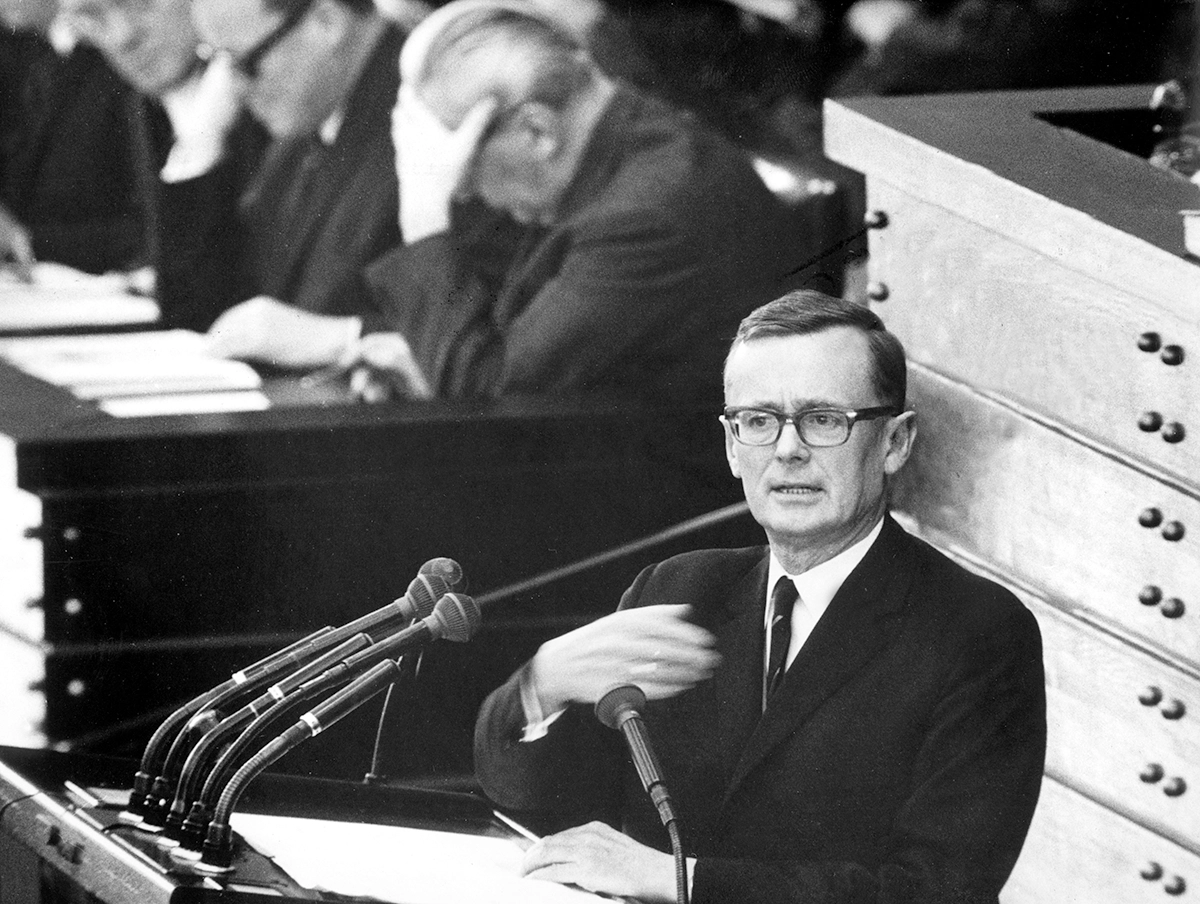
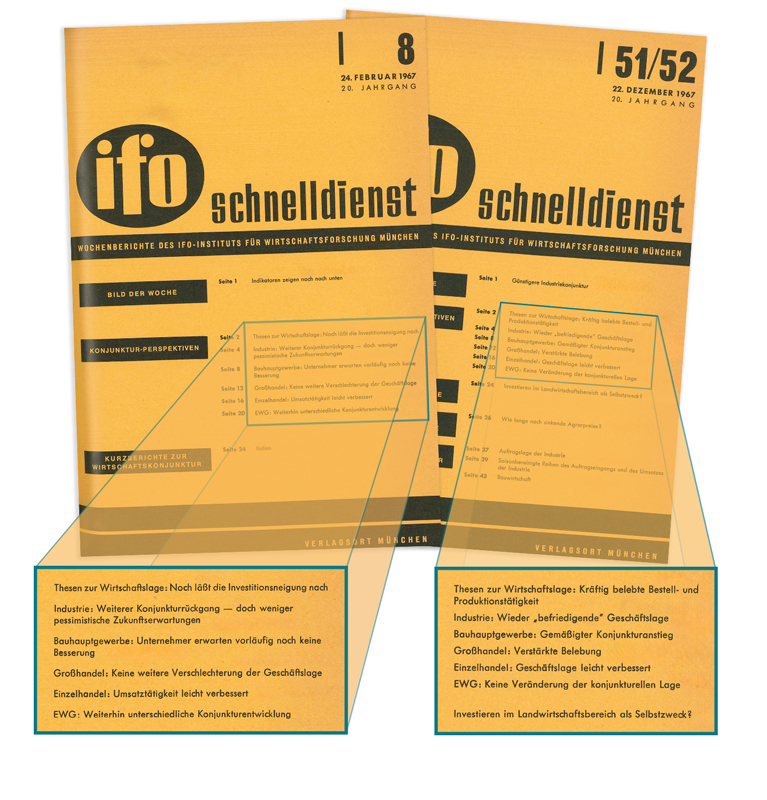
Ongoing Evaluation by the ifo Institute
Just a day after the Bundestag passed the Credit Financing Act, the ifo Institute summarized the situation in its ifo Schnelldienst publication on February 24, 1967: “The economic stimulus measures adopted by the Federal Government and the effects on the capital market from the reduction in the bank rate and the minimum reserve rates suggest that investment activity will pick up this year.” Data from the ifo Business Survey, the GfK consumer survey, and the Federal Statistical Office collected on March 17, 1967, indicated it was too early to declare a definitive shift in economic sentiment. Even the lecture by ifo board member Herbert Hahn printed in the Schnelldienst of June 19, 1967 merely explains “The current economic problems.” Only towards the end of 1967 did economic prospects start to improve as policymakers had hoped. The ifo Schnelldienst reported a strong increase in demand for capital goods in November, with the business climate in the manufacturing industry finally being assessed as predominantly positive by year’s end.
“A Table on Four Legs”
The Stability Act mandates that the federal government must present an annual economic report as a foundation for its actions, and every two years, a subsidy report must be published to disclose the development of financial aids and tax concessions. Economics Minister Schiller described the law as transitioning from a conventional to an enlightened market economy, likening it to a stable table standing firmly on four legs, grounded in rational insight and cooperation.
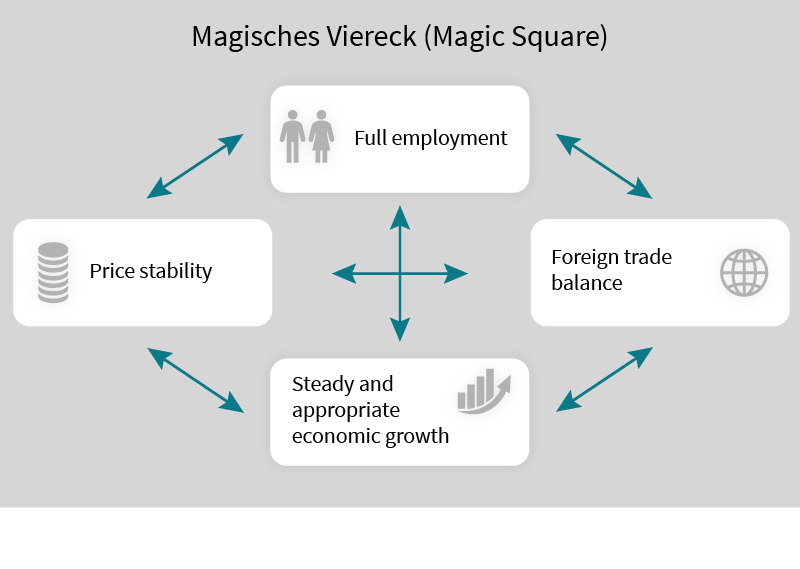
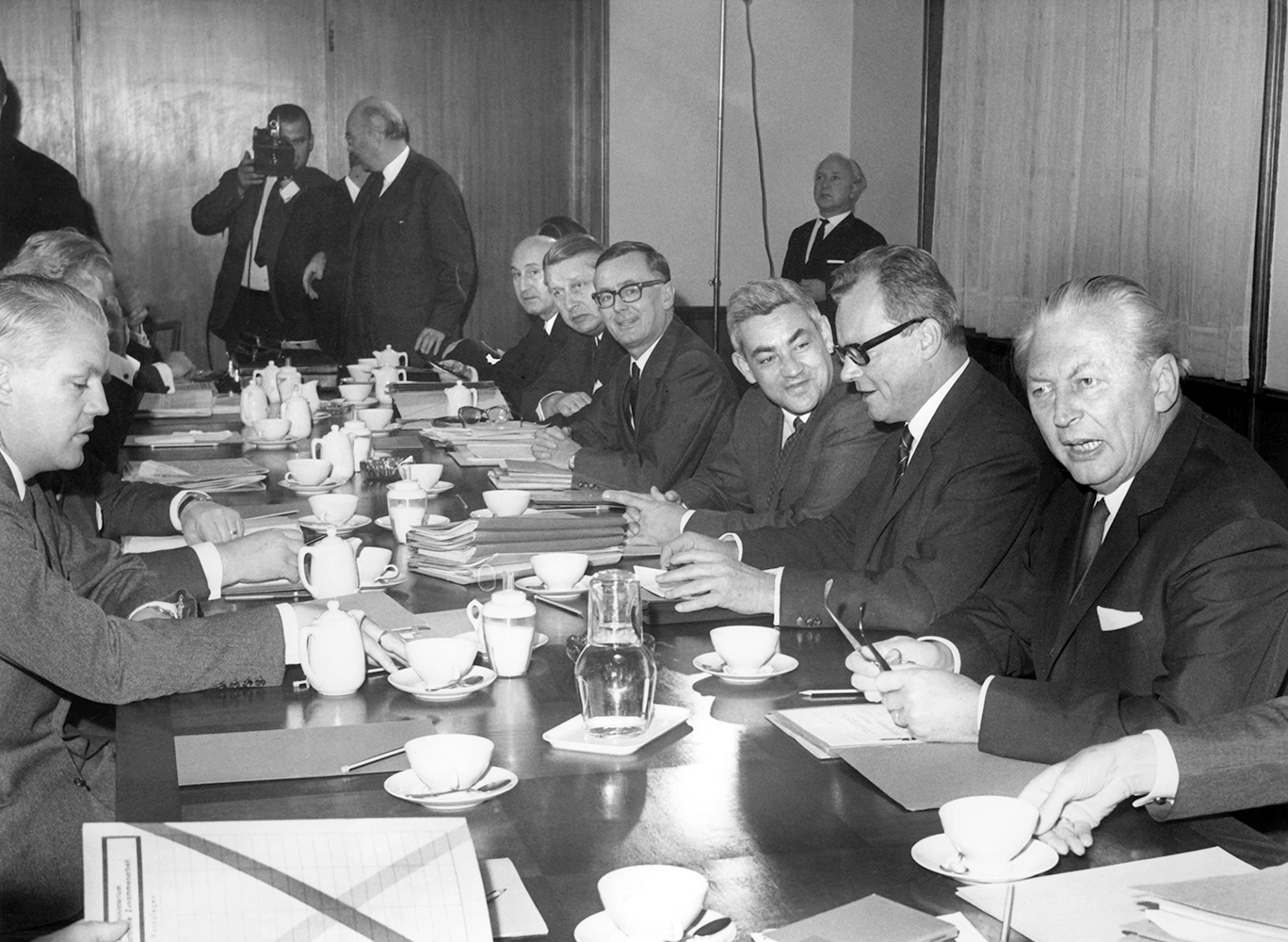
A Law with Lasting Impact
Unlike earlier proposals from the black-yellow coalition, the new federal government – and all that followed – were to pursue not only sound fiscal policies but also cyclically sensitive economic strategies. If circumstances required it, the federal cabinet would have the legal means to burden or relieve the economy with government measures, depending on the economic conditions. By the end of the 1969 legislative period, unemployment had fallen to 0.9 percent, and by 1970, it reached a low of 0.7 percent, nearing full employment. However, the 1973 oil crisis tested the limits of state economic control, leading to a surge in public debt and necessitating a reevaluation of the economic stabilization reserve. Since the Stability and Growth Act came into force, there have been heated debates about when and in what form the government should introduce measures to steer the economy. Despite varied opinions across political parties, the Stability and Growth Act remains in effect, a testament to its enduring relevance in guiding Germany’s economic policy.
Milestone
The Adolf Weber House and the Growth of the ifo Institute
As the ifo Institute’s prominence in the scientific community grew, so did its need for space. By 1952, the institute had relocated to Poschingerstraße 5. Further expansions followed, culminating in the acquisition of property at Mauerkircherstraße 43 in 1963. Despite these developments, space remained at a premium, especially as the ifo library had become one of Bavaria’s largest non-university specialist libraries. By the end of 1965, the Volkswagenwerk Foundation pledged financial support for additional construction to accommodate the burgeoning library and office spaces, with the ifo Board of Management approving these plans in early 1966.
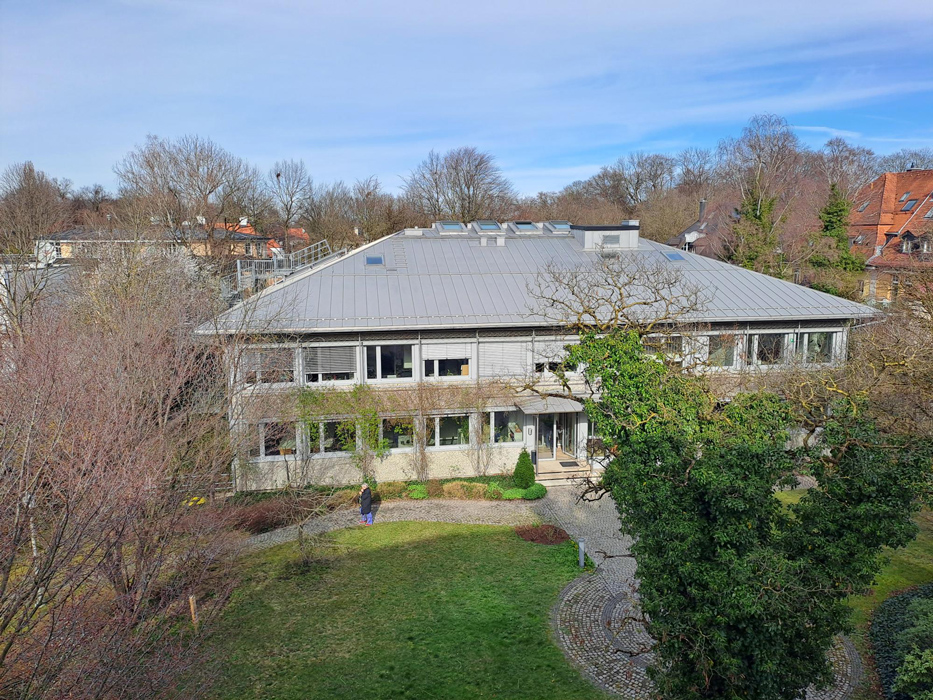
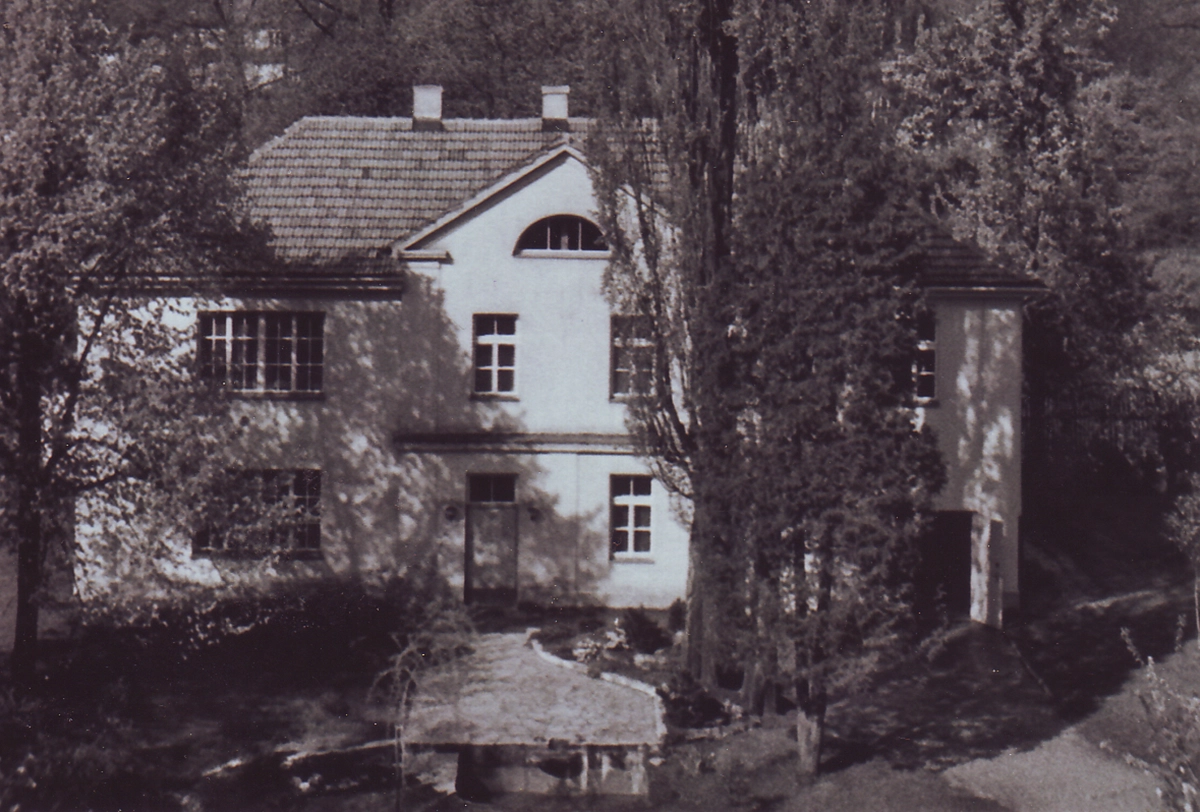
From Humble Beginnings to a Hub of Economic Research
The ifo Institute has owned Villa Heymel at Poschingerstraße 5 since 1951 and the property provided ample space for an ambitious expansion. The proposed new building was to offer nearly 1,500 square meters of space, half of which was designated for library facilities including stack areas, a reference library, reading areas, and workrooms for visiting scholars. Additionally, 45 new offices were planned along with a covered walkway linking the new structure to the main building. Local building regulations mandated the inclusion of an underground garage with 40 parking spaces.
Overcoming Neighborhood Challenges
The project initially faced hurdles due to objections from local residents, delaying the start of construction. Legal challenges persisted until late 1968, when a final objection was lodged with the administrative court. To circumvent protracted legal proceedings, the ifo Executive Board negotiated a settlement with the neighbors, agreeing to restrict further expansion for up to ten years. Intensive discussions led by ifo President Karl Maria Hettlage paved the way for construction to finally begin in July 1969. The building was structurally complete by the year’s end and officially opened on October 12, 1970, celebrated with a festive gathering featuring beer and pretzels in the new canteen. The Industry and Journalism departments, along with the library, were among the first to relocate to the new space.
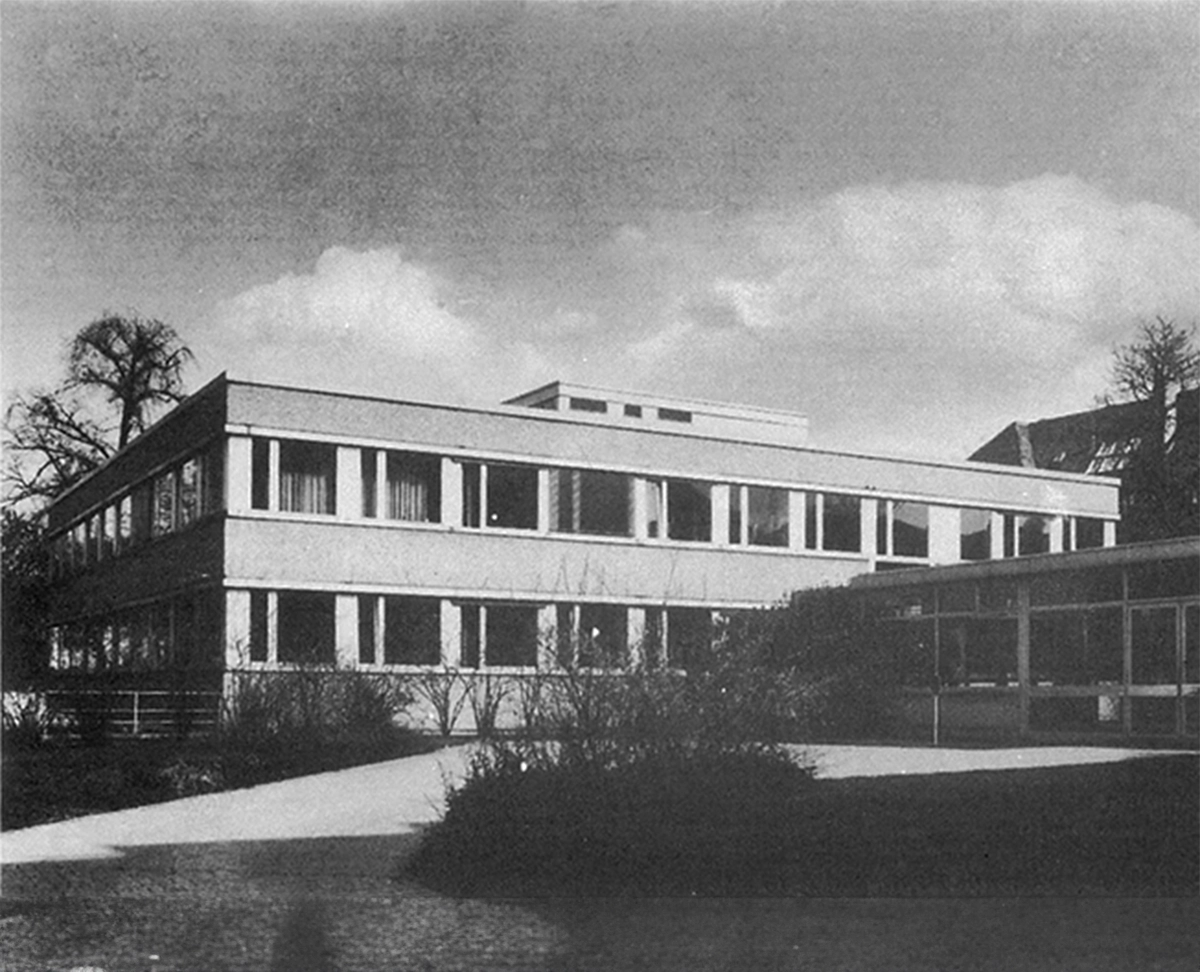

Embracing Technological Advancements
The mid-1960s onward not only saw spatial expansions but also significant investments in technological upgrades to enhance efficiency across all operations. The advent of digital technology transformed the workplace, with mechanical devices giving way to electronic typewriters and calculators. By the late 1960s, the institute had added a teletypewriter and punch card machines, streamlining data analysis and duplication processes. Over time, the ifo Institute continued to upgrade its IT systems, significantly broadening the scope and capabilities of its empirical research.
Honoring a Visionary: Adolf Weber
The new building was named after Adolf Weber, one of the most significant German economists of the 20th century. Alongside Ludwig Erhard, Weber was instrumental in laying the groundwork for policy-oriented economic research in Munich during the 1940s, which greatly influenced the ifo Institute’s direction from its inception in 1949. Weber served as the Chair of Economics and Finance at the University of Munich until his retirement in 1948. Today, the Adolf Weber House at Poschingerstraße 5 houses the ifo Center for Industrial Economics and New Technologies, the ifo Center for Macroeconomics and Surveys, the LMU-ifo Economics & Business Data Center, and a specialist library, continuing to build on his legacy.
Note: For the sources used in this text, click on the imprint.
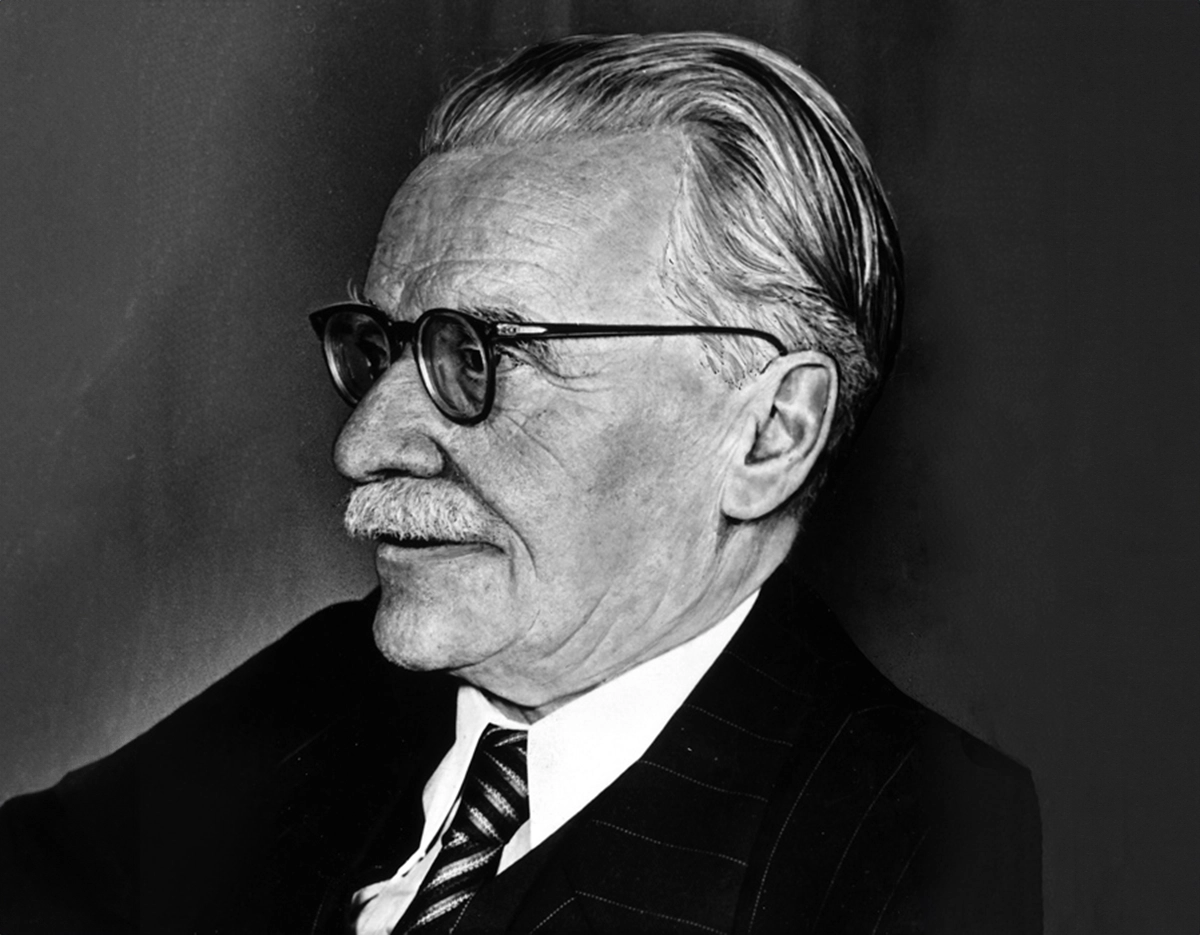
Beginnings
Local History
The Creator of the ifo Data Painting
The creator of “FlowStates” is Patrick Doan, a Canadian artist who lives in Berlin. He is regarded as one of the leading figures in the digital real-time 3D art scene. His experience spans the fields of design, film, and architecture. His works include dynamic 3D real-time graphics, live performances, music videos, and installations. Under his pseudonym “defasten,” Patrick Doan creates visionary visual designs consisting of sculptural, generative and deconstructed geometric objects and elements. His work has been exhibited in over 25 countries and has won recognition from prestigious institutions worldwide, including Art Basel Miami (Beyond Basel), the New Museum in New York City, Ars Electronica, Transmediale in Tokyo (Neo Shibuya TV), Integrated Systems Europe (ISE), and MIRA in Barcelona.

See here a transcript of what the artist himself had to say about his artwork at the vernissage on June 26, 2024:
My name is Patrick Doan, I’m a Canadian digital artist based in Berlin, and I’ve had the honor of working on this artwork thanks to Kolja Pitz from Plateau Candy, who initiated this project.
A Bit About Me
I’ve been working as a digital artist for more than 10 years, having had the privilege of working on a variety of projects, in various sectors of the creative industry, from music, film, design, dance, architecture, engineering, automotive, fashion. Working with studios and for myself, I have shown work in different events, like conferences, trade shows, large stadiums, festivals to art exhibitions and galleries around the world, from Barcelona to Tokyo and Paris, the Tate Modern, to Las Vegas and Sao Paulo, to name but a few of over 25 cities, and counting, including now here in Munich. Now this project at Ifo gives me the chance to create a data painting, which is a unique form of contemporary digital art that transforms, or utilizes the raw numerical data produced at ifo into a visually captivating artwork, making complex information more accessible to a broader audience.


So Why a Data Painting?
Well there are several reasons:
A data painting merges the analytical world of data with the innovative creativity of digital art. This fusion allows for a unique form of expression to unfold, that communicates complex data in a visually appealing way. It provides a bridge between data and art.
The second reason would be that the ifo data itself reveals patterns and trends in society, creating a narrative around the state of the world. By using this data for artistic production, the artwork continues the storytelling of this same data, in real-time, creating new insights and correlations that may otherwise go unnoticed.
I also feel this combination of art and data can provide emotional resonance, creating a more profound impact on the experience of art, and humanize this data, making it more relatable to the public.
Then there’s of course the aesthetic appeal. FlowStates is a work of art using the latest software technologies available to process and generate real-time digital 3d animation, like a moving sculpture in an infinite state of flow.
So How Does the Artwork Actually Work?
Well, FlowStates consists of six designs, each powered by algorithms that translate the data streams into diverse visual expressions. These data streams consist of six fixed data series from the ifo business climate, from manufacturing to transport, trade to IT, to the overall climate of the industry.
These ifo data streams are updated and intertwined with correlated data from Eurostat such as their figures on international trade in the European market, the volume of production in construction, or consumer trends with online retail and services. As a result, all these live streams of data work together to dynamically influence and animate the generative visual designs of the artwork.
The six visual designs themselves take inspiration from the diversity of forms found in the natural world, from the microscopic to the macroscopic, like a single cell organism, to the flight formation of birds. This approach is then distilled through my creative process, to create a timeless and unique, fluid visual design language.
By using these intricate natural forms that have evolved over eons of time, or since the beginning of life itself really, it provides the perfect source of inspiration, to creatively manipulate these known structures of life. In some ways, this process of crafting the artworkrecalls how we as a civilization have equally experienced evolutionary transformation, side by side with nature.
That said, all the visual compositions are designed to flow and move with the incoming data streams from ifo, Eurostat, and the time of day, all in real-time. This live symbiotic state interacts and influences the motion, shape, speed, and color configurations of the artwork, showcasing how the visual art, and selected researched data streams come together as a whole, revealing new patterns, endlessly.

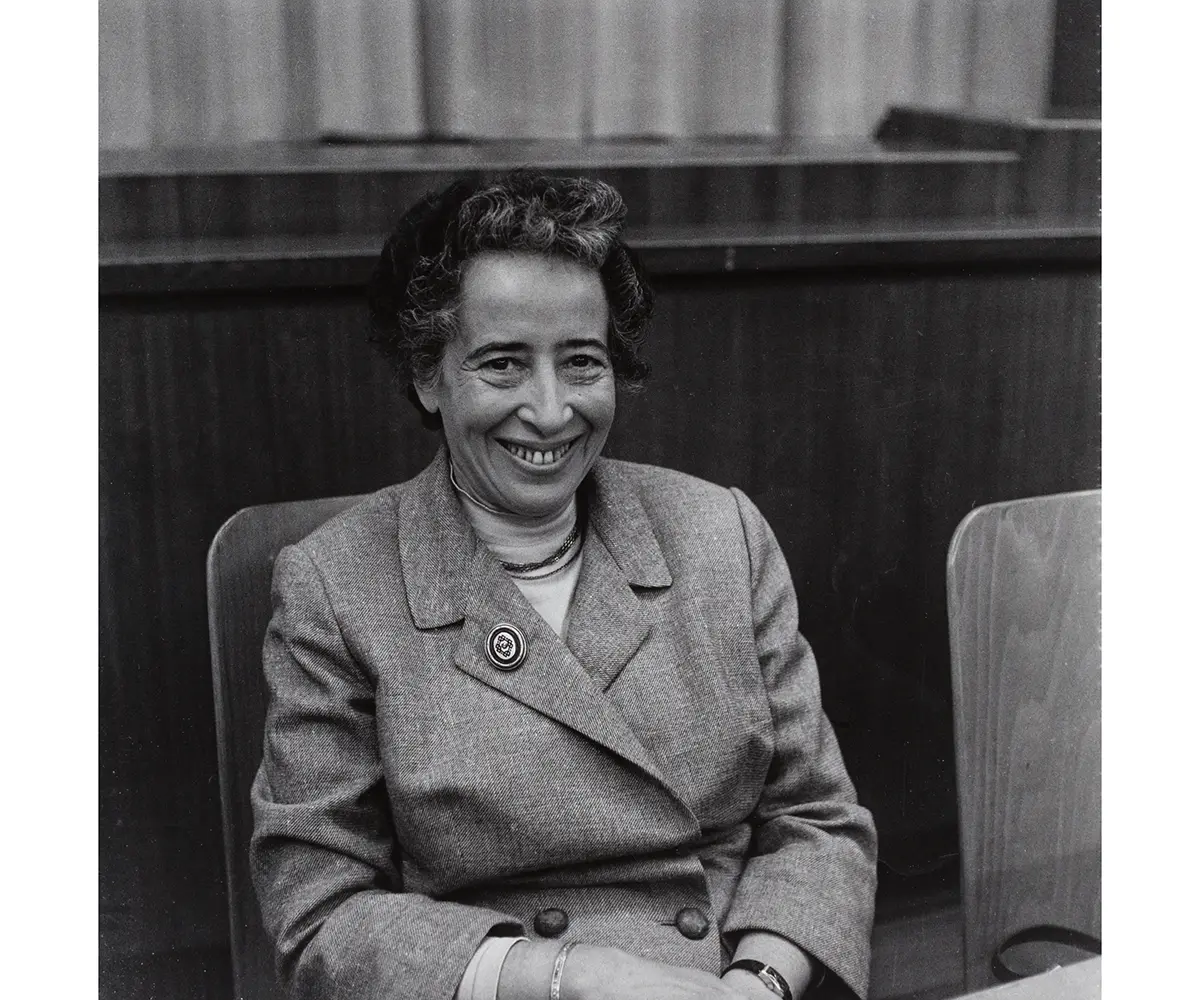
How Does a Data Painting like Flowstates Fit In Today’s World?
Well, as of today, in the year 2024, we are really overwhelmed with data from various sources, including social media, the financial markets, cryptocurrency, rapid advancements in AI, the endless news cycle, and your everyday digital interactions through the internet. In this light, a data artwork like FlowStates can act as a historical record of our digital age, capturing the zeitgeist of an era dominated by information technology. It can provide future generations with insights into the concerns, values, and challenges of our time. Again, in many ways, it serves as a bridge between the rational world of data science and the creative realm of art.
As the philosopher Hannah Arendt once said: "The aim of art is to represent not the outward appearance of things, but their inward significance." Arendt’s perspective underscores the role of a data painting in revealing deeper truths and insights, hidden within data. When data is treated as a creative material, its power to inform, inspire, and captivate is greatly amplified. Data art can transform abstract numbers into relatable human experiences.
People
The End of a Dream: The Dotcom Bubble’s Collapse
In 1999, the stock market was ablaze with excitement: the Nemax 50, the leading index of the Neuer Markt (a segment of the Frankfurt Stock Exchange created for high-growth, high-tech companies, similar to the NASDAQ in the U.S.), made its debut. This period marked an era of fervent enthusiasm, with the dream of rapidly accumulating wealth through stock gains drawing many to invest, their imaginations captivated by the burgeoning possibilities of mobile communication and the internet.
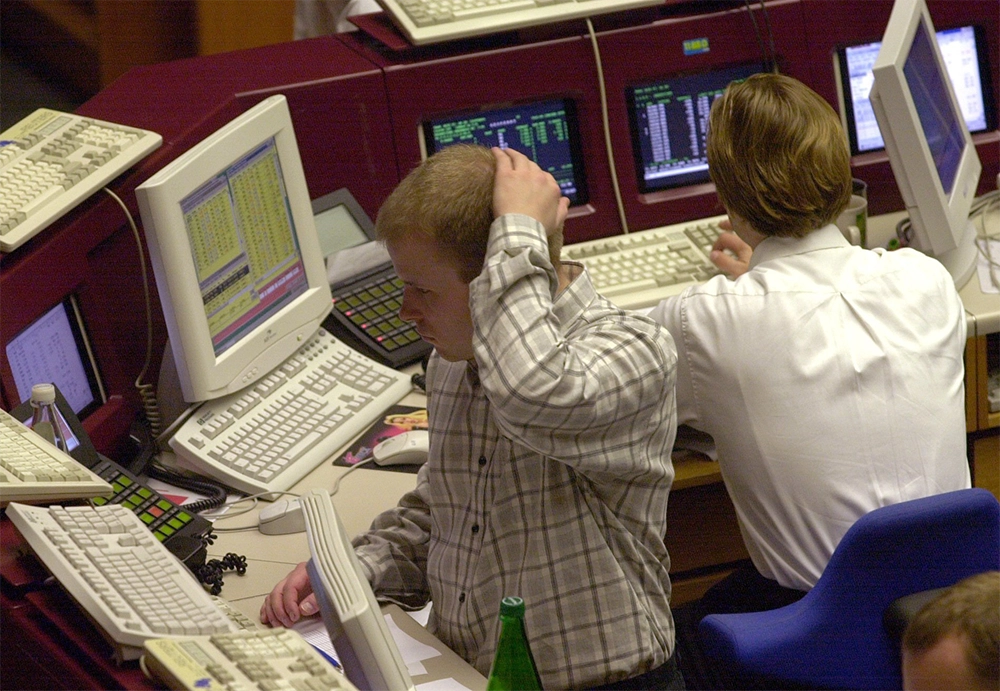

Optimism Unchecked by Reality
There was a prevailing sentiment that the digital revolution’s surge in innovation could somehow bypass traditional economic cycles, rendering recessions obsolete. Towards the end of the 1990’s, this optimism led to a startup boom in Germany, where nearly every idea related to new media or the internet received funding, with investors and corporations eagerly backing these nascent companies in anticipation of rapid growth. Expectations of quick growth overrode rational caution.
Germany’s Startup Mania
Taking inspiration from the American Nasdaq’s record-breaking performance, the German Nemax aspired to replicate this success. Indeed, initial expectations were met when the Nemax 50 hit an all-time high of 9,631.53 points on March 10, 2000. Government statistics highlighted the registration of around 300,000 “innovative, business-related service companies” at the millennium’s turn, facilitated by the expansion of necessary infrastructure like high-speed internet. Many of these start-ups simply relied on the digital transformation of “old economy” business models.
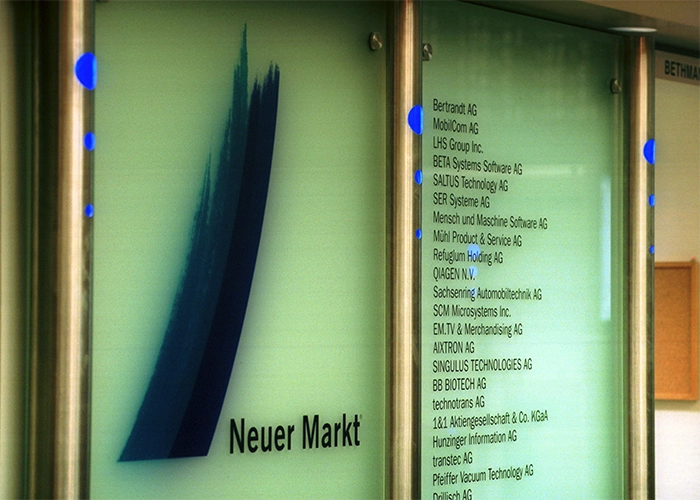

The Bursting of the Bubble
Skeptics of the market’s irrational exuberance were few and far between. Stock market expert André Kostolany, for example, voiced his concerns as early as 1998 on an NDR talk show, calling the new economy a “scam with marked cards and cheats.” The inflated valuations of dotcom companies, which propelled their stock prices, lacked grounding in solid economic fundamentals. This disconnect led to the Nemax’s dramatic collapse. From being valued at 235 billion euros in 2000, the companies on the Neuer Markt plummeted to less than 30 billion euros by 2002, as their ambitious growth projections failed to materialize.
A Tenuous Edifice of Market Fantasies
The case of Daniel David, a pop singer turned entrepreneur, illustrates this folly. On August 11, 1999, the day of a total solar eclipse, his company Gigabell went public. Despite heralding a new dawn for his company during its launch party, Gigabell, which started as a simple internet provider and operated at a loss, soared to a market valuation of 800 million euros without ever turning a profit. In November 2000, Gigabell was insolvent and was the first company to be excluded from the Neuer Markt. It declared bankruptcy in November 2000, becoming the first company to be delisted from the Neuer Markt. Other firms resorted to fraudulent financial reporting and deceptive announcements to maintain their facade for a time.
Failed business plans led to the collapse of over-hyped companies not just in Germany, but globally, catching inexperienced investors off guard with their rapid downturns. Many missed the chance to sell their shares in time, suffering significant financial losses. Similarly, the American Nasdaq took a dramatic plunge, falling from 5,048 points on March 10, 2000, to just 1,114 points by October 9, 2002.
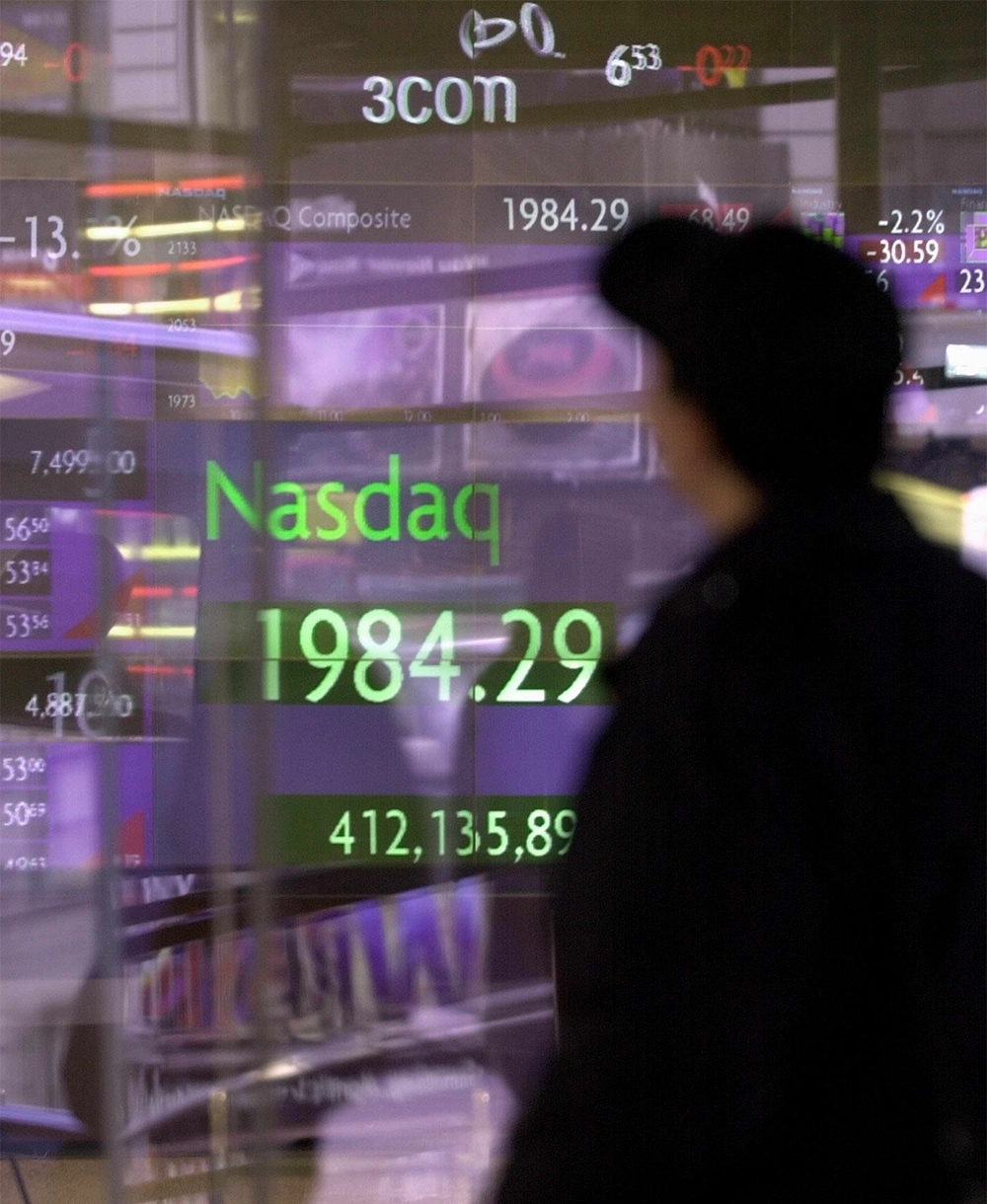
The Legacy: A Surge in Innovation
Despite the market crash wiping out numerous companies and vast sums of investor money, the march of the internet and digitalization remained unstoppable. Today, giants like Google, Apple, Facebook, and Amazon demonstrate the enduring impact of the new economy, having revolutionized both our personal and professional lives.
Milestone
The Euro: A Long Road to the Single Currency
On January 1, 2002, the change became tangible for EU citizens: The largest cash changeover in history began in twelve countries. On this public holiday after New Year’s Eve, many German citizens also withdrew their first euro bills from cash dispensers. By the end of 2001, a total of around 15 billion banknotes worth EUR 630 billion and over 51 billion coins worth EUR 16 billion had been produced.
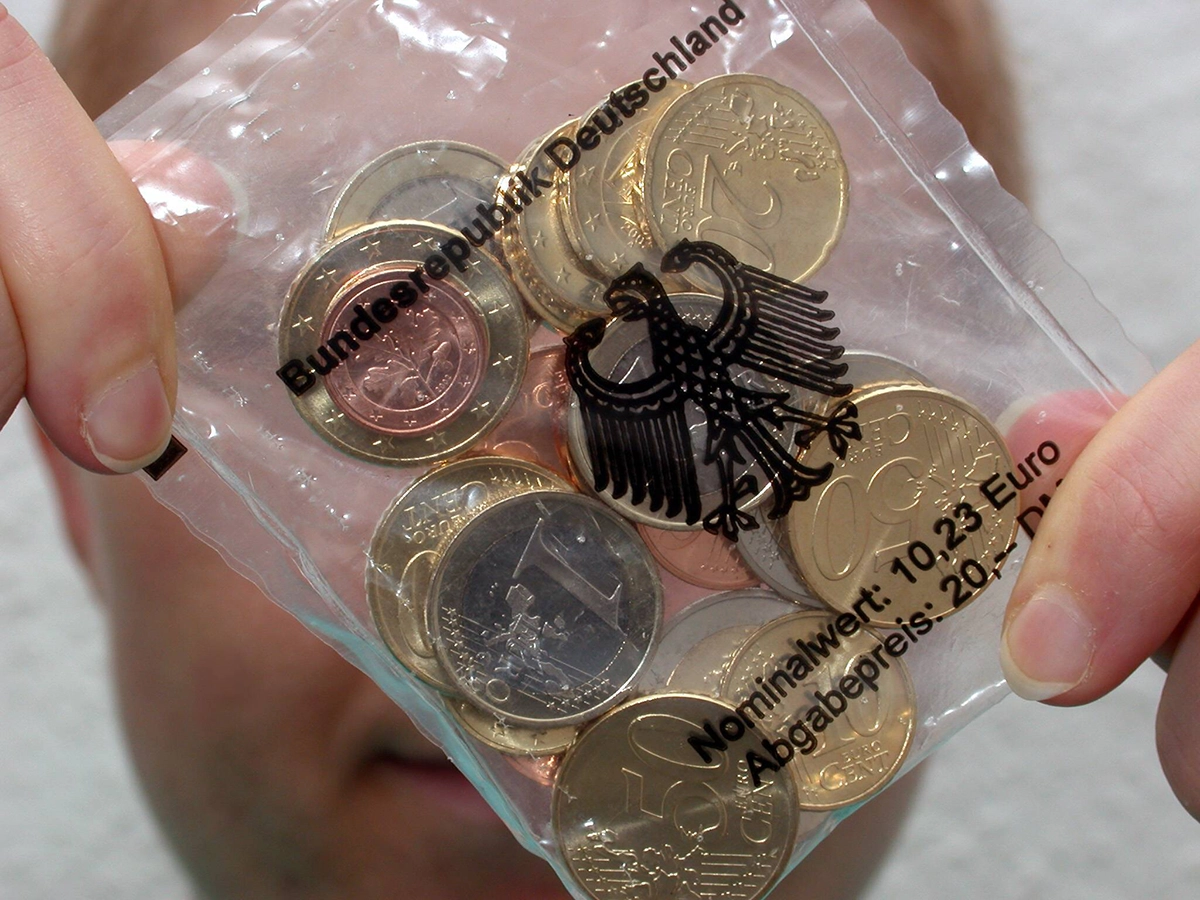
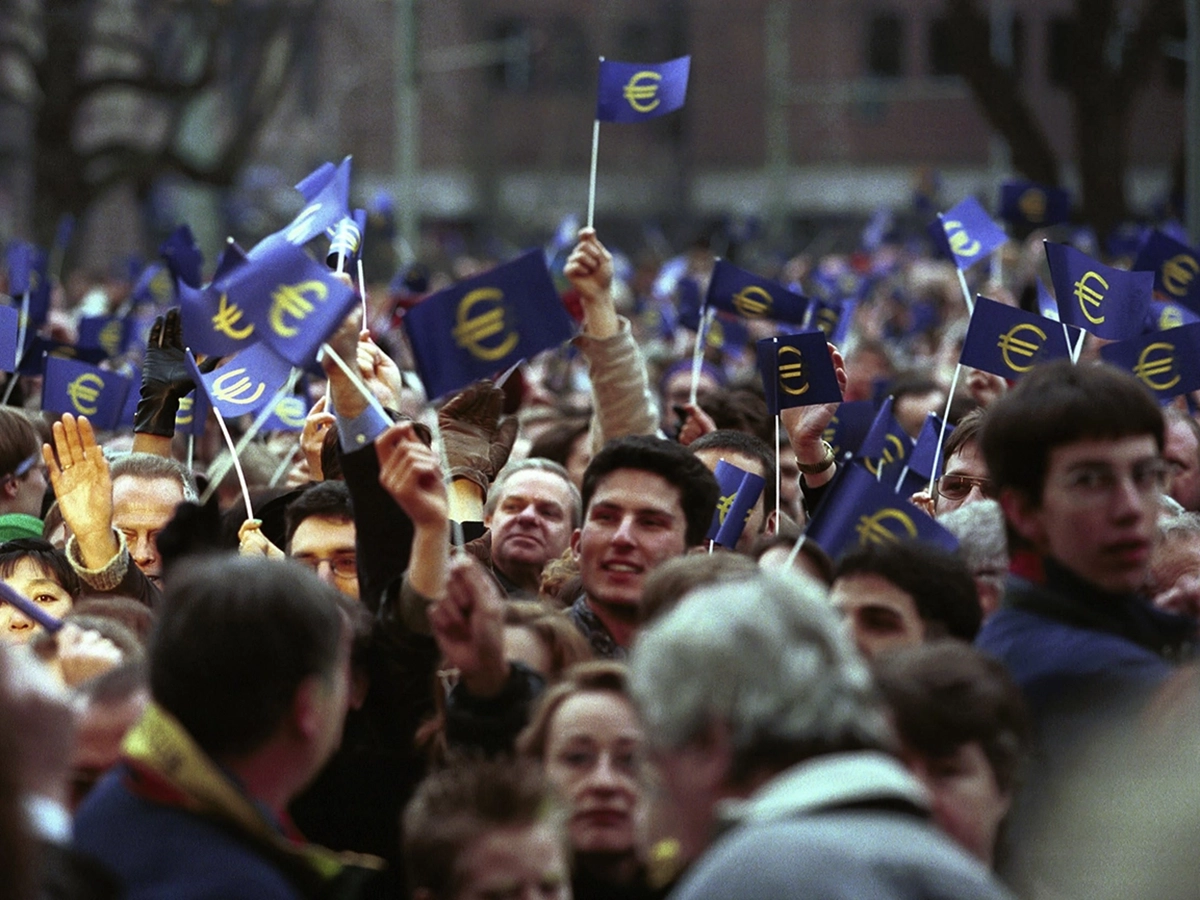
The Long Road to the Euro
The Delors Report, which was adopted in 1989 and named after the then President of the European Commission Jacques Delors, envisaged that European economic and monetary union would be achieved in three stages. In the Maastricht Treaty of 1992, the EU heads of state and government agreed on a legal framework and accession criteria for monetary union. The 1997 Stability and Growth Pact formulated specific requirements: The euro countries were allowed maximum annual new debt of 3% and a maximum total debt level of 60% of their gross domestic product. On January 1, 1999, the conversion rates of the national currencies to the euro were definitively set. Germany, France, Italy, the Netherlands, Belgium, Luxembourg, Austria, Ireland, Finland, Spain and Portugal handed over control of monetary policy to the European Central Bank (ECB), which was founded in 1998 and is based in Frankfurt am Main.
High Hopes and Concerns
Many economists hoped the importance of the euro would increase as a result of a large increase in confidence and the attractiveness of the European financial market and expected the currency would appreciate. However, as Jürgen Stark, State Secretary at the Federal Ministry of Finance, and keynote speaker at the ifo Annual Meeting in June 1998, warned: “Maintaining and intensifying the stability culture of the EMU member states is what is most vital to ensuring the euro can gain trust and take its rightful place in the international monetary system.”
Other cautionary voices were also raised: The accession criteria for the member states of the monetary union were not strict enough. Conflicts between countries of different economic strength and stability would be foreseeable. The economist and Nobel Prize winner Paul Krugman even saw the introduction of the euro as an “invitation to disaster.” And indeed, before and after its introduction, the member states repeatedly violated the accession criteria and requirements of the Stability Pact.

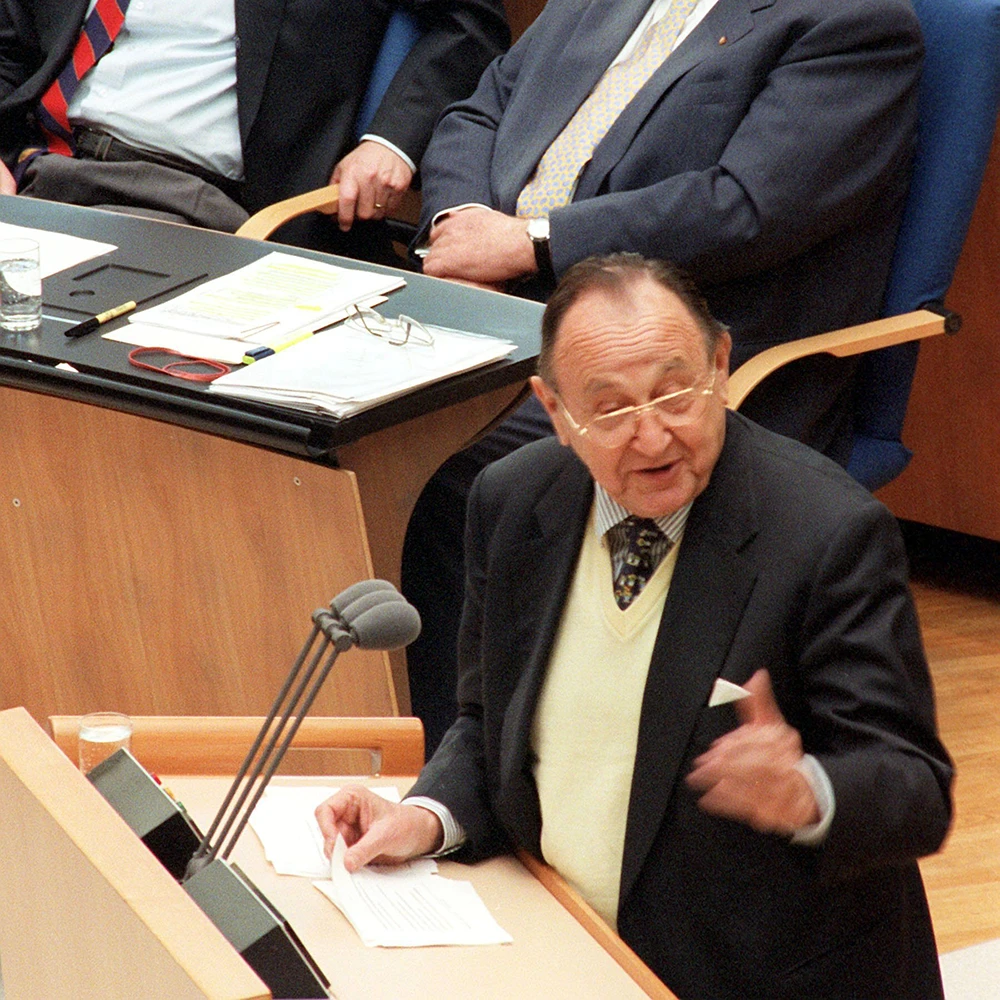
Large Majority in Favor of the Euro in the Bundestag
When the German Bundestag was due to vote on the euro currency on April 23, 1998, the heated exchange of blows between the coalition and the opposition lasted almost seven hours. Federal Foreign Minister Hans-Dietrich Genscher (FDP) was one of the advocates of the new currency. This was “not just a monetary policy decision,” but a contribution to European unification of historic dimensions. The Bundestag should therefore not adopt any evasive “not now” and “not like this” stance, urged Genscher. A clear yes or no was needed.
Gregor Gysi (PDS) gave a clear thumbs down: The unification of Europe could not be accomplished through joint banks. In order to achieve far-reaching integration, taxes would also have to be brought into line and social, ecological and legal standards harmonized, argued Gysi.
At the end of the day, the introduction of the euro as the new European common currency was approved by a surprisingly large majority: Only 35 out of 672 members of the Bundestag voted no.
Die Schwächen der neuen Währung
In 2001, the ifo Institute conducted its first stocktake: Since its introduction on January 1, 1999, the euro had lost over a quarter of its external value. The persistent weakness of the European currency could not be explained by macroeconomic factors, and in the 2001 Schnelldienst No. 13 journal there was an exchange of views among academics. They concurred that “only confidence in the existence of a de-facto, economically dynamic and stable euroland would sustainably strengthen the euro.” Ultimately, “economic policy reforms that credibly promise greater real economic dynamism are more important for stabilizing the euro exchange rate than the circulation of a single currency.” There were also calls for firm rules and stricter budgetary discipline in the member states and for the ECB to act with assurance.
A good decade after its introduction, the then ifo President Hans-Werner Sinn paints a gloomy picture of the euro’s introduction.
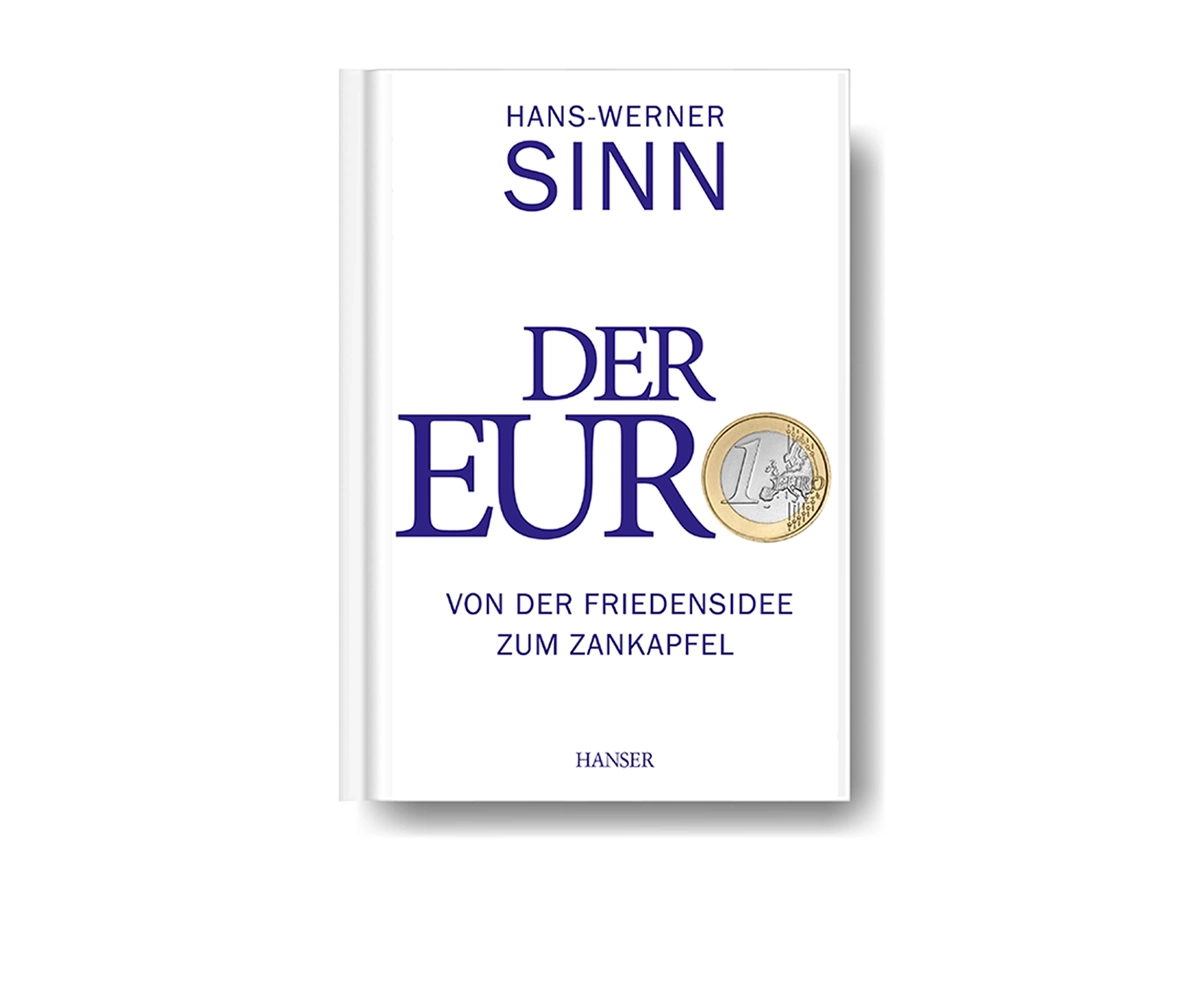
Milestone
The Financial Crisis: A Tumultuous Collapse 2008
The international financial crisis of 2008 originated from a national real estate crisis in the United States. For years, property prices soared while interest rates remained low, prompting U.S. banks to extend high-risk loans to households, further inflating the real estate bubble. The bubble finally burst when the U.S. Federal Reserve hiked key interest rates, leading to increased lending rates. As homeowners defaulted on their loans, banks faced a liquidity crisis that quickly rippled through the international financial system and broad sectors of the real economy.


The Domino Effect of Subprime Loans
From 1990 to 2006, the U.S. real estate market saw an unprecedented boom. However, inflation began rising by the end of 2005, prompting the Federal Reserve to increase interest rates. This change led to a real estate glut as low-income households, burdened by variable-rate loans, found themselves unable to meet their mortgage obligations. These risky, under-collateralized loans – known as “subprime loans” – were widespread across the balance sheets of numerous banks and had permeated the global financial system. The subsequent plunge in U.S. real estate prices deval-ued these assets drastically, leading to a systemic collapse.
High-Profile Bailouts and the Lehman Collapse
Lehman Brothers, a major U.S. investment bank, became emblematic of the financial crisis. Despite the U.S. government’s intervention to save other financial giants like Bear Stearns, Freddie Mac, and Fannie Mae, Lehman found no rescuers and declared bankruptcy. Soon after, the insurance giant American International Group (AIG) faced similar peril but was deemed too integral to fail; it was rescued by the Federal Reserve and the Treasury Department. To avert a total financial meltdown, the U.S. government launched a $700 billion bailout package.
The crisis quickly escalated into a global catastrophe. In October 2008, Iceland declared national bankruptcy. The following month, the G20 countries convened in Washington, D.C., agreeing on coordinated actions to tackle the global economic crisis and fundamental reforms to financial market regulations. By April 2009, at a G20 summit in London, stricter controls on financial institutions were mandated to prevent future crises similar to the 2007 mortgage debacle.
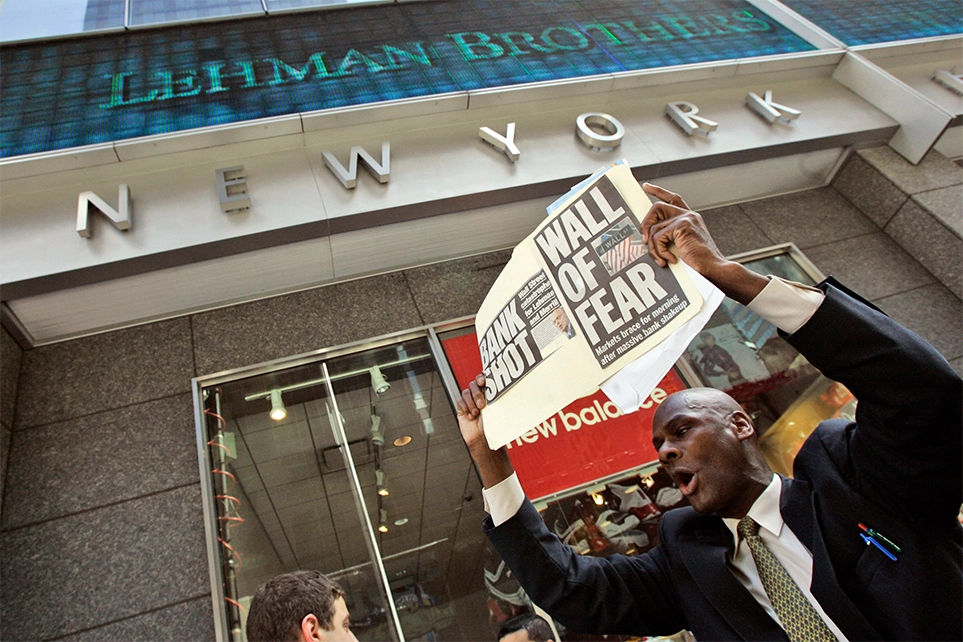

German Response to the Financial Turmoil
In Germany, Federal Finance Minister Peer Steinbrück assured citizens of the safety of their savings. The German government intervened to prevent the collapse of Hypo Real Estate Bank with substantial financial aid. The EU finance ministers also agreed to use EU funds to safeguard critical financial institutions. On October 18, 2008, the German Bundestag passed the Financial Market Stabilization Act (FMStG), creating a €480 billion Financial Market Stabilization Fund (FMS) to bolster banks’ liquidity and enable them to fulfill their obligations. Hypo Real Estate, along with Bayerische Landesbank, HSH Nordbank, and Commerzbank, were among the first to draw on these funds.
ifo Institute’s Perspective on Risk Distribution
The 2008 financial crisis ignited fears that unchecked speculation could lead the global economy to disaster. Hans-Werner Sinn, President of the ifo Institute from 1998 to 2016, offered a more nuanced view in his 2009 book Casino Capitalism. He argued that risk-taking drives innovation and societal progress but criticized the outsourcing of risks to third parties. Sinn contended that such practices encourage excessive financial risks because the negative impacts can be offloaded onto other investors, leading to taxpayer-funded bailouts when crises occur.
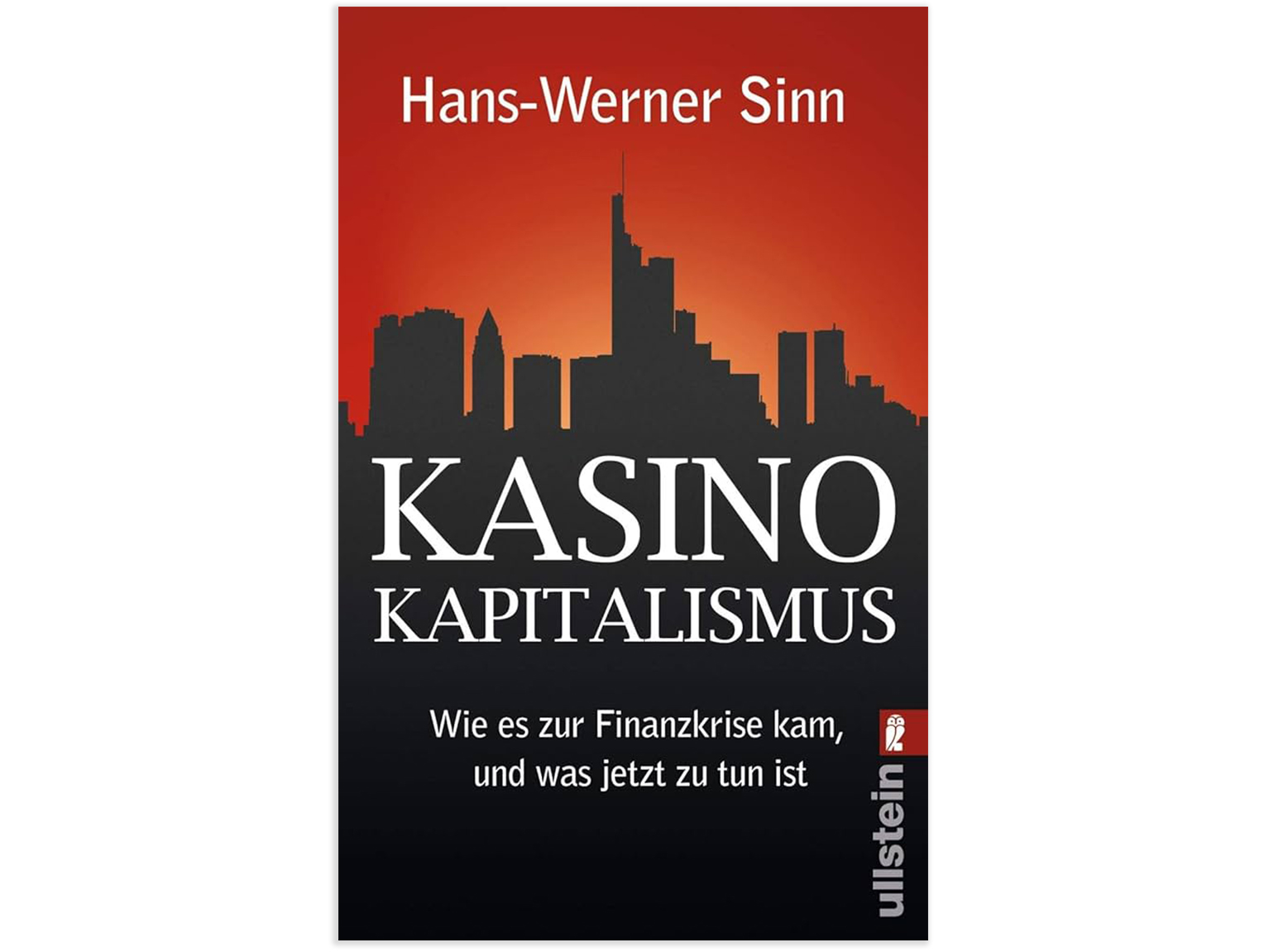
Milestone
The First Residents of one of the Triplet Houses: Bruno Walter and Bruno Frank
Bruno Walter and Bruno Frank were the inaugural residents of the ifo building at Mauerkircherstrasse 43, located in the today affluent residential area that forms the Herzogpark. Their remarkable contributions to Munich’s artistic scene and their warm intellectual exchanges with neighbors in Herzogpark, notably with the family of the legendary writer Thomas Mann, represent a unique chapter in Germany‘s cultural history, right until the national socialists came into power 1933. Since 1963, the ifo Institute has been the steward of this historic building.
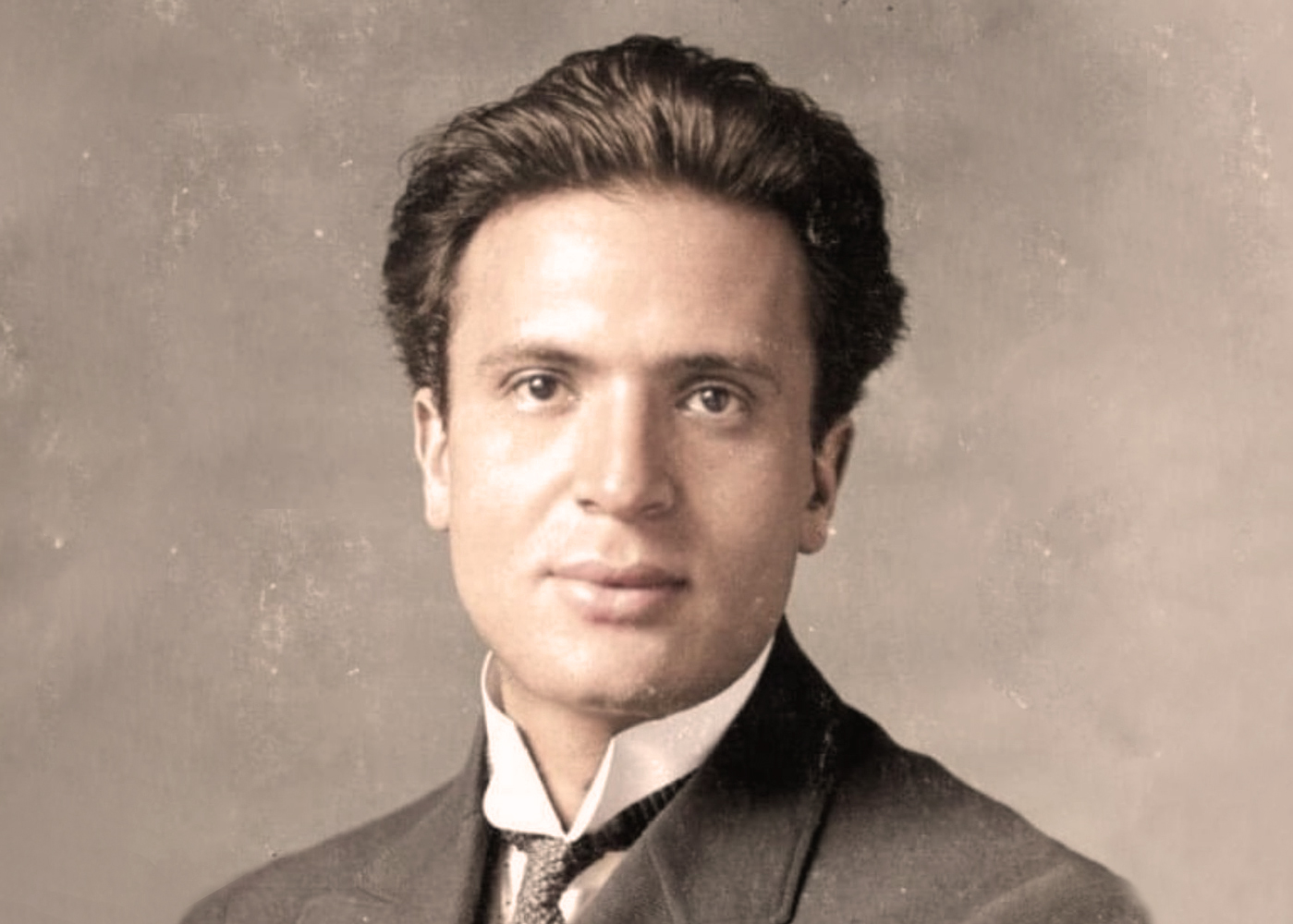
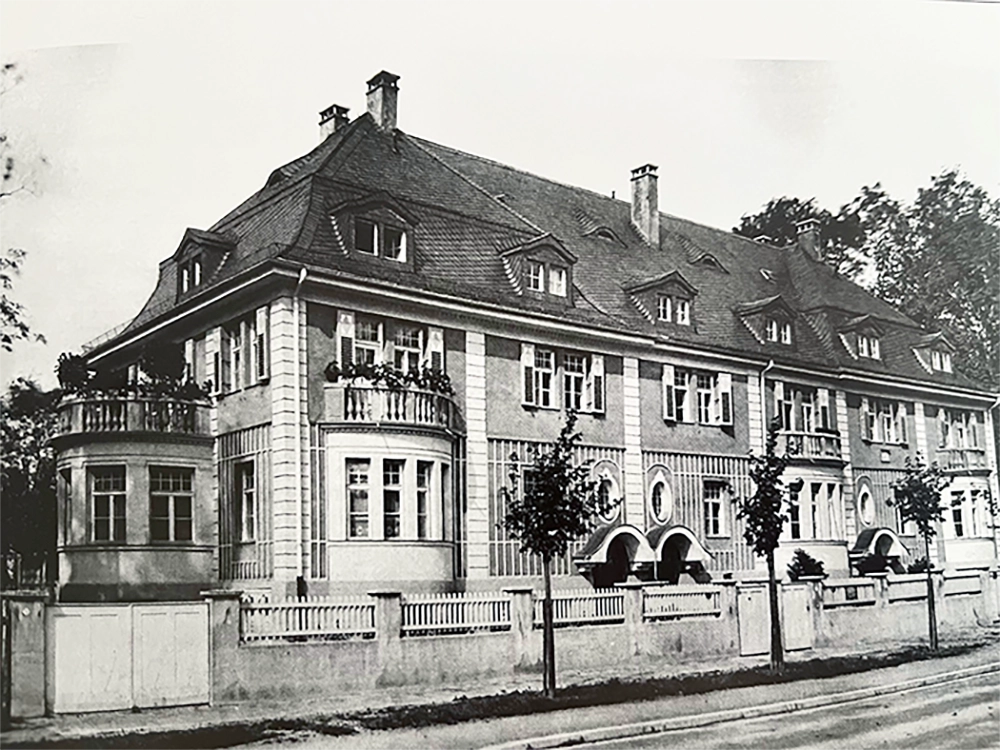
Bruno Walter: Conductor and Homeowner
In 1913, the esteemed conductor and composer Bruno Walter acquired one of the so-called “Triplet Houses” designed by Munich architect Paul Böhmer in 1909. Despite facing overt anti-Semitic hostility as a Jew, Walter recalled the decade he spent in Herzogpark as “the most productive time of my life,” a period marked by “a surge of artistic activity.” He continued as Munich’s general music director until the fall of 1922.
Bruno Frank: Writer and Tenant
After moving to the Städtische Oper, “the Municipal Opera”, in Berlin in 1924, Bruno Walter leased his house to the artist couple Bruno and Liesl Frank. Bruno Frank, also of Jewish descent, was a pivotal figure in Germany’s literary scene during the 1920s and 1930s. Among his significant works from his Munich days is the “Political Novel” (1928), which explored Franco-German reconciliation post-World War I, drawing inspiration from the landmark meeting between foreign ministers Aristide Briand and Gustav Stresemann in Locarno in 1925. The novel was swiftly translated into five languages.
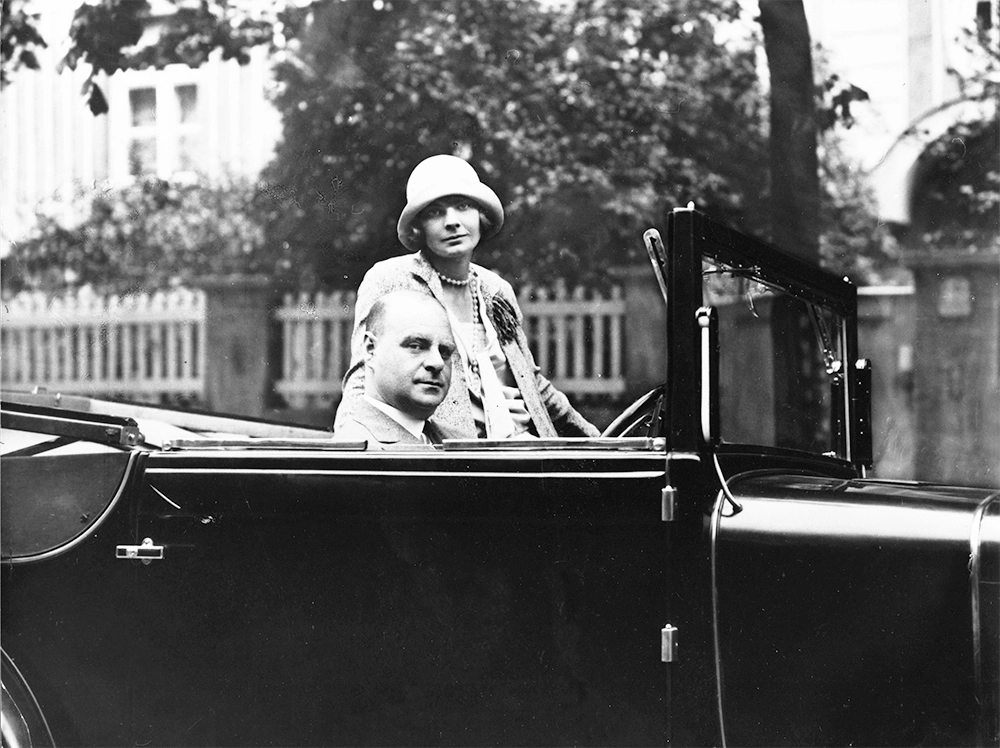
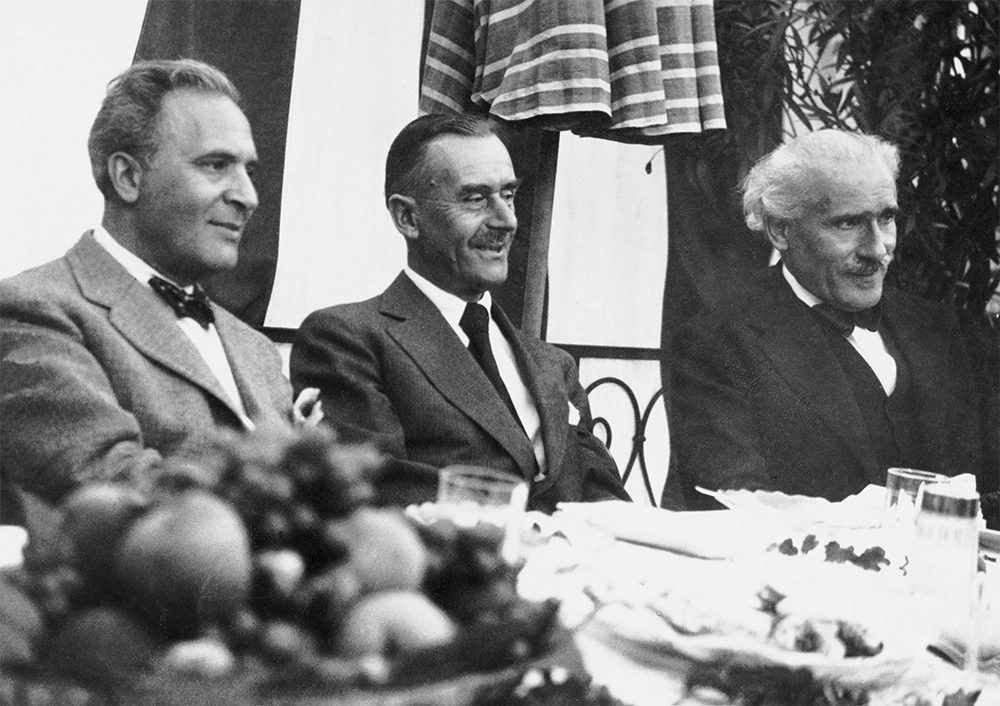
California Exiles from Herzogpark
In March 1933, following the rise of the National Socialists, Bruno and Elsa Walter fled to Austria, later moving to Switzerland in 1938, and ultimately settling in the United States. The Franks promptly left Munich after the Reichstag fire, a pivotal event in the rise of the National Socialist party, in February 1933. In 1939, an emotional reunion took place in Beverly Hills, USA, among the three families of Bruno Walter, Bruno Frank, and Thomas Mann. The friendships that had blossomed in Munich’s affluent Bogenhausen district flourished anew under the sunny skies of California, albeit under forced circumstances.
What became of the emigrants? Bruno Frank passed away in Los Angeles in 1945. The Mann family relocated to Switzerland in 1952, and Bruno Walter thrived in his new country, becoming the principal conductor of the New York Philharmonic.
Note: For the sources used in this text, click on the imprint.
Local History
The Founding of the ifo Institute: Bridging Science and Practice
The ifo Institute was born from the union of two pioneering institutions in January 1949. The merger of the Süddeutsches Institut für Wirtschaftsforschung and the Informations- und Forschungsstelle für Wirtschaftsbeobachtung created a hub that has profoundly influenced economic policy and research for over seventy-five years. How did this merger come about? Let‘s take a look at the complex history of the ifo‘s foundation.

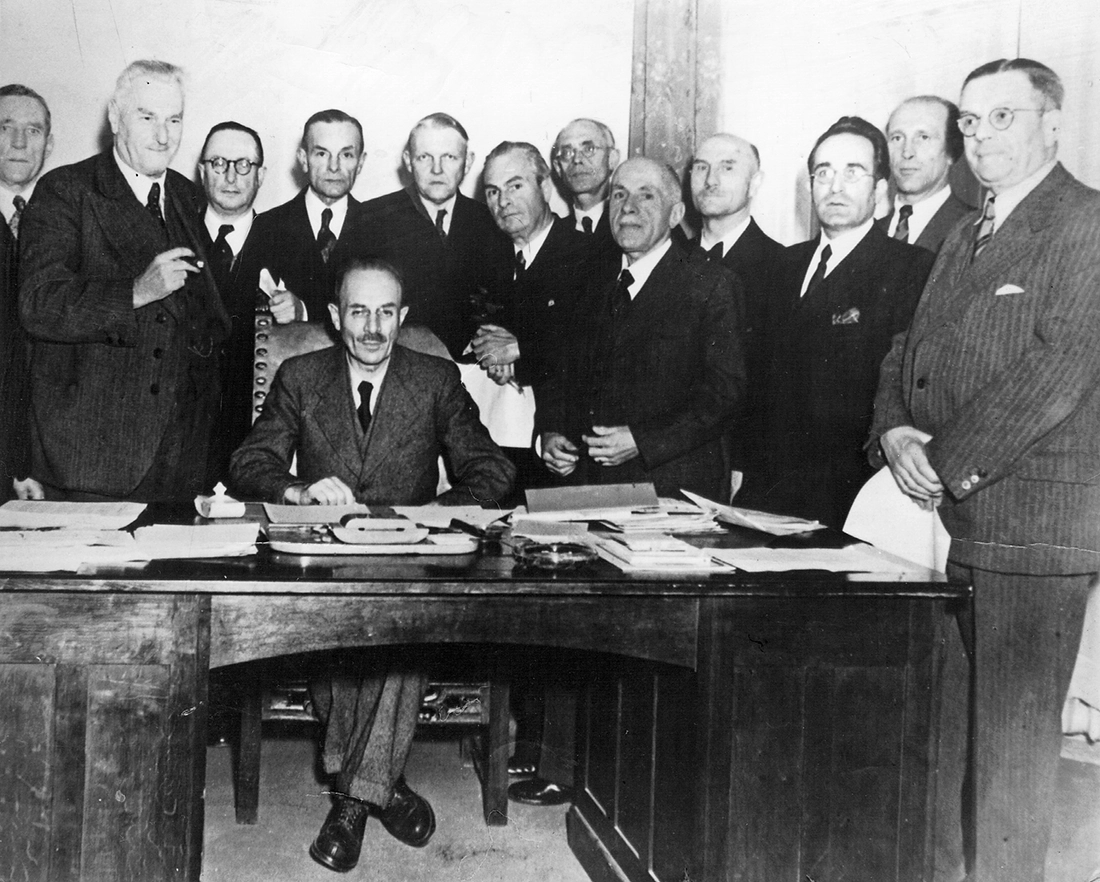
The Genesis of Practical Economic Research
The story begins in 1925, with the founding of the Institute for Economic Observation of German Finished Goods at the Nuremberg School of Commerce by Wilhelm Vershofen, around the same time as the Institut für Konjunkturforschung (IfK), now known as the German Institute for Economic Research (DIW), in Berlin. Ludwig Erhard, who later became a pivotal figure in German economic policy, joined this Nuremberg institute in 1928, contributing significantly to its development, especially in industrial market research. After facing a career setback in 1942 by being denied a succession at the head of the institute, Erhard established his own institute, laying the groundwork for future endeavors.
From Economic Research to Political Influence
Ludwig Erhard’s career was a blend of academic prowess and political acumen. Following World War II, as U.S. troops entered his hometown of Fürth on April 19, 1945, Erhard quickly aligned himself with the American military authorities, offering his expertise as an economist. By October 1945, he was appointed Minister for Trade and Industry in Bavaria. His roles within the economic frameworks of post-war Germany, including his leadership in preparing for the currency reform and his position as Director of the Economic Council of the Bizone in March 1948, were instrumental in shaping his path to becoming the first Minister of Economics in Adenauer’s government.
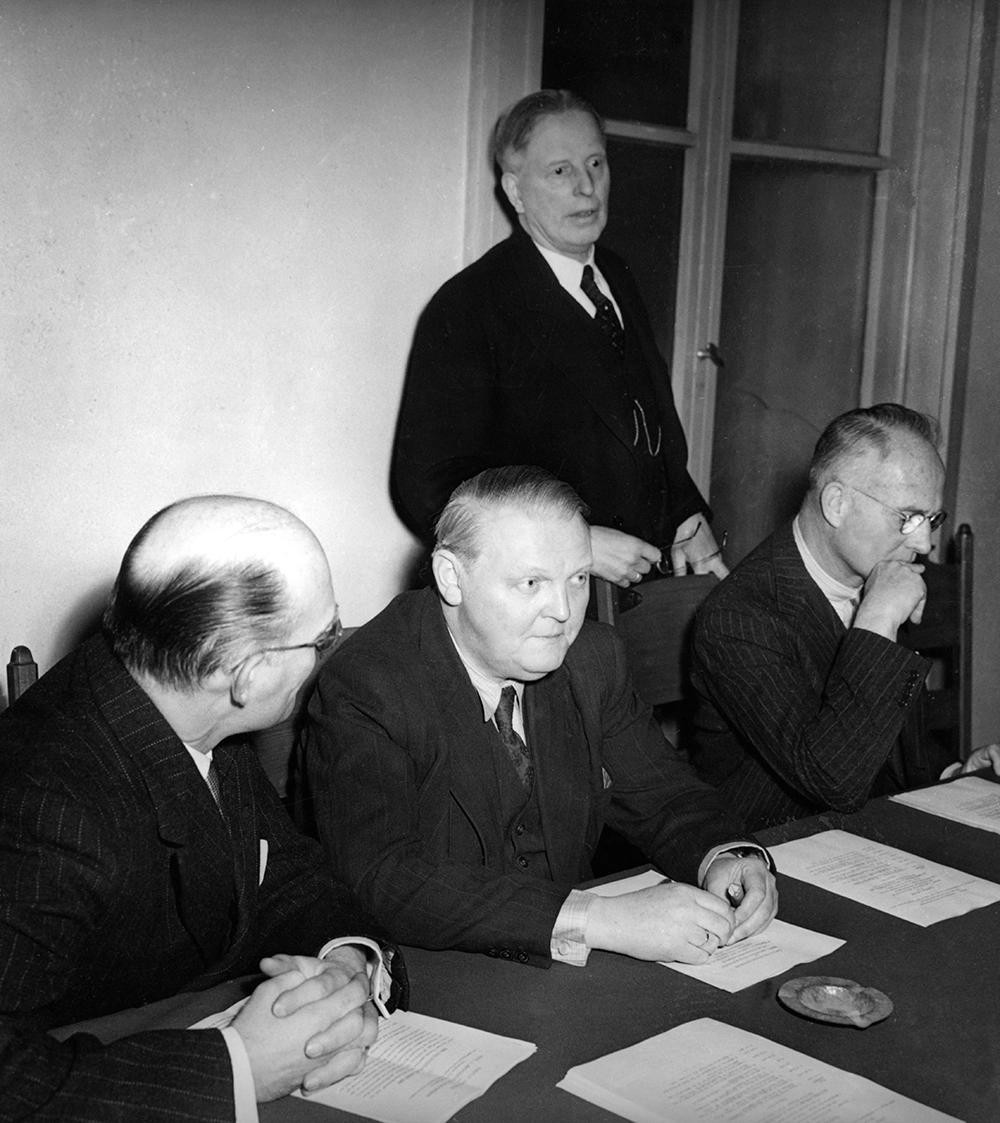
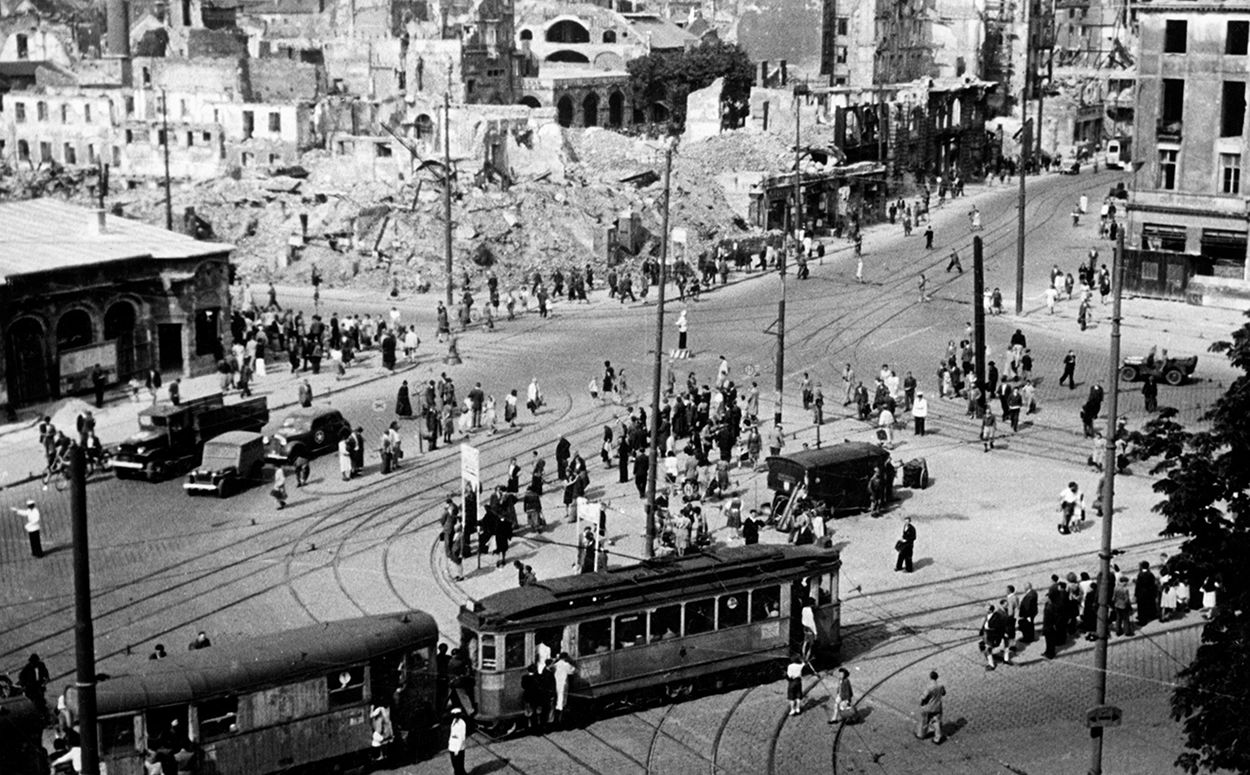
Bridging Science and Practice
The “Institute for Industrial Research” founded by Erhard in 1942 became the “Institute for Economic Observation and Economic Consulting” (from 1946) and in 1947 the “South German Institute for Economic Research.” Erhard’s vision was clear: he believed that non-university economic research institutes should serve as bridges between academic research and practical economic and state applications. He soon used the metaphor of the “bridge” that an economic research institute had to build between university economic research on the one hand and state and economic practice on the other. This vision was rooted in a commitment to non-partisan, scientifically rigorous work that directly engaged with the challenges and opportunities of post-war Germany.
Challenges and Merger
Despite its ambitious beginnings, the South German Institute for Economic Research faced financial difficulties by 1947, struggling to secure the necessary funds for expansion. Erhard and his colleagues had relied on private-sector support, but without public funding, the future of the institute was uncertain. Simultaneously, another economic monitoring institute, initiated by Karl Wagner at the Bavarian State Statistical Office, was expanding its capabilities. Together with Hans Langelütke, Wagner continued to expand the information services in the field of economic observation at the State Office from April 1948, before bundling them into the “Information and Research Center for Economic Observation” (ifo). This institute began conducting company surveys immediately after the currency reform and launched the “Ifo-Schnelldienst” in 1948, which became a critical resource for economic data.

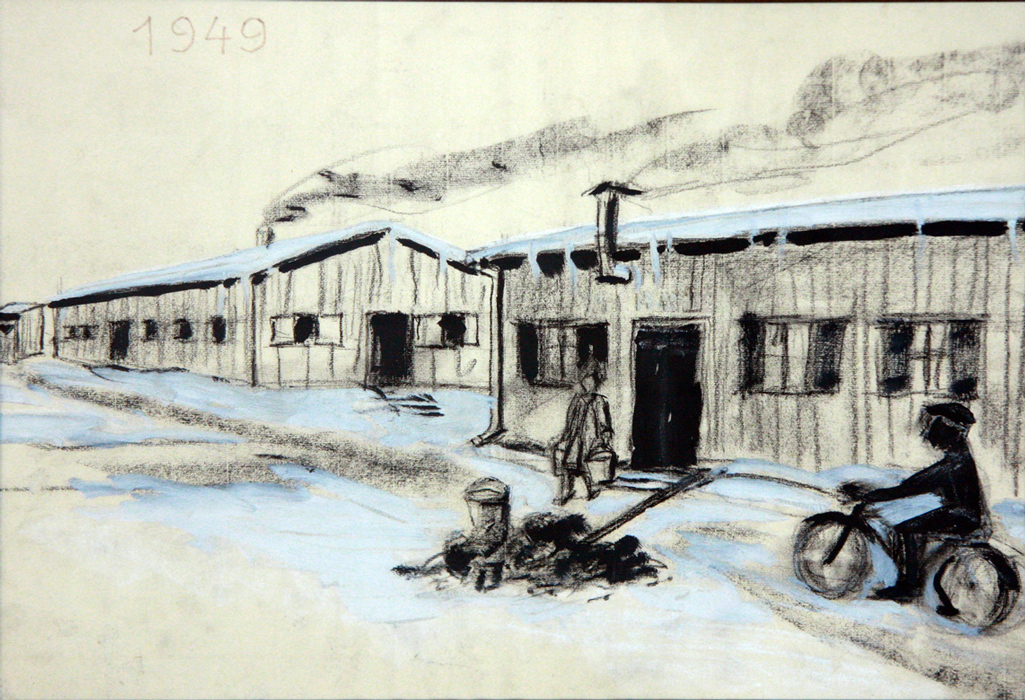
The Formation of the ifo Institute
The Bavarian state government, recognizing the potential of consolidating resources, encouraged the merger of these two institutes. On January 24, 1949, the agreement was signed to form the Institut für Wirtschaftsforschung e.V. München – shortened to the ifo Institute. Starting its operations in March 1949 with specialist departments in economics, industry, and business administration, the institute quickly established itself as a leader in applied economic research, despite the modest beginnings in makeshift barracks. The Bavarian State Statistical Office provided the institute with some rooms in the buildings at Rosenheimer Strasse 130 – a former, partially bombed-out police barracks – as an interim solution. Most of the staff were housed in two wooden barracks on the former parade ground of the barracks.
Note: For the sources used in this text, click on the imprint.
Beginnings
People
The Herzogpark: A Cradle of Culture and Intellectualism
Herzogpark, nestled in the Bogenhausen district of Munich, serves as the picturesque locale for the ifo Institute’s headquarters. This elite residential enclave, steeped in cultural and intellectual history, has been a fertile ground for what is now an internationally acclaimed economic research center.


Founding of a Prestigious Neighborhood
Herzogpark is named after its original owner, Duke Max in Bavaria (1808-1888), the father of the later Empress Elisabeth of Austria, known as Sisi. His son, Archduke Karl Theodor, sold the expansive land along the eastern banks of the Isar River to the Terrain-Aktiengesellschaft Bogenhausen-Gern in the early 1900s. At that time, the duke's former hunting grounds were still wild, untouched nature, an impression of which is conveyed in Thomas Mann’s story “Herr und Hund.” The new development area was initially opened up by a long main street named after the Archbishop of Passau, Friedrich Mauerkircher, and later, the parallel Pienzenauerstraße was laid out, named after a Bavarian noble family. During World War I, construction was halted, and many plots along the streets of Herzogpark, often named after famous poets from Gellert to Stifter, remained undeveloped for a long time.
In the nascent days of Herzogpark, pioneers of art and intellect carved out a space where creativity and thought flourished. Ludwig Freiherr von Gumppenberg-Pöttmes-Oberprennberg, an early settler, established his residence in a grand villa at by 1906, signaling the area’s burgeoning appeal to Munich’s cultural elite. Across from him, Alfred von Heymel, a luminary in the literary world, set roots at Poschingerstrasse 5 in 1909, marking the area as a magnet for creative minds. The enclave also attracted figures like Robert Hallgarten, a scholar with a keen intellect, and his wife, Constanze Hallgarten, a stalwart in women’s rights and peace activism, who together contributed to the area’s intellectual vibrancy. Notably, Thomas Mann, seeking a conducive environment for his family and work, and Bruno Walter, a maestro with a passion beyond the podium, chose Herzogpark for its serene yet stimulating atmosphere. They were joined by Erich Marcks, a historian and Bismarck biographer, setting the stage for a neighborhood rich in dialogue and discovery.
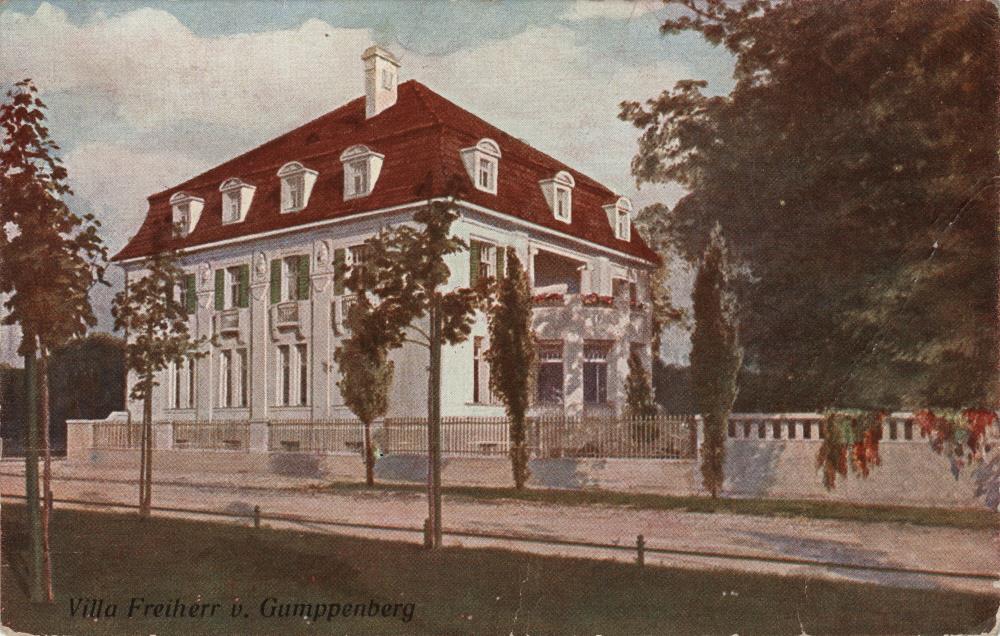
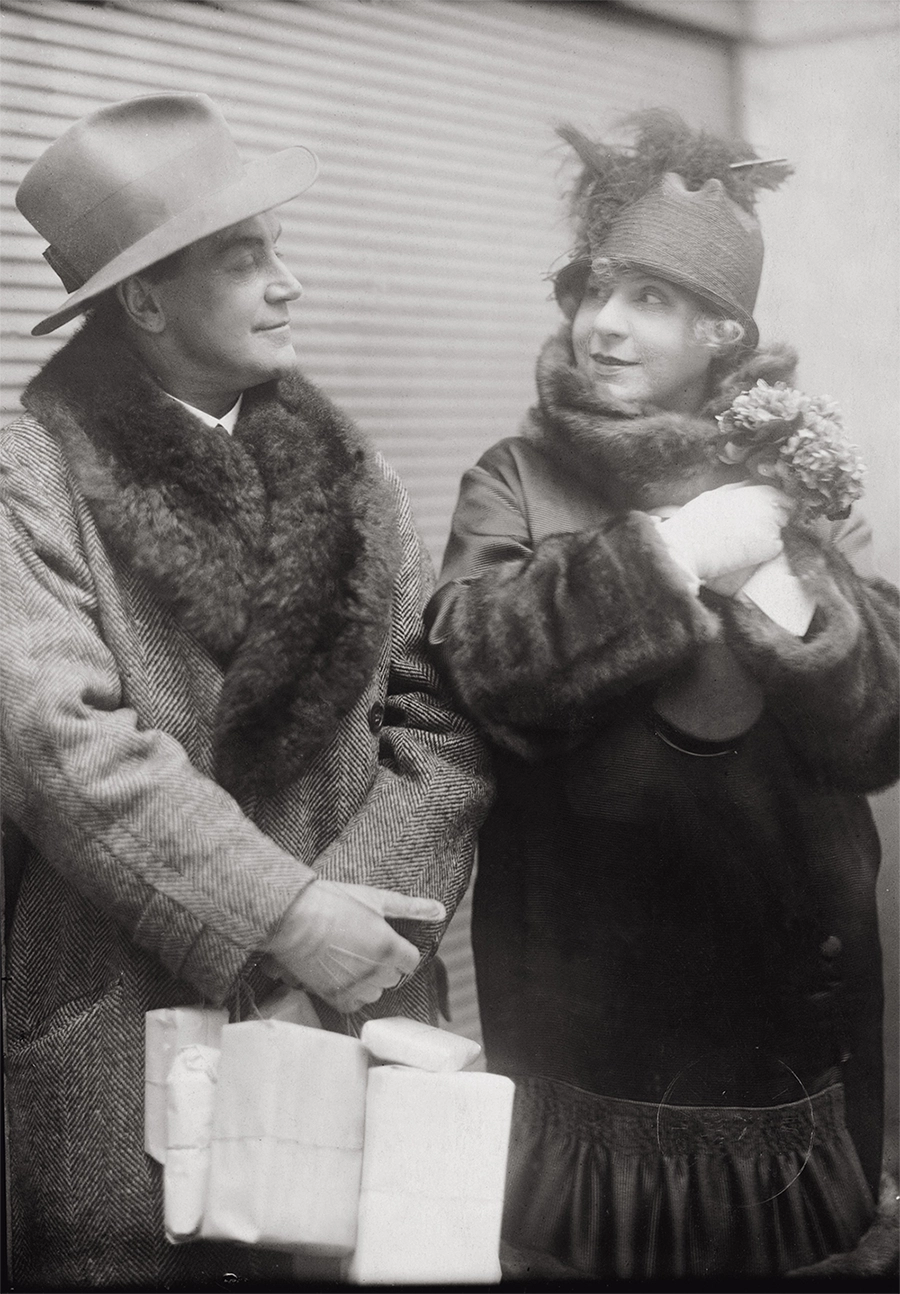
Expansion and Cultural Flourishing
As Herzogpark’s reputation as a haven for the arts and intellect grew, it drew a wider circle of notables. The actor duo Herta von Hagen and Gustl Waldau, celebrated for their contributions to the stage, made their home here, adding to the neighborhood’s artistic flair. Ludwig Ritter von Zumbusch, a professor at the Academy of Arts renowned for his child portraits, moved into a villa designed by architect Otto Riemerschmid at 9 Schönbergstraße in 1910. The arrival of Leopold Stokowski, a friend and peer of Bruno Walter, underscored the area’s appeal to musical virtuosos. This period also saw Thomas Mann, celebrated for his literary work, moving into the notable Villa at Poschingerstraße 1 in 1914. Bruno Frank, another torchbearer of literature, along with the distinguished banker and bibliophile Otto Deutsch-Zeltmann, member of the “Society of Munich Book Lovers” and the Maximiliansgesellschaft, found in Herzogpark not just a home but a community of like-minded individuals. It was here too that Adolf Weber, an economist who significantly influenced the direction of economic research and policy in Germany, his involvement with the “Economic Working Group for Bavaria” and meetings held in his home in Herzogpark contributed to the foundational ideas that continue to inform the work of the ifo Institute.
A Place of Intellectual Exchange
The ifo Institute itself found a home in Herzogpark thanks to a tip from Adolf Weber about the building at Poschingerstrasse being for sale post-World War II. Starting in 1952, the institute’s staff worked here and later occupied spaces within Herzogpark’s iconic triplet villas, cementing the institute’s success story in an area renowned for its intellectual legacy. Today, the ifo Institute’s buildings still echo the vibrant intel-lectual and cultural history of Herzogpark and its esteemed past inhabitants.
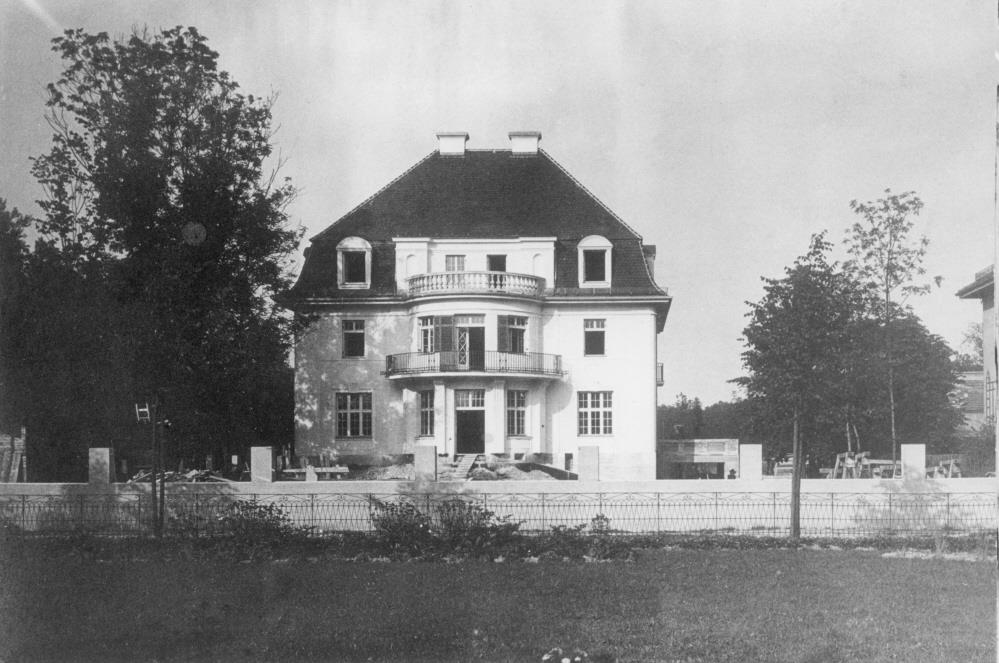
Local History
The ifo Brand: More Reality than Illusion
The core business of the ifo Institute is to pursue outstanding science. That produces research findings with which the Institute aims to help shape the debate – both in economic expert groups and on the international economic policy stage. Viewing the institution ifo as a brand and developing a common understanding of what this brand stands for helps, because brands make it possible to provide guidance in a constantly changing world. Brand management deals with the question of what makes the ifo Institute unique.
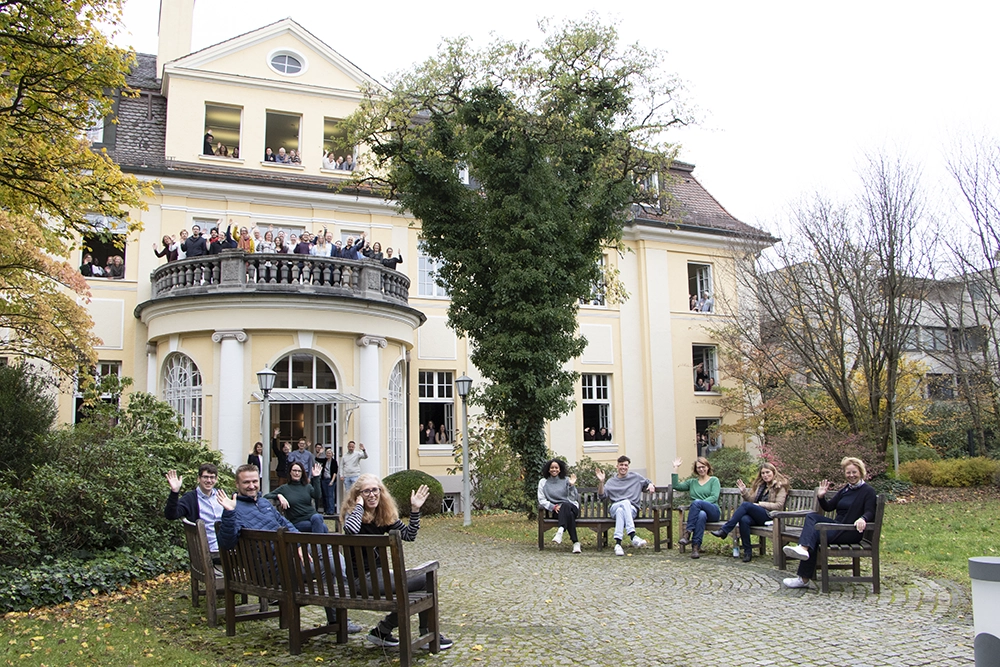
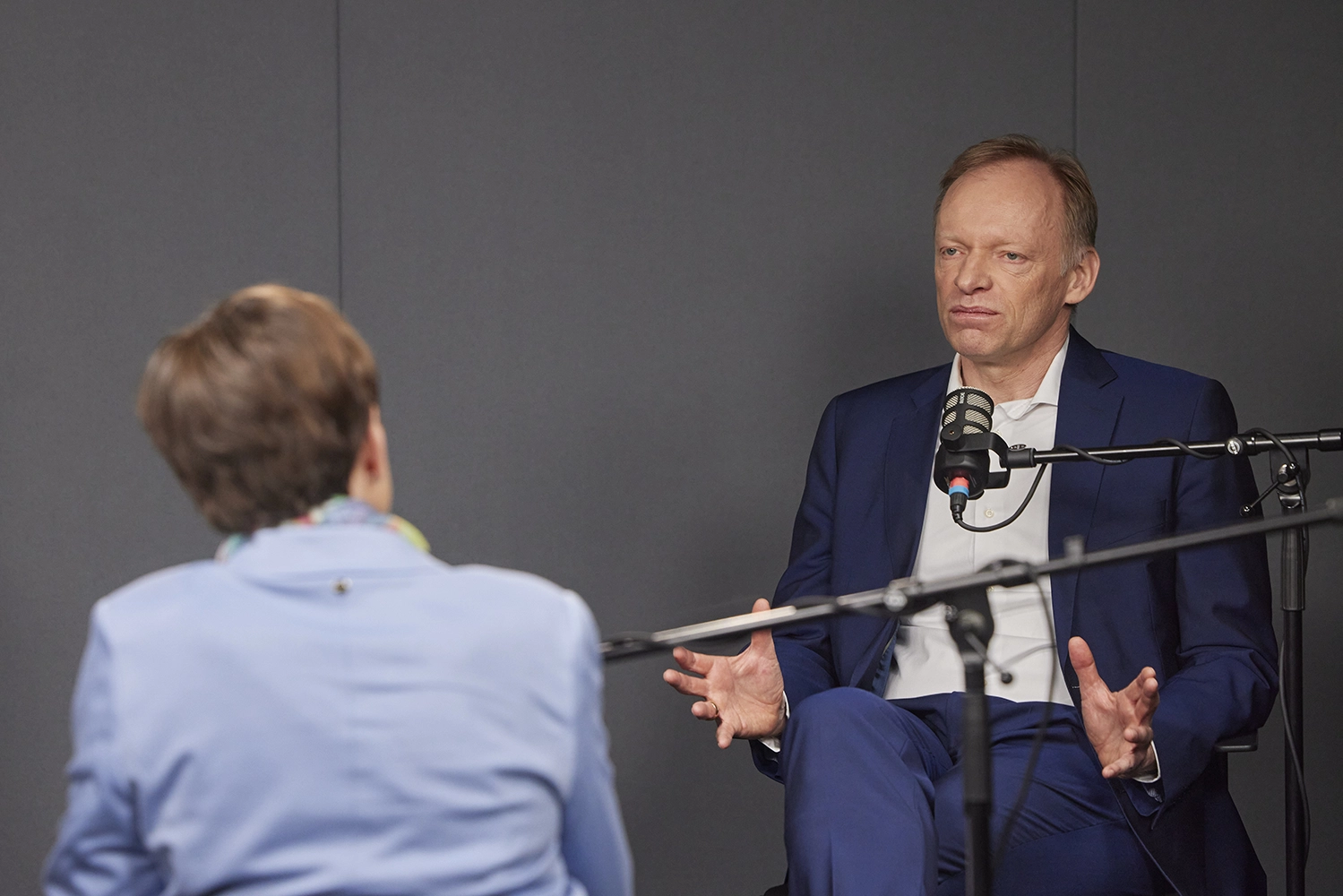
Science as a Strong Brand Core
The company’s own scientific expertise is maintained by making a concerted effort to cultivate emerging scholars. The close connection to the CESifo Network has a reinforcing effect. More than 2,000 researchers from renowned institutions worldwide meet regularly at the ifo Institute to discuss their projects, resulting in a variety of new research ideas and solutions. It is essential that the ifo Institute selects its scientific fields of activity for their relevance to the economic policy discourse. The guiding principle is the social market economy, in which a balance is struck between social justice and economic performance and – based on modern understanding – ecological sustainability.
Rough Environment for Research
Serious scientific findings have a hard time in the current sociopolitical environment, as characterized by polarization, fake news, and the shortening and radicalization of debates. That makes the ifo brand attributes of independence and credibility all the more important. The aim of the ifo Institute is to also provide guidance in complex topics. Intensive communication preparation and transfer work ensure that the ifo Institute can build bridges to society: It has an impact beyond disciplinary and institutional boundaries. The ifo Institute thus enables various stakeholders to make informed decisions based on reliable data.

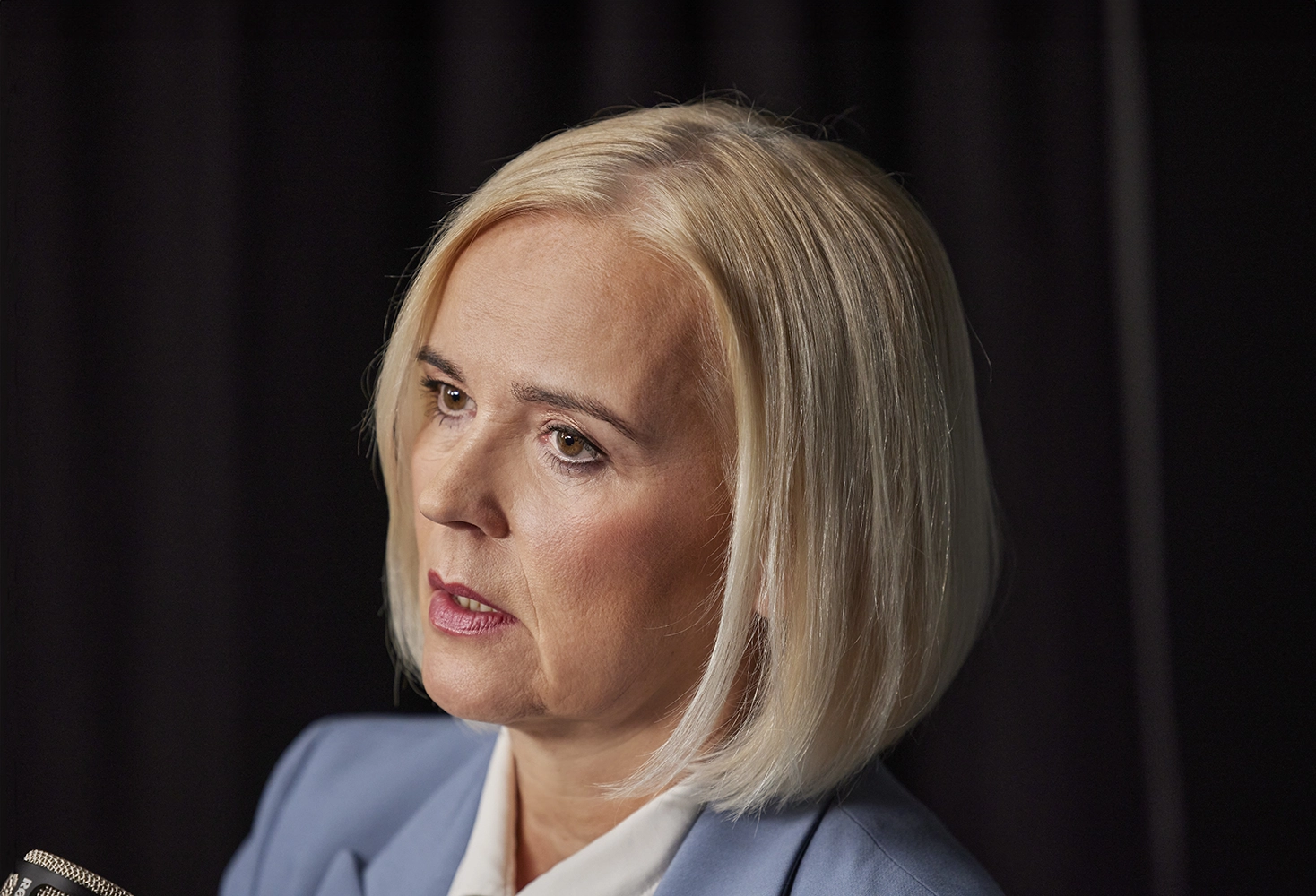
Employer Branding at the ifo Institute
In a competitive labor market, the employer brand plays a central role. ifo must position itself as an attractive employer so that it can recruit the best talent and young researchers on the global market. By communicating the organization’s vision and values, for example, in recruiting, everyday work, or interaction with managers, it becomes clear what makes working at the ifo Institute so special and why it is the ideal place for employees to advance their own (academic) career. Ideally, that works so well that employees have many positive experiences and share them with the outside world, hence further strengthening the brand. A strong employer brand is essential in order to secure and further expand the outstanding science and credibility of the ifo Institute in the long term.
The Institute’s Logo Over the Course of Time
The ifo Institute logo is an important recognition feature and symbol of the brand promise. Over the past 75 years, it has undergone quite a few upgrades, just like ifo itself. You can follow the evolution in the slider.
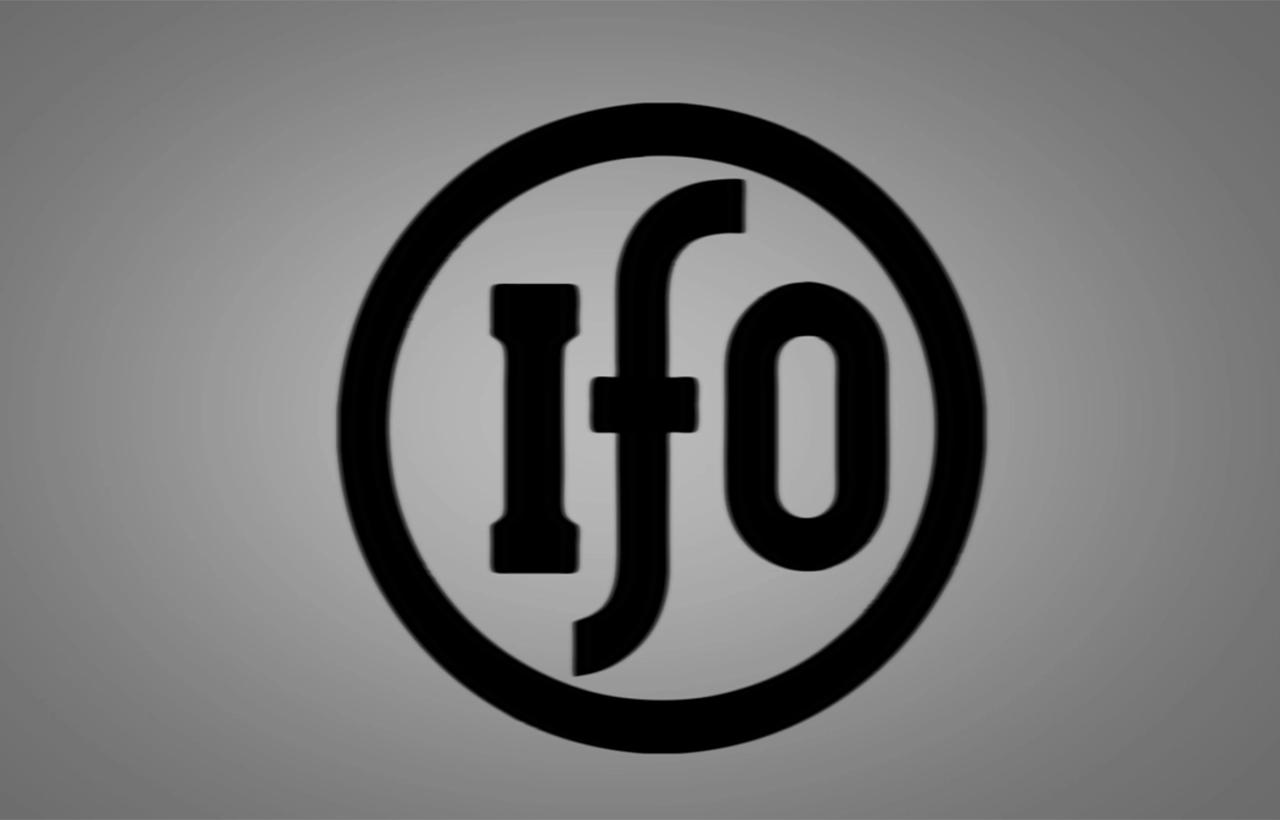
Impulse
The ifo Schnelldienst: Chronicles of a Leading Economic Publication
Whether as an economic barometer, a scholarly beacon, or a platform for vigorous debates, the ifo Schnelldienst has spotlighted economic policy issues like few other publications in Germany. To this day, it remains a crucial component of the ifo Institute‘s public outreach.
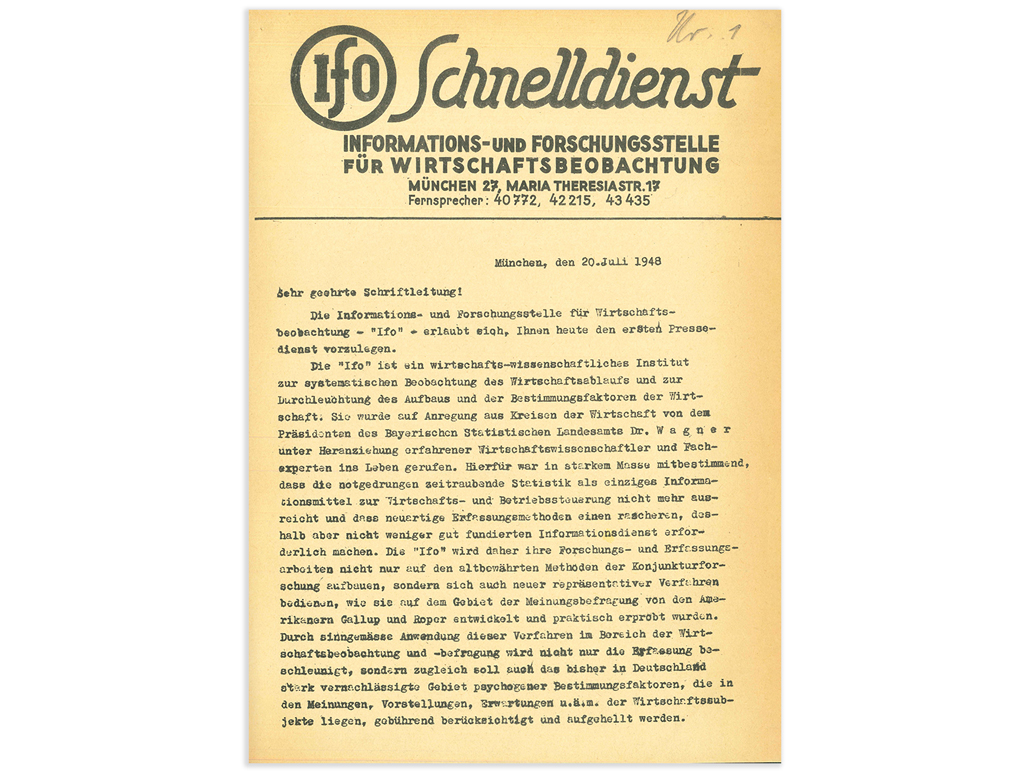
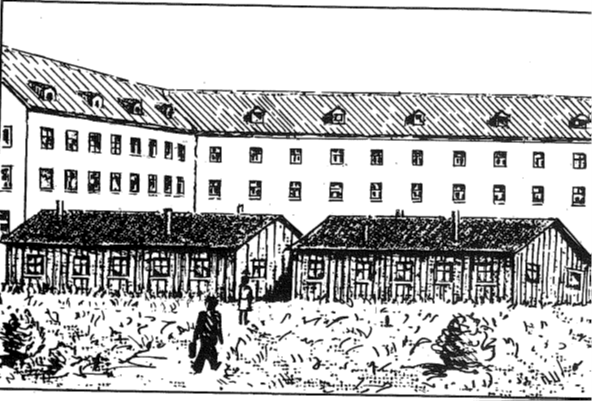
The Early Days: From Manual Efforts to Institutional Influence
The first issue was published by the Information and Research Center for Economic Observation, part of the Bavarian Statistical State Office, housed in a police barracks on Rosenheimer Straße 130 in Munich. In January 1949, this center merged with the South German Institute for Economic Research to become the Institute for Economic Research in Munich, shortly known as ifo. The origins of ifo’s “Schnelldienst” magazine trace back to six months before the institute's official establishment. By July 1948, the staff were already manually producing the first editions of the magazine on a duplicating machine, page by page, marking its official publication date as July 20, 1948.
Engaging with Post-War Economic Dynamics
The inaugural issue delved into the economic aspirations and realities of the post-war era, including the results from the first representative survey of industrial companies. This began the ifo business surveys, which have since become a cornerstone of the institute’s research. The publication also speculated on the reasons behind the sudden availability of goods in retail – whether it was a temporary post-currency reform effect or an indicator of burgeoning prosperity.
Analyzing current challenges in politics and the economy is still the core of ifo Schnelldienst today – its range of topics has expanded in many directions.
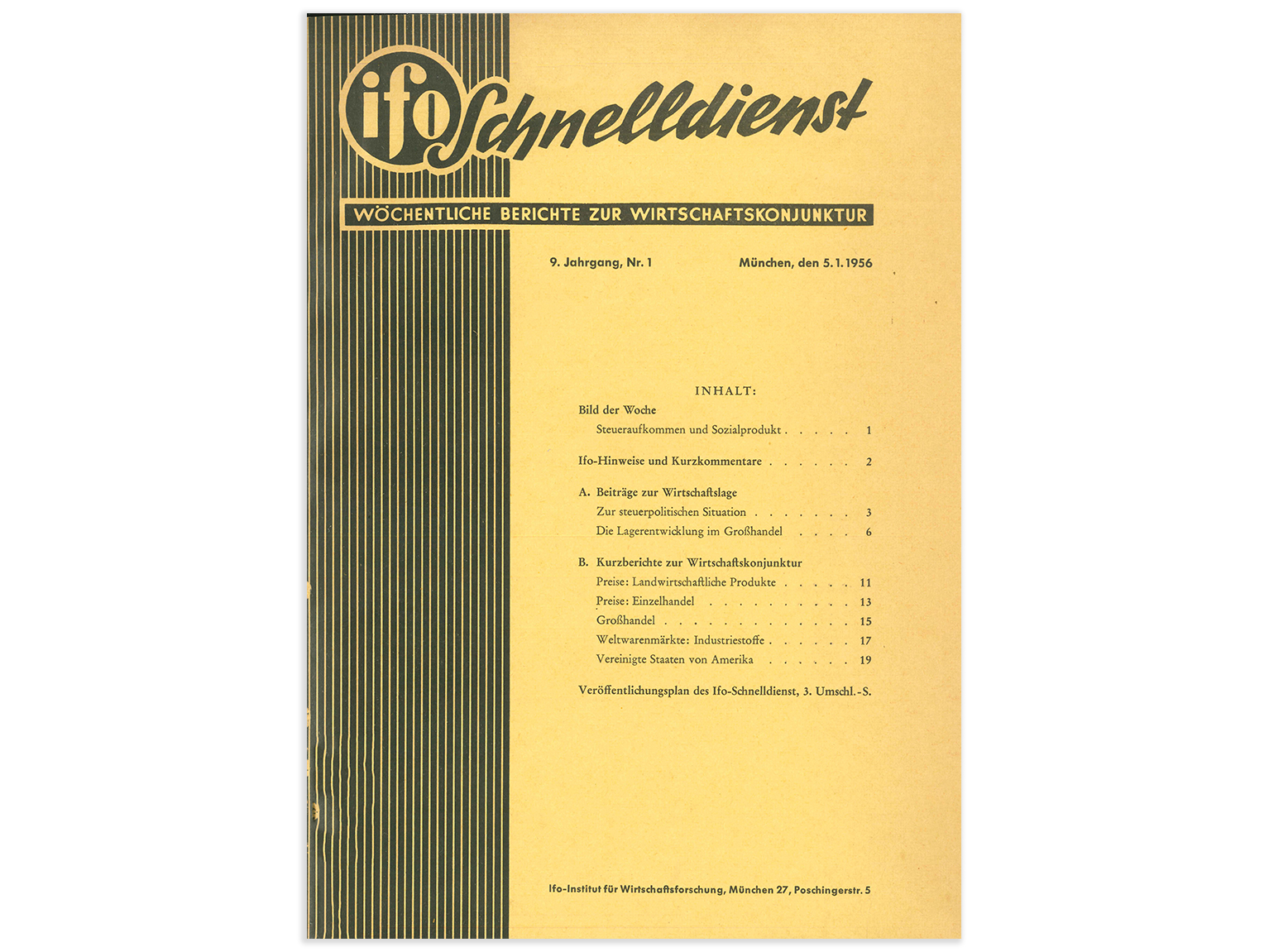
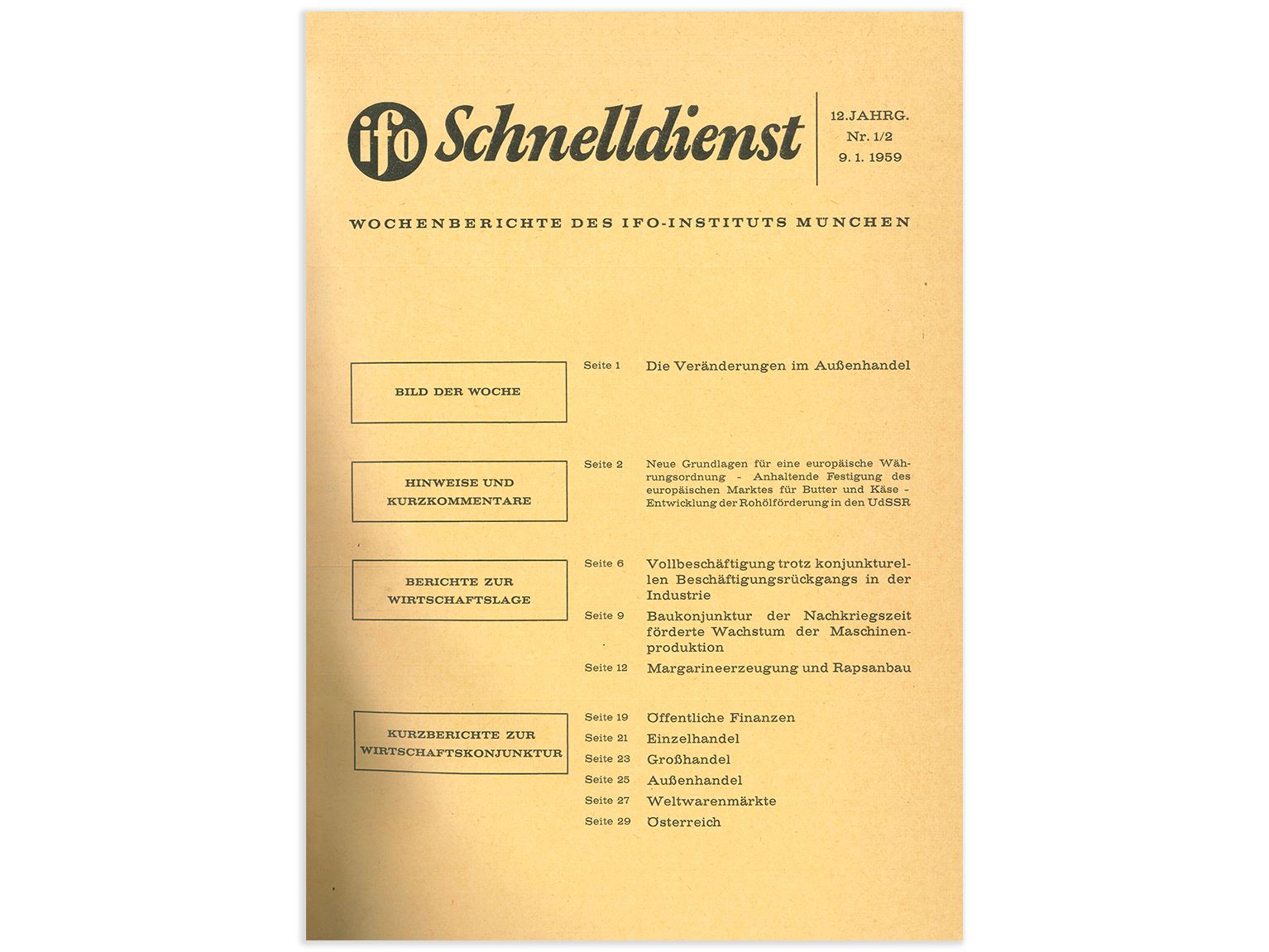
Editorial Oversight and Expansion
The significance of the ifo Schnelldienst to the institute is evident from the fact that a board member, Eduard Werlé, took over as editor-in-chief. The ifo Schnelldienst was the institute’s most crucial public relations tool; since 1999, when the initially quarterly, and from 1974 monthly, Wirtschaftskonjunktur publication was discontinued, it has also been considered the institute's flagship publication. Initially, the ifo Schnelldienst was intended solely to present “the most important results of our work” to the press, for a fee.
From Duplicators to Digital: A Journey of Modernization
Originally, the ifo Schnelldienst supplemented issues of Wirtschaftskonjunktur, differentiating itself with the subtitle „Wöchentlicher Kurzbericht zur Wirtschaftskonjunktur“ (Weekly Brief Report on Economic Trends). Initially still produced via hand-operated duplicators, each edition quickly landed on the desks of business editors and all members of the ifo Association, including ministries, universities, companies, and associations. This made the ifo Schnelldienst one of the most important sources of economic information in Germany and internationally. The switch from a hand-operated duplicator to a more modern offset printing press did not occur until two years later, with the establishment of its own in-house print shop in 1952 marking a significant advancement in the publication‘s production capabilities.

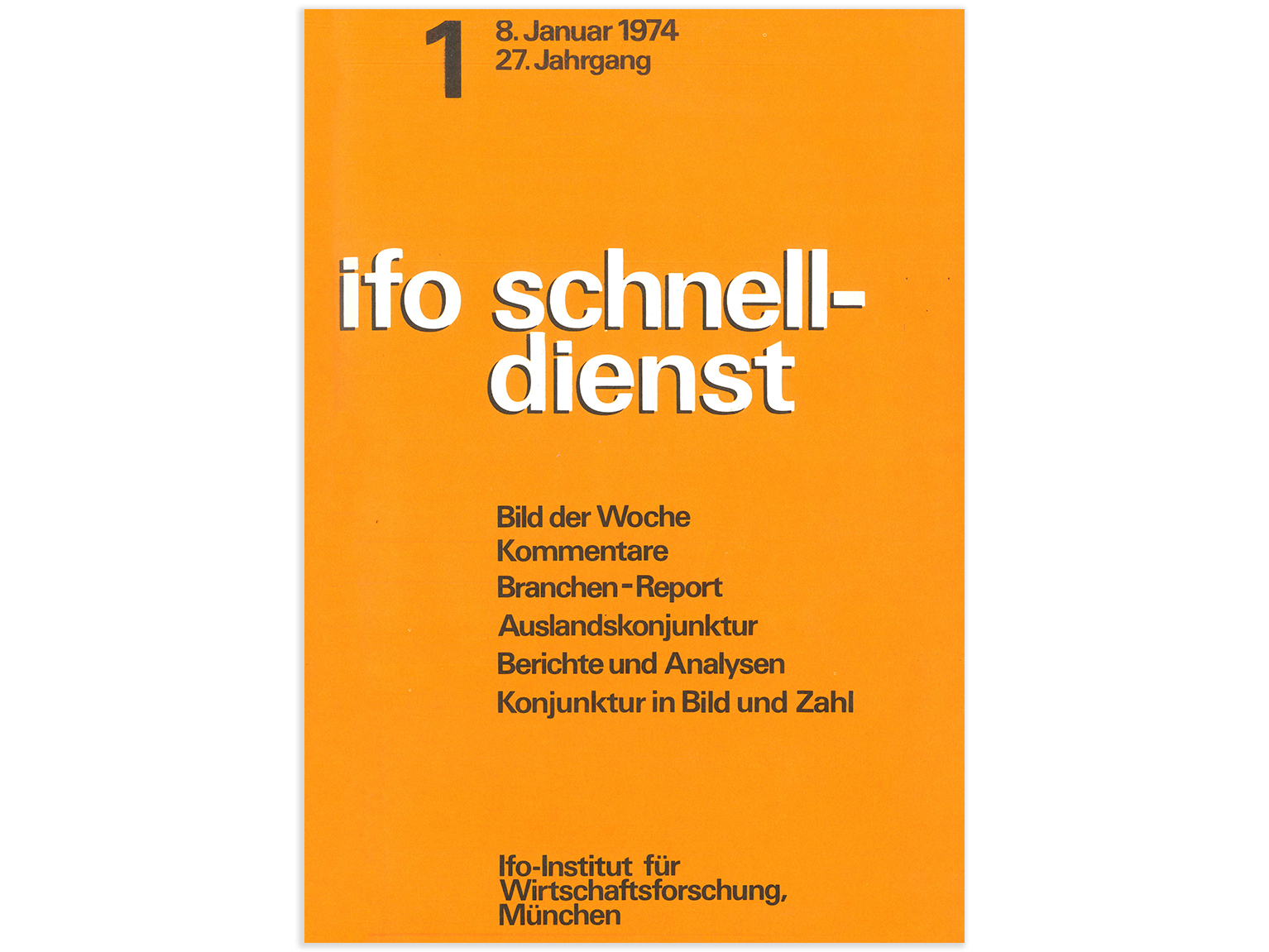
A Platform for Influential Voices and Debates
By 1954, the editorial team had structured the ifo Schnelldienst into fixed sections, which included the picture of the week, ifo notes, short commentaries, and articles on the economic situation. Subscriptions were then opened to anyone interested in economic issues, cementing the publication‘s role as a key platform for economic discourse. It quickly became evident among the Institute‘s staff that those with valuable insights or data should aim to publish in the ifo Schnelldienst. Between 1970 and 1976, the publication featured an average of 136 articles per year from various ifo contributors.
This publication has not only documented key economic policy issues in the history of the Federal Republic of Germany, like the Hartz reforms, EU‘s eastward expansion, and the euro crisis, but also marked significant milestones in the institute’s own history. Notably, the ifo Business Climate Index, a key tool familiar to news and business journalists today, made its debut here – albeit inconspicuously with just a three-line table in the 1971 issue showing the index’s development from January 1970 to February 1971.
A New Era of Dialogue and Digital Presence
Remaining faithful to its mission until the late 1990s, the ifo Schnelldienst underwent a significant transformation as the institute redefined its publication strategy. It embraced contributions from external authors and introduced the “For discussion” section in 2020, enhancing the visibility of ifo researchers and aligning with the institute’s modern communication strategy. Since then, this section has focused on topics covered by the ifo Institute. That same year marked the digital launch of ifo Schnelldienst, allowing for more flexible and frequent publications.
This digital expansion enabled the ifo Schnelldienst to publish articles outside the traditional monthly publication schedule, thereby increasing its responsiveness to current economic events and debates.
Note: For the sources used in this text, click on the imprint.

Publications
The Leibniz Association – From the Königstein Agreement to the Present Day
The Leibniz Association, based in Berlin, unites non-university research institutes from various disciplines in Germany. Its history goes back to the beginnings of the Federal Republic of Germany: On March 31, 1949, the West German states and West Berlin agreed on joint financial support for supraregional research institutions in the Königstein State Agreement. The ifo Institute was one of these research institutions right from the start.
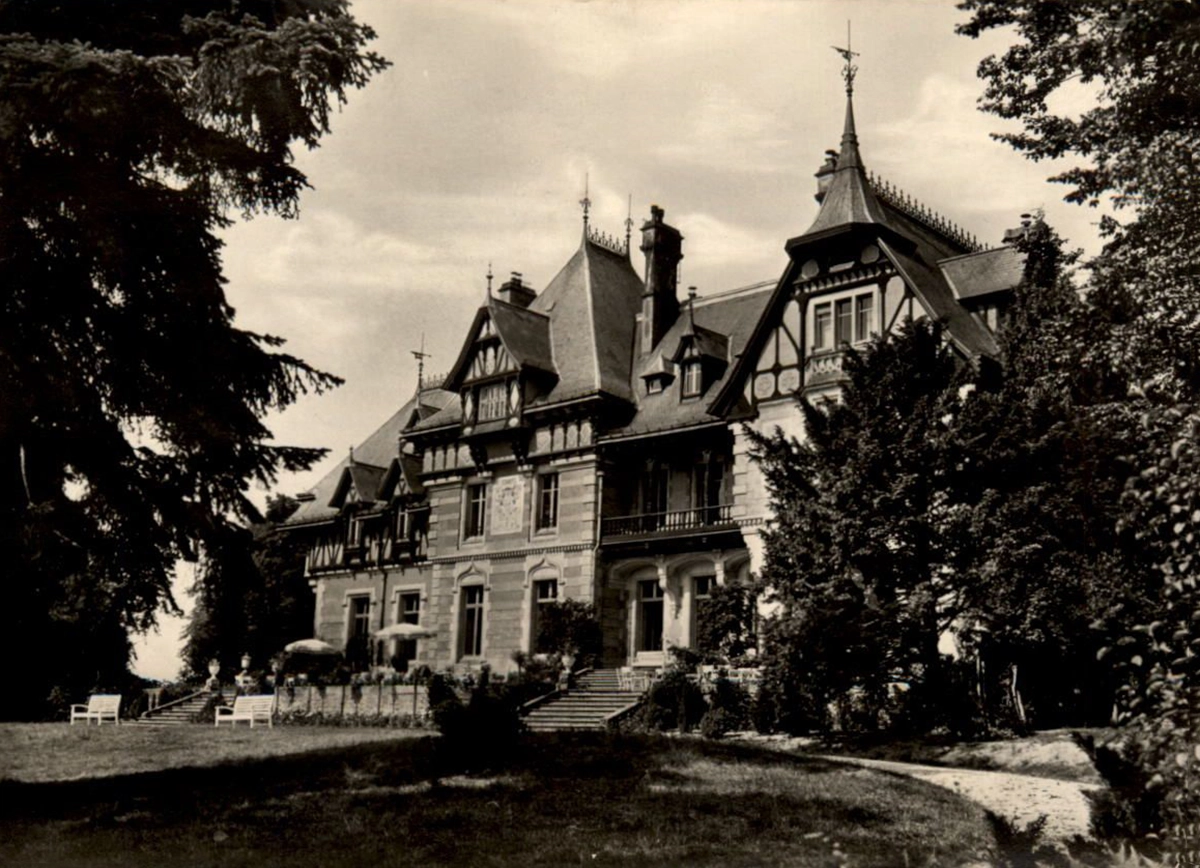
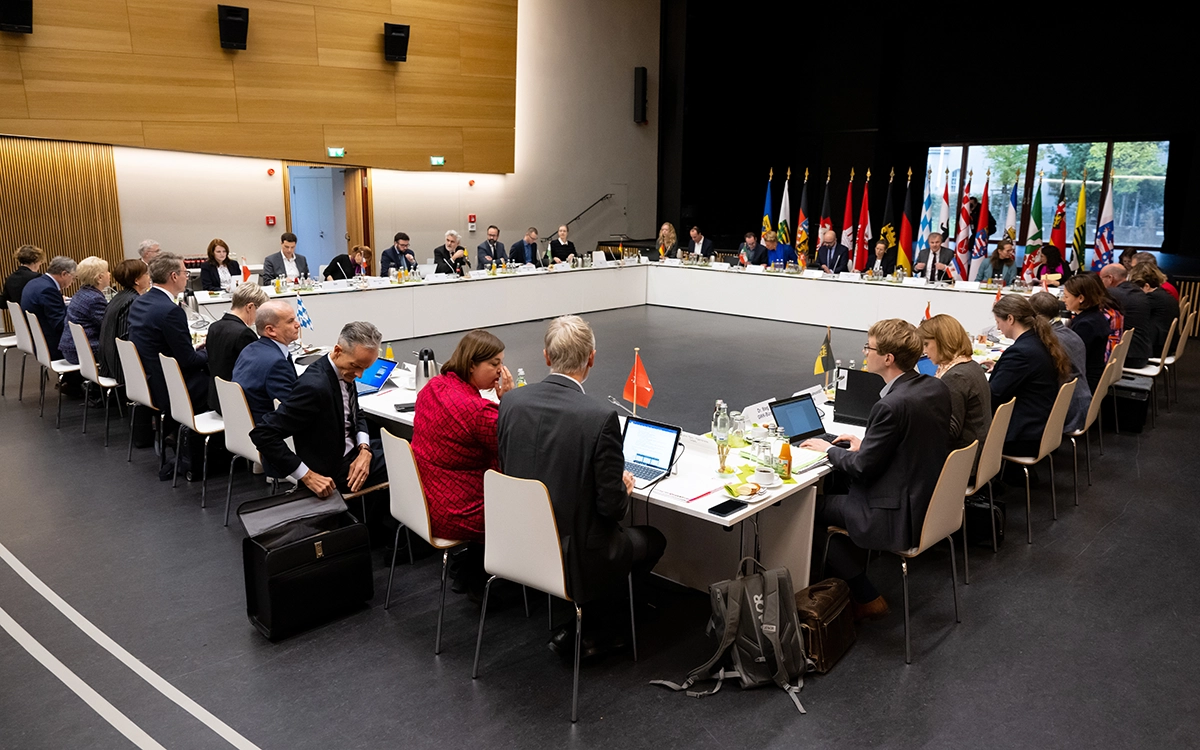
The Königstein Key
The term “Königstein Key” goes back to the Königstein State Agreement. It regulates the burden-sharing between the federal states in the funding of scientific research institutions, in particular the funding of the German Research Foundation (DFG), the Max Planck Society (MPG), the German Academy of Science and Engineering (acatech), and the Leibniz Association. The share that each German state has to bear is based on two-thirds tax revenue and one-third population. Today, this key is recalculated each year by the Joint Science Conference (GWK). In addition to science and research funding, it is used for a wide variety of issues relating to the distribution between the federal and state governments.
The Role of the Science Council
The Königstein Agreement of 1949 stipulated that the federal states should regulate the joint financing of research institutions. However, the Federal Government soon wanted to influence the allocation of financial resources for the development and establishment of the German science system. On September 5, 1957, Konrad Adenauer signed an administrative agreement on the establishment of a Science Council. This aim of this council was to provide an overview of scientific work in Germany and make proposals to the government for the promotion of science. To this day, the Science Council brings together representatives from science, public life and politics to advise the federal and state governments on key issues relating to the German science system.
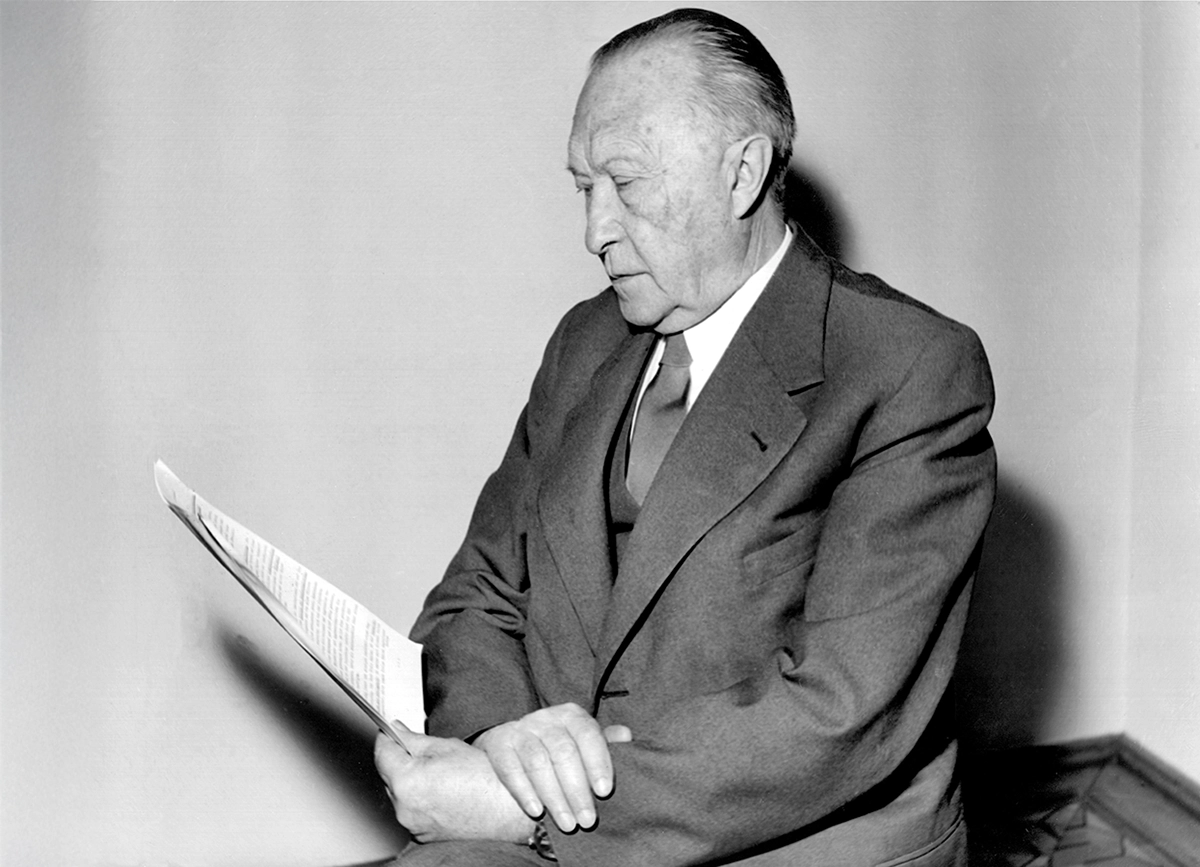
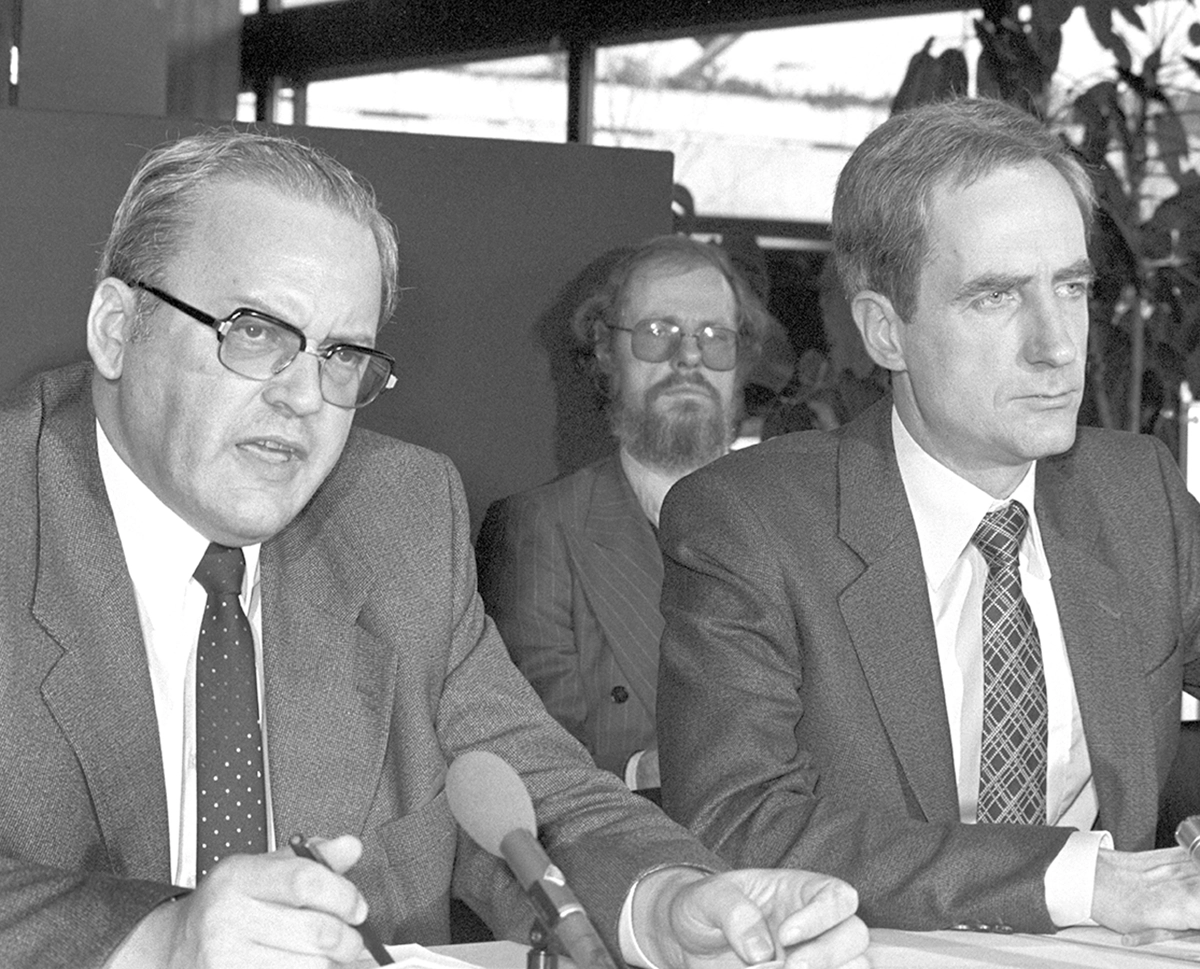
Forerunner of the Joint Science Conference
The Königstein State Agreement was initially limited to five years, after which it was repeatedly extended. When another deadline expired in 1969, it became clear that the costs of research funding, which had risen sharply in the meantime, could not be borne without the involvement of the federal government. In 1970, Article 91b of the German Basic Law gave the federal states, together with the federal government, the constitutional opportunity to cooperate on important supraregional research projects of scientific interest to the whole of Germany. In the same year, the Federal-State Commission for Educational Planning was set up, whose remit was extended in 1975 to include research institutions outside the universities.
Today, the Joint Science Conference (GWK), founded on 1 January 2008, is the successor organization to the Federal-State Commission for Educational Planning and Research Promotion.
A List on Blue Paper
Even after the Federal-State Commission’s responsibility was extended to research institutions in 1975, it took another two years before a joint agreement for these institutions was signed by the representatives of the federal and the state governments. The main reason for this long process was the selection of research institutions to be funded. Initially, there were over 300 institutions. In 1977, the federal and state governments published a list of 46 institutions. The blue paper on which the list was published gave it its name. Since 1979, the institutions on the Blue List have been regularly evaluated by the Science Council.
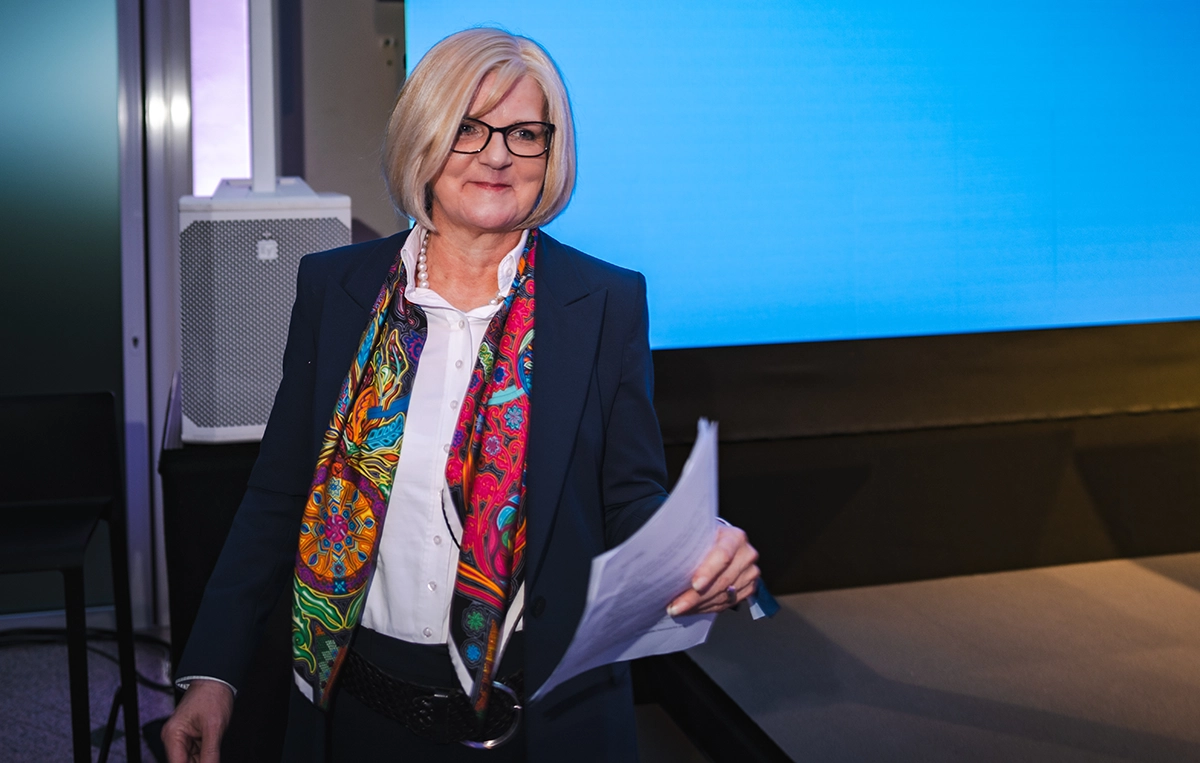
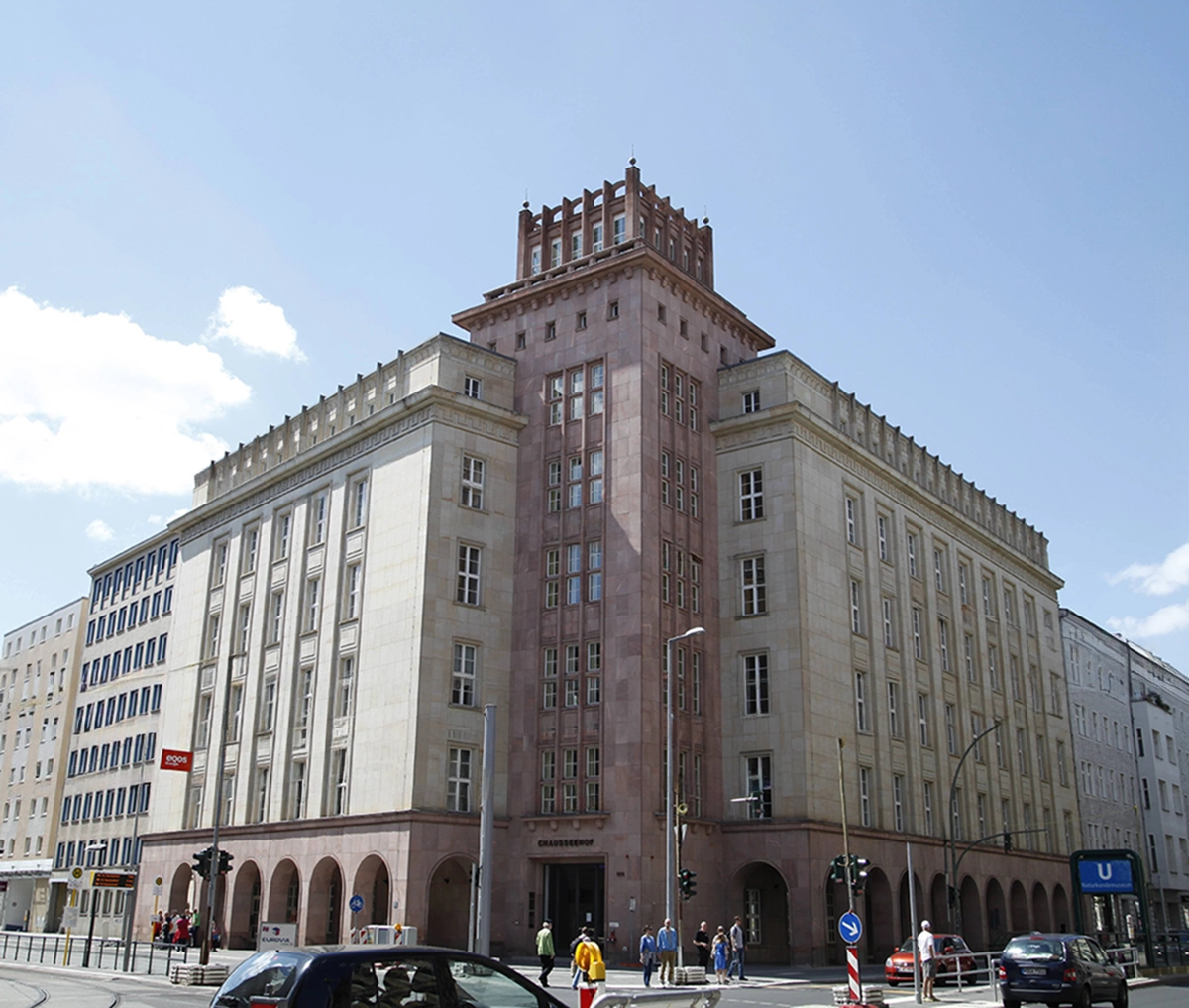
New Name: Leibniz Association
On January 24, 1991, representatives of initially 32 research institutions founded the “Blue List Partnership”, which exchanged information across institutions, particularly on administrative issues, and was renamed the “Leibniz Association” in 2000. The association’s office was in Bonn until 2011, when it moved to Berlin.
Since 2003, the externally appointed Senate of the Leibniz Association has been evaluating the Association’s institutions. Every seven years at the latest, the Senate, together with the Division Evaluation Committee, evaluates an in-depth procedure how the institution has developed in terms of content and structure over the past few years, and the persuasiveness of its plans for the future. It also examines how it cooperates with other institutions, such as neighboring universities, and international visibility. The statements of the Senate justify the decisions of the Joint Science Conference on the funding eligibility of the Leibniz Association institutions.
Funding Structure
Leibniz institutes are institutes and research facilities that receive joint basic funding from the federal and state governments. As a rule, the funding formula is: 50% federal funds, 50% state funds. Most of the federal funding comes from the budget of the Federal Ministry of Education and Research, but the economic research institutes of the Leibniz Association receive their funding at federal level from the Federal Ministry for Economic Affairs and Climate Action and at state level from their respective state: in the case of the ifo Institute, from the Bavarian State Ministry of Economic Affairs, Regional Development, and Energy. In addition to the basic funding, there are third-party funds, which must be raised by researchers, and other revenues (publication revenues, database sales, membership fees, etc.).
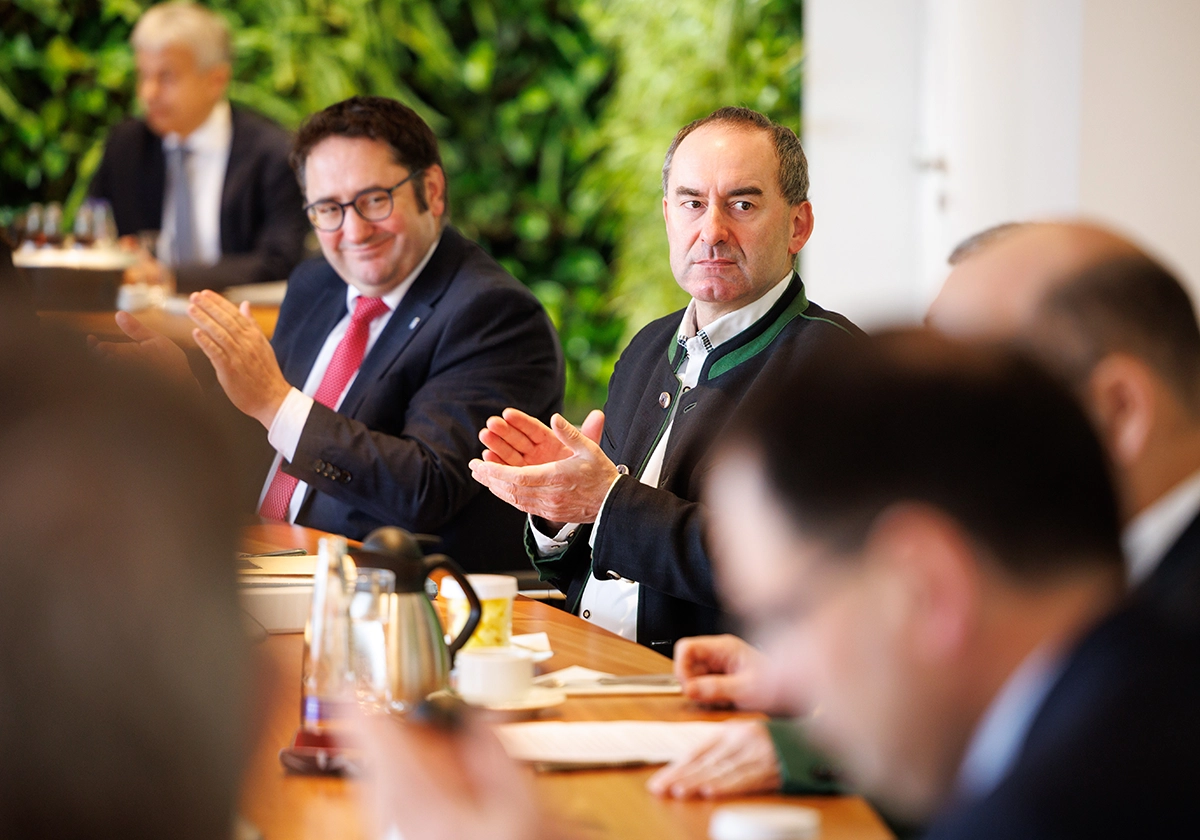

The IfW in Kiel

Courtyard DIW in Berlin
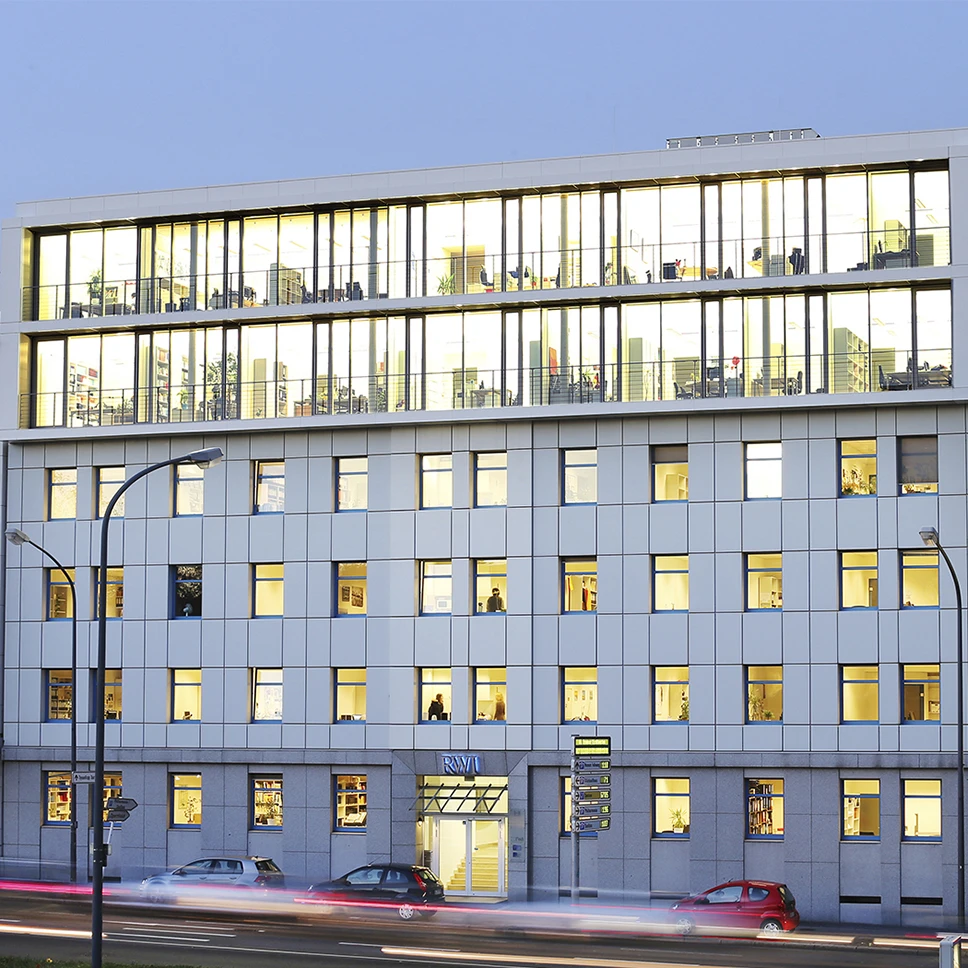
The RWI in Essen

Head office of the IWH in Halle
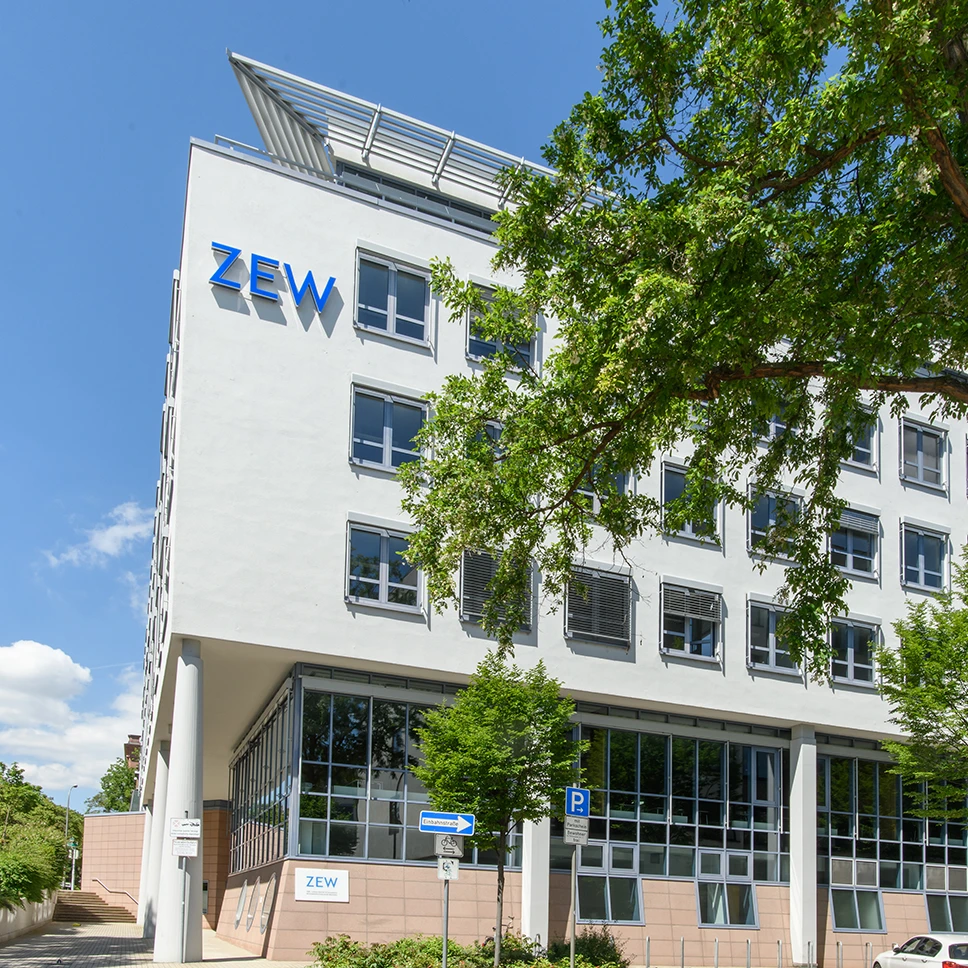
Exterior view of the ZEW in Mannheim
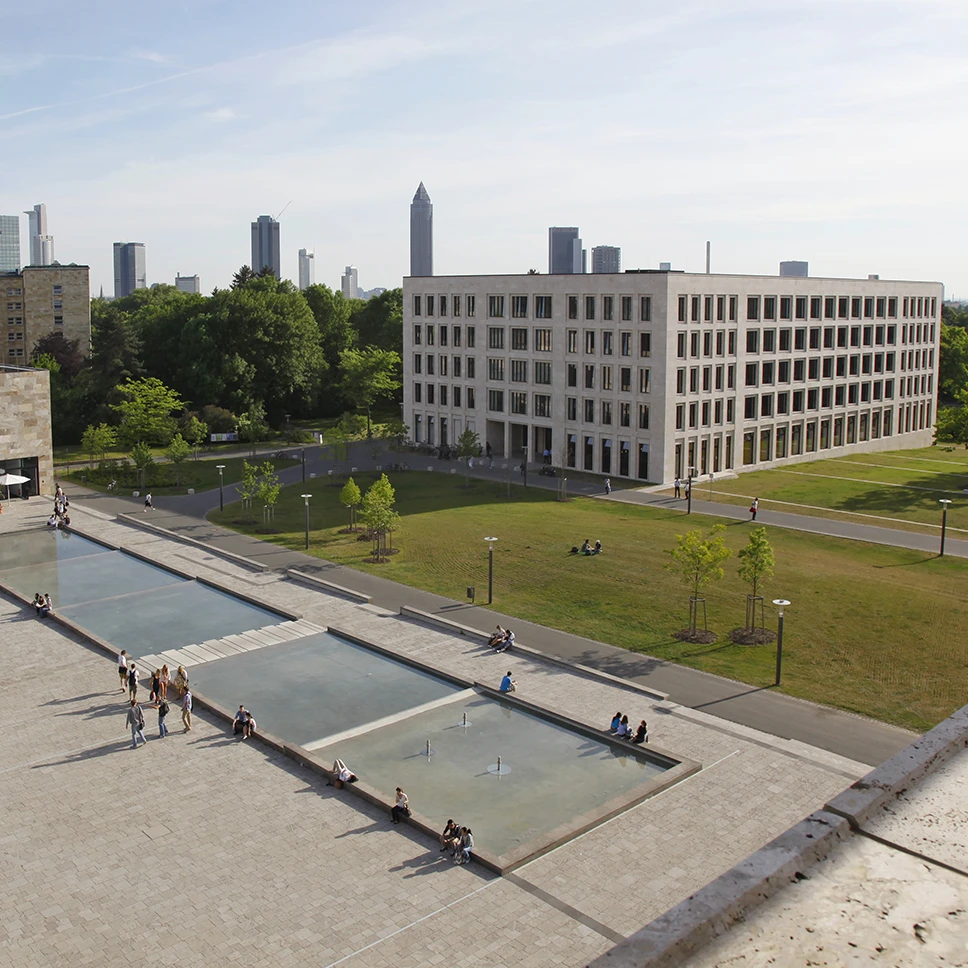
The SAFE in Frankfurt
Further Institutes in the Field of Economic Research
In addition to the ifo Institute, six other economic research institutes belong to the Leibniz Association (see picture slider):
- Kiel Institute for the World Economy (IfW Kiel). Founded in 1914. President since 2023 Moritz Schularick.
- German Institute for Economic Research (DIW Berlin). Founded in 1925 as the Institute for Business Cycle Research by Ernst Wagemann. President since 2013 Marcel Fratzscher.
- RWI – Leibniz Institute for Economic Research (Rheinisch-Westfälisches Institut) in Essen. Founded in 1926 by Walther Däbritz as the “Department West” of the Institute for Business Cycle Research. President since 2002: Christoph M. Schmidt.
- Leibniz Institute for Economic Research Halle (IWH). Founded in 1992 as an institute for applied empirical economic research for the new federal states. President: Reint E. Gropp.
- ZEW – Leibniz Center for European Economic Research in Mannheim. Founded in 1990. President: Achim Wambach.
- Leibniz Institute for Financial Research SAFE (Sustainable Architecture for Finance in Europe) in Frankfurt. Admitted to the Leibniz Association in 2020. Managed by Florian Heider since 2022.
Beginnings
The Road to European Integration: The EEC’s Formation
The economic reconstruction of Europe post-World War II was intrinsically linked to renewed efforts towards European unification. This vision took a concrete shape with the establishment of the European Coal and Steel Community (ECSC) in 1951 by France, Germany, Italy, and the Benelux countries. This marked the initial step to-wards creating a common European economic area, laying the groundwork for the formation of the European Economic Community (EEC) in 1957. The ifo Institute provided in-depth analysis throughout this process, closely monitoring the unfolding integration.
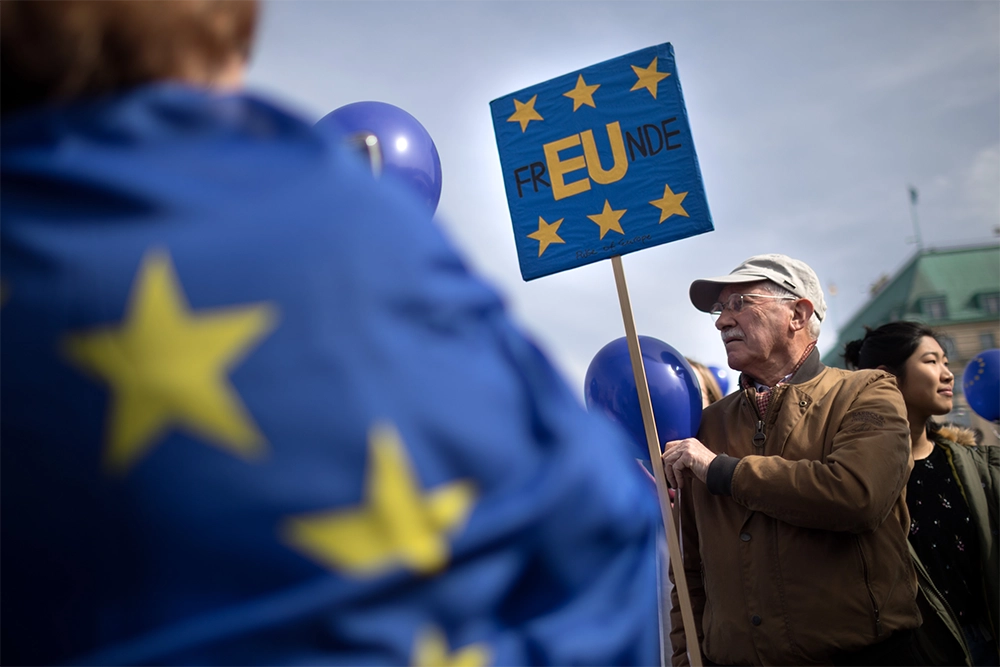
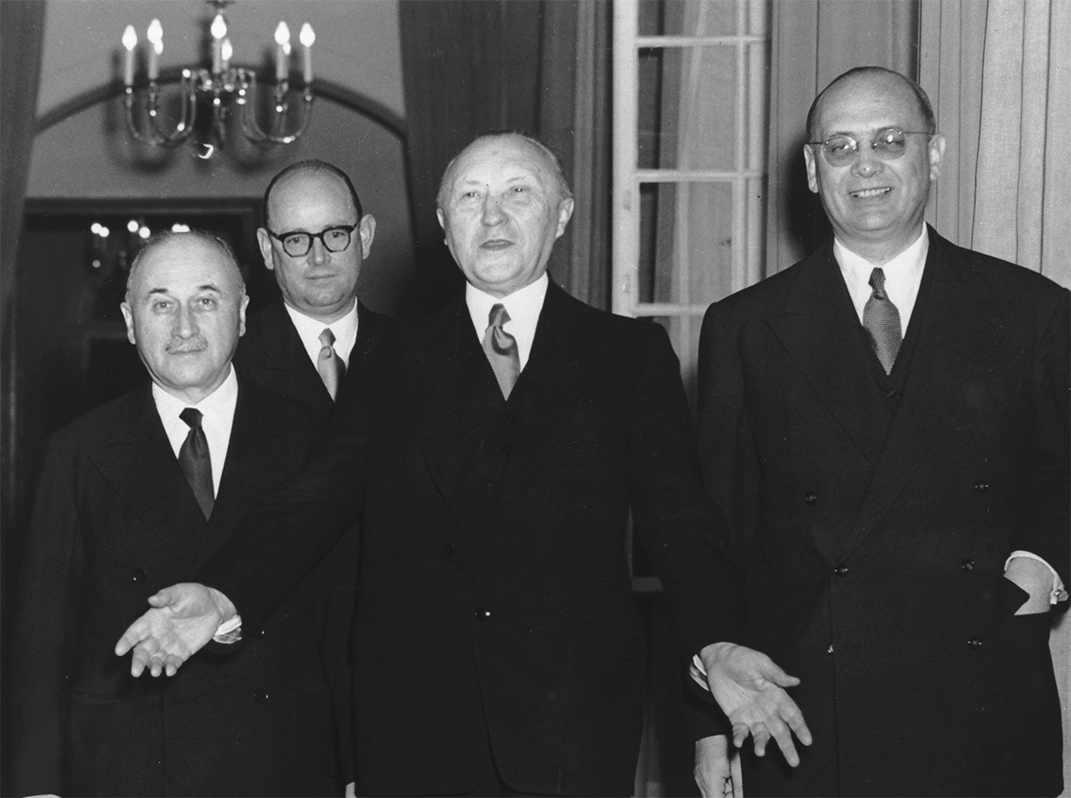
Challenges Along the Way
The journey towards integration wasn’t without its hurdles. In 1954, the proposed European Defense Community (EDC) stumbled due to a veto from the French Na-tional Assembly, highlighting the complexities of aligning not just economic but also military and political interests across nations. A pivotal moment came in 1955, when the stalled unification efforts were revitalized by focusing on economic collaboration based on the successful model of the ECSC.
Strategic Economic Discussions
The revival of integration efforts gained momentum at the Messina Conference in 1955, where ECSC members convened to discuss a new economic community. The conference, led by French Foreign Minister Jean Monnet, who was instrumental in proposing the economic unification, also prioritized cooperation in the nuclear sec-tor, seeing the peaceful use of nuclear energy as a key component of their collective progress.


Formulating the Common Market
The “Spaak Commission,” named after Belgian Foreign Minister Paul-Henri Spaak and set up as a result of the conference, developed recommendations that formed the basis for establishing a common market. This market was envisioned to encom-pass free movement of goods, services, capital, and people, alongside a common agricultural market and a unified European trade policy. These initiatives were aimed at eliminating customs barriers and quotas, thereby fostering a more integrated Eu-ropean economy.
Significant Milestones in Rome
On March 25, 1957, the six founding states signed the Treaties of Rome, establishing the EEC and the European Atomic Energy Community (EURATOM). These treaties, which came into effect on January 1, 1958, were seen by German Chancellor Konrad Adenauer not just as economic agreements but as pivotal political instruments aimed at furthering European political integration through economic collaboration: “The Common Market must be seen not primarily as an economic treaty, but as a political instrument. It must be seen in conjunction with the Council of Europe, the Coal and Steel Community and EURATOM; in short, it is a series of political facts. The EEC is essentially a political treaty, the purpose of which is to achieve the political integration of Europe by means of economic commonality.”
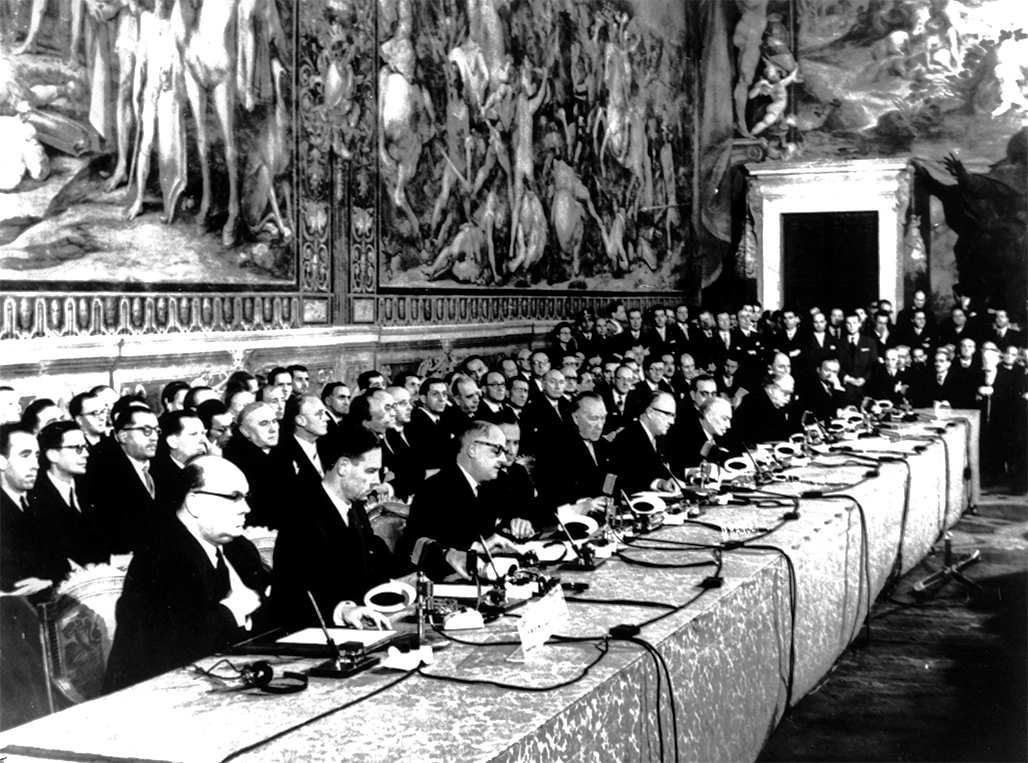
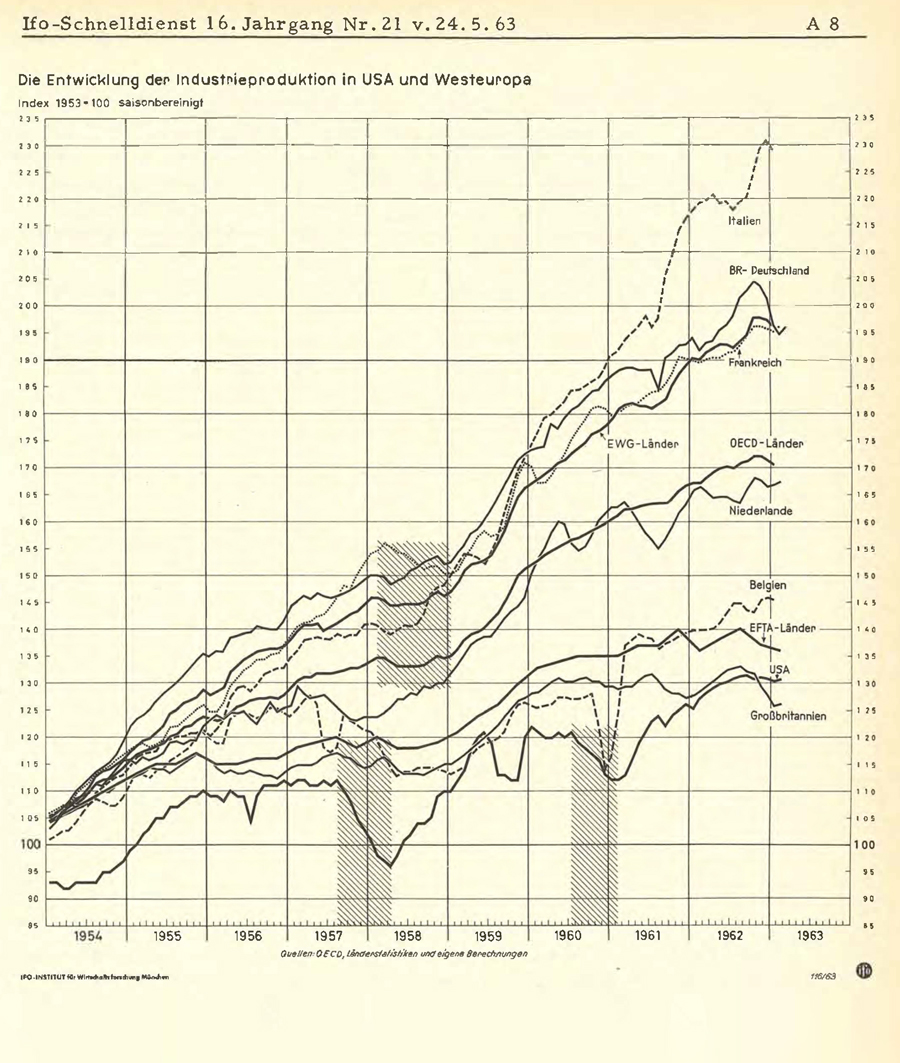
The ifo Institute’s Role and Perspective
From the beginning, the ifo Schnelldienst, a publication of the ifo Institute, covered various facets of European cooperation, starting with discussions on meat produc-tion within the EEC in 1957. From 1961 onwards, the focus broadened. As the EEC’s Directorate-General for Economic and Financial Affairs sought to standardize official statistics and introduce industry surveys, ifo was tasked in 1961 with implementing these surveys in Western Germany. Closely based on the ifo tendency surveys, the European Business Survey was published monthly from spring 1962 onwards and was carried out in around 14,000 industrial companies in the European Economic Community. An annual investment survey was added somewhat later. The results of both surveys have been published regularly in the Schnelldienst since 1963.
A Critical Voice Amidst Economic Optimism
While the EEC was generally viewed positively, the ifo Institute maintained a critical stance, questioning the direct correlation between the EEC and economic upturns in member states. This skepticism was articulated in the Schnelldienst on May 24, 1963, arguing that while economic integration contributed to growth, the real drivers were the intrinsic economic strengths of member countries like France, Italy, and West Germany. The ifo’s objection to the generally positive assessment of the effectiveness of the new economic community, was based on the institute’s own surveys, which intervened in the public debate with fact-based arguments. Even today, develop-ments and policy decisions in the EU are a strategically important field for the ifo Institute and for the political platform EconPol.
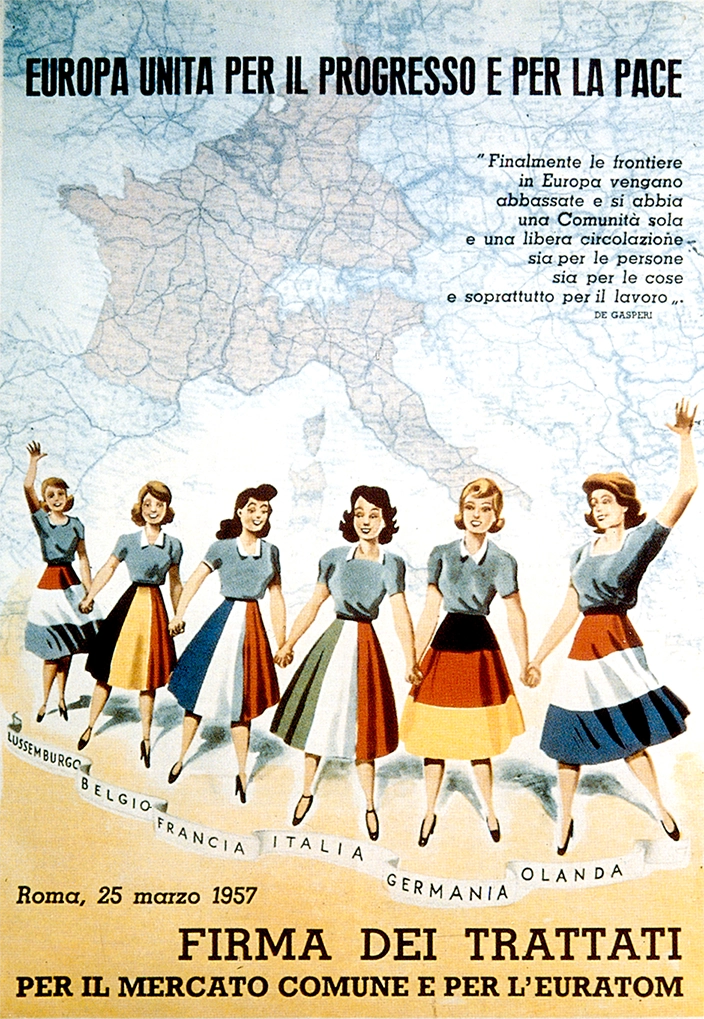
Milestone
The Social Market Economy: Yesterday, Today and Tomorrow
The social market economy combines economic efficiency with social balance. It is historically inextricably linked with Ludwig Erhard’s promise of “prosperity for all”. Today, the social market economy faces numerous challenges: from coping with climate change to the digitalization of the economy and geoeconomic upheaval. What reforms are needed to overcome these challenges? The new Ludwig Erhard ifo Center for Social Market Economy and Institutional Economics in Fürth, the birthplace of Ludwig Erhard, addresses this question about the future of the social market economy.
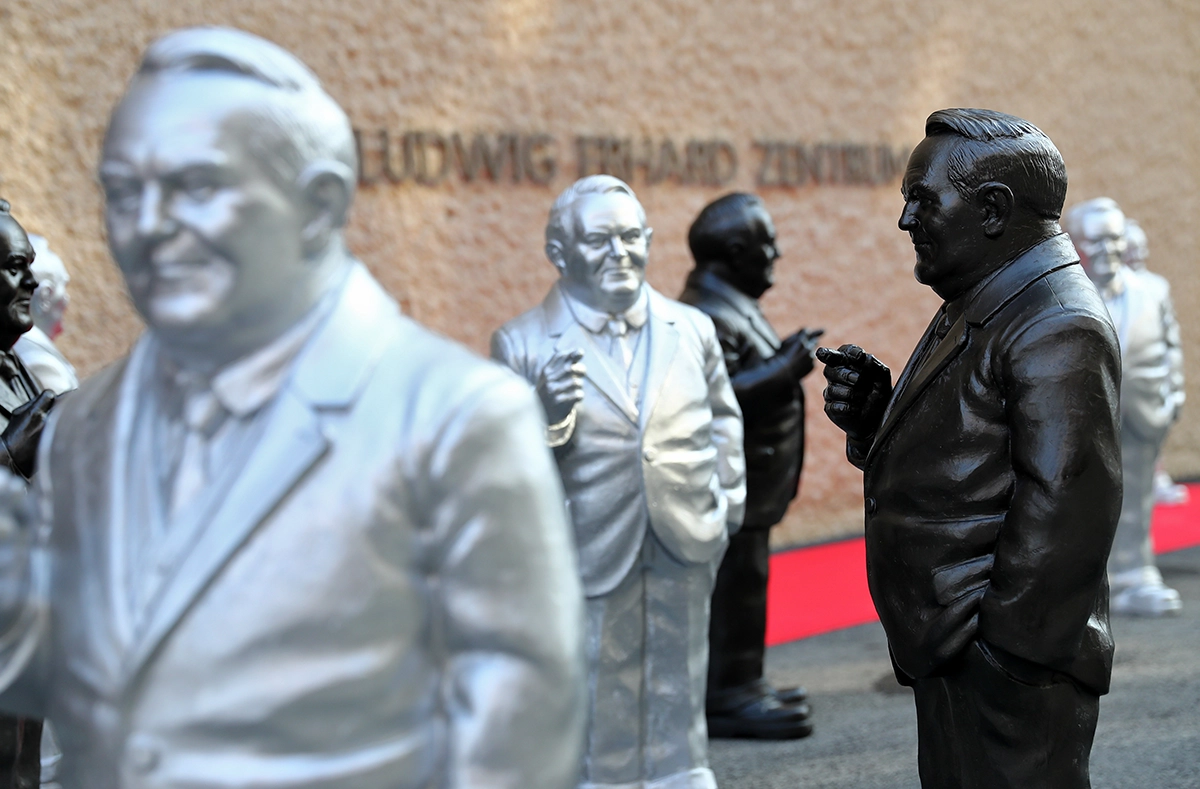
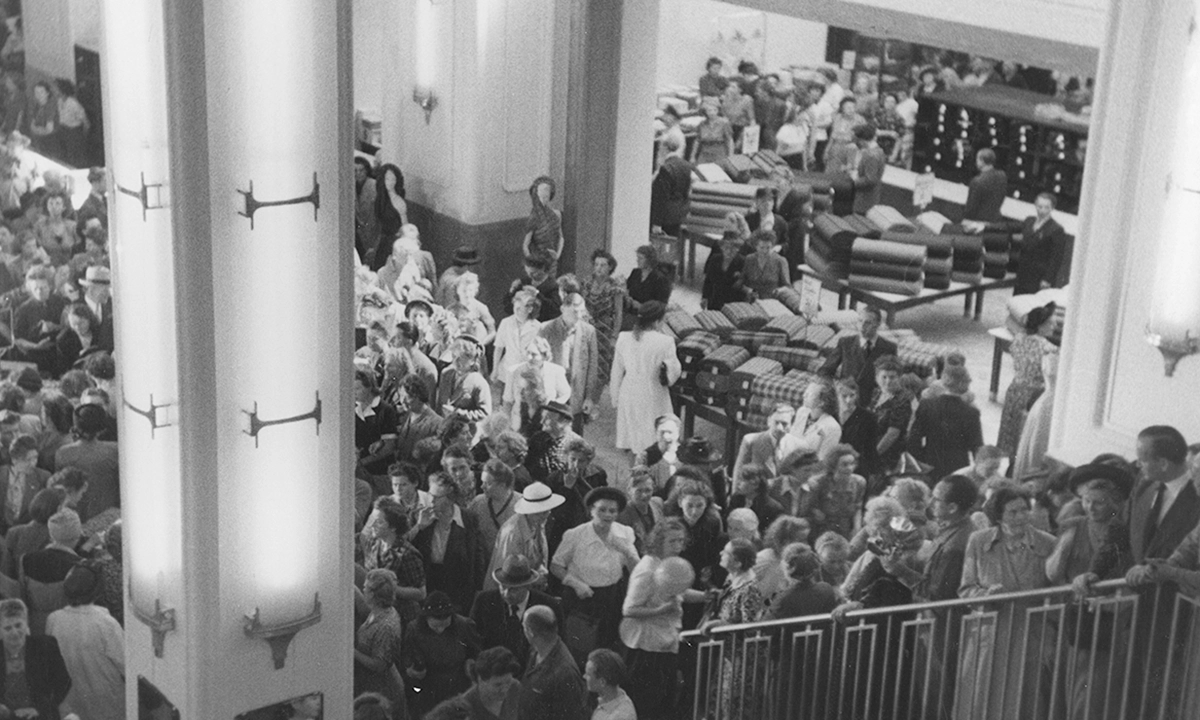
The social market economy has been a central pillar of social order in Germany since the Second World War. The European Union is also aiming for a “competitive social market economy”. The social market economy is regarded, not least due to the experiences of the post-war period, as an economic and social model that is recognized worldwide beyond Germany. Nevertheless, the founding fathers already had differing views as to what the social market economy should represent. Ludwig Erhard, the “political father” of the social market economy, counted himself among the representatives of ordoliberalism, according to which the foundation of the social market economy should be a competitive order. With its economic policy, as a regulatory policy, the state should primarily define the “rules” for economic activity.
Attitudes toward the social market economy
Do people today still believe in the social market economy as a guarantee for “prosperity for all”? What do people in Germany think of our economic order, and what do they even understand today by the term “social market economy”? To find answers to these questions, the Ludwig Erhard ifo Center conducted a broad-based, representative survey together with the ifo Center for Public Finance and Political Economy. Overall, 75 percent of Germans have a positive view of the social market economy. On a scale of 1 (very poor) to 10 (very good), the average rating is 6.8.
Approval depends in part on the nature of the participants. Men rate the social market economy almost one point higher than women. A migration background or place of residence (Eastern or Western Germany) play no role in approval of the social market economy. Younger respondents rate the social market economy slightly less favorably than older respondents. Educational qualifications make a big difference. The lowest level of approval of the social market economy is among people without a school-leaving qualification. It is worth noting that approval increases steadily with a higher level of education. A similar picture emerges with regard to income: As household income rises, so too does approval of the social market economy.
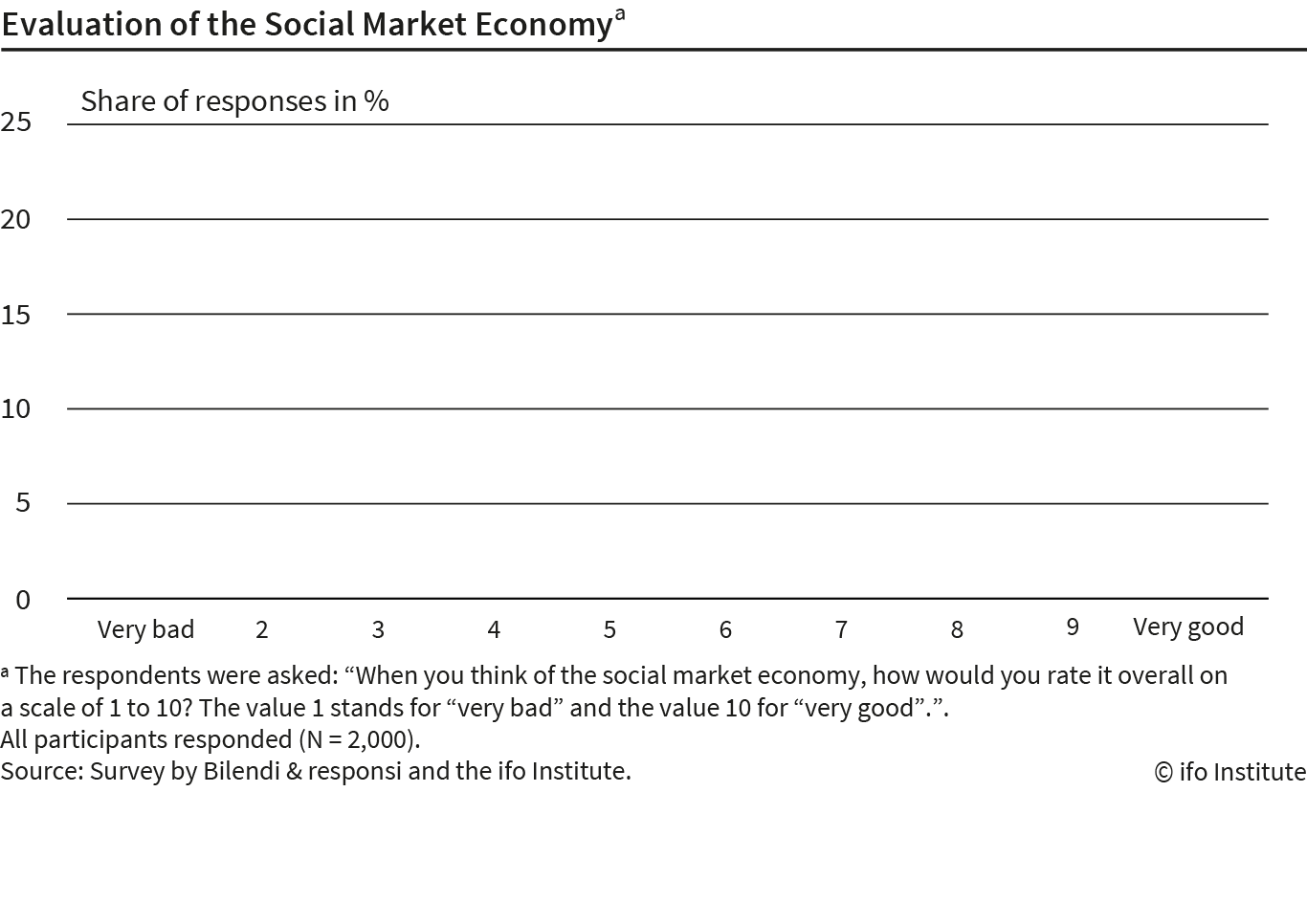
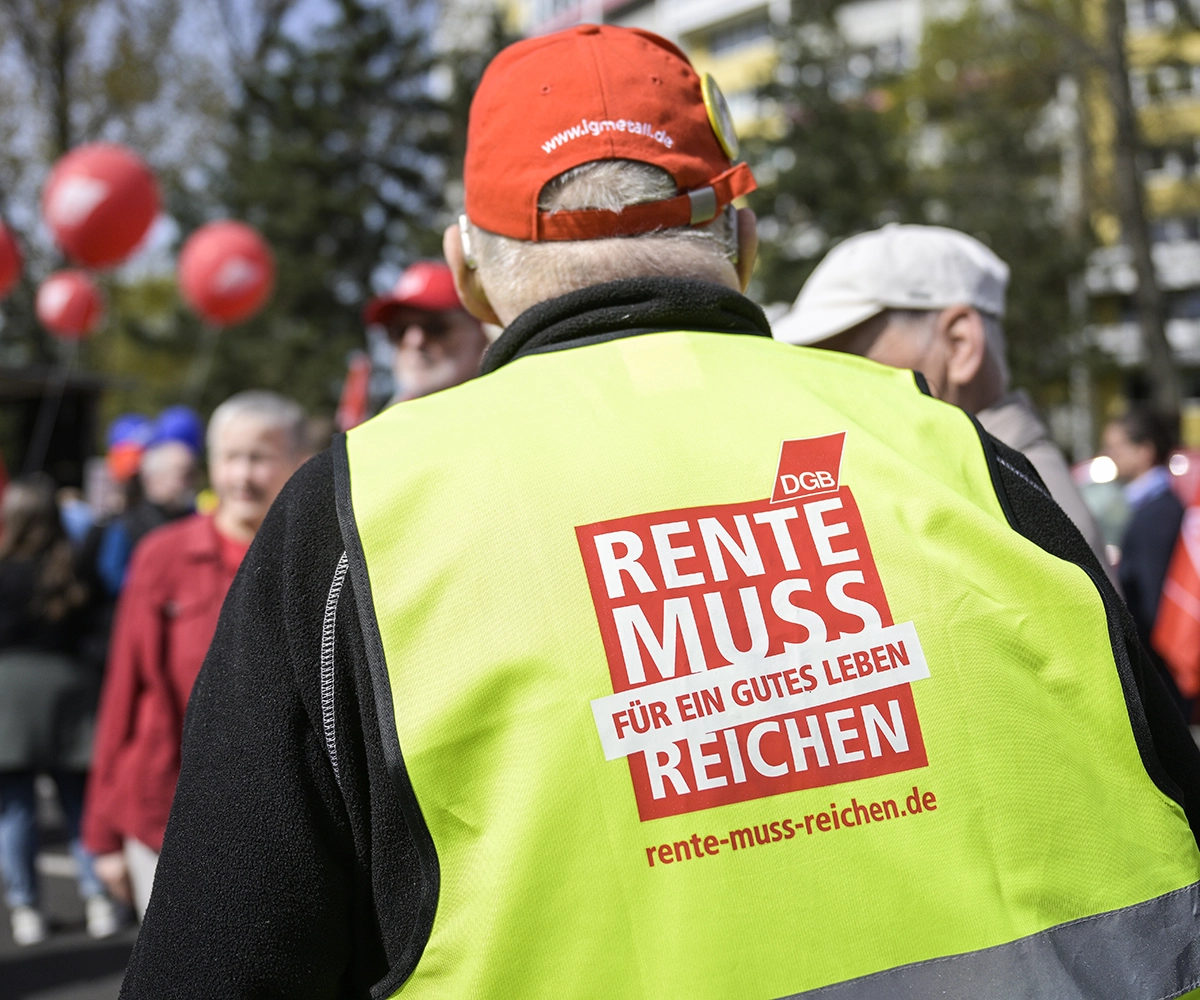
Associations with the social market economy
It was already clear to the founding fathers that the social market economy needed to adapt to changing circumstances. It has always changed over the course of time, as has our understanding of it. What do Germans today understand by the “social market economy” model? A majority of 49 percent associate the social market economy with social aspects such as fairness, distribution, and a social safety net. 43 percent think of market aspects such as competition and efficiency. Just under a quarter of those surveyed associate the social market economy explicitly with both social and economic issues. The associations are independent of school-leaving qualifications, migration background, income, or place of residence. There are no differences even along party political lines. Only the older age groups associate the social market economy more frequently with the explicit combination of social and economic issues than the younger age groups.
Social market economy or social-ecological market economy?
The aim of the social market economy is to combine economic growth with social balance. In recent decades, the dimension of ecological sustainability has also increasingly come to the fore. The term “social-ecological market economy” is often used in this context. Despite the fact that our current economic order encompasses all three of these dimensions, the focus of public debate is often solely on growth as measured by the gross domestic product (GDP) indicator. But is this view still up to date, or has it become outdated? To answer this question, the Ludwig Erhard ifo Center asked 1,400 of the world’s leading economists what potential for conflict they see between the dimensions.
There are considerable differences of opinion among the experts when it comes to the long-term compatibility between the three dimensions of economic growth, social justice, and ecological sustainability. Economists consider the conflict of objectives between justice and sustainability to be the least pronounced. Only a quarter of the world’s leading economists see this as a conflict of objectives. On the other hand, over a third of the economists surveyed see a strong conflict of objectives between long-term growth and social justice, or between economic growth and environmental sustainability.
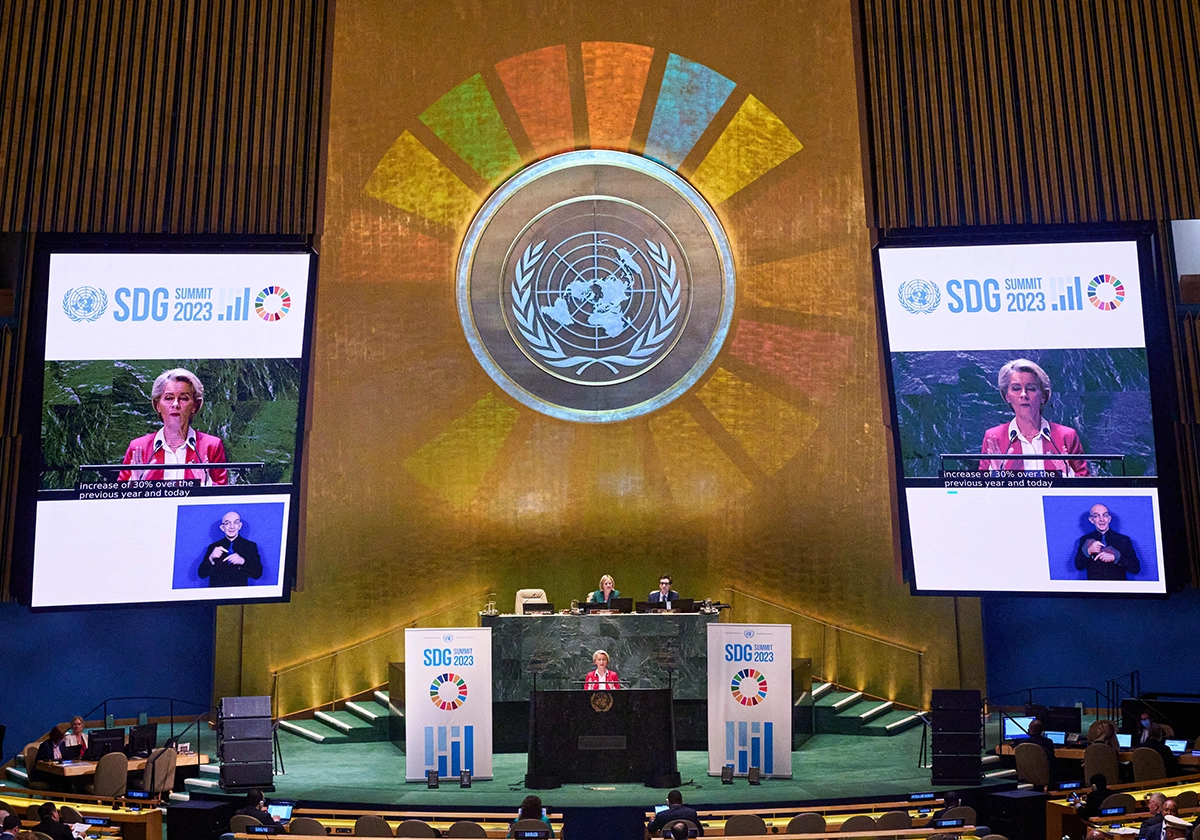
Milestone
The Wars in Ukraine and the Middle East
Peace in Europe was shattered in February 2022 when Russian forces crossed into Ukraine, setting off a cascade of economic and political upheavals. Europe found itself confronting a war at its doorstep, necessitating an urgent overhaul of its energy strategy. In October 2023, the situation intensified as militant Palestinians from Hamas invaded Israeli territory from Gaza, triggering a robust military response from Israel. The ifo Institute has delved into the geo-economic repercussions of these conflicts.
*Last changes on the text have been conducted on April 19, 2024. Thus, the text does not deal with any events or developments after this day.


The Toll of Russia’s Aggression on Ukraine
Ukraine’s economy has been severely battered by the conflict. By spring 2023, the World Bank pegged the war damages at USD 411 billion, while Ukraine’s own estimates for reconstruction soared to USD 750 billion. The war has ravaged infrastructure, decimated private consumption, and ground foreign trade to a halt due to Russia’s blockade of Ukrainian ports. International aid efforts have provided some relief, and countries including Germany have supported Ukraine with critical military aid. As per the UNHCR, 13.7 million Ukrainians were displaced, with about 6.4 million managing to return home. The ifo Institute’s surveys of Ukrainian refugees have shed light on their motivations for leaving, settling in new countries, and the factors influencing their decisions to stay abroad or return to Ukraine.
Germany’s Economic Struggles
The war in Ukraine has precipitated a sharp rise in gas and commodity prices in Germany, in some cases by almost 90 percent. The spike in gas prices has, in turn, escalated the cost of electricity production, hitting the chemical industry – a major energy consumer in Germany with around 9 percent of the total German consumption – particularly hard. A survey by the German Chemical Industry Association (VCI) found that 70 percent of chemical companies were severely affected by the surge in energy prices as of May 2022, with no immediate recovery in sight. The ifo Business Climate Index for the chemical sector has remained in the negative since mid-2022, hinting at potential production drops or the relocation of manufacturing capacities abroad.
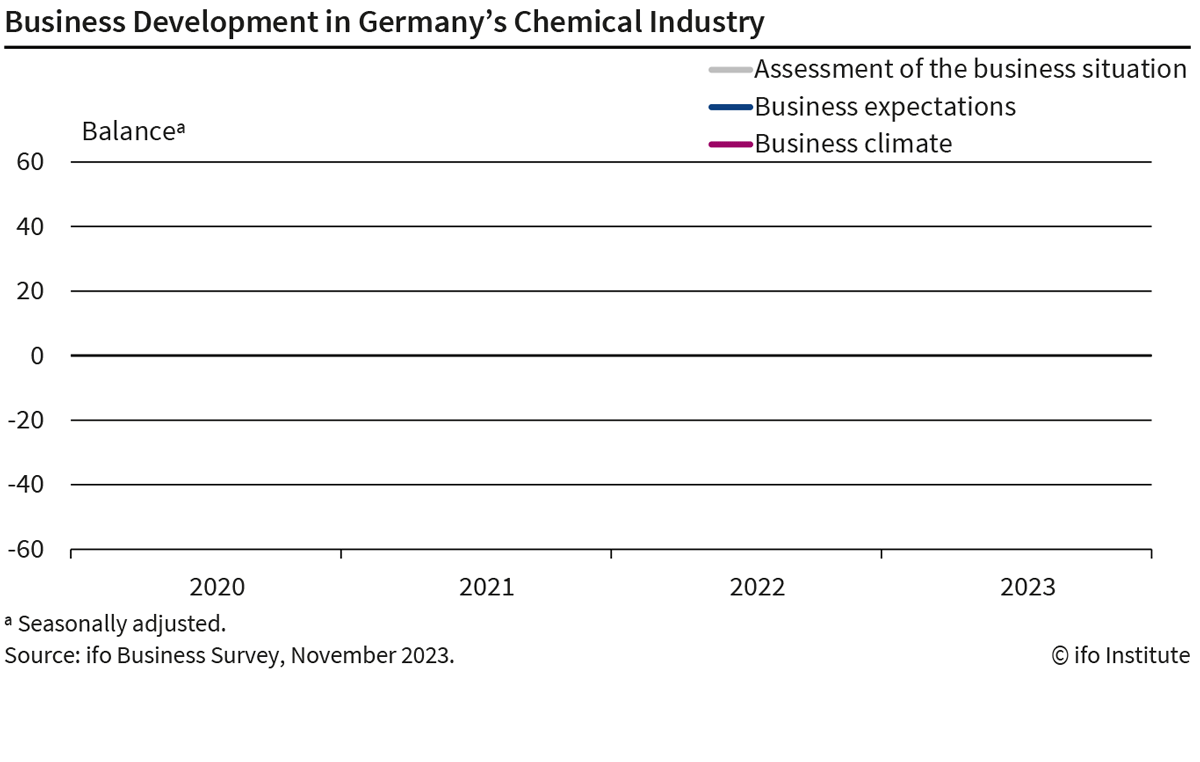
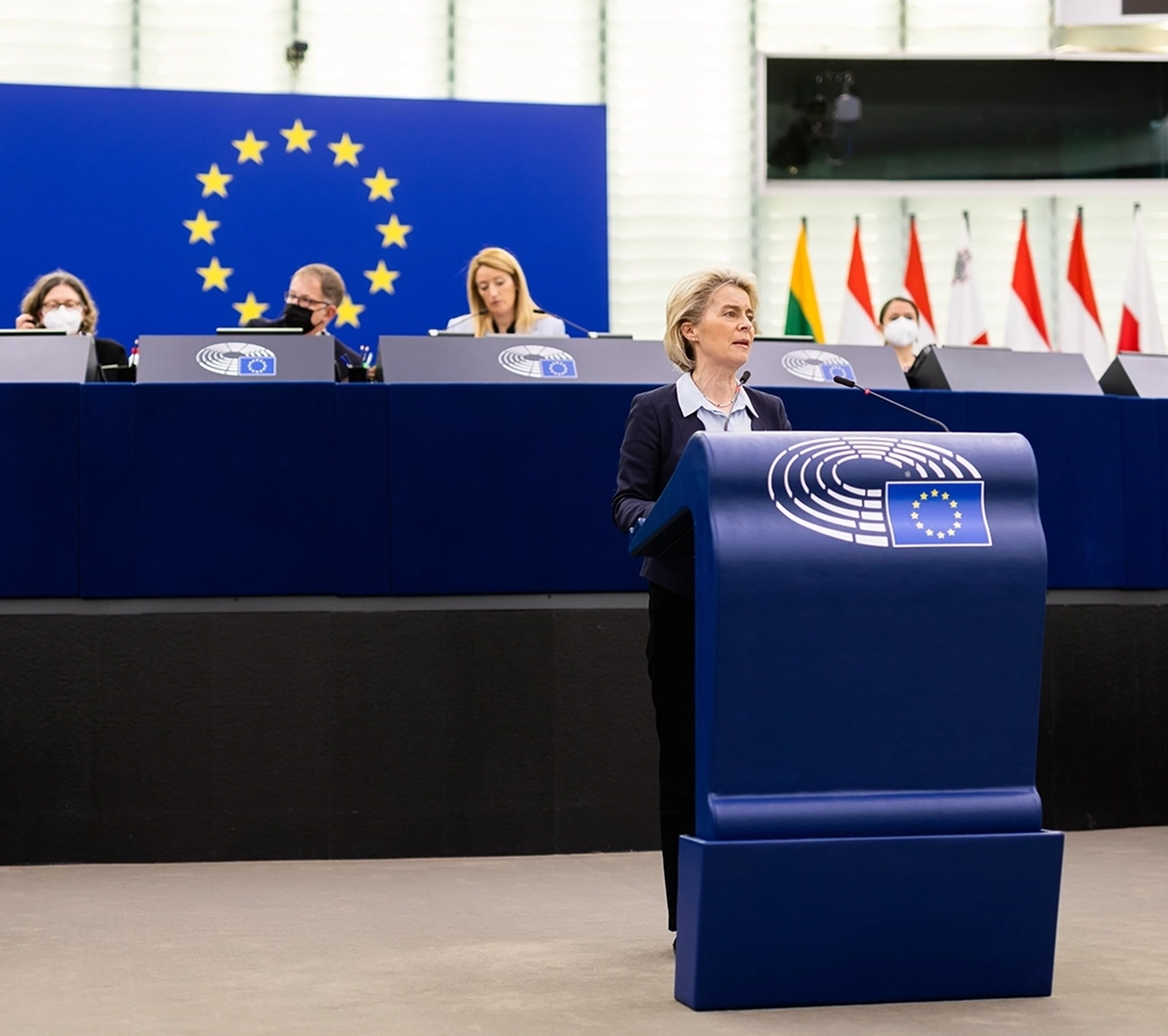
Sanctions: A Mixed Bag
In retaliation to Russia’s invasion, the EU, alongside its partners, unleashed unprecedented sanctions, including severing Russia from international financial systems, imposing comprehensive trade embargoes, and closing EU airspace to Russian planes. These measures have made a dent: EU exports to Russia dropped to 37 percent of their pre-war levels since the conflict began.
However, reports suggest these sanctions are being circumvented, especially regarding military equipment supplies. An ifo study highlighted a significant increase in exports of economically critical and military-industrial goods to Russia from countries like Armenia, Kazakhstan, Uzbekistan, Kyrgyzstan, and Turkey. They exported 50 times more goods critical to the Russian economy or important to the military industry to Russia in 2022 than they exported in general goods to all destination countries in 2019.
The Israeli Front and Broader Implications
The attack by Hamas has resulted in numerous Israeli hostages and prompted extensive Israeli military strikes targeting Hamas in Gaza. The conflict has inflicted heavy casualties on both sides and significantly worsened the humanitarian crisis for Gaza’s civilian population. There’s global concern that the Middle East conflict could escalate further, potentially drawing in the USA or Iran. “It is therefore a fragile situation, against the backdrop of which the economic risks are increasing,” notes ifo President Clemens Fuest. According to the ifo Institute, the Middle East conflict could once again put the brakes on economic development in Germany. The nation’s deep integration with international trade networks makes it particularly vulnerable to such crises, notably affecting its industrial sector already strained by the energy crisis from Russia’s aggression.

Milestone
Together into the Future – the Friends of the ifo Institute
As early as the mid-1950s, those responsible at the ifo Institute pursued the foundation of a legally independent “Fördergesellschaft” (society of friends). To this day, the “Society for the Promotion of Economic Research (Friends of the ifo Institute) e.V.” supports the work of the ifo Institute in many areas, including the promotion of young talent and the transfer of ifo knowledge to business and society. Paul-Bernhard Kallen, Deputy Director Stefan Keitel, and Deputy and Treasurer Alexander Liegl have been determining the work of the Friends of the ifo Institute since 2024.
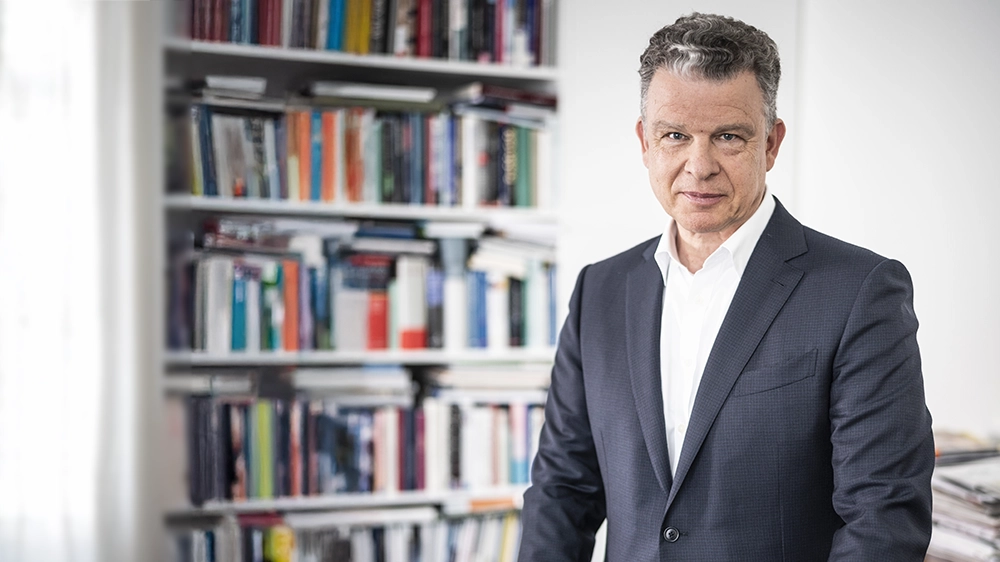
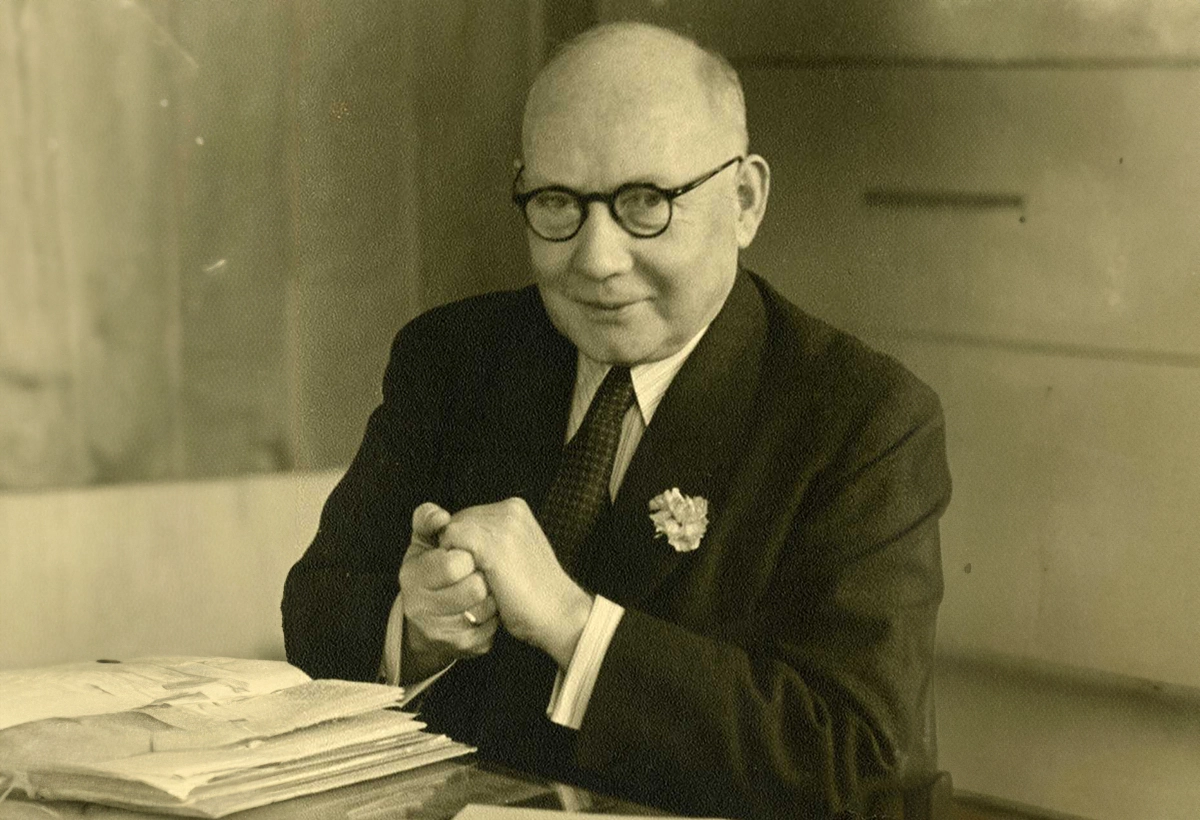
Foundation in Düsseldorf
In the second half of 1955, the Chairman of the Board of Trustees of the ifo Institute, Ludwig Kastl, and ifo Board member Eduard Werlé agreed on the need for a “society of friends”. They contacted high-ranking business representatives, including Wilhelm Bötzkes, CEO of Industriekreditbank AG in Düsseldorf. The inaugural meeting of the “Gemeinnützigen Gesellschaft zur Förderung von wirtschafts- und sozialwissenschaftlichen Testverfahren” (Non-Profit Society for the Promotion of Economic and Social Test Procedures) took place on October 28, 1957. The founding members were 23 institutions, mainly companies, but also associations and the Düsseldorf Chamber of Industry and Commerce. Heinrich Kost, Chairman of the Supervisory Board of Rheinpreußen AG, became the first Chairman of the Management Board.
Promoting the ifo Test Procedures
“The purpose of the association is to promote economic and social science testing procedures,” according to the founding by-laws. These were the economic tests carried out by the Institute from the very beginning and the investment test added in 1954. “The possibilities offered by this procedure are by no means exhausted. We are of the opinion that the ifo Institute should not be exclusively dependent on public funding to intensify and expand the procedures,” says the letter of invitation to the inaugural meeting. From 1958 to 1965, a total of around DM 750,000, between DM 80,000 and 100,000 annually, could be used for the stated purposes. The society of friends also wanted to establish a lively exchange of ideas between the members of the society and the ifo researchers. The latest research findings were discussed. Science benefited from suggestions from business practice.
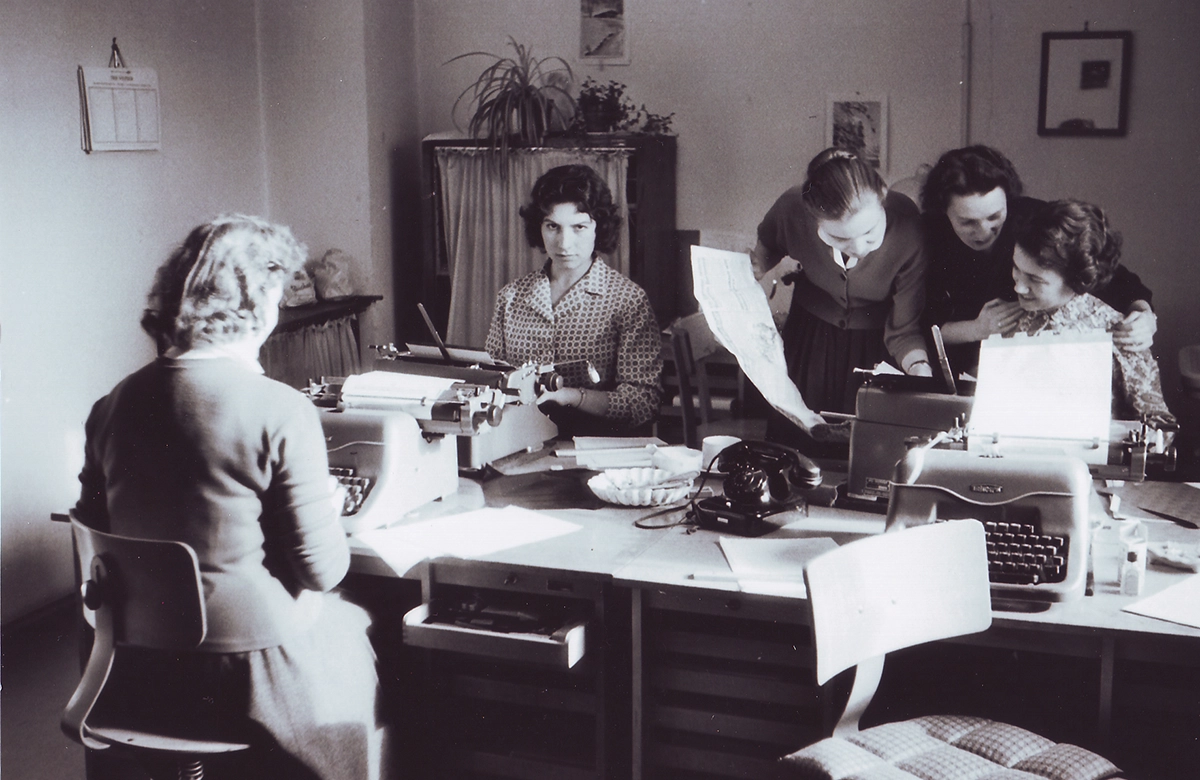
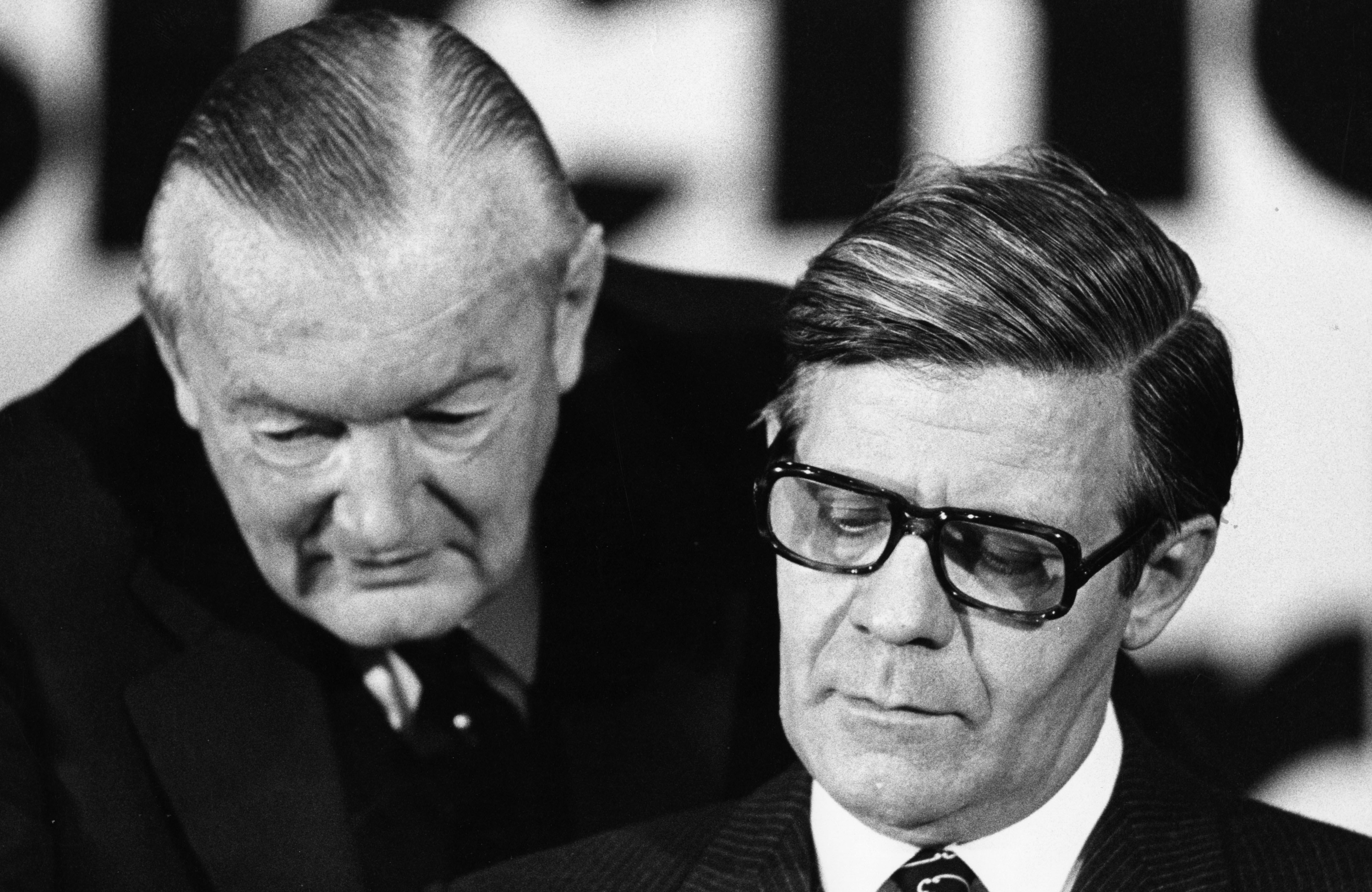
New headquarters of the “ifo Friends”
The successor to the Society’s first CEO, Heinrich Kost, was appointed in 1970: Ernst Wolf Mommsen, State Secretary in the Ministry of Defense under the government of Helmut Schmidt and Chairman of the Executive Board of Krupp AG. Under his chairmanship, the funding was to be used, alongside supporting the test procedures, for non-profit activities of the ifo Institute. The registered office of the society was moved from Düsseldorf to Munich and the name was changed to “Gesellschaft zur Förderung der wirtschaftswissenschaftlichen Forschung” (Society for the Promotion of Economic Research). The funding objectives were further specified in 1988. Previously, part of the funds had also been used to “combat fluctuation” in order to attract applicants and retain proven employees at the ifo Institute. The ifo Executive Board and Board of Trustees of the Friends now decided to promote the further training of employees, but also to support them with funds for the IT infrastructure.
The Simon Villa
In view of its constantly growing space requirements, the Executive Board of the ifo Institute had expressed interest early on in the villa on the neighboring property at Poschingerstrasse 5. The house and property at Mauerkircherstrasse 35 were owned by Hans Georg Simon, who had a doctorate in economics and had inherited the property from his parents. He rented rooms in his house to the ifo Institute from 1956. In 1980, the ifo Institute acquired the villa on the condition that Hans Georg Simon would have a lifelong right of residence on the top floor. The purchase agreement was concluded after further negotiations in 1984. In 1984 and 1985, the Friends of the ifo assumed the costs for the purchase and renovation of the villa with a sum of over DM 500,000, a quarter of the total costs.
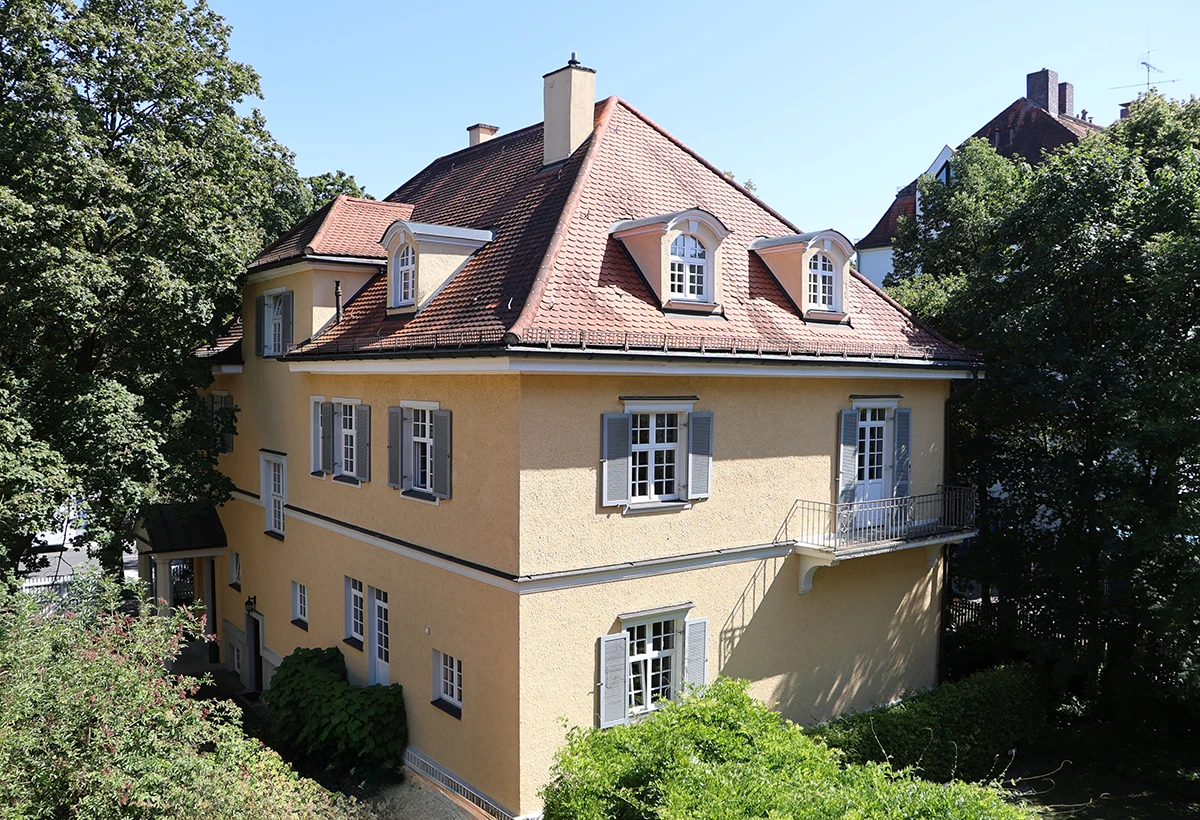
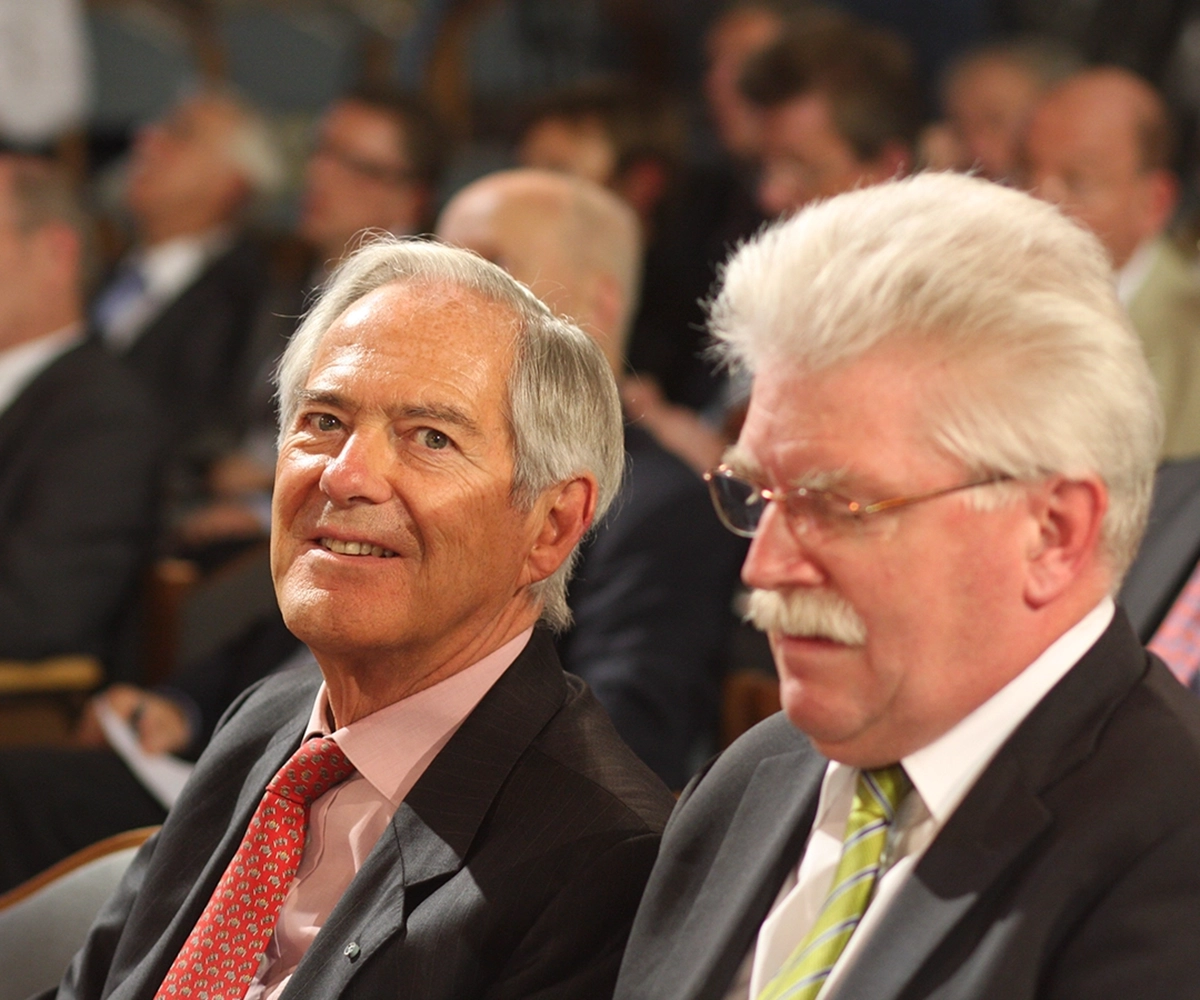
Leading minds and the Roland Berger era
Joachim Zahn, a member of the Board of Management of Daimler Benz AG until 1979, became a member of the Executive Board of the Friends of the ifo Institute in July 1980, as successor to Ernst Wolf Mommsen, who died in 1979. After his departure, Klaus Götte, longstanding member of the Board of Management of Allianz Versicherung AG, was elected Chairman of the Board of Trustees and the Executive Board in 1989. MAN CFO Count Ferdinand von Ballestrem took over from 1999 to 2007. On January 17, 2007, the Board of Trustees elected Roland Berger, founder of a leading global management consultancy, as Chairman of the Board of Trustees and the Executive Board. Through his personal commitment, he succeeded in winning over additional companies and leading figures from the business world as members of the Friends of the ifo Institute. The Society developed into an important meeting place for influential personalities from the business world who were looking for a high-caliber, scientifically supported exchange on fundamental economic and financial policy issues. Roland Berger remained in office until 2023, making him the longest-serving Chairman of the Executive Board and Board of Trustees in the history of ifo Friends.
Focus on science
Around the turn of the millennium, the focus in allocating funding was increasingly on scientific purposes, such as co-financing posts as doctoral students, involving renowned external scientists as research directors of the ifo Institute, and awarding prizes for outstanding academic achievements. This change was a sign that the Society of Friends supported the critical situation in which the ifo Institute found itself after the evaluation in the second half of the 1990s with strong backing and made a significant contribution to the reorientation during that time.
In 2002, the ifo Society of Friends awarded an annual prize for the first time for outstanding academic achievements that could be published in one of the world’s leading academic journals.

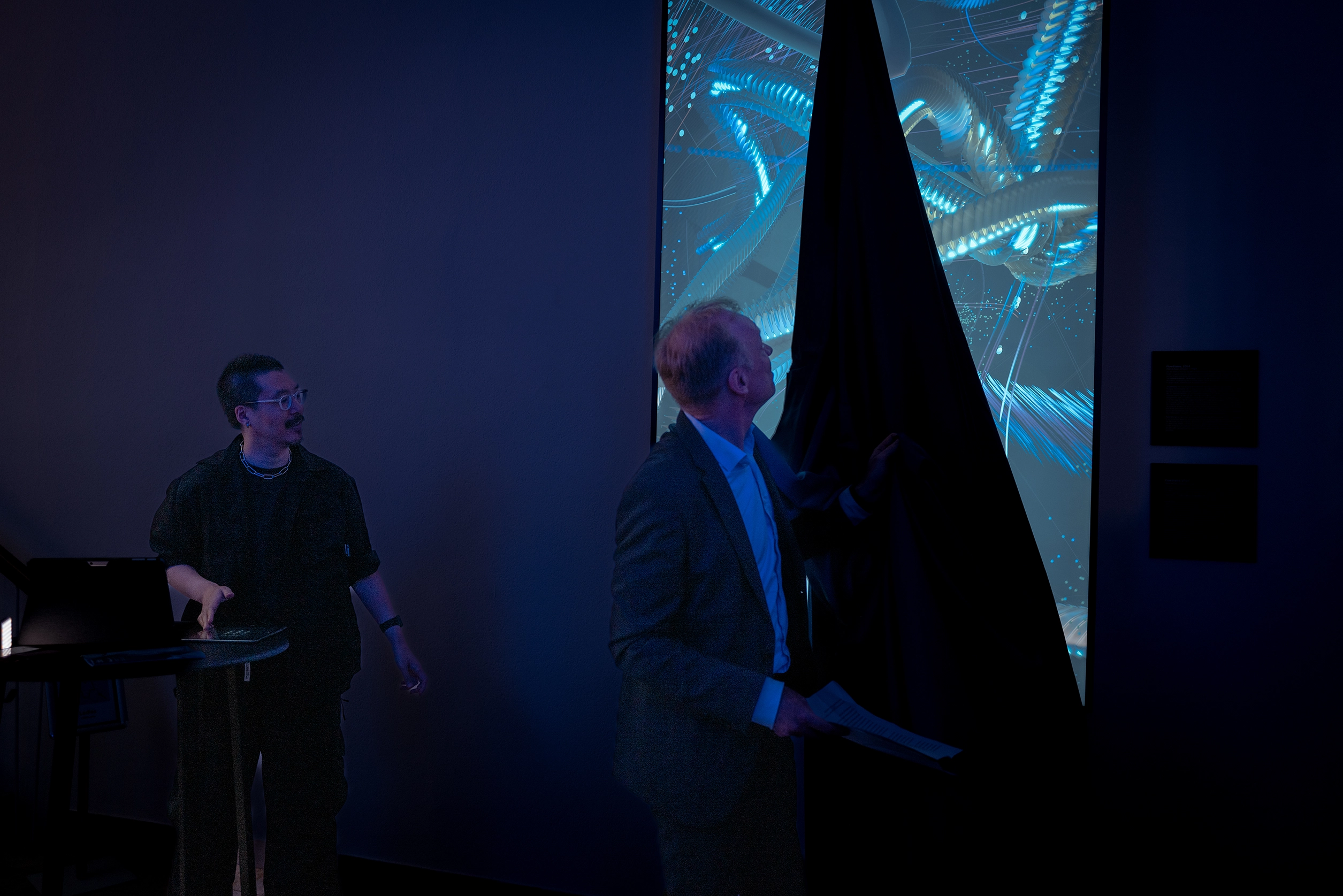
The friends today
The exchange of knowledge and experience now takes place as part of an annual joint strategy meeting, hosted by members of the Board of Trustees of the Society of Friends. The information and suggestions gained, and the involvement of this high-ranking group in the Institute’s events are particularly valuable for the ifo Institute. In 2024, the Society of Friends of the ifo Institute has around 85 members, 47 of whom are members of the Board of Trustees. Paul-Bernhard Kallen, longstanding CEO and current Chairman of the Board of Directors of Hubert Burda Media Holding, has been Chairman of the Executive Board since 2023. His deputies are the bank manager and entrepreneur Stefan Keitel and Alexander Liegl, lawyer and partner at the international law firm Noerr.
The most important funding objective is the support for young academics. The Friends enable a national and international exchange through travel grants for specialist conferences, for involving guest researchers from all over the world, and through financing lunchtime seminars and workshops in the various ifo research areas. The Society also supports the Institute’s communication activities aimed at presenting the scientific expertise built up at the ifo Institute to different target groups.
Note: For the sources used in this text, click on the Imprint
Publications
People
Upswing, Boom, Crisis: The Impact of the ifo Business Climate Index
The ifo Business Climate Index, published monthly, has become an essential tool for decision-makers in business, politics, and finance. But how did the ifo Institute conceive of measuring the business climate, and why do these figures captivate such widespread attention even beyond the business community?
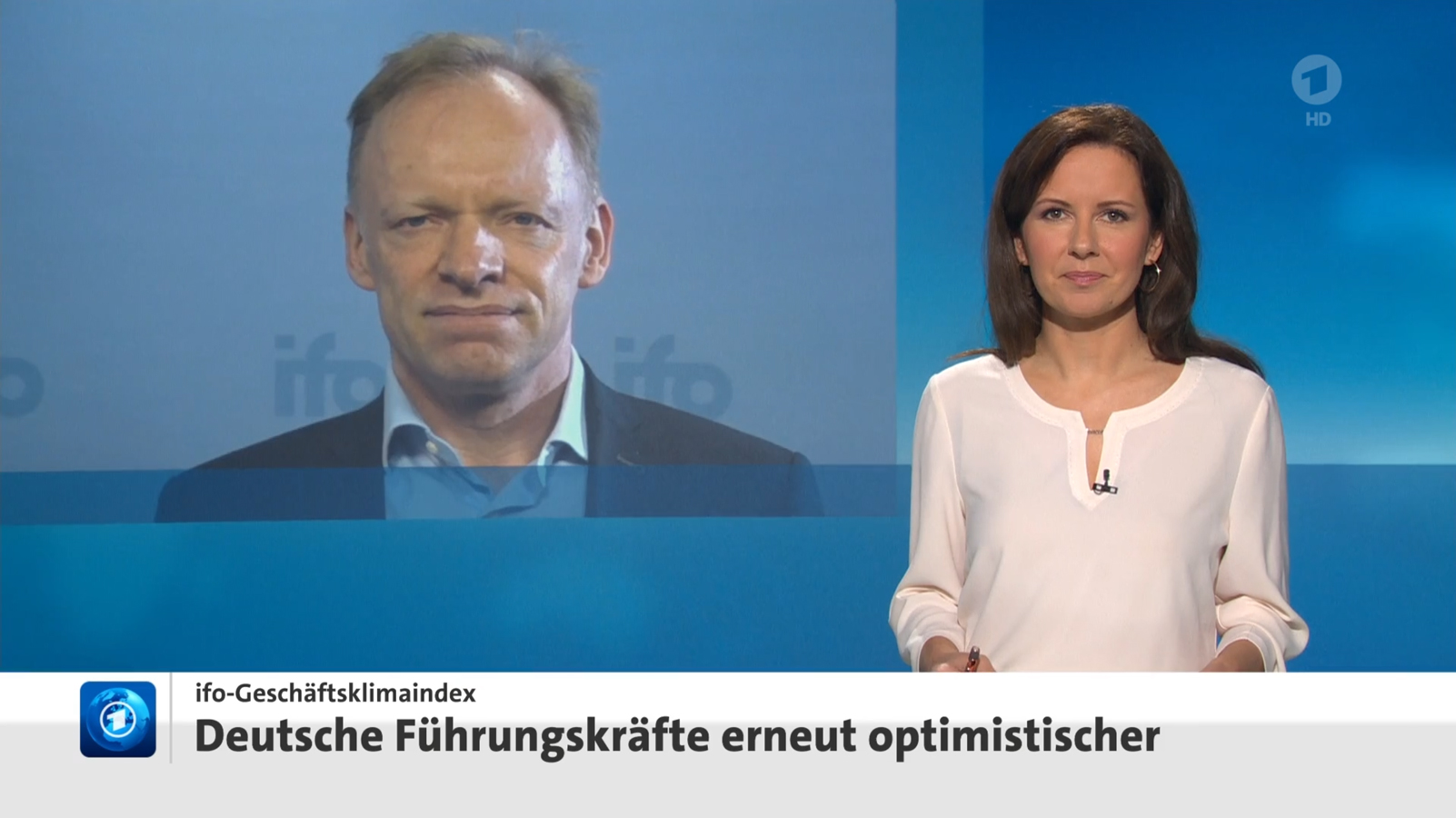
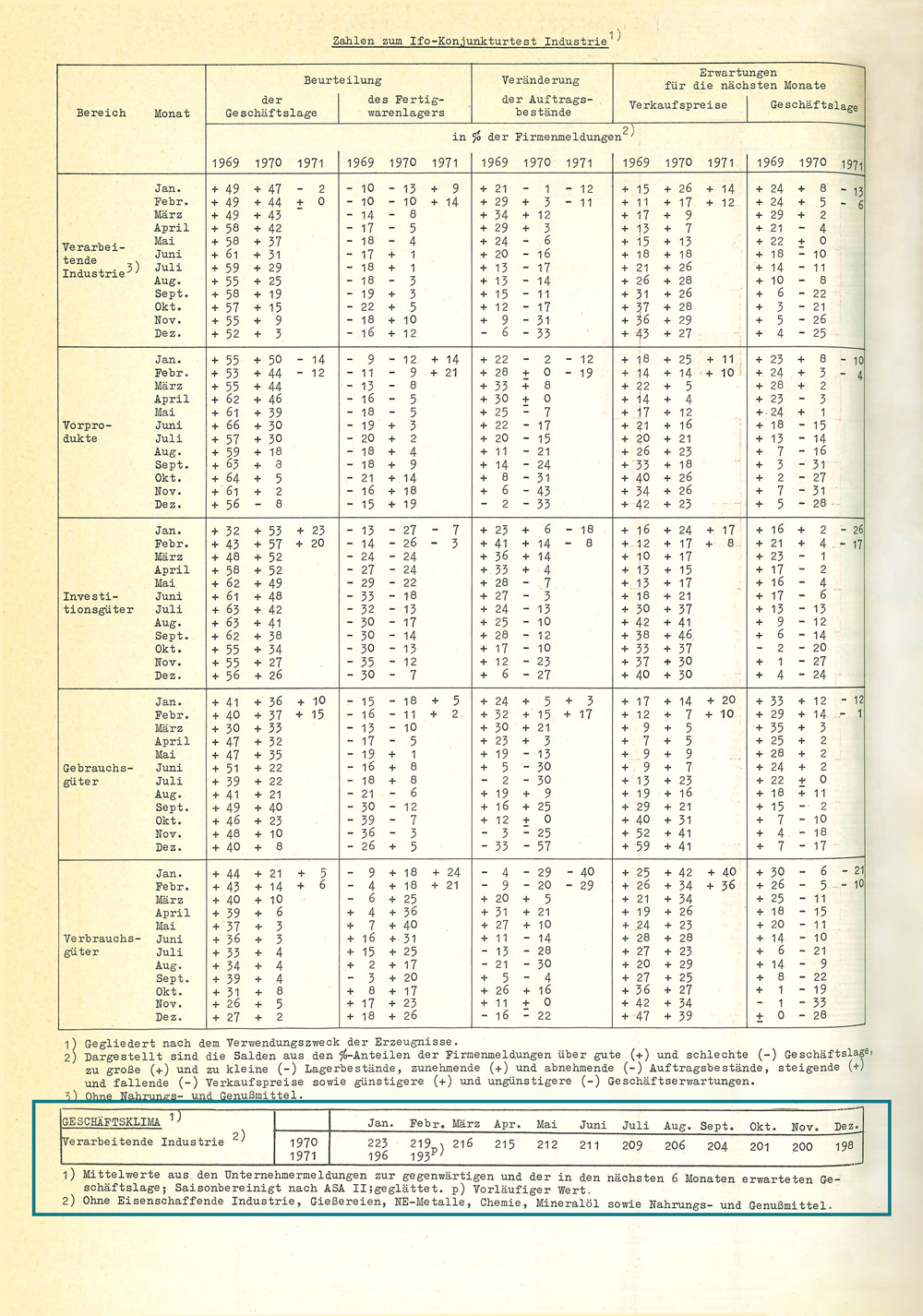
A Pioneering Endeavor by the ifo Institute
The idea of assessing the German economy through surveys of company managers was initiated in 1948 by the “Information and Research Center for Economic Observation” of the Bavarian State Statistical Office, which later evolved into the ifo Institute. Following the currency reform in 1948, which drastically altered the economic landscape, there was a pressing need for dynamic indicators to complement traditional statistics. Gathering this data directly from entrepreneurs was a groundbreaking approach to empirical economic research in Europe at the time. Post its establishment in 1949, the ifo Institute refined this survey method, focusing not on specific company data but on qualitative assessments of companies’ own developments – a practice that remains central to ifo surveys.
In the 1960s, the institute in its extensive questionnaires increasingly concentrated on business climate indicators, synthesizing assessments of current business conditions with expectations for the next six months. This unique feature of the ifo Business Climate Index today allows for early detection of economic turning points.
In March 1971, ifo discreetly introduced its “Business Climate Manufacturing” index in the ifo Schnelldienst. At that time, its potential significance as a leading economic indicator was not yet recognized.
Four Sectors, Business Situation, and Expectations
Today, the ifo Business Climate Index is derived from about 9,000 questionnaires from companies across manufacturing, construction, wholesale, retail, and service sectors. The index calculates the difference in responses categorized as “good” versus “bad” for the current business situation and “more favorable” versus “less favorable” for future expectations. Neutral responses such as “satisfactory” or “unchanged” are excluded from the calculations. The final index is the mean of these balances, reflecting both present conditions and future prospects.

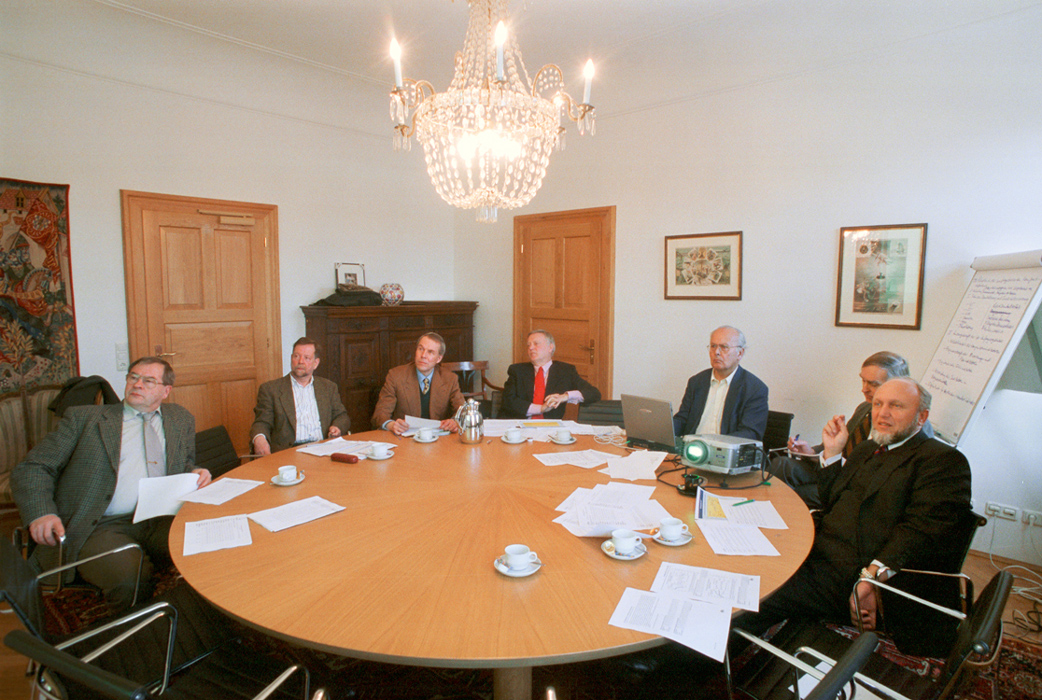
A Sample Calculation
For example, if 40 percent of surveyed companies describe their current situation as satisfactory, 35 percent as good, and 25 percent as poor, only the responses categorized as good or poor are considered. The difference – 10 percent in this case – represents the current business situation score. Expectations for the next six months are calculated similarly, and the ifo Business Climate Index is calculated each month as the average of the current situation value and the expectations value. The index can range from -100 (if all respondents view their situation as poor and anticipate worsening conditions) to +100 (if all view their situation as good and expect improvement).
Strict Protocol for Publication
The ifo Business Climate Index is one of the most closely watched indicators for assessing the German economy, capable of triggering movements in the financial markets. Therefore, its calculation and publication follow a strict protocol:
• At 7:00 AM, the results of the calculations performed the night before publication are sent to the Head of Surveys.
• By 8:00 AM, the Head of Surveys analyzes these results, considering sector-specific data like automotive industry trends important for the overall interpretation, and drafts a press release.
• At 8:45 AM, key personnel, including the ifo President, the Heads of Economic Forecasts and Surveys, the Head of Surveys, the Head of Communication, the press speaker and a translator discuss and finalize the press release.
• By 10:00 AM, the press speaker reads the release in a video conference. It is then distributed in multiple languages to news agencies accredited with the European Central Bank.
• At 10:30 AM, the index is published on the ifo website.

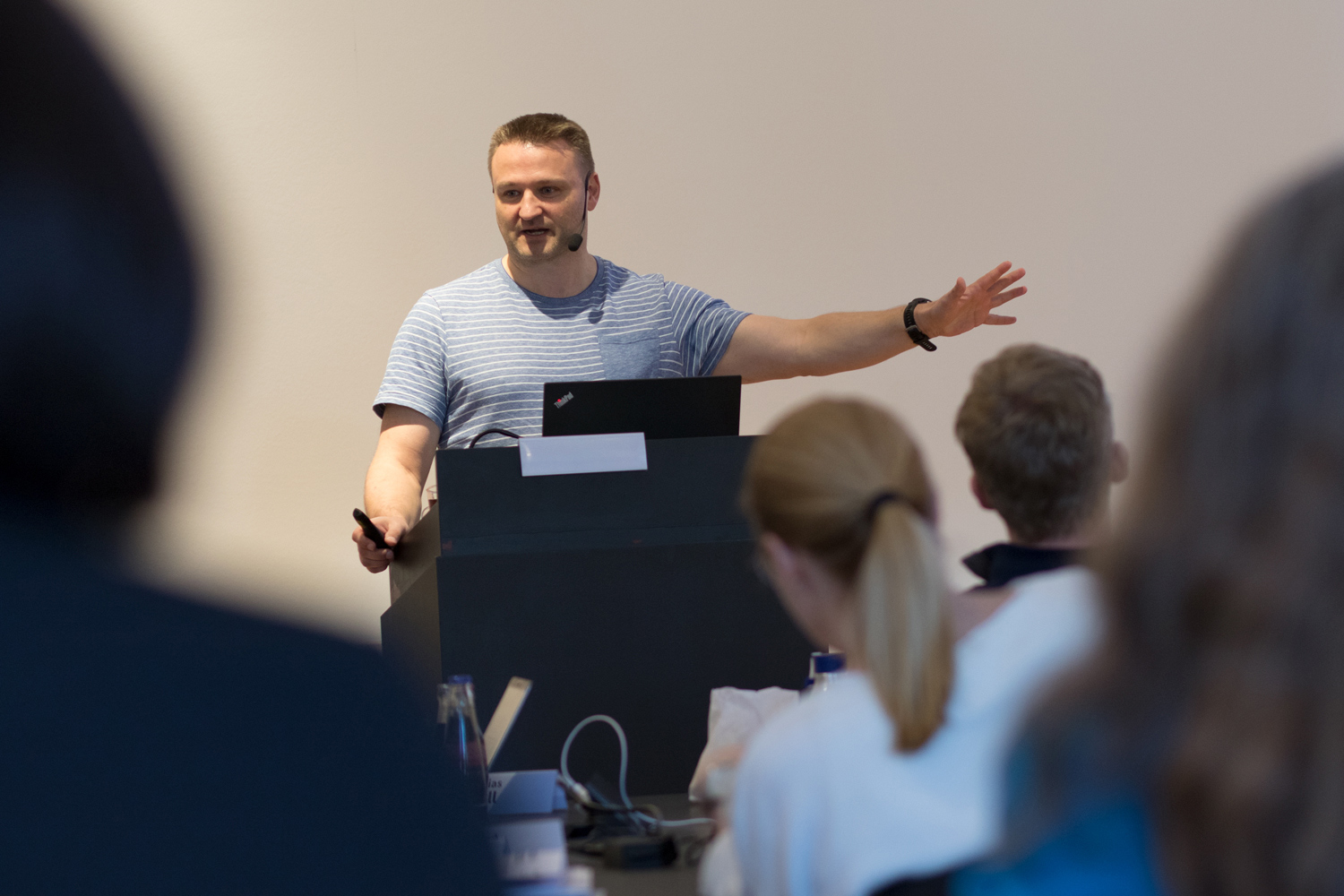
A Trusted Economic Barometer
The ifo Business Climate Index garners significant attention due to its timely correlation with actual economic trends, making it a reliable basis for strategic decisions in businesses, politics, and finance. Unlike statistics that may lag, such as quarterly GDP reports by the Federal Statistics Office, the ifo index offers up-to-date insights.
Participating companies benefit not only from contributing information but also from accessing detailed analyses unavailable elsewhere, underpinning the success of the ifo Institute’s flagship service.
Note: For the sources used in this text, click on the imprint.
Publications
When the Euro Began to Totter: The Euro Crisis from 2010 Onward
The situation came to a dramatic head in the spring of 2010: Greece could no longer conceal the extent of its previously hidden budget deficit and debt. The shortfall in the national budget was four times larger than previously stated. Interest rates for Greek government bonds had become prohibitive on the capital market. Greece had to apply for financial aid on April 23, 2010, in order to avert sovereign default. That was a reason for international donors to flee. There were also huge difficulties for other eurozone countries.
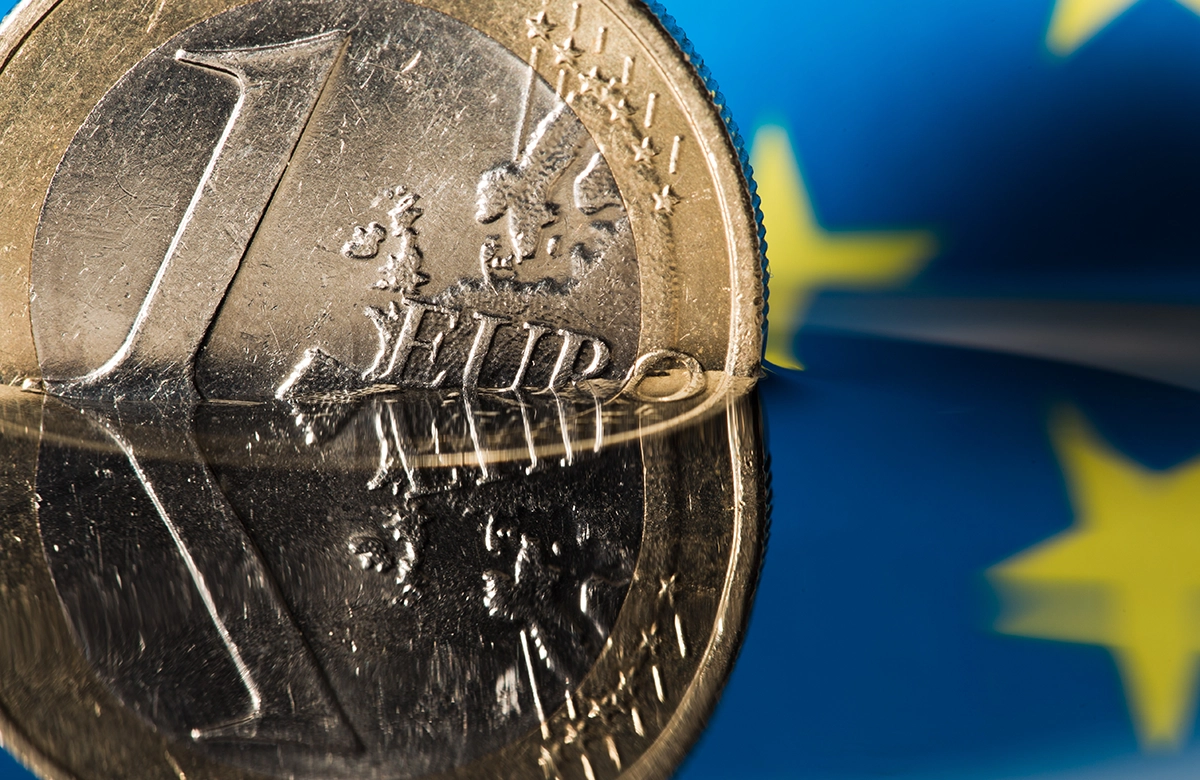
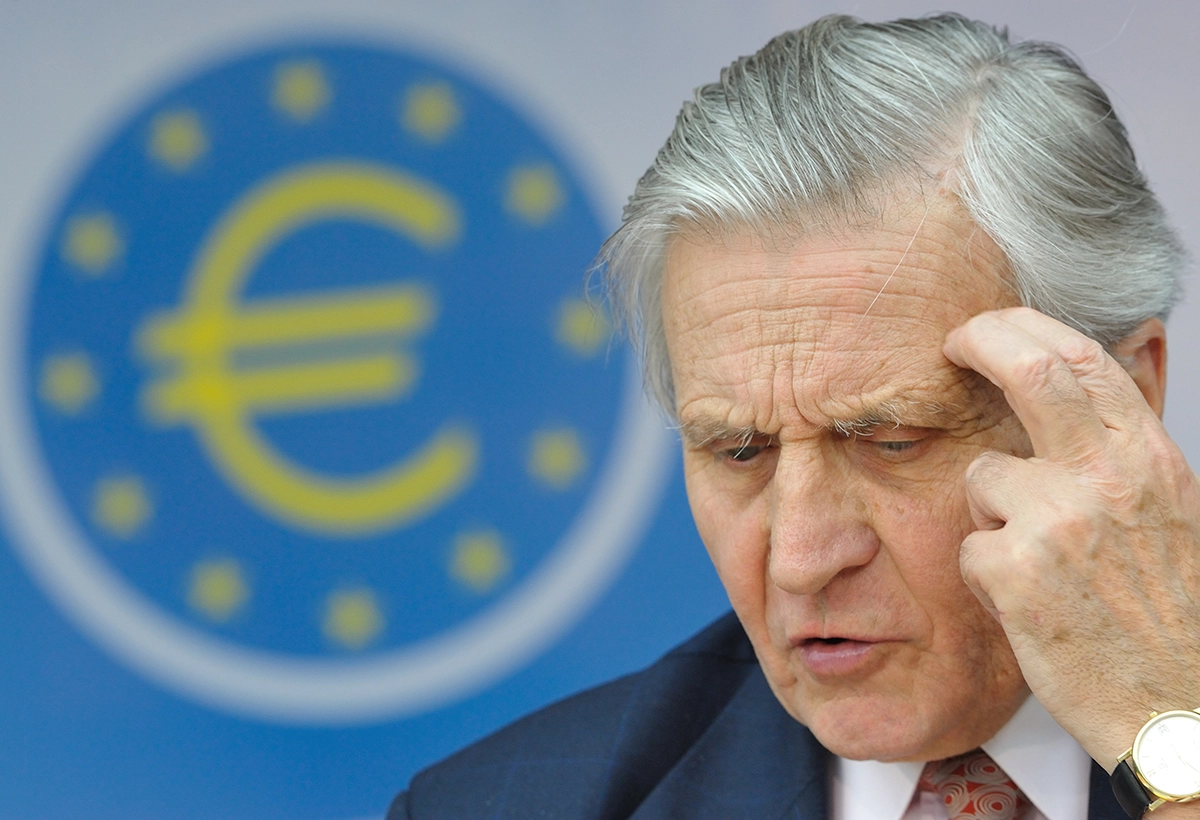
How Did Greece Slide into the Crisis?
The 2010 euro crisis escalated as a result of the global financial crisis, which was triggered by the real estate bubble bursting in the US in 2007 and further exacerbated by major banks going bankrupt. The Greek government lost some of its regular revenue. A review revealed that the Greek deficit ratio was almost 16% and the level of debt was around 130% of gross domestic product. That exceeded the limits set out in the Maastricht Treaty and the Stability Pact (3% deficit and 60% debt) many times over. Greece’s standing among international rating agencies deteriorated dramatically, with the interest rate for Greek government bonds rising from 8.02% in 2010 to 25.17% in 2011.
Other Countries Get into Difficulties
This turbulence led to a massive withdrawal of capital and also to a crisis in other eurozone members. Countries such as Ireland and Spain, which were hit hard by the real estate crisis that led to a debt and banking crisis, were also pushed to the brink of national bankruptcy. Ireland’s GDP fell by 7% in 2009 and unemployment there rose to 14% in 2010. There was also a lack of important government revenue, while enormous sums had to be spent on bailing out the banks. These national bailouts amounted to around 35% of Ireland’s gross domestic product, and the debt-to-GDP ratio exploded from just 25% (2007) to almost 100% (2010). In Spain, too, economic output fell by almost 4% in 2009 and unemployment soared to 20% in 2010.
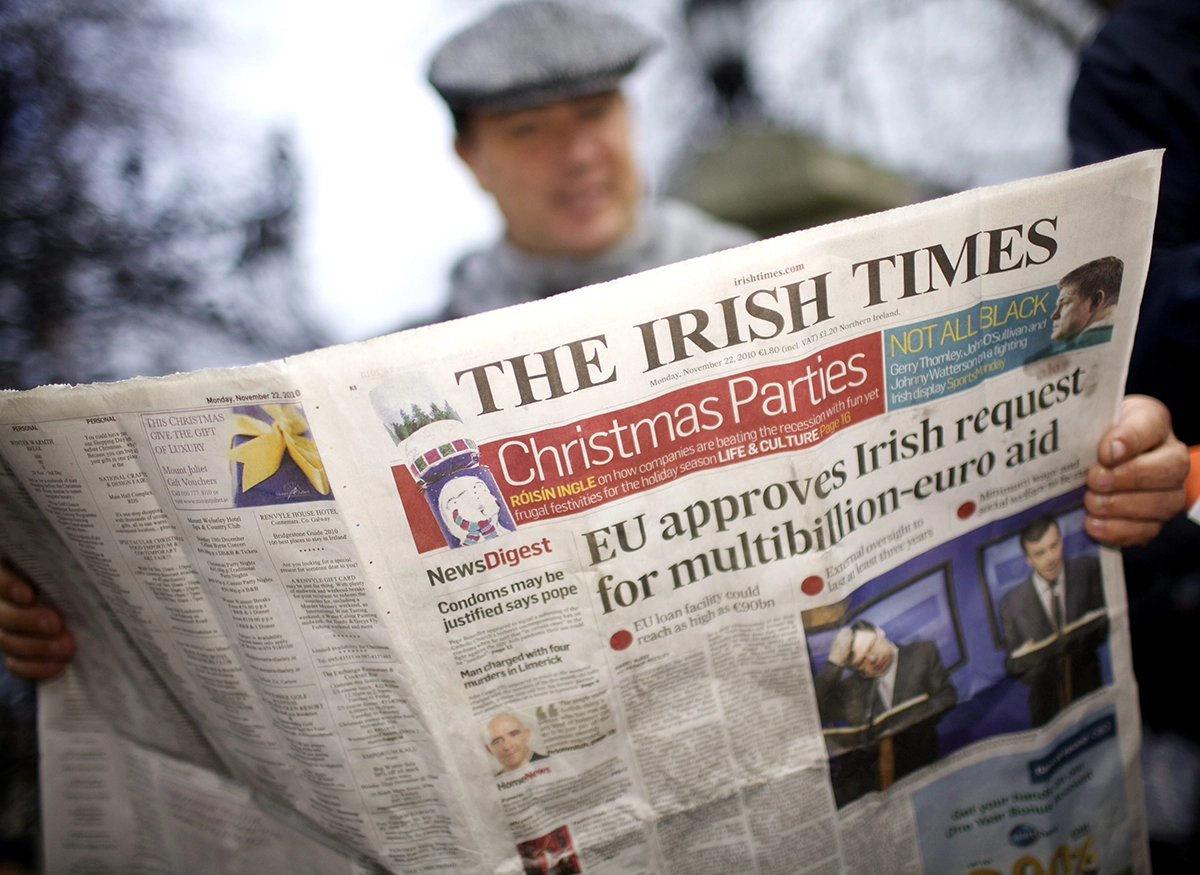
The Rescue Package is Unfurled
The EU and the European Central Bank intensified their cooperation to support the unstable countries. Together with the International Monetary Fund (IMF), they unfurled the “euro rescue package.” It approved loans only if a country adopted a rigorous austerity policy. Another EU-wide measure was the European Semester, which gave the EU Commission and the EU Council of Ministers the opportunity to review the national draft budgets in the first six months of each year and urge changes where necessary. In addition, the 2012 Fiscal Compact committed governments to a strict budgetary policy and the introduction of a debt brake. German Chancellor Angela Merkel endorsed these stringent measures, stating that the restoration of economic stability in the crisis countries required a rigorous austerity policy. Only those adopting a strict budgetary policy were able to access funds from the euro rescue package.
“Breathing Monetary Union” as a Way Forward?
Hans-Werner Sinn, President of the ifo Institute until 2016, actively participated in the conversation. He commented for the first time in a special issue of Schnelldienst in November 2010. In 2015, he summarized the many years of debate in his book “Der Euro. Von der Friedensidee zum Zankapfel” (“The Euro. From the Idea of Peace to a Bone of Contention”). His conclusion: In the event of an imbalance in the national budget, the partners of the monetary union must be deprived of the opportunity to make risky investments with other people’s money in the knowledge that potential losses would be absorbed by the community. In order to overcome the crisis, rigorous debt relief was necessary for the crisis countries. The countries receiving such relief would then have to leave the monetary union for a transitional period. That was the only way to restore their competitiveness. In such a “breathing monetary union,” it would not be unusual for countries to keep on entering and leaving it.
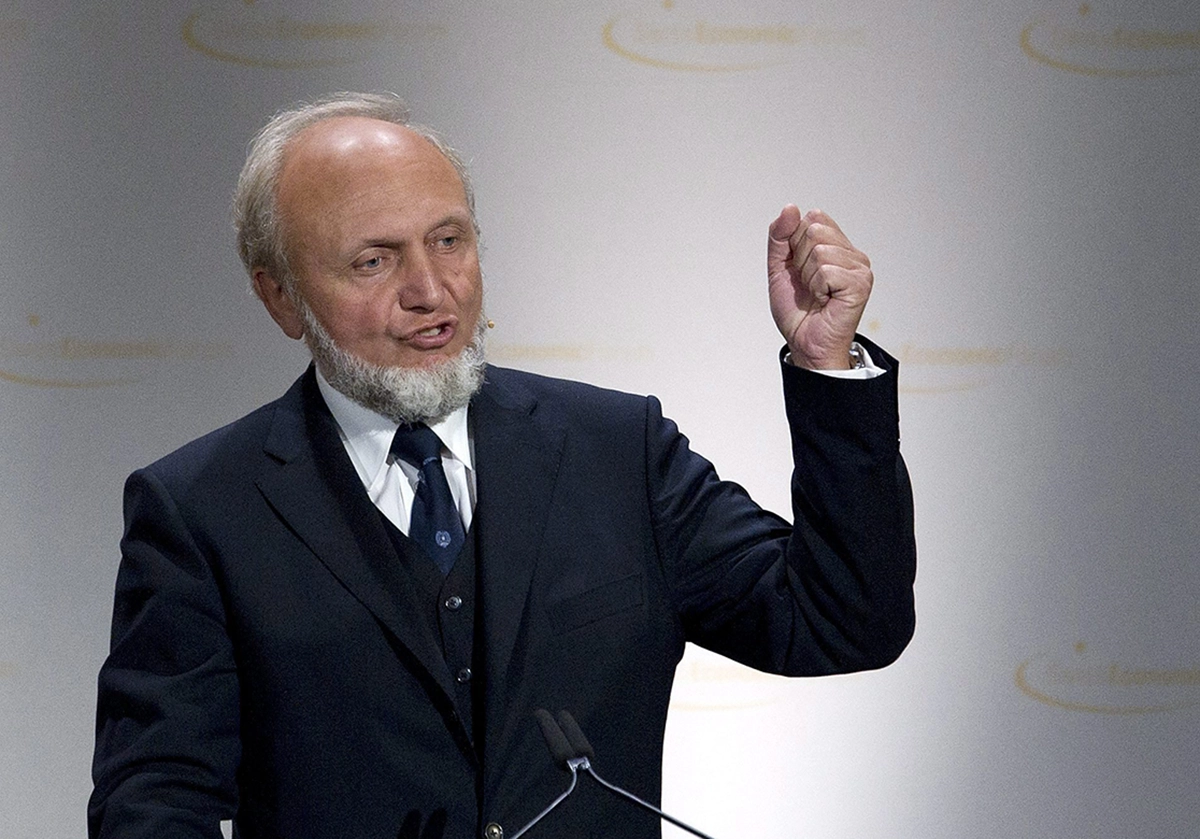

Five Points for Exiting the Crisis
Clemens Fuest, President of the ifo Institute since 2017, published the book “Der Odysseus-Komplex. Ein pragmatischer Vorschlag zur Lösung der Eurokrise” (“The Ulysses Complex. A Pragmatic Proposal for Solving the Euro Crisis”) together with Johannes Becker in the year he took office. The authors’ conclusion: Like Ulysses, who asks to be tied to the mast of his ship in order to resist the Sirens’ song, the euro countries must also bind themselves to fixed rules in order to avoid the seduction of new debt, deferment of reforms and lax regulation. Their proposal is a “five-point program for a stable eurozone” with reform proposals for banking regulation at the EU level, effective debt control measures, a reorientation of European rescue measures, the declaration of measures in the event that a country is unable to return to the capital market within a deadline, and lastly a clear ban on state financing by the European Central Bank and a definition of the ECB’s mandate. The prime goal of all these measures is to strengthen national responsibility for a country’s own economic policy.
Milestone
Without Words: Interview with Clemens Fuest
Born August 23, 1968 in Münster
Profession Professor of economics, President of the ifo Institute
Education Degree in economics
Status Index equals balance in the operating month + 200 divided by average bal-ance in the base year + 200 times 100
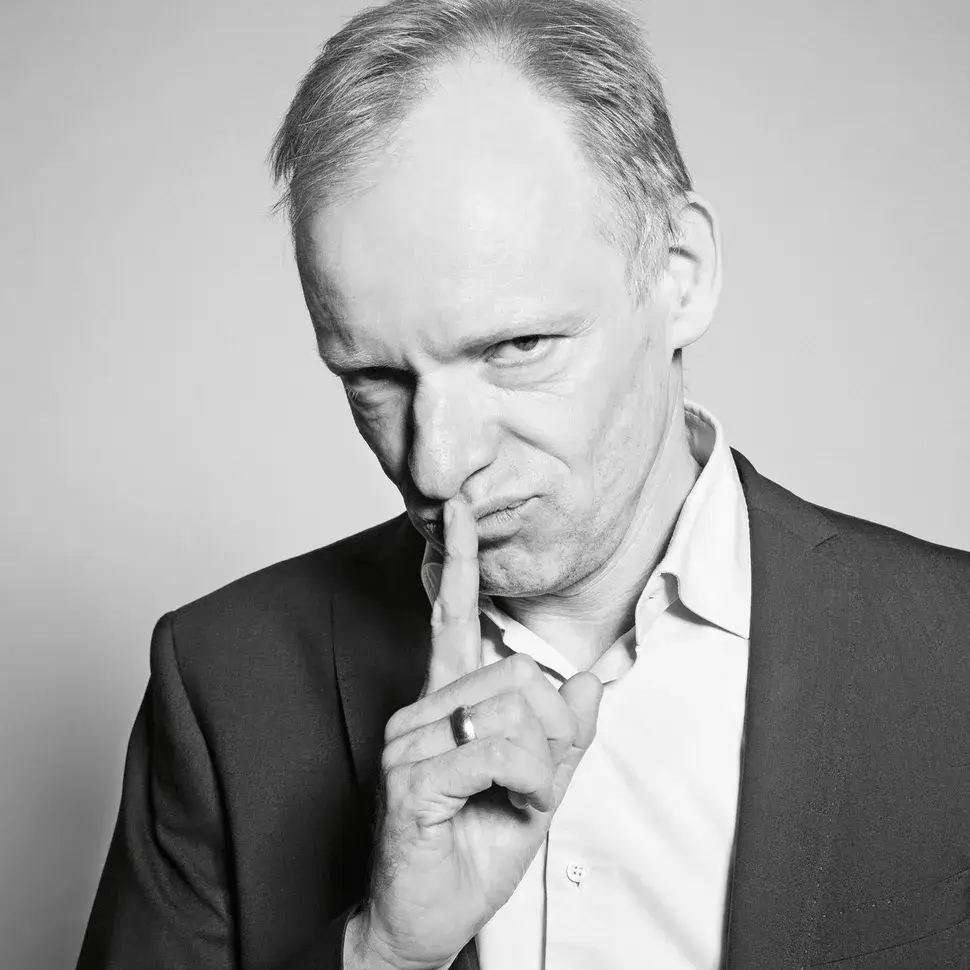

The look on your face when the first projections came in on election day?

Would Markus Söder have become chancellor?

You have several PhDs. What is one of your weaknesses?

Who has more power: politics or business?

What do you miss most about student life?

Do you think Mark Zuckerberg is a good person?

How many times a week do you look at your stock portfolio?

You once said that arithmetic is like meditating for you. What do your children say to that?

How do you keep fit while working from home?

Be honest: Have you ever sat in an online meeting in your underpants?
Giving interviews is nothing new for Clemens Fuest. Over the years, he has become a seasoned media professional, appearing on television talk shows, in news segments, and through press statements. However, a notable departure occurred on November 11, 2021, when the Sueddeutsche Zeitung (SZ) featured an unconventional piece: an interview with Fuest entirely captured through photography by Regina Recht. Using only gestures, facial expressions, and his entire presence, Fuest shared his perspec-tives on the pressing issues of the time – marked by the Covid-19 pandemic and the recent federal election – as well as some more personal reflections.
As President of the ifo Institute, Clemens Fuest’s primary role is forecasting – the art of making reliable predictions about whether the economy will grow or falter. During the pandemic, he was frequently seen in dark suits discussing terms like “bottleneck recession” and “supply chain issues.” Fuest is a pragmatist at heart, finding solace in calculations done undisturbed, often describing it as therapeutic. “Don’t expect too much,” he cautioned at the start of the photo session, “I’m not an actor.” But as the photographs reveal, he effortlessly exceeded expectations.
Fuest and his team regularly survey approximately 9,000 German businesses, posing twenty questions: How are things going? What is the current demand situation? What are your expectations for the coming months? These responses contribute to the ifo Business Climate Index, which in October recorded a fourth consecutive de-cline at 97.7 – indicating room for improvement. Fuest remains optimistic about the outlook for the next year.
For the initial publication of the interview in the SZ please click here: To Süddeutsche Zeitung
People
Working at the Forefront of Research
The ifo Institute is synonymous with top-tier research, but to sustain this level of excellence, one element is critical: our researchers. At ifo, a diverse group of doctoral students, post-docs, department heads, and research managers collaborate across various disciplines. Their expertise and efforts enable the Institute to explore pertinent issues and make significant contributions to public and political discourse. The ifo Institute relies on its researchers, but what do they think about their experiences at the institute? Here’s a glimpse into the motivations and career trajectories of both current and former staff members.
“A solid A in statistics!” – Hildegard Harlander
In a glowing recommendation letter from November 1953, Oskar Anderson highlighted the impressive grades with which Hildegard Harlander, then 43, had completed her economics studies. Further endorsed by Adolf Weber, Harlander successfully joined the ifo Institute in 1954, where she remained a key figure until her retirement in 1975, despite being denied a traditional career trajectory.
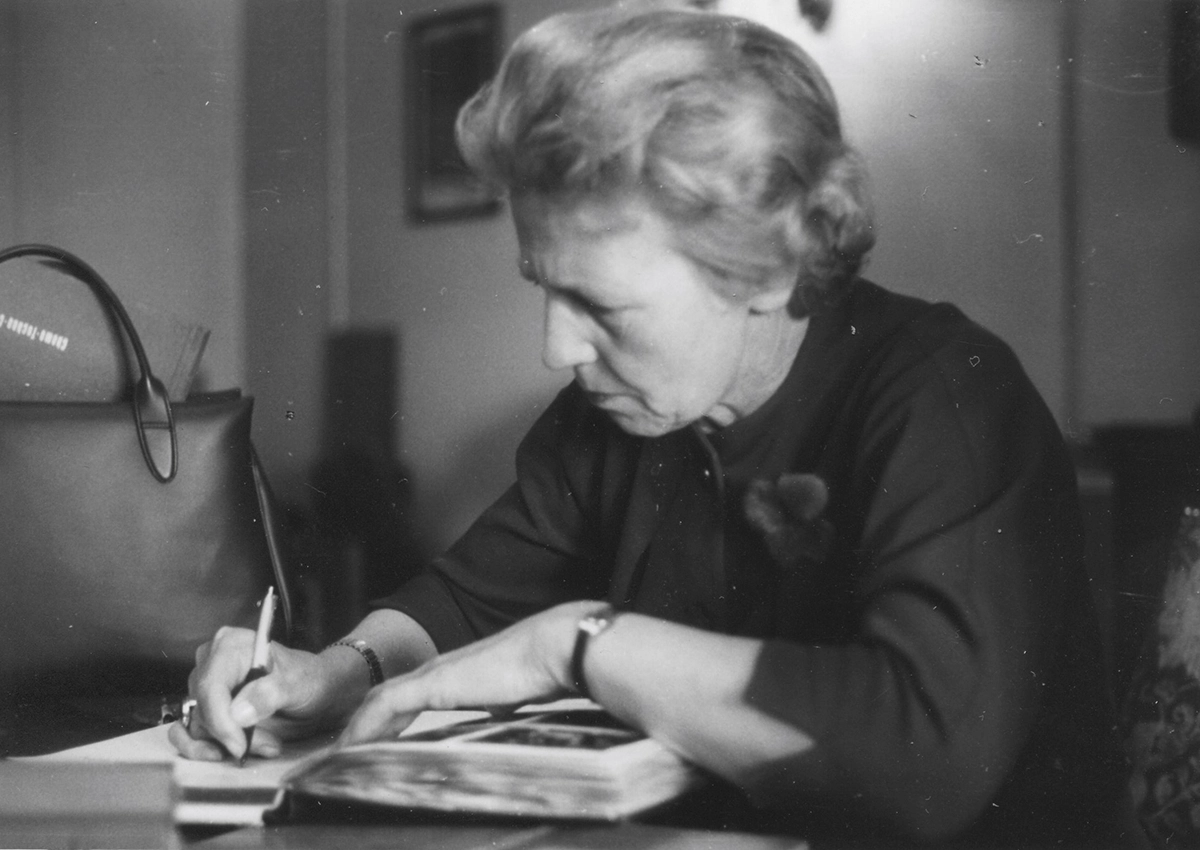
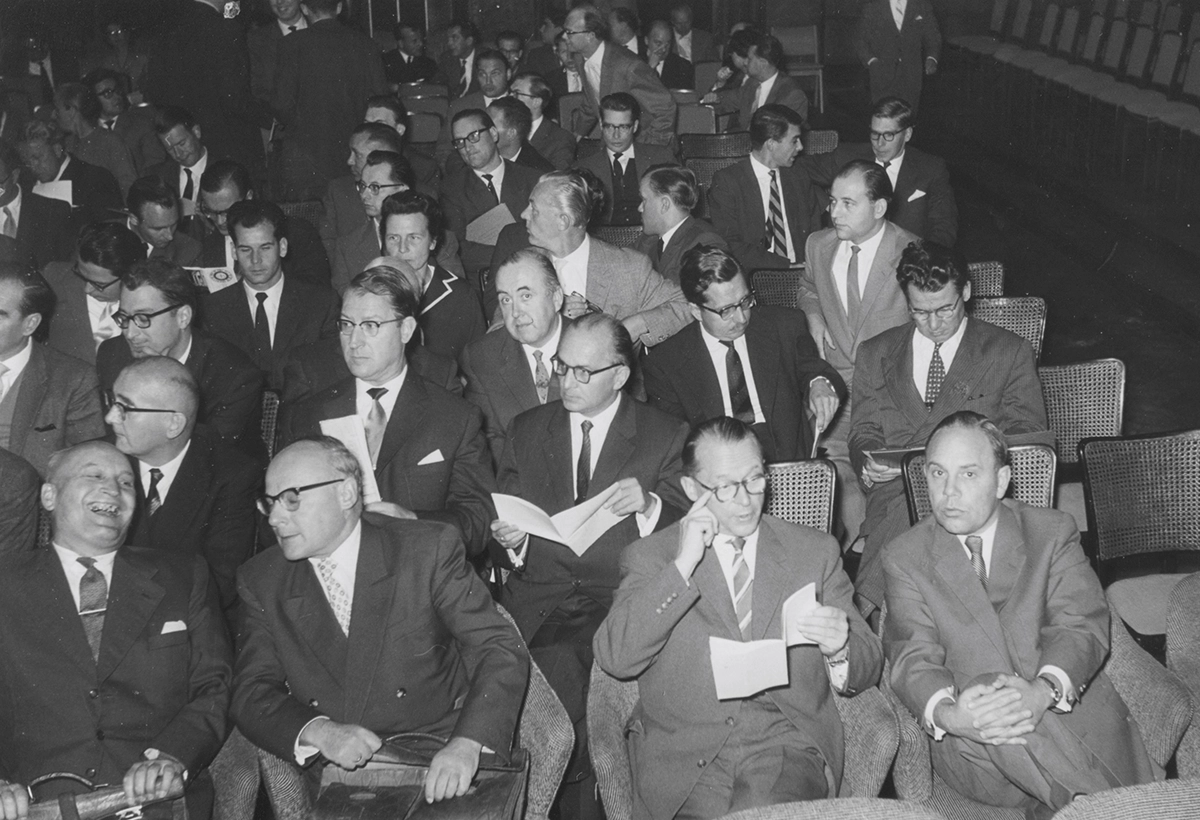
From Bookstores to Breakthroughs in Economics
Born on November 9, 1910, in Heilbronn, Harlander initially trained as a bookseller and worked as an interpreter before pursuing economics at the University of Munich in 1933. After her engagement in 1935, she broke off her studies. Her two sons were born in 1939 and 1946. Looking back, she considered dropping out of university a mistake and wrote: “In the Third Reich, women were pushed out of the professions.” Her marriage ended in divorce in 1951. As a single mother who soon had to return to work, Hildegard Harlander was a rare exception in the early post-war years.
Summer in the Sonnenhäusl
Hildegard Harlander decided to resume her studies. She returned to university in May 1952, completed the remaining seminars by October 1953, and passed her exams in the same year. To fund her studies and support her family, Harlander drew on her passion for the outdoors, authoring two children’s books inspired by her extensive hikes in Austria’s “Loferer Steinberge.” Published by Franz Schneider Verlag in 1950 and 1951, Bei uns im Sonnenhäusl and Sommer im Sonnenhäusl enjoyed several reprints, contributing financially during her academic pursuits.

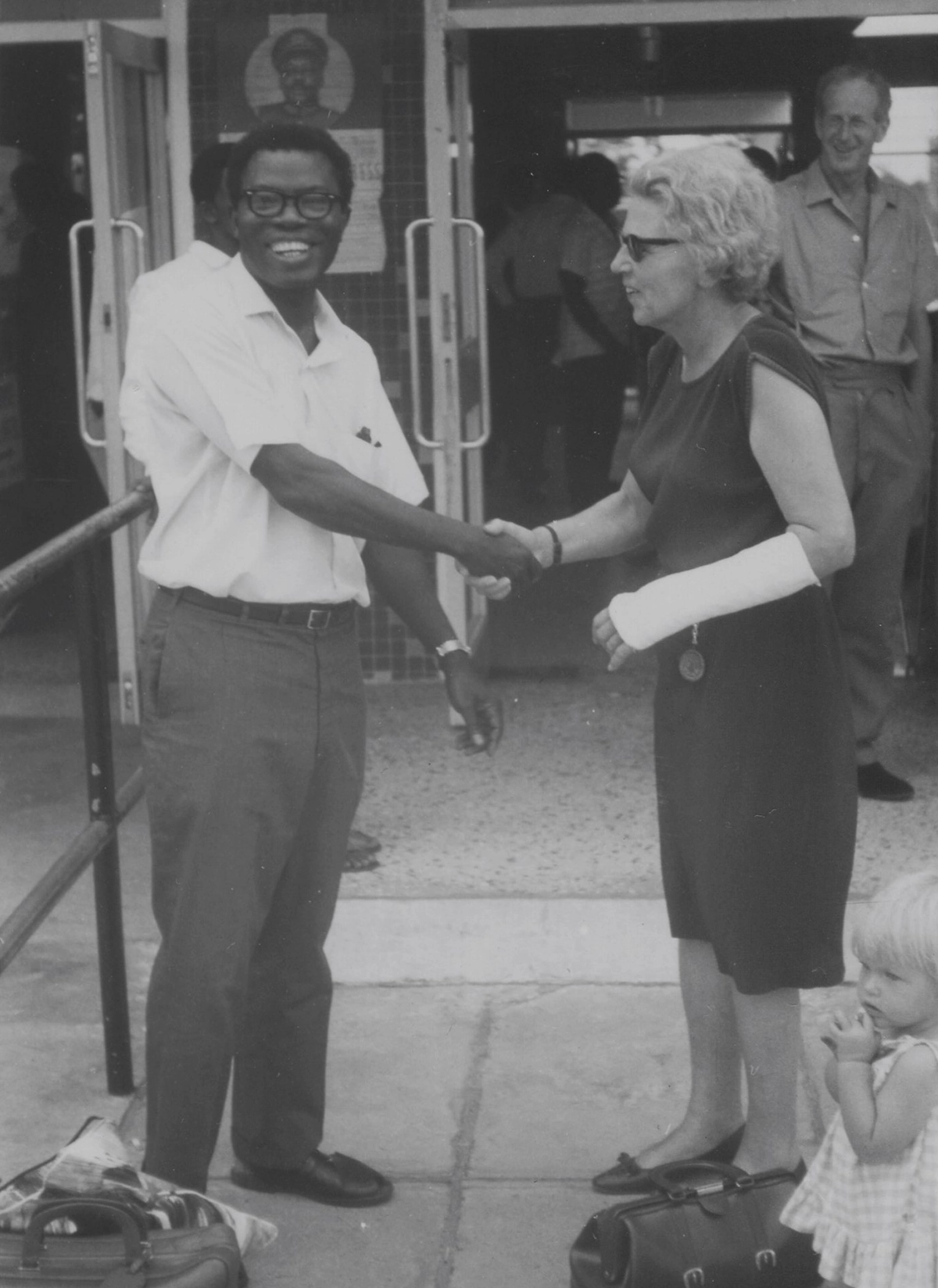
From Munich to East Africa: Expanding Research Horizons
Hildegard Harlander was hired by the ifo Institute on January 1, 1954, as an assistant to Hans Langelütke and found herself as one of the few women in a scientific community dominated by men. She took part in important conferences and meetings and wrote reports and minutes as secretary. Over time, she became well-versed in all areas of research at the institute. In 1961, when the Fritz Thyssen Foundation agreed to finance a multi-year project to research the economic situation in East Africa and the scientific basis of an appropriate development policy, Hildegard Harlander undertook her first trip there with Hans Langelütke and two colleagues from the Board of Directors. Here she found a field that matched her interests perfectly. From July 1965, she was able to devote half of her working hours to the “Africa Study Unit” headed by Wilhelm Marquardt at the ifo Institute and researched the role of women in the economic and social development of East Africa with great commitment. In 1966, she spent two months visiting the continent’s major research institutes, and in 1971, together with her colleague Dorothea Metzger, published a study with seven case studies on African development banks.
Environmental Expert from the Very Beginning
In April 1971, Harlander authored an important internal study titled “Problems of Environmental Protection,” offering a pioneering look at the then-nascent issue of environmental sustainability. She provided a comprehensive review of scientific and political discussions on environmental pollution and energy, highlighting her foresight and analytical prowess. Above all, however, she had the courage to bring attention to this pressing issue, which at the time was not yet being taken seriously by the wider scientific community – including at the ifo Institute. In contrast, she recognized early on the challenges that the environment would pose for those responsible in politics and business in the future.
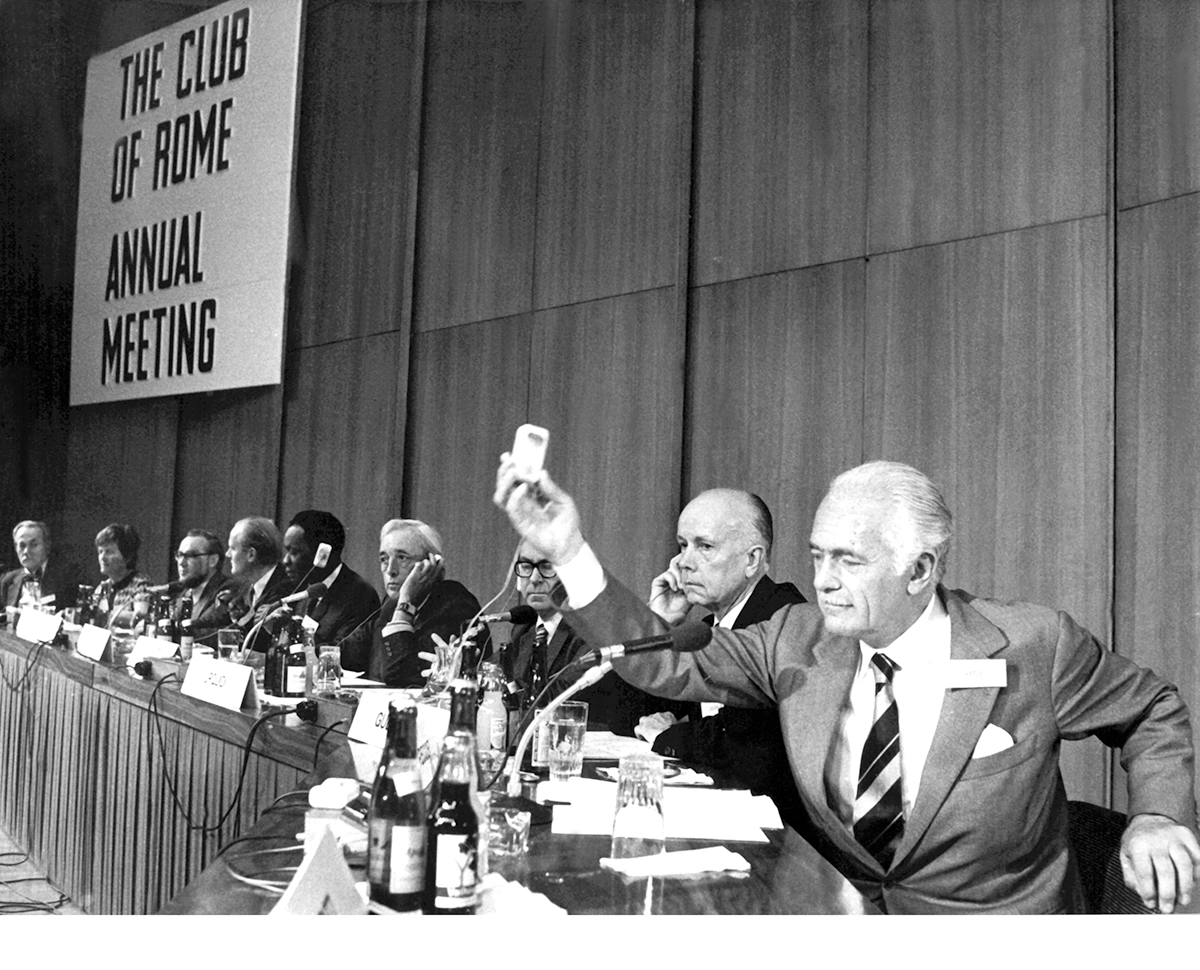
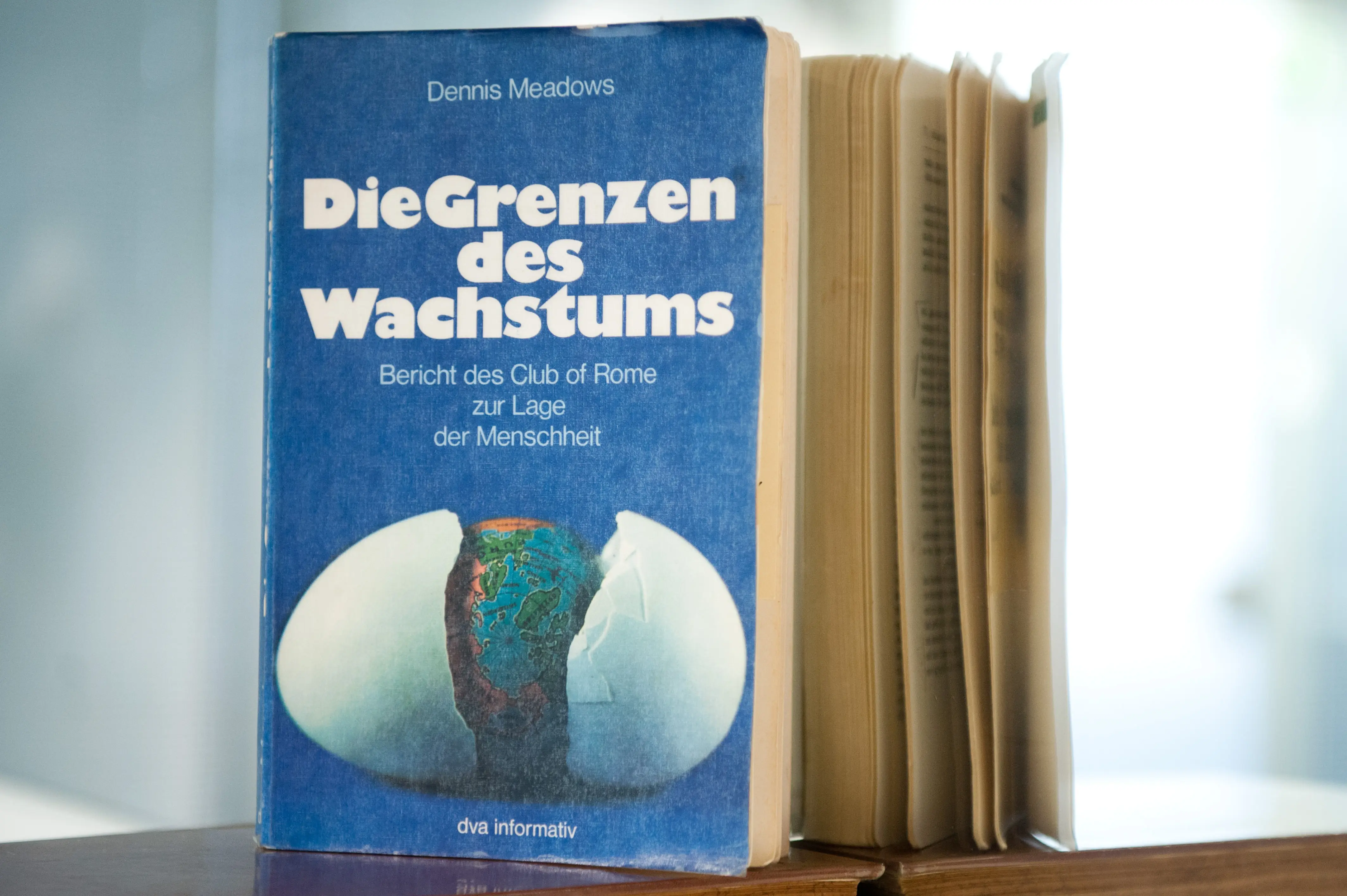
“Not a dolce vita organization” – The Club of Rome
Less than a year later, in March 1972, she reported on the study “The Limits to Growth,” a founding document of the environmental movement, which had just been presented by the Club of Rome. In her conclusion, she argued against the claim derived from the study that only an immediate abandonment of the growth principle could save the world. In contrast, she took a pragmatic stance: why not react to the long-term perspectives set out in the study with short- and medium-term decisions and thus gain time to “demonstrate meaningful chances of survival and the possibility of their realization with new models?”
In February 1973, Harlander summarized the unusually broad response to the Club of Rome’s study. She was interested in “why many economists, of all people, reacted so unusually allergically and aggressively.” She suspected a fear of new scientific horizons: “Economic research puts so much effort into short-term (economic) analysis and forecasting and obviously neglects long-term perspectives.” This is where economists could benefit from the study because it made it clear to them “that they need to broaden their horizons, namely in terms of subject matter to an interdisciplinary view, in terms of time to a longer-term perspective, and in terms of space to global connections.”
People
“Please mark all that apply with 1!”—ifo Company Surveys
After the collapse of the German economy following World War II, the immediate challenge was assessing the damage—a daunting task given the absence of up-to-date statistical surveys. Having rapid access to reliably figures was, however, crucial for planning the reconstruction.

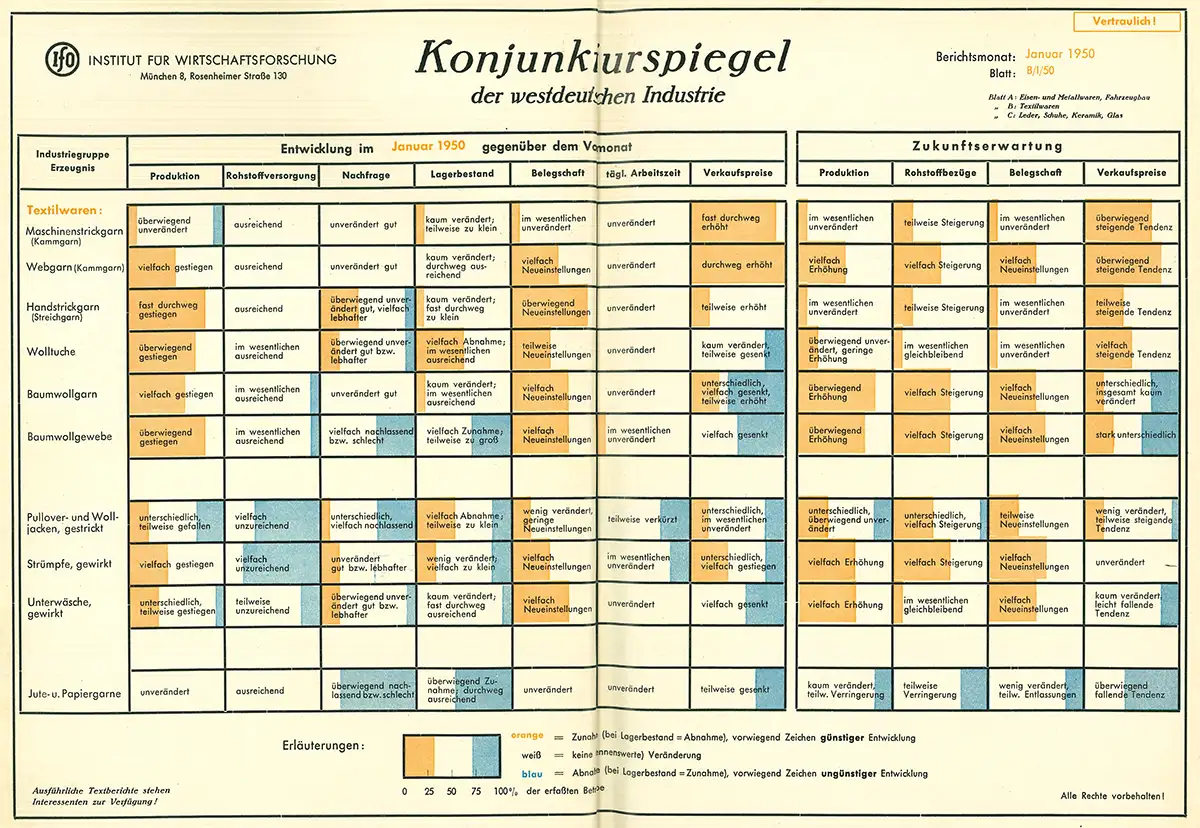
Innovating Data Collection and Analysis
In this critical period, Hans Langelütke, who would later become President of the ifo Institute from 1955 to 1965, pioneered the effort. Starting in 1948, post-currency reform, he gathered assessments from industrial company leaders while at the Information and Research Center for Economic Observation at the Bavarian State Statistical Office. This innovative approach to collecting qualitative assessments rather than detailed company data continued and evolved with the foundation of the ifo Institute. The inaugural issue of “Konjunkturspiegel der westdeutschen Wirtschaft” was published in January 1950. It featured a synoptic color overview of the compiled survey results—an innovative approach that was not only a time-saver but also eased the general post-war aversion to extensive questionnaires. This method of swiftly gathering actionable insights was revolutionary at the time and its foundational principles remain effective.
From Individual Surveys to the Business Climate Index
The ifo Business Surveys serve dual purposes: tracking current economic activity and informing the institute’s economic forecasts. By the 1960s, the ifo Institute began merging current and future business situation assessments into a comprehensive indicator. This culminated in the publication of the “Business Climate Manufacturing Industry” in the ifo Schnelldienst in 1971, marking the inception of Germany’s widely recognized ifo Business Climate Index.
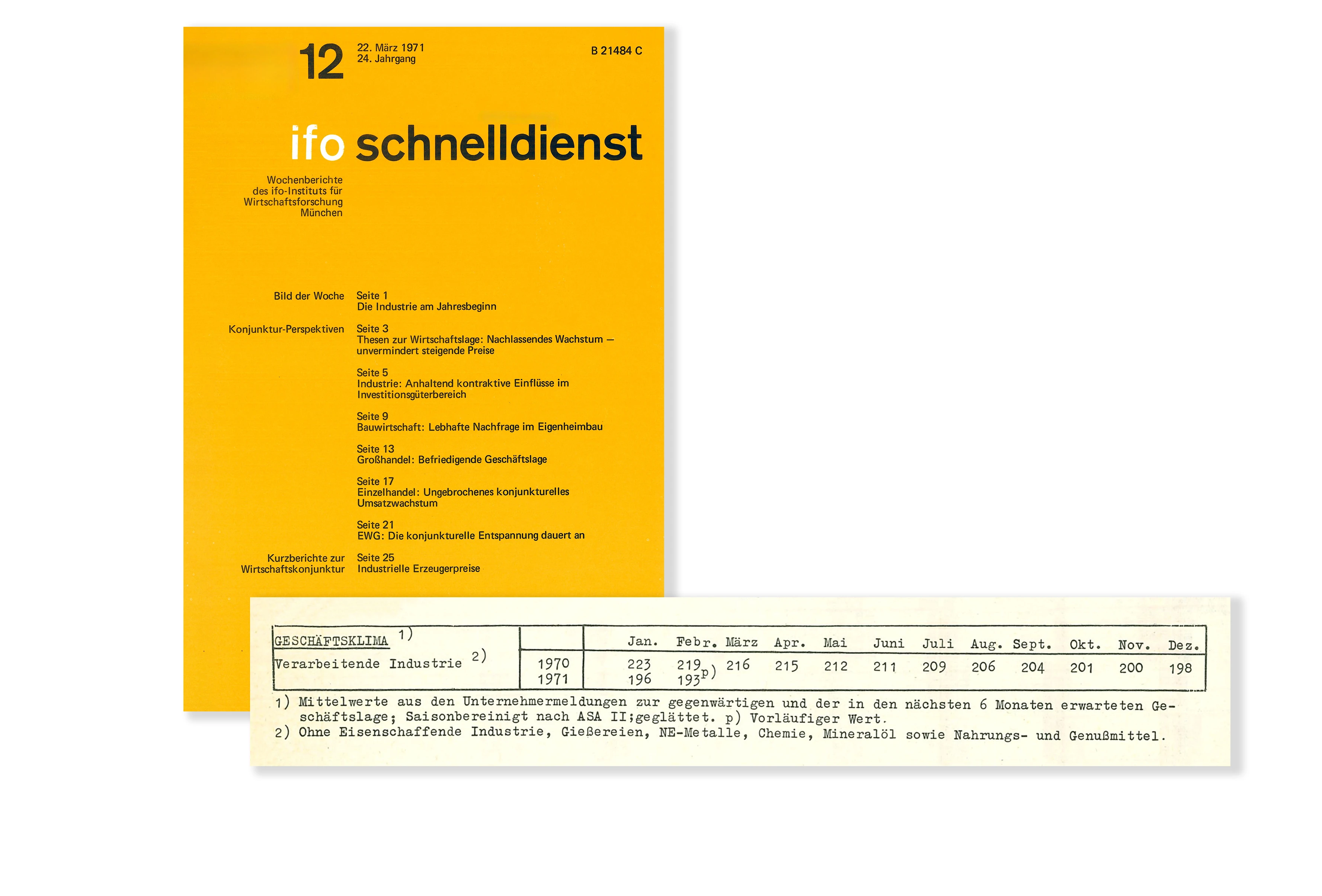
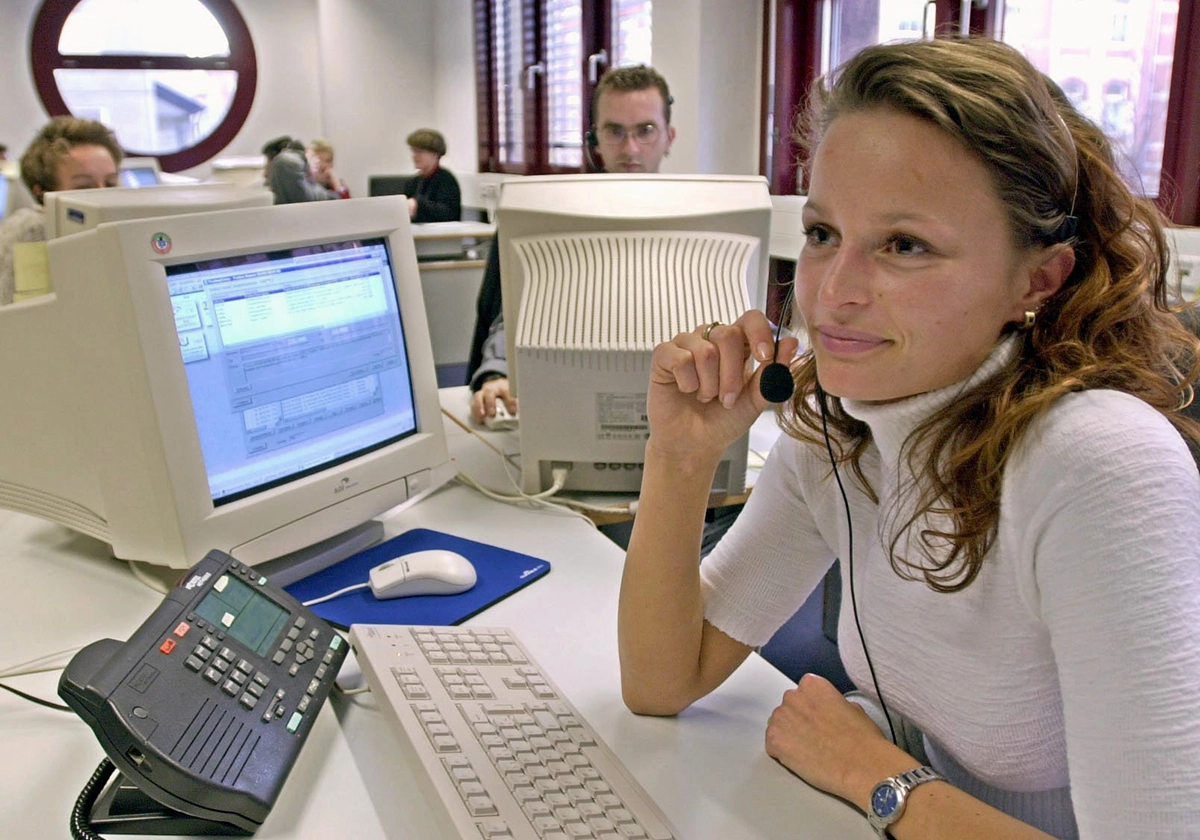
A Reciprocal Information Network
Companies quickly saw the value of participating in the surveys in gaining access to insightful analyses and forecasts that helped inform their decisions. This symbiotic relationship spurred the growth of the ifo Business Survey, with participation expanding from about 100 initial responses to 6,327 by the end of its first decade. The survey scope broadened from industry in 1949 to include retail by 1950, wholesale by 1951, and sectors like construction and utilities by the late 1970s, with the service sector following in 2005.
Setting a Global Standard
The methodological rigor and continuous improvement of the survey process at the ifo Institute garnered international acclaim early on. In the 1980s, the institute expanded its survey efforts internationally with the Economic Survey International (ESI) and later the World Economic Survey (WES), engaging economic experts from over 100 countries until 2019. This global outreach reinforced the ifo Institute’s role as a pioneer in economic survey methodology.
The ifo Business and Investment Surveys have become a cornerstone of the institute’s identity, celebrated for their innovative inception and enduring relevance. These surveys not only interest economists but also attract widespread attention from media and the public, underscoring the ifo Institute’s pivotal role in shaping economic discourse over the past 75 years.
